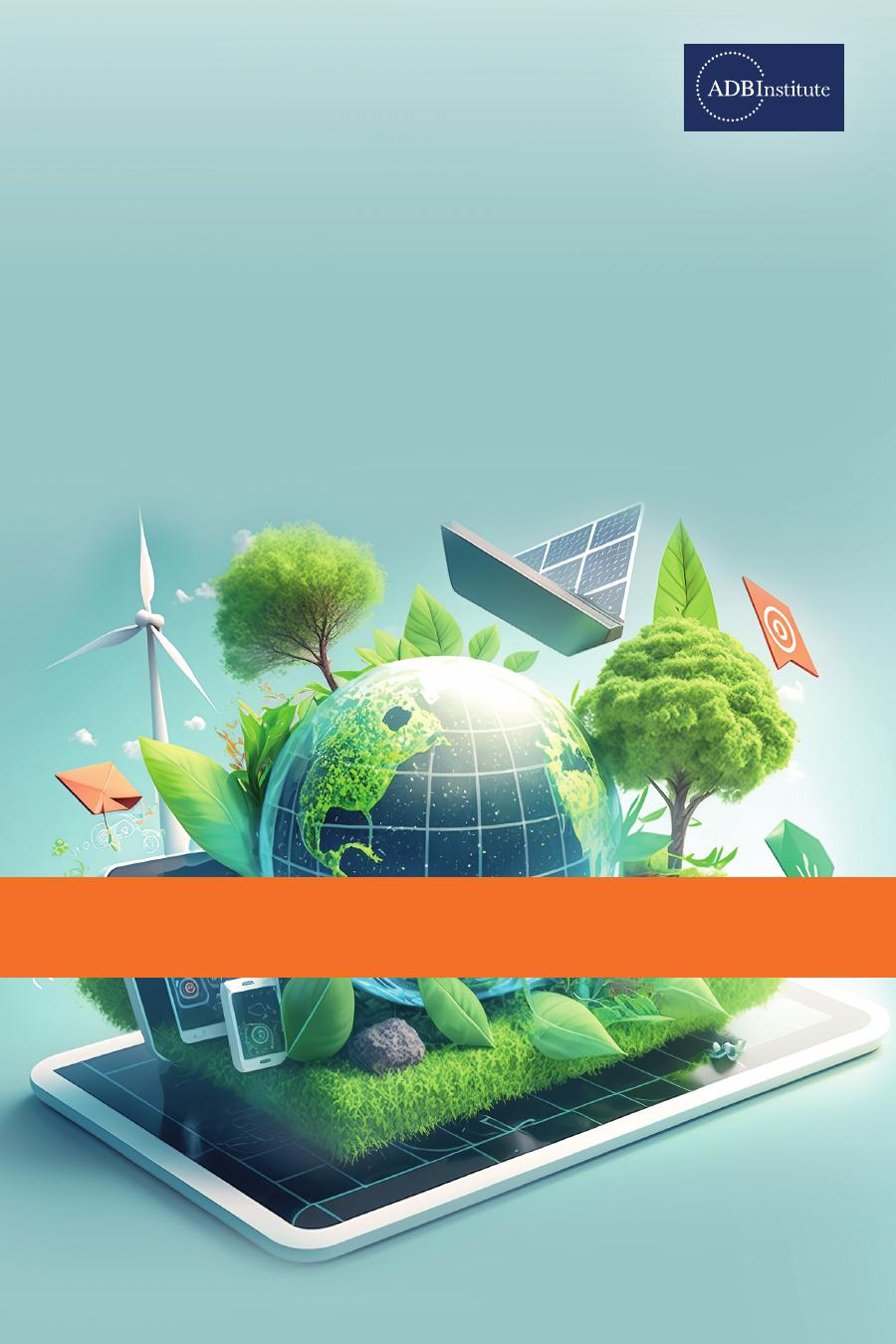ASIANDEVELOPMENTBANKINSTITUTEGLOBALCLIMATECHALLENGES,INNOVATIVEFINANCE,ANDGREENCENTRALBANKINGSayuriShiraiGlobalClimateChallenges,InnovativeFinance,andGreenCentralBankingSayuriShiraiASIANDEVELOPMENTBANKINSTITUTE©2023AsianDevelopmentBankInstituteAllrightsreserved.ISBN978-4-89974-281-4(Print)ISBN978-4-89974-282-1(PDF)DOI:https://doi.org/10.56506/WIUU5747TheviewsinthispublicationdonotnecessarilyreflecttheviewsandpoliciesoftheAsianDevelopmentBankInstitute(ADBI),itsAdvisoryCouncil,ADB’sBoardorGovernors,orthegovernmentsofADBmembers.ADBIdoesnotguaranteetheaccuracyofthedataincludedinthispublicationandacceptsnoresponsibilityforanyconsequenceoftheiruse.ADBIusesproperADBmembernamesandabbreviationsthroughoutandanyvariationorinaccuracy,includingincitationsandreferences,shouldbereadasreferringtothecorrectname.Bymakinganydesignationoforreferencetoaparticularterritoryorgeographicarea,orbyusingtheterm“recognize,”“country,”orothergeographicalnamesinthispublication,ADBIdoesnotintendtomakeanyjudgmentsastothelegalorotherstatusofanyterritoryorarea.Usersarerestrictedfromreselling,redistributing,orcreatingderivativeworkswithouttheexpress,writtenconsentofADBI.ADBrecognizes“China”asthePeople’sRepublicofChina;and"HongKong"asHongKong,China.Note:Inthispublication,“$”referstoUnitedStatesdollars.AsianDevelopmentBankInstituteKasumigasekiBuilding8F3-2-5,Kasumigaseki,Chiyoda-kuTokyo100-6008,Japanwww.adbi.orgiiiContentsTablesandFigures�ivAbbreviations�viAbouttheAuthor�viiiForeword�ixIntroduction�xi1Climate,Environment,andCorporateManagement�12TheRoleoftheBankingSectorinPromotingESG-OrientedCorporateManagement�243ClimateChange,Environment,andBlendedFinanceforEmergingandDevelopingEconomies�324ClimateChange,NatureStock,andDebtSwapsforLow-IncomeDevelopingEconomies�655GreenCentralBankingandClimate-RelatedMonetaryPolicy�876GreenPrudentialPolicyandFinancialRegulation�127References�166ivTablesandFiguresTables1.1SurveyResponsesonESGRatingProvidersbyInvestorandCompanyRespondents�213.1AggregateNetFinancialFlowstoEmergingandDevelopmentEconomies�345.1PossibleClimate-RelatedPolicyOptionsforCentralBanks�895.2SelectedStylizedOptionsforAdjustingCentralBanks’OperationalFrameworkstoClimateRisks�98Figures1.1PositionsRelatedtoEnvironmental,Social,andGovernance�61.2GHGProtocolScopesandEmissionsAcrosstheValueChains(Scopes1,2,and3)�91.3ESGScoreofNonfinancialCompaniesinJapan,theEuropeanUnion,theUnitedKingdom,andtheUnitedStates�151.4Environmental(E)ScoreofNonfinancialCompaniesinJapan,theEuropeanUnion,theUnitedKingdom,andtheUnitedStates�161.5Social(S)ScoreofNonfinancialCompaniesinJapan,theEuropeanUnion,theUnitedKingdom,andtheUnitedStates�171.6CorporateGovernance(G)ScoreofNonfinancialCompaniesinJapan,theEuropeanUnion,theUnitedKingdom,andtheUnitedStates�173.1EmergingandDevelopingEconomies’DebttothePeople’sRepublicofChina�353.2DACMemberEconomies’NetOfficialDevelopmentAssistanceinRealTerms�363.3TotalClimateFinanceProvidedandMobilized�413.4RelationshipbetweenCreditRatingsandCO2Emissions�483.5FourTypesofBlendedFinanceSchemes�513.6ClimateFinancePartnershipFundManagedbyBlackRock�624.1TwoTypesofDebt-for-NatureSwaps�725.1CentralBankMandatesandGrowingLong-TermClimateRisks�936.1NGFSSixTypesofClimateScenarios�134TablesandFiguresv6.2SupervisoryActionsandExpectationsonStress-TestingandScenarioAnalysisintheAsiaandPacificRegion�1436.3SUSREGClimate-RelatedIndicatorsintheAsiaandPacificRegion�1606.4FulfillmentofClimate-RelatedIndicatorsonSupervisoryExpectationsonBanks�161viAbbreviationsADBAsianDevelopmentBankAfDBAfricanDevelopmentBankAIartificialintelligenceASEANAssociationofSoutheastAsianNationsBCBSBaselCommitteeonBankingSupervisionBOEBankofEnglandBOJBankofJapanCBDConventiononBiologicalDiversityCEOchiefexecutiveofficerCIVcollectiveinvestmentvehicleCOPConferenceofthePartiesCO2carbondioxideCO2ecarbondioxideequivalentCSLNClimateSafeLendingNetworkCSRDCorporateSustainabilityReportingDirectiveDACDevelopmentAssistanceCommitteeDFCUnitedStatesInternationalDevelopmentFinanceCorporationDFIdevelopmentfinanceinstitutionDSSIDebtServiceSuspensionInitiativeECBEuropeanCentralBankEMDEsemerginganddevelopingeconomiesEIBEuropeanInvestmentBankEIFEuropeanInvestmentFundESCBEuropeanSystemofCentralBanksESGenvironmental,social,andgovernanceESMAEuropeanSecuritiesandMarketsAuthorityESRBEuropeanSystemicRiskBoardEUEuropeanUnionFDIforeigndirectinvestmentFSAFinancialServicesAgencyFSBFinancialStabilityBoardG7GroupofSevenGCFGreenClimateFundGFANZGlasgowFinancialAllianceforNetZeroGHGgreenhousegasGSIAGlobalSustainableInvestmentAllianceIBRDInternationalBankforReconstructionandDevelopmentICAAPinternalcapitaladequacyassessmentprocessAbbreviationsviiIDBGInter-AmericanDevelopmentBankGroupIFCInternationalFinanceCorporationIMFInternationalMonetaryFundIOSCOInternationalOrganizationofSecuritiesCommissionsIPBESIntergovernmentalScience-PolicyPlatformonBiodiversityandEcosystemServicesIPCCIntergovernmentalPanelonClimateChangeIPSFInternationalPlatformonSustainableFinanceIRMFIntegratedResultsManagementFrameworkISSBInternationalSustainabilityStandardsBoardMASMonetaryAuthorityofSingaporeMDBmultilateraldevelopmentbankMPCMonetaryPolicyCommitteeNDCNationallyDeterminedContributionsNGFSNetworkofCentralBanksandSupervisorsforGreeningtheFinancialSystemNGOnongovernmentorganizationNZAOANet-ZeroAssetOwnerAllianceNZBANet-ZeroBankingAllianceODAofficialdevelopmentassistanceOECDOrganisationforEconomicCo-operationandDevelopmentPBOCPeople’sBankofChinaPRBPrinciplesforResponsibleBankingPRCPeople’sRepublicofChinaPRIPrinciplesforResponsibleInvestmentR&DresearchanddevelopmentROKRepublicofKoreaRSTResilienceandSustainabilityTrustSBTiScience-BasedTargetInitiativeSDGSustainableDevelopmentGoalSDRspecialdrawingrightSECsocial,environmental,andclimateSGXSingaporeExchangeSMEssmallandmedium-sizedenterprisesSyRBsystemicriskbufferTCFDTaskForceonClimate-RelatedFinancialDisclosuresUKUnitedKingdomUNEPFIUnitedNationsEnvironmentProgrammeFinanceInitiativeUNFCCCUnitedNationsFrameworkConventiononClimateChangeUSUnitedStatesWACIweightedaveragecarbonintensityWWFWorldWideFundforNatureviiiAbouttheAuthorSayuriShiraiisavisitingfellowandadvisorforsustainablepoliciesattheAsianDevelopmentBankInstitute.SheisalsoaprofessorattheFacultyofPolicyManagementatKeioUniversityandanadvisortotheNomuraResearchCenterforSustainabilityandtheNissinOillioGroup.During2020–2021,shewasasenioradvisortoEOSatFederatedHermes,aproviderofenvironmental,social,andgovernance(ESG)stewardshipservices,inLondon.Thisbookbenefitedsignificantlyfromvariouspresentationsandassociatedintensivediscussionsatseminarsorganizedby(i)thePolicyResearchInstituteoftheMinistryofFinance,Japan,inJanuary2023;(ii)MizuhoSecuritiesCo.,Ltd.inJanuary2023;(iii)theResearchInstituteforEnvironmentalFinance,Japan,inOctober2022;(iv)theClimateChangeCentreoftheEuropeanCentralBankinSeptember2022;(v)theAsianDevelopmentBankInstitute–AsianDevelopmentBankJointConferenceonDevelopmentandInnovativeFinanceheldinSeptember2022;(vi)theBankIndonesiaInstituteinJuly2022;and(vii)theAsianDevelopmentBankFinancialSectorGroupWebinarinMay2022.Thebookalsobenefitedfrominsightfulcommentsprovidedbyanonymousreviewers.ixForewordEnvironmental,social,andgovernance(ESG)investmentisrapidlydevelopingandexpandingfromdevelopedtodevelopingcountries.LargecompaniesandfinancialinstitutionsareincreasinglyembracingESGinvestmenttoreducegreenhousegas(GHG)emissions,facilitatedbyadvancementsindigitaltechnology.TheSustainableDevelopmentGoals(SDGs)andcarbonneutralityarebecomingincreasinglychallengingobjectives,particularlyintermsoffinancingandconstrainedfiscalcapacities.Thisistrue,especiallyamongdevelopingeconomieswherepublicresourcesareinsufficienttomeetthephysical,economic,andsocialinvestmentgapsrequiredtoachievetheSDGsandcarbonneutralityduetothesizeofpublicdebtandfragileeconomicandsocialconditionssincethecoronavirusdisease(COVID-19)pandemicandthesubsequentenergyandfoodcrises.Theamountofofficialdevelopmentaidanddevelopmentfinanceremainsinsufficienttosupportthesecountries.Greaterinternationalsupportisneededfordevelopingeconomiestoimplementtheirclimatemitigationandadaptationstrategies.Accordingtothe26thConferenceofthePartiestotheUnitedNationsFrameworkConventiononClimateChange(COP26)andtheGlasgowFinancialAllianceforNetZero,toreachnet-zerocarbonemissionsby2050,$125trillionofinvestmentisrequiredgloballyforthetransitiontomitigatethephysicalimpactsofclimatechange.TotapthefinancingopportunitiesinAsiaandelsewhere,domesticandglobalfinancialinstitutionsneedabetterunderstandingofrisk-adjustedreturns,riskmitigationmeasures,andtransition-relatedcriteriaforshiftingtheirportfoliostonetzero.Keycomponentsinmakingdecisionsforprivatecapitalprovidersincludecredibleclimate-relateddisclosuresanddata,innovativefinancingschemestomitigatetransitionfinance–relatedrisksandeffectivetransitionfinance–relatedcriteria.Publicpolicywillbekeyinfacilitatingtherequiredmobilizationofprivatecapitalatscale.Whilevariousinnovativefinanceschemeshavebeendevelopedovermanyyears,themomentumhasgainedtractioninrecentyearsforseveralreasons.OneisthatESGinvestment,drivenbyglobalinstitutionalinvestorsandassetmanagementcompanies,hasbeendevelopingrapidly,andthefocusisexpandingbeyondlistedcompaniesindevelopedcountries.Forexample,impactinvestmentisexpandinggloballybecausecommonglobalgoalscannotbeachievedwithoutactiveparticipationbydevelopingcountries.ThesecondfactoristhatmanylargecompaniesandfinancialinstitutionswishtoreducexForewordtheirGHGemissionstomeettheircarbonneutralitytargets,sotheyaremoreeagertousesustainablematerialsandproducts.Thethirdfactorrelatestothefactthatdigitalandsatelliteimagetechnologyhashelpedmonitorsomeenvironment-relatedprojectsandenablethetraceabilityofsustainableproductsandservices.Atthesametime,mechanismsforpromotingdebt-for-climateswapsordebt-for-nature-preservationswapsarebecomingimportantsincedevelopingcountrieshaveaccumulatedpublicdebt,particularlysincethepandemicandlimitedbudgetaryresources.Governmentsareprimarilyresponsibleforaddressingclimatechangeissuesandimplementingnecessaryclimatepoliciestoachievecarbonneutralityworldwide.Undersuchinitiatives,financialsupervisorsarebeginningtopromoteclimate-relatedfinancialriskawarenessamongfinancialinstitutionsandtheirriskmanagementandconsiderclimate-relatedfinancialsupervisionandregulation.Withintheirmandates,moreover,agrowingnumberofcentralbanksarealsocopingwithclimateissuestoenhancetheresilienceoffinancialinstitutionsundertheirsupervisionaswellasthatoftheirbalancesheetsandcentralbankingoperationsagainstvariousclimaterisks.Someofthemhavealsointegratedclimatefactorsintopartoftheconductofmonetarypolicy.ThisbookprovidesacomprehensiveoverviewofglobaltrendsrelatedtoESGinvestmentandcorporatemanagement,innovativefinanceanddebt-climate(ordebt–naturepreservation)swaps,aswellasgreenmonetarypolicyandfinancialregulationstocopewithclimaterisks.Theauthorhighlightsrecenttrends,actualpractices,andareasofchallenges.Nootherbooksappeartocoverthesetopicsextensivelyandcomprehensively.Isincerelybelievethisbookcanbeusefulformanyreaders,includingpolicymakers,financialinstitutionsandinvestors,otherstakeholders,andacademics.TetsushiSonobeDeanAsianDevelopmentBankInstitutexiIntroductionTheworldhascommittedgreatereffortstoachievetwomajorcommoninternationalgoalspledgedin2015.Oneistheachievementof17theSustainableDevelopmentGoals(SDGs)by2030,adoptedattheUnitedNations(UN)SustainableDevelopmentSummit.Thosegoalsincludedsustainableeconomicgrowth,climatechange,conservationoftheenvironmentandnaturalresources,povertyreductionandsocialdevelopment,andgenderandhumanrights.TheotheristheParisAgreementagreeduponatthe21stConferenceoftheParties(COP21)totheUNFrameworkConventiononClimateChange(UNFCCC).Itsetalong-termgoalofreducinggreenhousegas(GHG)emissionstowellbelow2°C(comparedtopre-industrialtimes)bytheendofthiscenturyandstrivingtoapproach1.5°C.Subsequently,in2018,theIntergovernmentalPanelonClimateChange(IPCC),consistingofscientistsworldwide,releasedaspecialreportonglobalwarmingof1.5°C,indicatingtheimportanceofachievingnet-zeroGHGemissionsby2050.Reflectingthisview,manycountrieshavecommittedtonetzeroorcarbonneutralityaround2050oralittleafter.GlobalChallengestoAchievetheSDGsandCarbonNeutralityItisincreasinglyclearthatthetwoimportantinternationalcommongoalspledgedbytheworldin2015arebecomingdifficulttoachievewithoutimplementingadditionalglobalpolicyactions.Theglobaleconomyhasfacedaseriesofadverseshocksinrecentyears,includingtheCOVID-19pandemic,cross-bordersupplychaindisruptions,risingclimatephysicalrisksanddisasterstriggeredbynaturalhazard,theRussianinvasionofUkraine,andenergyandfoodshortages.Theinterestrateshocksdrivenbyinflation,monetarypolicynormalization,andrecentbankingsectorconcernsintheUnitedStates(US)andEuropealsoaddedtoeconomicdifficultiesacrosstheglobe.Meanwhile,thehighcostoffossilfuelssince2021hasremindedtheworldthatmoreinvestmentincleanorlow-emissionenergyprojectswillbenecessarytoachievenet-zeroGHGemissionsiftheworldmakeseffortstoachieveamaximumtemperatureriseofwellbelow2°Cor1.5°Cbytheendofthiscentury(relativetopre-industriallevels).Theamountofinvestmenthasbeeninadequateformanyyearsbecauseofthelimitedscaleofclimateandenergypoliciesadoptedbytheworld.TheSynthesisxiiIntroductionReportoftheSixthAssessmentReport(AR6)publishedinMarch2023bytheIPCCwarnedthatacontinuedincreaseinGHGemissionswouldleadtoglobalwarmingof1.5°Cinthenearterminconsideredscenarios.Itstressedthatthreetosixtimesgreaterclimateinvestmentwouldbeneededrelativetothecurrentlevel(IPCC2023).TheCOVID-19pandemicandtheRussianinvasionofUkrainehaveexacerbatedextremepoverty,inequality,andsocialandphysicalinfrastructureshortagesinlow-incomecountries.Oneinfivedevelopingeconomiesisprojectedtoremainbelowitspre-crisis2019levelinpercapitaincomebytheendof2023(UNESCAP2022).Ifthecurrentsituationcontinuesandnoadditionalactionsareadopted,globallyachievingtheSDGswilllikelyfallsignificantlybehind,andrefugeesandconflictswilllikelyoccurfrequentlyinmanypartsoftheworld.Climate-RelatedPhysicalandTransitionRisksClimaterisksaregenerallydecomposedintophysicalandtransitionrisks.Physicalrisksarebecomingincreasinglymaterializedinrecentyears,withmajordisasterssuchashurricanes,typhoons,torrentialrains,andfloodsoccurringmorefrequentlyandonalargerscalethaninthepast,aswellasglobalwarmingandrisingsealevels.Theseacuteandchronicphysicalrisksoftenadverselyaffectinfrastructure,corporateproductionfacilities,commercialandresidentialproperties,andpeople’slives,therebyhinderingeconomicactivities,reducingfoodproduction,soaringcommodityprices,generatinghealthhazards,andreducinglaborproductivity.Theglobalaveragetemperaturehasalreadyrisenbyabout1.1°Cto1.2°Cfrompre-industrialtimes,anddamagefromextremeclimateeventsfrequentlyoccursworldwide.Tocopewithincreasingphysicalrisks,“climateadaptation”policiesandmeasuresarebecomingessential.Tomaketheeconomyandfirmsmoreresilienttotheincreasingnumberofdisasterstriggeredbynaturalhazard,governmentsmayneedtoconsidershiftingproduction,housing,orfactorylocationstosafer,inlandplaces,buildingembankmentsandmakinginfrastructuremoreresilienttodisasters,adoptingmonitoringandwarningsystemsofdisasters.Companiesandindividualsmustalsoconsideractionstocopewithrisingphysicalrisks.Ontheotherhand,climate-relatedtransitionrisksarerelatedtotheriskstemmingfromtransitioningtowardalow-carboneconomythrough“climatemitigation”policies.Climatepoliciesincludecarbonpricing(carbontaxand/oremissiontradingsystem);tighterenvironmentalregulationstoreduceGHGemissionsandpromotefuelconsumptionefficiency;removaloffossilfuelsubsidiesandincreaseinsubsidiesforgreenerprojectsandlow-carbontechnologydevelopment;andanIntroductionxiiiexpansionofpublicinvestmentnecessaryforachievingdecarbonization.Publicinvestmentcouldbeincreasedtowardinstallingchargingstationsforelectricvehicles(EVs),low-emissionpublictransportation,greenerpublicbuildings,renewableenergyelectricitygenerationfacilitiesinpublicareas,aswellasacceleratingforestmanagementandrestoration.Whengovernmentsspeedupimplementingtheseclimatemitigationpolicies,companieswillbemoreencouragedtoexpandresearchanddevelopment(R&D)spendingandcapitalinvestmentinrenewableenergy,smartgrids,EVs,storagebatteries,hydrogenfuelandtechnology,carboncapturestorage,andcarboncaptureutilizationstorage,etc.Suchspendingandinvestmentcanbeexpensiveforcompanies,andthereisariskthatsuchinnovativeactivitieswillnotbearfruit.Nevertheless,suchriskandcostshouldbecarefullybalancedagainstnewbusinessopportunitiesthatemergeinthetransitionprocessoftheeconomytowardcarbonneutrality.Low-carbonordecarbonizationactionswillhelptransformbusinessmodelsintomoreenvironmentallyandeconomicallysustainableonesfromalong-termperspective.Climate-relatedtransitionrisksinvolvetherestructuringofcarbon-intensiveindustriesandcompanies.Assetsthatintensivelyutilizefossilfuelswilllikelybecomestrandedassetsbecausetheirinvestmentcostscannotbefullyrecoveredundertighterenvironmentalregulationsandclimatepolicies.Ifmanyfinancialinstitutionscontinuetoinvestheavilyinsuchindustriesandcompanies,thefinancialsystem’sstabilitymightalsobethreatened.Inaddition,thenumberoflawsuitsagainstcompaniesconductinggreenwashingpractices,misleadingconsumers,andviolatingenvironmentalrulesandregulationswillincrease.Lawsuitsrelatedtophysicalrisksarealsopossibleifthecausalityfromclimatechangetoeconomicandsociallossescanbescientificallyestablished.Suchcompaniesmayfacepunishmentsandfinesandloseclientsandconsumersduetotheirdeterioratedreputation.Transitionrisksalsoincludethedisproportionatelylargeadverseimpactonlow-incomeearnersandsmallandmedium-sizedenterprises(SMEs)duetorisingpricescausedbycarbonpricingforacertainperiod—theso-called“greeninflation.”Thus,itisessentialforgovernmentstoperforma“justtransition”policytomitigatesuchadverseimpactsonvulnerablepeopleandcompaniestosmoothenthetransitionprocess.Climate-relatedphysicalandtransitionrisksareinverselyrelated.Ifgovernmentsdelaytheimplementationofclimatemitigationpolicies,transitionriskswillremainrelativelylow,butphysicalriskswillincreasesignificantlyovertimeandnonlinearly.Asaresult,theglobalaveragetemperaturecouldrisetomorethan3°Cfromthecurrentlevelbytheendofthiscenturyorevenmuchsooner.Collectiveeffortsmustbemadetolimittheincreaseinglobalaveragetemperatureto1.5°CoratxivIntroductionleastwellbelow2°Cbytheendofthiscenturytoavoidthisexcessiveglobalwarmingsituation.Whileitisnoteasyforgovernmentstoimplementclimatetransitionpoliciesinfearoffacingtransitionrisks,itisdesirabletostartimplementingnecessarypolicyactionstoreduceGHGemissionsassoonaspossibletoachieveasmoothertransition.Whileclimatemitigationpoliciesareneeded,theworldmustalsoimplementclimateadaptationpolicies.Thisbookgenerallyreferstophysicalandtransitionriskswhenreferringtoclimaterisksunlessspecified.GrowingPresenceofESGInvestmentandtheRoleoftheBankingSectorWhiletheglobalaveragetemperaturehasreached1.1°Cto1.2°C,much-neededclimatepoliciesandactionshavelagged.In2020,GHGemissionsdecreasedtemporarilyduetotheimpactoftheCOVID-19pandemicandtheresultantrecession.Sincethen,GHGemissionshavestartedtoincreaseagain.Amidenergyshortagessince2021andfurtherdeterioratedbytheRussianinvasionofUkraine,fossilfuelproductionisincreasingbeyondexpectations,andglobalwarmingcontinuesprogressing.Agrowingnumberoflargelistedcompaniesworldwidearedeclaringcarbonneutralitytargets.Thisreflectsnotonlytheirconcernsaboutglobalwarmingbutalsopressuresfromclimate-consciousinvestorstotransformtheirbusinessestobemoreenvironmentallysustainable.Thereisarapidincreaseininvestmentthatemphasizestheenvironment(E),society(S),andgovernance(G)—theso-calledESGinvestment.ESGinvestorsarecomposedmainlyofpensionfunds,insurancecompanies,andassetmanagementcompaniesentrustedwiththeirmanagement.InApril2021,environmentallyconsciousindustrygroupsaimingfornet-zeroGHGemissionsfrominvestments,loans,andfinancialservicesby2050cametogethertoformtheGlasgowFinancialAllianceforNetZero(GFANZ).ThishasgeneratedthemomentumforESGinvestmenttoencouragemoresustainablebehaviorincompanies.Morethan550financialgroupsandinstitutionsinabout50countrieshavebecomeGFANZmembers,andthetotalassetsundermanagementhavereachedmorethan$130trillion.InJune2022,GFANZestablishedaGFANZAsia-PacificNetworkandchoseSingaporeasthelocationofitssecretariattopromotethedecarbonizationofemissionsarisingfrominvestmentsandloansintheAsianregion.TheGFANZAfricaNetwork,headquarteredinNairobi,Kenya,wasalsoestablishedinSeptember2022.Theworld’smajorfinancialinstitutionsareincreasinglyawareoftheriskoflosingprestigeandbusinessactivitiesiftheseglobaltrendsleavethembehind.IntroductionxvTheymightfacetheriskofbeingforcedtoimplementspecificclimate-relatedstrategiesandresponseswithoutbeingwellpreparedandthusbearfinanciallosses.TorespondtotheSDGsandenvironmentalissues,themostimportantpriorityistosetandimplementdetailedclimatemitigationpoliciesbygovernmentstomeetcarbon-neutraltargets.Ontopofthat,alargeamountofprivatecapitalandfundsareneededtosupportcorporateeffortsthatrespondtosuchpoliciesandpromotetransition.ESGinvestmentgenerallyfocusesonlargelistedcompanieswheredisclosureofclimate-relatedcorporateinformationisprogressing.ESGinvestmentinSMEsandunlistedcompaniesisalsoincreasingbutonlyslowly.Sincetheirinformationdisclosureislimitedcomparedtolistedcompanies,investorsmayneedtoinvestmoreresourcesandtakemorerisks.Thus,ESGinvestorsareencouragingbankswithdiverseclients—fromlargecorporationstoSMEs—tohelpsupportthosecompanies’climatetransitionefforts.Inrecentyears,largecompanieshavebeenrequiredtodiscloseGHGemissiondataandsetreductiontargetswithregardtotheirdirectactivities(Scope1)andindirectactivities,includingelectricitypurchases(Scope2),aswellasemissionsfromtheirsuppliersandusers(Scope3).Manylargecompanies’suppliersareSMEs,whilebanks’clientsincludeSMEs.Thus,largecompaniesandbankscouldworktogethertosupportSMEsinreducingtheiremissionsandimprovingdisclosureofsuchinformation.Sincesmallcompaniestendtoholdrelativelylimitedknowledgeandskillsneededtocopewithclimatetransitionrisks,theyareatincreasedriskofbeingleftbehindbyglobaltrends.Undersuchcircumstances,forbankstopromotethereductionofGHGemissionsfrominvestmentsandloans,agrowingnumberofbankshaveincreasedconsultingservicesandfinancetosupportSMEsinsettingemissionreductiontargets,disclosingrelatedinformation,andformulatingtransitionstrategies.Theroleofregionalbanks,whichhavemanySMEsascustomers,insupportingactivitiesthatleadtolowcarbonizationisbecomingincreasinglyimportant.GrowingInvestors’FocusonNatureStockandBiodiversityLossAroundtheworld,includingattheGroupofSeven(G7)summit,focusisgraduallyextendedtonaturalcapitalstockandbiodiversitylossbeyondclimatechange.Naturalcapitalstockreferstotheecosystem,includingplants,animals,air,water,soil,minerals,biodiversity,etc.Theservicesnaturalcapitalstockprovidestohumanbeingsarelargelyunpaidandtakenforgrantedbycompaniesandindividuals.AshumandemandxviIntroductionfornaturalcapitalstockcontinuestogrowandoutstripitssupply,thestockofnaturalcapitalhasbeendecliningatanunsustainablepace.In2010,theUNConferenceofthePartiestotheConventiononBiologicalDiversity(CBD)heldinAichi,Japan,set20biodiversitytargetsfor2020(so-calledAichibiodiversitytargets)basedonfivestrategicgoals.Theseare(i)addressingtheunderlyingcausesofbiodiversitylossbymainstreamingbiodiversityacrossgovernmentandsociety;(ii)reducingthedirectpressuresonbiodiversityandpromotingsustainableuse;(iii)improvingthestatusofbiodiversitybysafeguardingecosystems,species,andgeneticdiversity;(iv)enhancingthebenefitstoallfrombiodiversityandecosystemservices;and(v)enhancingimplementationthroughparticipatoryplanning,knowledgemanagement,andcapacitybuilding.Forexample,Strategy(iii)includedTarget11,whichstatesthatnationsshouldconserveatleast17%ofterrestrialandinlandwaterand10%ofcoastalandmarineareasby2020.However,theresultsweredisappointing.TheGlobalBiodiversityOutlook5,compiledbytheCBDsecretariat,foundthatnoneofthe20targetswerefullyachievedgloballyby2020(SecretariatoftheCBD2020).ThelatestCBDwasheldinDecember2022inMontreal,Canada,wheretheworldagreedonanewsetofgoalsthatmustbeachievedthrough2030and2050toimprovebiodiversitylossissues—theso-calledKunming-MontrealGlobalDiversityFramework.Inparticular,23targetswereagreedonthe2030goals.Thetargetsincludedtheeffectiverestorationof30%ofdegradedecosystemsby2030andtheeffectiveconservationandmanagementof30%oflandand30%ofoceansby2030.Onrelatedissues,theIntergovernmentalScience-PolicyPlatformonBiodiversityandEcosystemServices(IPBES),comprisingagroupofscientists,releasedakeyreportin2019(IPBES2019).Thereportwarnedthatbiodiversityisdecliningatanunprecedentedrateinhumanhistoryduetohumanactivities.Nearly1millionspeciesarethreatenedwithextinction,manyofwhichwilllikelybecomeextinctwithinthenextfewdecades.Anaverageofaround20%ofspeciesinassessedanimalandplantgroupsarethreatenedunlessdrasticactionistakentoreducetheintensityofdriversofbiodiversityloss.Withoutsuchaction,therewillbeafurtheraccelerationintheglobalrateofspeciesextinction,whichisalreadyatleasttenstohundredsoftimeshigherthanithasaveragedoverthepast10millionyears.Globally,localvarietiesandbreedsofdomesticatedplantsandanimalsaredisappearing.Thislossofdiversity,includinggeneticdiversity,posesaseriousrisktoglobalfoodsecuritybyunderminingtheresilienceofmanyagriculturalsystemstothreatssuchaspests,pathogens,andclimatechange.IntroductionxviiClimatechangeandnaturalcapitalareinterrelated.Forexample,promotingafforestationandreforestationcanleadtoreducedGHGemissions.Atthesametime,ithasasynergisticeffectofincreasingbiodiversity.Ontheotherhand,climatechangeandnaturalcapitalmayfaceatrade-offrelationship.Forexample,biomasspowergenerationmayreduceGHGemissionsbutacceleratebiodiversitylossifbiomasspowergenerationleadstodeforestation.Therefore,focusingsolelyonclimatechangerisksmaygiverisetotheriskofoverestimatingtheenvironmentalimpact.Variousinitiativeshavebeenlaunchedtoencouragemajorcompaniesworldwidetodiscloseinformationonbiodiversityandchangetheirbehavior.ESGinvestorsandcivilsocietyarealsoextendingtheirfocusonawiderangeofenvironmentalissues,fromclimatechangetobiodiversity.Atthegovernmentlevelworldwide,includingtheG7summit,thereisarapidincreaseinthemovementtofocusonnaturalcapital,includingbiodiversity,beyondclimatechange.Theworldnowneedstoworkcollectivelytotackletheintertwinedcrisisofpollution,natureloss,andclimatechange,giventhatbothbiodiversitylossandGHGemissionscontinuetoriseatanalarmingrate.ConsiderationforDebt-for-ClimateorNaturePreservationSwapSomedevelopingeconomiescurrentlyfacesizableexternaldebtandclimateandenvironmentalcrises.Therefore,itmaybeessentialtoconsiderdebt-for-climateordebt-for-naturepreservationswaps.Ingeneral,however,itmaybedifficulttoworkonadebtswapconditionalonacommitmenttotakingclimateactionsornaturepreservationforalongtimewithbudgetaryallocations.Atthesametime,somesmall,highlyindebtedeconomiesmightfaceclimatechange–drivencatastrophesanddisasterseveryyear.Whiletheseeconomiesmayapplyforsupportfrominternationalorganizationsandmultilateraldevelopmentbanks(MDBs)orbilateralormultilateralclimateorenvironmentalfunds,theymayneedgreateraction.Providingdebtrelieftodevelopingeconomieswilllikelyhelpdevelopingeconomies.Buttheremaybesomeconcernsthatprovidinggrantswithoutmandatingclimateactionscouldgiverisetoamoralhazardproblem.Thismaybebecausedebtorsandcreditorssharethecostsofdebtdistress,whileonlythedebtordecideshowtousethefiscalspacegainedthroughdebtrelief.Forthisreason,debt-climateordebt-naturepreservationswapscouldbeamoredesirableformoffiscalsupportorgrantiftheexpenditurecommitmentcouldbecomeseniortodebtserviceandtheswapcanxviiiIntroductionsupportagivenclimateorenvironmentalexpenditureatalowercosttothecreditors.TheInternationalMonetaryFund(IMF)hasshownrenewedinterestindebtswaps.Itstressesthatthereisaneconomiccasefortheclimateorenvironmentalconditionaldebtrestructuringovergeneralunconditionaldebtrestructuringordebttreatmentswhenclimateactionsmateriallylowersovereignrisk.Insuchacase,newdebtswapsinvolvinggreenorbluebondscouldmobilizemoreprivatecapitalfrominstitutionalinvestors.Whilethisbookmainlyfocusesonclimatechangeissues,naturestockissuesaretoucheduponconcerningdebt-for-climateandnature-preservation.GreenFinancialRegulationandCentralBankingAsitisbecomingclearthatclimateriskswillprofoundlyimpactinflation,economicgrowth,andfinancialsystemstability,centralbanksandfinancialregulatorshaveincreasinglyrecognizedthattheycannolongerignoreclimatechangeandotherenvironmentalissues.Centralbanksaregenerallyresponsibleforachievingpricestabilityunderthemonetarypolicymandateandfinancialstabilityunderthemacroprudentialpolicymandate.Therefore,centralbankscanconsiderclimateriskswithintheirexistingmandates.Moreover,theglobalfinancialmarketshavebeenfacingtheproblemsofmispricingduetolow-carbonprices.Iftheseissuesareleftunaddressed,thetransitiontowardalow-carboneconomywillremaintooslowtoachievecarbonneutrality.Whilegovernmentsplaythemostcrucialroleinpursuingclimatepolicy,centralbankscouldcontributetogovernments’effortswithintheirexistingmandates.Centralbanksandfinancialregulatorshavebeguntodiscussprudentialpolicyandtakemeasurestocopewithclimate-relatedfinancialrisksbyaskingfinancialinstitutionstoparticipateintheclimatescenarioanalysisand/orclimatestresstest(whichconsidertheimpactoncapitaladequacy)exercisespreparedbythem—theso-called“top–downapproach.”Moreover,therearegrowingdiscussionsonhowtoincludeclimateriskswithrespecttothecapitaladequacyrequirementsregulationforbanksintheBaselFramework.Centralbanksarealsoencouragedtoleadbyexamplebydisclosingtheimpactofclimaterisksontheirbalancesheets,settingaGHGemissionreductiontargetontheiroperations,andadjustingthecompositionofvariousdomesticandforeignassetsheldbycentralbanksfornonmonetaryandmonetarypolicyobjectives.StructureoftheBookThroughoutthisbook,“carbonneutrality”and“net-zeroemissions”Introductionxixaretreatedsynonymouslytomakeiteasierforreaders,althoughtherearedifferencesintheexactdefinitions.Thebookwaswrittenforawiderangeofreaders,includinggovernments,centralbanks,financialsupervisors,internationalorganizations,investorsandfinancialinstitutions,nongovernmentorganizations,andacademics.Thisbookcomprisessixchapters.Chapters1and2providebasicbackgroundinformation,helpfulforpromotingunderstandingoftheremainingChapters3–6.Chapter1looksatcorporatemanagementfromtheperspectiveofESG—issuesincreasinglyfocusedonbyESGinvestors.AchievingtheSDGsandnet-zeroGHGemissionswillrequireamassiveglobalincreaseinprivatesectorfinance.Inrecentyears,expectationsofsustainableinvestment,suchasESGinvestmenttopromotethesegoals,haveincreased,althoughcleargovernmentpoliciesandlong-termstrategiesatthenationalandlocallevelsremainthemostimportantelement.Oneofthekeystorealizinggoalsforabetterfutureistoreviewandreformcorporatebehaviorinlightofhelpingsolveenvironmentalandsocialissues.Themovementtocallforconductingmanagementreformstopromotemoresustainablebusinessmodelsfromcompanieswilllikelygrowstrongerthroughcollaborativeeffortsfromgovernmentpolicies,ESGinvestors,andcivilsociety.ThesecollaborativemovementsareprevalentinEuropeandaregraduallyemerging,andarelikelytostrengtheninAsiaandotherregionsinthenearfuture.Giventhattheacceleratingtransitionofaneconomytowardcarbonneutralityisacommonglobalagenda,companiesshouldunderstandtheglobaltrendsandmakeeffortstoincreaseR&Dandcapitalinvestmenttodevelopsustainableproductsandservices.Chapter1willcloselyexamineESG-relatedbusinesspracticesthatESGinvestorsincreasinglyexpect.GovernmentmeasurestopromotecorporatedisclosureonthosepracticesanddataareessentialtoencourageESGinvestors’engagementwithcompaniesandthusaccelerateatransitiontowardcarbonneutrality.Chapter2focusesonthebankingsector.ESGinvestmentisdevelopingmainlyamongassetowners,suchasinsurancecompanies,pensionfunds,andassetmanagementcompaniesthatmanagethoseassets.BesidessuchESGinvestors,banksareexpectedtoplayanimportantroleinpromotingcorporateESGmanagement.Inaddition,globalcentralbanksandfinancialauthoritiesaresteppingupeffortstoencouragebanksandotherfinancialinstitutionstounderstandclimate-relatedfinancialrisksandimproveriskmanagement,asexplainedinChapter6.Banksneedtoprepareforclimaterisksasclimatechangeislikelytoturnbankassetsandotherfinancialassetsintononperformingloansandreducethevalueofthecollateral.Asbanksimprovetheirclimatechangeriskmanagement,theremaybeagrowingmovementxxIntroductionworldwidetodifferentiatelendingratesandinvestmentconditionsaccordingtocompanies’environmentalresponses.Chapter2alsolooksatrecentbanks’climatechangeinitiatives,theissuesofcalculatingGHGemissionsfromfinancedportfolios,aswellassustainablesupplychainfinance.Chapter3focusesonclimate-relatedinnovativefinancetosupportemerginganddevelopingeconomies(EMDEs).TheglobaleconomyhasbeenfacingaseriesofadverseshockstoEMDEsinrecentyears,includingtheCOVID-19pandemic,climatecrisis,foodandenergycrises,capitaloutflows,andinterestrateshocksdrivenbyglobalmonetarypolicynormalization.Whileinvestmentincleanenergyprojectshasbeenseverelyinadequateduetolimitedimplementationofclimatemitigationpoliciesandlimitedfinancetosupportdecarbonizationefforts,morefinancialsupportshouldbeprovidedtoEMDEstohelpachieveclimateandenvironmentalgoalsandotherSDGs.Chapter3overviewssomeinnovativefinanceschemesapplicabletoEMDEs,calledblendedfinance,tomobilizemoreprivatecapitalforclimateandenvironmentalprojects.Therationalesforpromotingblendedfinanceandvarioustypesofblendedfinanceschemesareexamined.Moreover,thechapterpointsoutseveralexamplesofactualimplementationledbytheEuropeanUnion(EU),somedevelopedeconomiesandtheirdevelopmentfinancialinstitutions,theUNFCCC-convenedGreenClimateFund(GCF),andprivatefundsprovidedbyESGinvestors,banks,andcharitablefoundations.ThischapterwillshedlightonblendedfinanceschemesapplicabletoEMDEs.Chapter4focusesonlow-incomedevelopingeconomieswithhighdebtanddebtfortheclimateornatureconservationswaps.Promotingprojectsandactivitiestocopewithclimatechangeandthelossofnaturestockisverychallenging.Climatevulnerabilitiesandfiscaldebtproblemsappeartobecloselyassociatedsinceeconomiesthataremorevulnerabletoclimatechangetendtofacehigherpublicdebt.Manydevelopingeconomieswithclimaterisksalsotendtofaceahighriskofafiscalcrisis.Ontheonehand,climatechangemayexacerbatedebtvulnerabilitybydamaginginfrastructure,productivecapacity,andthetaxbasewhileraisingborrowingcosts.Ontheotherhand,seriousdebtproblemsmayreducefiscalspaceforclimatemitigationandadaptationinvestments,thusamplifyingvulnerabilitytothephysicalandtransitionrisksofclimatechange.SincetheCOVID-19pandemic,thedebtofmanydevelopingeconomieshasbeenaccumulating.Chapter4focusesondebt-for-natureordebt-for-climateswapsasanalternativetomoreconventionaldebtreschedulinganddefactograntstodebt-distressedeconomiesinexchangeforclimateprojectsandnaturepreservation.ThechapteralsopointsoutsuggestionsforfurtheractionsthroughIntroductionxxibettercoordinationamongdonorandrecipientnationsledbyG7andG20nationsfordevelopingeconomies.Italsoprovidespolicy-relatedrecommendationsregardingclimate,environment,andinnovativefinanceschemes,particularlyforlow-incomedevelopingeconomies,basedontheanalysisandassociateddiscussionsexploredinChapters3and4.Chapter5focusesonclimate-relatedapproachesandactionsundertakenbycentralbanks.Untilrecently,manycentralbanksworldwideemphasizedthattheyshouldbeasneutralaspossibletothemarkettospreadtheeffectsofmonetarypoliciesevenlythroughouttheeconomy.However,fromaclimateriskperspective,itisknownthatthecurrentfinancialmarketfacestheproblemsofmispricingormarketfailureandthushasbeenunabletoallocatesufficientfundstowardprojectsandactivitiesleadingtocarbonneutrality.Inrecentyears,centralbankshavebeguntoshareasenseofcrisisthatclimatechangehasamajorimplicationontheeconomy,prices,andfinancialsystem.Thus,someactionsmustbeundertakentodeepenunderstandingofhowclimaterisksaffectmacroeconomicperformanceandfinancialmarkets,aswellastopromoteclimate-relatedfinancialstability.TheNetworkofCentralBanksandSupervisorsforGreeningtheFinancialSystem(NGFS)hasdevelopedvarioussuggestionsoncentralbanks’possiblepositionsandresponsestoclimaterisks.Centralbanksarealsoencouragedtoleadbyexamplebydisclosingtheimpactofclimaterisksontheirbalancesheetsandoperationsandperformingclimateactions,includingmonetarypolicy.Chapter5focusesontherelationshipbetweenclimaterisksandcentralbanks’mandatesandseveralactionspossiblytakenbycentralbanks.SeveralactualpracticesadoptedbycentralbanksinJapan,thePeople’sRepublicofChina(PRC),Singapore,theeuroarea,andtheUnitedKingdom(UK)aretouchedupon.TheEuropeanCentralBank(ECB)isaleadingcentralbankgloballypromotingcomprehensiveclimate-relatedactionswithroadmapsandtimelines.Chapter6shedslightontheclimate-relatedprudentialpolicyadoptedbycentralbanksandfinancialsupervisors,includingfinancialsupervisionandmonitoringoffinancialinstitutionsandfinancialsystems.Financialregulatorstendtofocusonmicro-prudentialpolicywhilecentralbankstendtopayattentiontomacroprudentialpolicy—althoughsomecentralbanksarealsoresponsibleformicro-andmacroprudentialpolicies.Agrowingnumberofcentralbanksandfinancialsupervisorshavealreadybegunconsideringclimate-relatedfinancialrisksaspartofprudentialpolicy,includingclimatescenarioanalysisand/orclimatestresstest.Inrecentyears,therehavebeengrowingdiscussionsonhowtoincludeclimate-relatedfinancialrisksforthecapitaladequacyrequirementsregulationappliedtobanksintheBaselFramework—xxiiIntroductionparticularly,thestandardPillar1capitalrequirementand/orPillar2capitalrequirement.ActiveargumentshavebeenconductedespeciallybycentralbanksandfinancialregulatorsinEurope.Thischapteralsolooksatdetailedclimatescenarioanalysisand/orclimatestresstestsaswellasactualpracticesundertakenbycentralbanksinBrazil,Japan,thePRC,Singapore,theeuroarea,andtheUK.CentralbanksandfinancialsupervisorsinEuropetaketheleadinactivelypromotingclimate-relatedfinancialregulationsandsurveillance.11Climate,Environment,andCorporateManagementAchievingtheUnitedNations(UN)SustainableDevelopmentGoals(SDGs)andnet-zerogreenhousegas(GHG)emissionswillrequireamassiveincreaseinprivatesectoractivitiesandinvestmentglobally.Inrecentyears,thepresenceofsustainableinvestment,suchasenvironmental,social,andgovernance(ESG)investment,topromotethesegoalshasbeenincreasing.However,governmentpoliciesandlong-termstrategiesatthenationallevelhavebeenthemostimportantpriority.Onekeytorealizinggoalsforabetterfutureistoreviewandreformcorporatebehaviorinlightofhelpingsolveenvironmentalandsocialissues.Themovementtodemandcorporatemanagementreformsandtransformbusinessmodelswilllikelygrowstrongerthroughgovernmentpolicies,ESGinvestors,andcivilsociety.Thismovementwillgraduallystrengthenasclimate-relatedphysicalrisksmaterializemorefrequentlyandonalargerscaleovertime.Astheaccelerationofclimatemitigationpoliciesisinevitableinthefuture,companiesshoulddeepentheirunderstandingofglobaltrendsfromnowonandmakeeffortsincapitalinvestmentandresearchanddevelopment(R&D)todevelopsustainableproductsandserviceswithoutdelay.ThischapterwilllookcloseratESGcorporatemanagementthatinvestorsandgovernmentsincreasinglyexpect.1.1�GrowingESGInvestmentandItsFeaturesTheconceptofESGinvestmentbecameknownaround2006whentheUNEnvironmentProgrammeFinanceInitiative(UNEPFI)andtheUNGlobalCompactlaunchedaninvestorinitiative.ItpresentedsixPrinciplesforResponsibleInvestment(PRI)tocalloninstitutionalinvestorstoconsiderESGperspectives.Thesixprinciplesmainlytargetassetowners,suchasinsurancecompanies,pensionfunds,andassetmanagementcompanies.TheprinciplesincludedincorporatingESGelements,requestingassetmanagementcompaniestodiscloseinvesteecompanies’informationonESGmatters,makingcollaborativeeffortstoincreasethemomentumofESGinvestment,andreportingthepractice2GlobalClimateChallenges,InnovativeFinance,andGreenCentralBankingandprogressofESGinvestmentinthePRIformat.Asaresult,ESGinvestorsareincreasinglymakinginvestmentdecisionsbasednotonlyontraditionalfinancialvariables,suchasshort-termcapitalcostandfinancialreturns,butalsoonnonfinancialinformation,suchasESGfactors.AsofSeptember2022,thenumberofPRIsignatoriesreached5,179(ofwhich711assetowners),withassetsundermanagementreaching$121trillion.InstitutionalinvestorsarethemainfinanciersinESGinvestmentandconductinvestmentinpursuitofenvironmentalandsocialobjectiveswithstrongergovernancewithinthescopeoftheirfiduciaryresponsibilities.TheGlobalSustainableInvestmentAlliance(GSIA)classifiesseventypesofsustainableinvestment:(i)ESGintegration,(ii)negativescreening,(iii)engagementandvoting,(iv)norms-basedscreening,(v)sustainabilitythemeinvesting,(vi)positivescreening,and(vii)impactinvesting(GSIA2021).Ofthesevencategories,themostcommonlyusedisESGintegration.ThisinvestmentmethodincorporatesESGfactorsandconventionalinvestmentdecisionsbasedoncompanyfinancialinformation(e.g.,sales,recurringexpenses,profits,assetvalue,price-earningsratio)andmacroeconomicinformation.Thenegativescreeningmethodexcludescompaniesactiveinfieldsthatdonotmeetpredeterminedinvestmentcriteriaandmainlyengageinactivitiesincompatiblewithreligiousethics,suchasweaponmanufacturing,gambling,tobacco,andalcohol.Norms-basedscreeningexcludesinvestmenttargetsbycomparingthemwithvariousinternationalstandardsandprinciplessetforthbyinternationalorganizations.ThepositivescreeningmethodevaluatesandinvestsincompaniesthatperformrelativelywellfromanESGperspectiveinthesameindustry.Investmentmethodsrelatedtospecificthemesincludesustainability-themedinvestmentandimpactinvestment.Sustainability-themedinvestmentreferstoactivities,funds,greenbonds,andsocialfundsthatsustainablycontributetoindividualthemesrelatedtotheenvironmentandsociety(e.g.,women’sempowerment,sustainableagriculture,renewableenergy,greenbuildings).Ontheotherhand,impactinvestmenttendstobemoremicro-project-basedthanthematicinvestment.Itinvolvessmallerinvestmentscalesaimingforbothreturnsandadditionalityinlightofachievingenvironmentalandsocialgoalsthatwouldnothavebeenpossiblewithouttheproject.Blendedfinance,whichwillbeexplainedinChapter3,isoftencharacterizedbyimpactinvestment.Theseclassificationsarenotnecessarilystandardizedaroundtheworld.Inmanycases,sustainabilityandESGinvestmentsareoftenusedinterchangeably.Inparticular,engagementandvotingarepowerfultoolsforinfluencingcorporatebehavior.EngagementisamethodinwhichassetmanagementcompaniesconductconstructivedialogueonspecificClimate,Environment,andCorporateManagement3ESG-relatedissueswithcompaniestoencouragecorporateactionsonbehalfofassetowners.Votingrightsareexercisedthroughproxyvotingrightsofassetownersatgeneralmeetingsofshareholderstovoteagainstacompany’sboardmanagementteamthatisjudgedunsatisfactoryinlightofactivelypromotingESGissues.Theseassetmanagerscanalsodecidewhethertosupportshareholders’proposalsagainsttheboardorsubmittheirownshareholders’proposals.Thismethodputspressureoncompaniestoencouragethemtotakemoreaction.Assetmanagersstartbyengagingwithcompaniesregularly.Thentheymovetotheescalationstagewhentheyjudgecompanieshavemadenosubstantialprogress.Escalationinvolvesaskingthechiefexecutiveofficer(CEO)andothermanagementteammembersquestionsatshareholdermeetings,suggestingrecommendationstotheCEOthroughlettersandrequestingresponsestothem,postingsuchlettersonassetmanagers’websites,exercisingvotingrightsatshareholdermeetings,andcontinuingtoengageinsuchactivities.Oncespecifictargetsandstrategiesforimprovementthroughengagementareformulated,assetmanagersencouragetargetcompaniestounderstandtheissuesandsuggestpossibleactions.Oncecorporateimplementationisconfirmedandviewedasachievingsatisfactoryoutcomes,assetmanagersmoveontothenextstagebysettingnewspecifictopicsandlaunchingfurtherengagementwiththesameorothertargetedcompanies.1.2Long-Term-OrientedESGInvestmentInthestockmarkets,manytraditionalshareholderswouldliketoseelistedcompaniesimproveprofits,increasedividends,andincreasesharepricesthroughsharebuybacksinarelativelyshortperiod.Meanwhile,thenumberofESGinvestments,whichtendtoconsiderenvironmentalandsocialcontributionsandthusgeneratelong-termcorporatevalue,isincreasing.SuchESGinvestorsarelesslikelytochangetheirinvestmentdecisionsquickly,evenwhencorporateprofitsdeteriorateintheshortterm.Therefore,ifacompanycanimproveitsESGperformanceandmaintainmedium-tolong-termreturns,itishighlylikelythatESGinvestorswillbecomerelativelystableinvestorsforcompanies.Inrecentyears,therehasbeenatendencyforsuchinvestorstomakeshareholderproposals,especiallyonenvironmentalissuessuchasclimatechange,andtogainsupportfromothershareholderswhoagreewithsuchproposals.Shareholderproposalsonthesocialfronthavealsobeensteadilyincreasingoverthepastfewyears,andtheirinfluenceonissuessuchasdiversity(gender,race,religion,etc.),equalpay,goodworkingconditions,andhumanrightsisgrowing.Someinvestorstendtoopposethecompanymanagers’proposalstoappointaCEOandsomeexecutivedirectorsresponsibleforspecificissuesattheshareholders’4GlobalClimateChallenges,InnovativeFinance,andGreenCentralBankinggeneralmeetingifthecompany’sactionsareconsideredunsatisfactory.ToavoidESG-relatedshareholderproposalspresentedatshareholdermeetings,anincreasingnumberofcompaniesaretryingtounderstandandrespondtoinvestordemandsthroughengagement,especiallybeforeshareholders’meetings.1.3�CorporateGovernanceIssuesEmphasizedbyESGInvestorsESGinvestorsrecognizethatencouragingcompaniestoimprovetheirbehaviorfromESGperspectiveswillincreasetheirmedium-tolong-termcorporatevalue.AmongtheESGissues,strengtheninggovernance(G)isviewedasthefoundationforpromotingenvironment(E)andsocial(S)issues.Regardinggovernance,ESGinvestorsemphasizetheformulationofclearobjectivesandstrategiesforincreasingthemedium-tothelong-termvalueoflistedcompanies.Tothatend,companiesareexpectedtoimprovethegovernancesystemoftheboardofdirectors.1.ImprovingCorporateGovernanceTheboardofdirectors,composedoftheCEO,executiveofficers,andnon-executivedirectors,isexpectedtoincreasediversityintermsofgender,minorities,races,nationalities,etc.Non-executivedirectorsarealsoexpectedtobemoreindependentandnothavebusinessdealingswiththecompany(includingthecompaniestowhichthosenon-executivememberscurrentlybelongorhavepreviouslybelonged).Itisconsideredimportanttoincreasetheindependenceoftheboardofdirectorstoreflectmoreobjectiveandprofessionalopinionsinmanagementdecisions.Itisdesirablethatmorethanhalfoftheboardbeindependentdirectors.Non-executiveboardmembersarealsoexpectedtobeselectedbasedonskill,expertise,andexperience.Astheboardofdirectorsappointsandmonitorstheexecutivemanagementteams,thechairoftheboardshouldbeselectedfromthepoolofnon-executivedirectorsratherthanchoosingtheCEOasaboardchairperson.Accordingly,anincreasingnumberofcompaniesworldwideareseparatingthechairoftheboardandtheCEO.Thechair’sroleistosettheagendafortheboardofdirectors,promoteinformationsharingamongallboardmemberstoensurethatboardmeetingsareproperlypreparedandrun,fosteracultureoffreeandopendiscussionamongdirectors,andenhancetheleadershipandfunctionsoftheboard.Attendanceofalldirectorsinboardmeetingsandimportantcommitteesshouldbedisclosedtoensuretheyfulfilltheirresponsibilities.Climate,Environment,andCorporateManagement5Manylistedcompaniesalsotendtohaveindependentauditcommittees.Inaddition,establishingacompensationcommitteeandanominatingcommitteeisconsidereddesirable.Membersofthesemeetingsshouldincludenon-executivedirectors—oneexpectedtoserveasachairpersonofthecommittees.Amajorityofthesecommitteesshouldcomprisenon-executiveboarddirectors.Thecompensationcommitteedeterminesthecompensationofexecutivedirectors,officers,andseniormanagers.Raisingtheirincentivesisconsideredessentialtoimprovethecompany’slong-termperformance.Ontheotherhand,animportantroleofthenominatingcommitteeistoformulatesuccessionplansfortheCEOandexecutiveandnon-executivedirectorsoftheboard.Basedonthecompany’slong-termstrategy,itisdesirabletoconsidertherequiredfutureskills,experience,andcharacteristicsandtoconductstrategichumancapitalandresourcedevelopmenttodevelopmultiplecandidatesfortheCEOandexecutivedirectorsfromanearlystage.Long-termboardmembershipofexecutiveandnon-executivedirectors,includingtheCEO,isgenerallyseenasundesirable,althoughthesituationvariesdependingonthespecificconditionsofcompanies.Manylistedcompaniesworldwideregularlyconductself-assessmentsoftheirgovernancefunctionsorrequestassessmentsfromexternalinstitutionstoconfirmthattheirboardsofdirectorsarefunctioningproperly.Theboardofdirectorsisincreasinglyexpectedtoenhancethecompany’slong-termsustainablevalue,prioritizeclimateandsocialchallengesbysettingspecificquantitativetargetsrelevanttocompanies,andintegratethosetargetsintodailycorporateoperations.Forexample,inthecaseofclimatechange,theboardshouldexertgreatereffortstodeepenunderstandingoftherisksofclimatechangeandberesponsibleforthedecisiontoformulateandimplementtransitionstrategiesfordecarbonizationorlowcarbonizationofcorporateoperations.Manyofthedirectorsstilldonothaveasufficientunderstandingoftheseclimateissues,andthereisaneedforeducationandtrainingofdirectors,aswellaseffortsbydirectorsthemselvestocompensatefortheirlackofknowledgeandacquirenewinformation.2.�StrengtheningCorporateGovernanceandCorporateClimateActionsAmongESG,corporategovernanceisafoundationtopromotecorporateactionstomakebusinessmodelsmoreenvironmentallyandsociallysustainable(Figure1.1).Businessesmustimprovetheirgovernancetocopewithclimaterisksandopportunitiesaswellasdiscloseandmonitorsuchinformation.Theboardofdirectors’leadershiphasbecomeimportant,asthedirectorsareresponsibleforregularoversight6GlobalClimateChallenges,InnovativeFinance,andGreenCentralBankingandprogressmonitoringtoputthecompany’stransitionstrategyforcarbonneutralityintoaction.Appointinganexecutivedirectorwithclearresponsibilityforclimatechangeandestablishingasustainabilitycommitteeunderthatdirector(orCEOaschair)aredesirable.Thisdirectorisassignedtoincorporateclimateissuesintotheentirecompany’soperationsandriskmanagement.Inadditiontoclimateandotherenvironmentalissues,theboardofdirectorsisexpectedtopromotediversityamongexecutivesandemployees,decreasewagedisparities,improvetheworkingenvironment,andrespecthumanrights.ESGinvestorsincreasinglydemandthattheboardplayaroleinsettingpoliciesandconfirmingprogressintheseareas.Regardingperformance-linkedremunerationforexecutiveboardmembers,includingCEOsandexecutiveofficers,thereisagrowingviewthatlinkingcorporatetargetsrelatedtoenvironmentalandsocialissuestolong-termorientedremuneration(suchasstockcompensation)isdesirable.Numericaltargets,includingGHGemissionscutandthepercentageoffemalemanagers,andlinkingcompensationtothedegreeofprogressrelativetothetargetsshouldbeset.However,inmanycases,sufficientESG-relateddataareunavailable,sodatacollectionandtargetsettingwilllikelyimproveovertime.ThereisnocommonmeasurementstandardonESGdatagloballyexceptthatsomeimprovementistakingplaceinthecaseofclimatechange.Theworldneedstoacceleratecollaborationinpromotingstandardizationoftaxonomythatclassifiesenvironmentallysustainableactivitiesandothertransitionsandsocialactivitiesaswellasmeasurementapproaches.Giventhatquantitativedataareinsufficient,thereareissuesinlinkingonlyindicatorsthatcanbequantified.Abalancebetweenquantitativeandqualitativeperformanceisnecessary.Figure1.1:PositionsRelatedtoEnvironmental,Social,andGovernanceSource:Preparedbytheauthor.CorporateGovernanceSocietyClimateChangeandEnvironmentClimate,Environment,andCorporateManagement71.4�Environment-RelatedCorporateManagementExpectedbyESGInvestorsLargecompaniesareincreasinglyexpectedtocopewithclimatechangeandotherenvironmentalissues,includingreductionofplasticuse,promotionofrecyclingandremovalofwaste,conservationofwaterandmarineresourcesaswellasnaturalresourcesandbiodiversity,preventionofpollution,andtheuseofenvironmentallysustainablerawmaterials.Currently,ESGinvestorstreatclimateissuesasurgentandpaygreaterattentiontocompanies’GHGemissiontargetsettingandrelateddetailedtransitionstrategiestowarddecarbonizationorlow-carbonization.Therefore,disclosureofinformationonclimatechangeisbecomingacriticalissueforESGinvestors.Companiesmustdisclosedata,suchasGHGemissionsandreductiontargets,intermsofabsoluteamountsandintensityunits(emissionsobtainedbydividingemissionsbysales,productionvolume,etc.).ESGinvestorsfocusoncompaniesinhigh-emissionindustries(suchasaluminum,concrete,chemicals,electricity,ironandsteel,transportation).However,otherlargecompaniesarealsoencouragedtodiscloseemissionreductiontargetsandcleartransitionplans.1.�TaskForceonClimate-RelatedFinancialDisclosuresRecommendationsTheTaskForceonClimate-RelatedFinancialDisclosures(TCFD)wascreatedbytheFinancialStabilityBoard(FSB)in2015inresponsetotheG20decisionthatrecommendedorganizationsandcompaniesdiscloseclimate-relatedfinancialrisksandopportunitiesfortheirclients,ESGinvestors,andstakeholders.ThetaskforceaimedtosupportandencourageESGinvestorsbyprovidingusefulinformationfortheirinvestmentandfinancingdecisions.TheTCFDissueditsinitialrecommendationsin2017andupdatedthemin2021.ManycountrieshavewidelysupportedtheTCFD’sinitiativesandguidelinesasabasisforclimate-relatedreportingbycompaniesandfinancialinstitutions,However,fewcountrieshavedisclosedinlinewithTCFDguidanceandmandates.Therecommendationscomprisefourpillars:governance,strategy,riskmanagement,andindicatorsandtargets.TheGovernancepillarfocusesondisclosingtheorganization’sgovernancestructuretocopewithclimaterisksandopportunities,includingboardsupervisionandtheroleofmanagement.TheStrategypillardescribesthe“material”climaterisksandopportunitiesidentifiedovertheshort,medium,andlongtermandtheirimplicationsonthebusinessmodels,strategies,8GlobalClimateChallenges,InnovativeFinance,andGreenCentralBankingandfinancialplanning.Italsoincludestheclimatescenarioanalysis,includinga2°CorlowerscenarioinlinewiththeParisAgreement,althoughESGinvestorsincreasinglyexpecta1.5°Cscenario.(Thecaseofclimatescenarioanalysisconductedbybanks,attheinitiativeofcentralbanksandfinancialregulators,isreportedinChapter6.)TheRiskManagementpillardescribesidentifying,assessing,managing,andintegratingclimaterisksintooverallriskmanagement.Finally,theIndicatorsandTargetspillaraimstoencourageESGinvestorstodeepentheirunderstandingoftherisksandopportunitiesofclimatechangeoftheirinvestedcompaniesandincreasemoresustainableassetsintheinvestmentandloanportfoliosbymakingeffortstoalignwiththeParisAgreementgoals.CompaniesareexpectedtodiscloseinformationaboutScope1(directemissionsfromthecompany’soperations)andScope2(indirectemissionsgeneratedfrompurchasedenergy),andScope3GHGemissions(suchasthoseemittedbysuppliersandusers).Scope3emissionscanbedecomposedinto15categoriesaccordingtotheGHGprotocol(seeFigure1.2).Itisvitalforcompaniestodiscloseperformanceagainstthetargets(especiallyGHGemissiontargetsinthemediumandlongterm),startingwithScopes1and2.AsittakessometimetocollectcomprehensivedataonScope3,companiesareexpectedtodiscloseScope3datawithsomedelay.Buttheyshouldeventuallyincorporatetheseintotheemissionreductiontargetsifcompanies’emissionsconcentrateonScope3.Companiesarealsoexpectedtoexplainhowthosetargetswillbemetwithdetailedtransitionstrategies,includingallocatingfundstoinvestmentandR&Dactivities.Companiesshouldsetanet-zerotargetby2050atthelatestforthetotalofScopes1and2emissionsandtoindicatea2030targetconsistentwiththat.SettingScope3emissionreductiontargetwithatimelineisalsoexpected.AccordingtotheCDP,whichpromoteslistedcompaniestodiscloseinformationonclimatechangeandotherissues(suchasforestsandwatersecurity),GHGemissionsfromsupplychainsare5.5timeshigherthanfromcompanies’directeconomicactivities(CDP2019).AccordingtotheCDP,about70%ofthecompaniesthatrespondedtothecompanyquestionnairedisclosedinformationontheirScopes1and2emissions,butonly20%ofthemdisclosedScope3emissions.TheCDPreportstressedthatcompaniesshouldacceleratetheireffortstoreduceemissionsthroughtheirsupplychains.Forexample,emissionsfromcombustionenginecarsconcentrateonScope3(useofsoldproducts),mostlyfromuserswhendrivingcars.Emissionsfromfinancialinstitutionsconcentrateoninvestment(i.e.,financedemissions),namely,emissionsarisingfromtheircounterpartiesthroughextendingloans,investinginsecurities,etc.Collectingdataonfinancedemissionswillbeakeytounderstandingclimate-relatedClimate,Environment,andCorporateManagement9financialrisksforfinancialinstitutions,centralbanks,andfinancialsupervisors(seeChapters2,5,and6).Morerecently,theglobaldisclosurerequirementhasbeenintheprocessofstandardizationledbytheInternationalSustainabilityStandardsBoard(ISSB).TheISSBwascreatedbytheInternationalFinancialReportingStandards(IFRS)Foundationin2021withsolidworldwidesupportfromtheFSB,variousgovernments,andESGinvestors.TheISSBpublishedadraftforglobalclimate-relatedandsustainabilitydisclosurestandardsinMarch2022andisscheduledtofinalizethedraftbyJune2023.Regardingsettingcorporateemissionreductiontargets,theISSBplanstorequiredisclosureofScopes1and2emissionsfirstandScope3witha1-yeardelaypermitted.OncethereportingstandardsarefinalizedandendorsedbytheInternationalOrganizationofSecuritiesCommissions(IOSCO),eachcountryandregioncanusethembyrequiringdomesticcompaniestodiscloseclimate-relatedinformationaccordinglyfrom2024.2.SettingtheScience-BasedGHGEmissionTargetRegardingGHGemissionreductiontargets,emphasisisplacedgloballyonsettingreliabletargetsbasedonscientificevidence.Asaresult,companieswhoseemissiontargetsarecertifiedbytheScience-BasedTargetsInitiative(SBTi)arehighlyevaluatedbyESGinvestors.Figure1.2:GHGProtocolScopesandEmissionsAcrosstheValueChains(Scopes1,2,and3)Source:PlanA(https://plana.earth/academy/what-are-scope-1-2-3-emissions).REPORTINGCOMPANYUPSTREAMACTIVITIESDOWNSTREAMACTIVITIEScompanyfacilitiespurchasedelectricity,steam,heating,andcoolingforownusecompanyvehiclesinvestmentsfranchisesleasedassetsuseofsoldproductsprocessingofsoldproductstransportationanddistributionend-of-lifetreatmentofsoldproductspurchasedgoodsandservicescapitalgoodswastefromoperationsbusinesstravelemployeecommutefuelandenergyrelatedleasedassetstransportationanddistributionScopeDIRECTScopeINDIRECTScopeINDIRECTScopeINDIRECTCOSFPFCsHFCsCHNO10GlobalClimateChallenges,InnovativeFinance,andGreenCentralBankingTheSBTiisascience-basedreductiontargetinitiativerunbyfourorganizations:theUNGlobalCompact,CDP,WorldResourcesInstitute,andWorldWideFundforNature(WWF).TheSBTicertifiesthe1.5°CtargetthroughscientificanalysisbasedonIPCCscenarios.Companies’Scopes1and2emissionreductiontargetsmustbesetwith“near-termtargets”forthenext5to15yearsthatareconsistentwith1.5°C.IfScope3emissionsaccountformorethan40%ofthetotalGHGemissions,includingScopes1and2emissions,companiesmustsetashort-termtargetcovering67%ofScope3emissions.TheScope3emissioncuttargetshouldbeconsistentwiththewell-below2°Ctarget.Apartfromthis,settingemissioncut“long-termtargets”—whichisupto2050ingeneralandupto2040forthepowersector—isalsoencouraged.Companiescansetlong-termtargetsprovidedtheyarecommittedtonetzeroundertheSBTistandard.AsofJanuary2023,4,502companiesworldwideareparticipatingintheSBTi,whichmustbecertifiedwithin2years.Ofthese,2,218companieshavealreadybeencertified,and1,669havecommittedtonet-zerotargets.Inrecentyears,somelargecompaniesincreasinglyutilizevoluntarycarboncreditspurchasedfromthirdpartiestoreducetheiremissionvolumes.AccordingtotheSBTi,however,companiescannotoffsetemissionsbypurchasingvoluntarycarboncreditstomeettheiremissionreductiontargets.Carboncreditscanbecountedonlywhentheyapplytotheremainingunabatedemissionsatthetimeofachievinglong-termSBT(suchasthe2050target).Thosecarboncreditsmustbegeneratedfromprojectsthatremovecarbonfromtheatmosphere,andtheremovedcarbonmustbestoredpermanently.ThisruleissettopromotecompaniestomakegreatereffortstoreduceGHGemissionsattheirinitiativewithouteasilyrelyingoncarboncreditsgeneratedfromthirdparties.Furthermore,ESGinvestorshavebeenpayingattentiontowhetherthestrategiesforrespondingtoclimatechangeadvocatedbycompaniesareconsistentwiththelobbyingactivitiescarriedoutbyindustrygroupstowhichthosecompaniesbelong.Ifcompaniesaredevelopingandimplementingtransitionstrategiestomeetnet-zerogoals,itmightbereasonabletobeinvolvedinindustrygroups’activitiesthatsupportgovernmentclimatepolicy.However,investorsareconcernedthatmanycompaniescontinuetobelongtoindustrygroupsthatattempttosloworblockclimatepolicyprogress.Forthisreason,anincreasingnumberofshareholdersproposecompaniestodiscloseinformationabouttheindustrygroupstowhichthecompaniesbelongandtheactivitiesoftheindustrygroups.Climate,Environment,andCorporateManagement111.5SocialIssuesEmphasizedbyESGInvestorsItisnowwidelyviewedthatcompaniesmightbeabletoincreasetheirprofitabilityandmedium-tolong-termcorporatevaluebyimprovingtheirbusinessandmanagementpracticesfromtheperspectiveofbothenvironmentalandsocialissues.Socialissuescoverawiderange,suchasimprovingthediversityoftheboardofdirectors,managers,andemployees;eliminatinggenderandracialdisparitiesinwagesandpromotions;promotingwork–lifebalanceforemployees;guaranteeingfreedomofforminglaborunions,respectinghumanrights,andpreventingtheuseofchildandforcedlabor;andpromotinganticorruptionpracticesandcommunitydevelopment.Inparticular,majorcompaniesinadvancedcountriesthatimportmineralresourcesandagriculturalproductsfromdevelopingeconomiesshouldfocusonenvironmentalsustainabilityrelatedtoprocuringsuchresourcesandensuringhumanrightsandgoodworkingconditionsinthesupplychainnetworks.Itisviewedasdesirableforcompaniestosettheirpoliciesontheseissuesandpubliclyannouncethemandmonitortheirdirectandindirectactivitiesthroughthesupplychainnetworks.Companiesareincreasinglyurgedtosetmeasurablegoalsforsocialissuesthatarerelevantandconsideredthebiggestchallengesandtodisclosestrategiesandprogresstowardachievingthosegoals.Fortechnologycompaniesandcompaniesthathandlecustomers’personalinformation,thereisgrowinginterestamonginvestorsinprotectingdataprivacyorpersonalinformation,makingcompaniesmoreresilienttocyberattacks,andtacklinghatespeechandartificialintelligence(AI)bias.1.�SustainableResourceProcurementandEconomicDevelopmentinDevelopingEconomiesAsforEMDEs,anincreasingnumberofESGinvestorsareemphasizingsustainableprocurementtoconservenaturalresourcesontheplanetandcontributetoachievingtheSDGs.AsmanyoftherawmaterialsareproducedinEMDEs,investorsencouragecompaniestoconductmoreresponsibleandsustainableproductionthatconsiderstheeconomicdevelopmentoffarmersandcommunities.Itisrecommendedthatcompaniesresponsiblyprocureagriculturalproducts,foods,andbeveragesusingsustainablerawmaterials.Anincreasingnumberofnonprofitorganizationscertifyrawmaterialsproducedenvironmentallyandsustainablytopreventdeforestation.Blockchaincanbeusedtoestablishtraceabilitytoreducetheriskoffalsificationofdataontheproductionareasofmineralresourcesandagriculturalproducts.12GlobalClimateChallenges,InnovativeFinance,andGreenCentralBankingElectricvehicleandhomeapplianceproducersusemanymineralresources,oftenproducedincertainEMDEswhereenvironmentalandsocialissuesarenotwellmanaged.Inthefoodindustry,somecompanieshavedevelopedappssoconsumerscanreadtheQRcodeoftheproductstheypurchase,checkfarmers’informationinrealtime,anddirectlysupportfarmers.Inaddition,topromotesustainableagriculturebysmall-scalefarmersinEMDEs,preventdeforestation,andincreasetheiragriculturalproductivity,somelargecompaniessupportsmallfarmersinEMDEswithtechnologies,suchasInternetofThingssensors,satelliteimages,andAItopredictagriculturalyieldsbasedonweatherdata.Also,somelargecompaniesprovidelow-costtechnicaladviceonhowbesttomanagewaterandfertilizeruse.2.FocusingonHumanCapitalGainingMomentumToincreaseacompany’smedium-tolong-termvalue,companiesshouldtreattheiremployeesasaformofhumancapitalwhocreateandenhancecorporatevalueratherthanasacostofproduction.Thus,companiesareexpectedtoinvestmoreheavilyinhumancapitalbyincreasingtrainingandupgradingskillsforemployees.Asaresult,thereisagrowingdemandforcompaniestodiscloseinformationtoenableESGinvestorstojudgethebusinessconditionsofcompaniesfromthisperspective.IntheEuropeanUnion(EU),undertheCorporateSustainabilityReportingDirective(CSRD),detaileddisclosurestandardsarepresentedforbothlargeandsmallcompanies,includingthoserelatedtotheenvironment,andforhumanrightsandlaborstandards.Thecontentofdisclosurerequiredunderthedirectivecanbecategorizedinto(i)promotingequalopportunitiesforall(genderequality,equalpayforequalwork,vocationaltrainingandskilldevelopmentforemployees,inclusivenessfocusingonminoritiesandpersonswithdisabilities);(ii)improvingtheworkingenvironment(providingstableemployment,creatingasafeworkplaceandconsiderationforemployees’healthconditions,fairnessinwagesandpromotions,dialoguebetweenlaborandmanagement,wagenegotiationsbylaborunions,work–lifebalance,etc.);and(iii)promotingdisclosureoncorporateactivitiesregardinghumanrights,basicfreedom,democracy,andanticorruption.Regarding(iii),disclosureisencouragedbasedontheUNGuidingPrinciplesonBusinessandHumanRights,theOrganisationforEconomicCo-operationandDevelopment(OECD)GuidelinesforMultinationalClimate,Environment,andCorporateManagement13Enterprises,theInternationalLabourOrganizationDeclarationonFundamentalPrinciplesandRightsatWork,aswellastheEUbasiccharteroncitizens’political,social,andeconomicright.Companiesmustdiscloseactivitiesforimprovement,riskmanagement,rolesplayedbymanagers,lobbyingactivities,etc.1.6�ESGScoreVariationsamongESGRatingAgenciesAsthenumberofESGinvestorsandtheamountofESGinvestmentgrowworldwide,anincreasingnumberofevaluationcompaniesanddataproviderscompileESGscoresonlistedcompanieswithESGevaluation(score)services.Suchinformationisusefulforassetownersandtheirentrustedassetmanagementcompanieswhenmakinginvestmentdecisions,engagingwithcompanies,andexercisingtheirvotingrights.Well-knownlargedataprovidersareBloomberg,MSCI,Refinitiv,RobecoSAM,Sustainalytics,S&PGlobal,Bloomberg,FTSERussell,andISSGlobal.1.Companies’PerformanceBasedonESGScoresItisinterestingtofindouttheESGperformanceofcompaniespreparedbythedataprovider.BelowaretheESGscorescompiledbytheBloombergdataset,whoseESGscorescoversustainabilitytopics.Environmentaltopics(E)coverthefollowing:(1)carbonemissions—GHGScopes1,2,3andemissions,carbonintensity,emissionreductioninitiatives,climatechangepolicy,climatechangeopportunitiesandrisks,andscopeofdisclosure;(2)airquality—nitrogenoxideandotheremissions;(3)ecologicalandbiodiversityimpacts—biodiversitypolicyandenvironmentalfines;(4)energy—energyefficiencypolicy,energyconsumption,renewableenergyuse,electricityuse,andfossilfueluse;(5)wastedisposal—wastereductionpolicy,hazardouswaste,wasterecycled,rawmaterialsused,andsustainablematerialsources;(6)water—waterpolicy,waterdischarged,andwaterconsumption;and(7)environmentalsupplychangemanagement.14GlobalClimateChallenges,InnovativeFinance,andGreenCentralBankingSocialissues(S)coverthefollowing:(1)thecommunityandcustomers—humanrightspolicy,childlabor,qualityassuranceandrecallpolicy,dataprotection,customercomplaints,communityspending,foundations,andgiving;(2)diversity—equalopportunitypolicy,genderpaygap,womenandminoritiesinthemanagementandworkforce,andpersonswithdisabilitiesintheworkforce;(3)ethicsandcompliance—businessethicspolicy,anti-briberypolicy,andpoliticalduration(4)healthandsafety—healthandsafetypolicy,fatalities,andincidentrates;(5)humancapital—trainingpolicy,trainingcost,hoursspentfortraining,fairremunerationpolicy,employmentturnover,andlaborunion;and(6)socialsupplychainmanagement—suppliesaudited,andsuppliesinnoncompliance.Corporategovernanceissues(G)coverthefollowing:(1)auditriskandoversight—auditcommitteemeetings,yearsauditoremployed,sizeofthecommittee,independentdirectorsandauditors,andattendancepercentage;(2)boardcomposition—thecompanyconductsboardevaluation,sizeoftheboard,numberofboardmeetingsandattendanceratios,andnumberofexecutiveandnon-executivemembers;(3)compensation—shareownershipguideline,sizeofthecompensationcommittee,numberofindependentmembersonthecommittee,andattendanceratios;(4)diversity—boardagelimit,numberoffemaleexecutives,numberofwomenonboard,andagesoftheyoungestdirectorandoldestdirector;(5)nominationsandgovernanceoversight—thesizeofthenominationcommitteeandattendanceratios,andnumberofindependentmembersonthecommittee;(6)sustainabilitygovernance—verificationtypes,andemployeetraining;and(7)tenure—boardduration.AccordingtotheBloombergESGdata,aboutanequal33%weightisgiventotheE,S,andGscores,whereasaround4%weightisgiventoeachofE,S,andGsubtopicscores.MostoftheseESGdataareClimate,Environment,andCorporateManagement15obtainedfromcompanies’disclosedinformation(suchascorporatesocialresponsibilityreportsorsustainabilityreports,annualreports,andcompanywebsites),aswellasaproprietaryBloombergsurveythatrequestscompaniestoprovidecorporatedatadirectly.Bloombergprovidesscoresoneachcompanyfrom1to10forE,S,andGseparately.Thus.theESGtotalscoreforacompanyvariesfromthelowest(0)tothehighest(30).Figure1.3showsESGtotalscoresfromnonfinancialcompaniesintheEU,Japan,theUK,andtheUnitedStates(US)from2015to2021.Japancovers465companies,theEUcovers659companies,theUKcovers260companies,andtheUScovers1,866companies.Figure1.2showsthat,onaverage,companiesinallthecountriesandregionsimprovedtheirESGscoresovertime.Onaverage,thecompaniesintheUKperformedbetterthanothercountries,followedbythecompaniesintheEU.Nevertheless,ESGscoresarebelow15in2021forallcountriesandregions—wellbelowthetotalscoresof30.ThismeansthatcompaniesneedtoimprovetheirESGperformancemuchmore.TheESGscorescanbedecomposedintoE,S,andGscoresseparately,andeachscorevariesfrom0to10(Figures1.4,1.5,and1.6).Amongthethreetypesofscores,theGscorehasbeenevaluatedhigherthanEFigure1.3:ESGScoreofNonfinancialCompaniesinJapan,theEuropeanUnion,theUnitedKingdom,andtheUnitedStatesESG=environmental,social,and(corporate)governance.Source:Preparedbytheauthor,basedonBloomberg’sESGdataset.JapanUnitedStatesEuropeanUnionUnitedKingdom16GlobalClimateChallenges,InnovativeFinance,andGreenCentralBankingandSscores,perhapsbecausethecorporategovernanceconceptshavebeeninplaceforsometimeintheworld.Inparticular,theUKshowsthehighestGscore.ThisfactisnotsurprisingsincethecountryledtheadoptionoftheCorporateGovernanceCodeforlistedcompaniesin1992aftercorporatescandalsthatsetstandardsofgoodmanagementpracticesaboutboardcomposition,remuneration,successors’plans,shareholderrelations,disclosure,riskmanagement,etc.onacomplyorexplainbasis.Thecodehasbeenrevisedseveraltimessincethen.TheGscoreoftheUSissecondtothatoftheUK,reflectingtheissuanceofacorporategovernancecode(theSarbanes-OxleyActof2022)forlistedcompaniesin2002afterthefailuresofEnronandWorldCom.Theact’sobjectivewastopromotetransparencyandaccountabilityinthemanagementoflistedcompanies.Sincethen,thecodehasbeenrevisedmanytimes.Itismandatoryforalllistedcompanies,andcompaniesmaybesubjecttopenaltiesorcriminalprosecutionincaseoffailuretocomply.TheEandSscoreshavebeenhigherintheEUthroughout2015–2021thaninothereconomies.TheUKimproveditsEscoresignificantlytobecomparabletotheEU.Thesetwoeconomieshavebeenmoreenvironmentallyandsociallyconsciousandhavetakenvariouspolicymeasures,includingdisclosureandregulations,thanothers.Japan’sSandGscoreshavebeenlowerthantheotherthreeeconomiesmainlybecauseoftheslownessinimprovingdiversityattheboardandemployeelevels.Figure1.4:Environmental(E)ScoreofNonfinancialCompaniesinJapan,theEuropeanUnion,theUnitedKingdom,andtheUnitedStatesSource:PreparedbytheauthorbasedonBloomberg’sESGdataset.JapanUnitedStatesEuropeanUnionUnitedKingdomClimate,Environment,andCorporateManagement17Figure1.5:Social(S)ScoreofNonfinancialCompaniesinJapan,theEuropeanUnion,theUnitedKingdom,andtheUnitedStatesSource:PreparedbytheauthorbasedonBloomberg’sESGdataset.JapanUnitedStatesEuropeanUnionUnitedKingdomFigure1.6:CorporateGovernance(G)ScoreofNonfinancialCompaniesinJapan,theEuropeanUnion,theUnitedKingdom,andtheUnitedStatesSource:PreparedbytheauthorbasedonBloomberg’sESGdataset.JapanUnitedStatesEuropeanUnionUnitedKingdom2.ESGScoreVariationsandChallengesESGscoresareoftenusefulforinvestorswishingtocontributetoachievingtheSDGsandcarbonneutralitythroughfinance.ThemainsourcesofinformationusedbyESGevaluationcompaniesarepublicinformationdisclosedbycompaniesoncompanywebsites,includingfinancial18GlobalClimateChallenges,InnovativeFinance,andGreenCentralBankingstatements,sustainabilityreports,andcorporategovernancereports;reportspublishedbysecuritiesanalystsandotherexperts;informationprovidedfromvariousnewsandmediasources;litigationinformation;andreportspublishedbynongovernmentorganizations(NGOs)andthinktanks.Suchevaluationagenciesalsocontactcompaniesdirectlyformoredetailedinformationandexplanations.Whilesomeinformationcanbeclarifiedwithdetailedexplanationsthroughsuchcommunication,companiesareunlikelytodiscloseconfidentialinformation.Someevaluationcompanies,suchastheCDP,sendquestionnairesinthesameformattolargelistedcompaniesandconductevaluations(providescores)basedonthecontentofcorporateresponsestothequestionnaires.Inthecaseofclimatechange,ahighevaluationisgiventocompanieswithahigherdegreeofdetailandcomprehensivenessintheirresponses.Also,companiesareevaluatedhighlyiftheirawarenessofenvironmentalissuesandtheenvironmentalimpacts,managementmethods,andGHGemissionreductionactionsalignwiththe1.5°CtrajectorydescribedintheParisAgreement,andprogresstowardenvironmentalstewardshipisjudgedsatisfactory.However,theCDPscoresarebasedsolelyontheinformationprovidedintheresponsesprovidedbycompanies.Highscoresdonotnecessarilymeanthatsuchcompanies’climateactionsareadequate.Indeed,theCDPadmitsthatCDPscoresarebasedonthelevelofactivitiesreportedintheresponsesandthusarenotcomprehensivemetricstomeasurethecompany’slevelofenvironmentalsustainability.ThemajorESGratingagenciesintheworldincludetheMSCI,Refinitiv,Sustainalytics,S&PGlobal,Bloomberg,FTSERussell,andISSGlobal.Therearemanyothersmallratingagenciesintheworld.Whilesuchdataareinformativeandhelpmanyinvestors,theESGratingsofcompaniesvarygreatlyamongratingcompanies.Thisistrueeventhoughtheinformationsourcesavailabletoratingagenciesdonotdiffermuch.Thevariationarisesfromthedifferencesintheweightgiventoeachpieceofinformationanddifferencesincalculationmethodsadoptedbyevaluationcompanies.AmongESGfactors,theevaluationvariabilitywilllikelyberelativelylowfortheG(corporategovernance)factorcomparedtoE(environment)andS(social)factorsbecauseacertaindegreeofconsensushasbeenformedoncorporategovernanceissuesandassociatedmetricsandindicators.Forexample,companiesareincreasinglyexpectedtopromotediversitybyraisingthepercentageofwomen,minorities,andforeignersontheboardofdirectorsandatmanageriallevels.Gscorestendtobehigherwhencompanieshaveahigherpercentageofindependent,non-executivediverseboardmembers.HighGscoresarealsogivenwhennon-executiveboarddirectorschairtheboardandthecompensationandnominationcommitteesandwhenthemajorityoftheboard,compensation,andnominationcommitteesClimate,Environment,andCorporateManagement19comprisenon-executiveboardmembers.Furthermore,companiesareevaluatedhighlywhenpartoftheremunerationsofexecutivedirectorsandofficersarelinkedtosustainability-relatedmedium-termtargets(suchasGHGemissioncutsanddiversity)andprogressrelativetothetargets.RegardingtheEfactor,thereisconsensusthatsettingGHGemissionreductiontargetsinlinewiththeParisAgreementtargets;disclosingGHGemissionsdataincludingScopes1and2and,ifavailable,Scope3,andsettingreductiontargetsbasedonscientificevidencesuchasSBTiaredesirable.Meanwhile,therearesignificantdifferencesintheevaluationmethodsontheEfactoradoptedbyESGratingagencies,mainlybecauseoflimiteddataavailablefromcompaniesconcerningScopes1,2,and3,aswellasGHGemissionreductionshort-,medium-,andlong-termtargets.Inaddition,ratingagencieshavedifferentmethodologiestoevaluatecompanies’climatetransitionstrategies.Differentemphases,estimates,andweightsleadtoacompletelydifferentlevelofESGsinglescoreamongratingagencies.RegardingtheS(social)factor,genderdiversityiscommonlyregardedasapriorityitemamongESGinvestors.However,manyotheritemsarecoveredinsocialissues,suchaslabormanagement,safeworkingenvironment,promotion,wagedisparity,work–lifebalance,workers’retentionmeasures,successor’splans,skill-uptraining,humanrights,dataprivacy,AIbias,cybersecurityresilience,etc.OnecrucialchallengeofEandSfactorsisthattheyincludevariousissueswithendlessroomforimprovement.Justbecauseacompanyhasimprovedenvironmentalandsocialpracticesandthusreceiveshigherevaluationscoresdoesnotmeanithaspassedthetestsothatitsactionsandperformanceareperfect.Forexample,supposeacompanyproactiveinreducingGHGemissionsandrecyclingactivitieshasmanywomeninitsmanagementteamandismakingexcellenteffortstoensureitsemployees’work–lifebalance.Nevertheless,suchacompanycouldbeslowinobtainingmoreenvironmentallyandsociallysustainablematerials(suchasagriculturalmaterials,preciousmetals,andotherindustrialmaterials)andproductioninputs.Asaresult,thecompanymayindirectlycontributetothedestructionofforestsandexploitlocalandchildlabor.Itisdifficulttoevaluatesuchacompany,andESGscorescanbeeasilydivergentamongdataproviders,dependingontheissuesprioritized.Anotherexampleisatechnology-intensivecompanythathandlespersonaldataprotectioncarefully,activelyworksonachievingcarbonneutrality,andpromotesdiversity,butthiscompanymaybeslowinaddressingAIbiasesthatleadtoindirectracialorgenderdiscrimination.Thiscompanymayalsoexercisemarketpowerthatdeterscompetition,thusadverselyaffectingsmallandmedium-sizedenterprises(SMEs)andcustomersbycharging20GlobalClimateChallenges,InnovativeFinance,andGreenCentralBankinghighfees.CompanieswiththehighestESGscoresinevaluationstendtoadvertisethosescoresintheirsustainabilityreports.Whilethesecompaniescanbecongratulatedonreceivinghighscores,highscoresdonotmeanacquiringa“pass”markfromtheenvironmentalandsocialsustainabilityperspectives.TheESGscoresareverydifferentfromcreditratingsprovidedtobondissuers.Bondinvestorscanhavemoreconfidenceaboutthedegreeofcreditworthinesswhenissuersobtainthehighestcreditratings.WidevariationofESGscoresisproblematicforinvestors.Concernsaregrowingamonginvestorsandstakeholderssinceinvestmentdecisionsmaychangedependingontheratingagencieschosen.WhilelargeESGinvestorscanchooseafewratingagencies,thehighassociatedcosthampersthemfromusingmanyratingagencies.Duetothecostfactor,smallerinvestorsfinditevenhardertochoosemultipleratingagencies.Whilecreditratingsprovidedtobondissuersbyvariousratingagenciestendtobecloselyassociatedwitheachotherandthusratingvariationisnotaproblem,itmaytaketimeforESGscorestoseemorealignment.Forthisreason,eachcountryshouldpromotedatacollectionandqualityimprovementandsupportstandardizationacrosstheglobe.Billioetal.(2021)comparedtheESGratingmethodologiesadoptedbyMSCI,Refinitiv,andSustainalyticsandfoundnocommonfeatureswiththedefinitionsofESG,includingcharacteristics,attributes,andstandardsthatdefinetheE,S,andGfactors.Thisanalysisalsofoundthatdifferencesinratingagencies’methodologiesleadtooppositeevaluationsofthesamecompanyandaffectsustainableinvestments,forexample,bycreatingdivergentbenchmarks.Basedontheliteraturereview,itwasalsoconcludedthatmostESGscoresremainverydifferentintermsofthedefinitionofESGmateriality,informationsources,andtheweightsappliedtodifferentcriteria.TheSustainAbilityInstitutefocusedon13well-knownESGratingprovidersandconductedaquestionnairesurveyin2022among33investorsand104companiesabouttheirevaluationofthoseratingprovidersconcerningtwocriteria:qualityandusefulness(Table1.1).Somefollow-upmeetingswereconductedwithinvestorsandcompanies(SustainAbilityInstitute2023).TheratingprovidersincludedtheCDP,Refinitiv,Moody’sESG,SustainableFitch,FTSE4Good,RepRisk,EcoVadis,JUSTCapital,S&PGlobalESG,MSCI,Bloomberg,Sustainalytics,andISS-ESG.TheseratingprovidersareheadquarteredintheUS(sixproviders),theUK(threeproviders),theEU(twoproviders),andSwitzerland(twoproviders).About43%ofinvestorrespondentsintegratedESGratingsanddataintoinvestmentstrategies.AlmostallinvestorrespondentsuseESGratingproductsatleastonceamonth.Despiteheavyusage,about52%ofcorporaterespondentsClimate,Environment,andCorporateManagement21Table1.1:SurveyResponsesonESGRatingProviders:byInvestorandCompanyRespondents(%)InvestorSurvey:QualityRankingsInvestorSurvey:UsefulnessRankingsRankESGRatingProvider%RespondentsRatingHighQuality(4&5)RankESGRatingProvider%RespondentsRatingHighQuality(4&5)1ISS-ESG651CDP562CDP642ISS-ESG523Sustainalytics593Sustainalytics424EcoVadis504S&PGlobalESG305S&PGlobalESG365Bloomberg296RepRisk356Moody'sESG257MSCI357MSCI238Bloomberg248RepRisk239Moody'sESG199Refinitiv2010FTSE4Good1710EcoVadis1611Refinitiv1411FTSE4Good1212SustainableFitch1112JUSTCapital613JUSTCapital613SustainableFitch6CorporateSurvey:QualityRankingsCorporateSurvey:UsefulnessRankingsRankESGRatingProvider%RespondentsRatingHighQuality(4&5)RankESGRatingProvider%RespondentsRatingHighQuality(4&5)1CDP801CDP712S&PGlobalESG562Sustainalytics513Sustainalytics463MSCI494MSCI434S&PGlobalESG425ISS-ESG345ISS-ESG406EcoVadis326EcoVadis347Bloomberg197RepRisk248RepRisk198Bloomberg199Moody'sESG189Moody'sESG1510JUSTCapital1810JUSTCapital1411FTSE4Good1611FTSE4Good1012Refinitiv912SustainableFitch713SustainableFitch513Refinitiv3Source:SustainAbilityInstitute(2023).22GlobalClimateChallenges,InnovativeFinance,andGreenCentralBankingand49%ofinvestorrespondentshaveonlymoderatetrustthatESGscoresaccuratelyreflectESGperformance.Overall,bothinvestorsandcompaniesevaluatedtheCDPhighly.3.GrowingWarningsfromRegulatorsaboutESGScoresInformationdisclosurestandardsforcompaniesarenotyetstandardizedaroundtheworld.Whilestandardizationeffortsareongoing,companieshavenoguidelinestodiscloseindicatorsandtargets.Thus,companiestendtoarbitrarilyusetheirpreferredstandardsfordisclosure,makingitdifficulttocompareacrosscompaniesbyESGinvestors.Somecompaniesmaybetemptedtoexaggeratethecontentoftheirdisclosuresorpresentinformationinwaysthatmighteasilyleadtomisunderstandings.Incontrast,othercompaniesremainreluctanttodiscloseESGinformation.TheunderlyingquestionishowcredibleinformationthoseratingagenciesprovideusingtheESGscores,giventhattheinformationprovidedbycompaniesisnotstandardizedand,inmanycases,notaudited.Inaddition,sinceESGratingagenciesdonotclearlyexplaintheirmethodofcalculatingthescorespublicly,itisdifficulttounderstandwhysuchajudgmentwasmadeandthecauseofthevariation.Fullpublicdisclosureabouttheirmethodologiesmaybedifficultbecauseoftheriskthatotherevaluationcompanieswillimitatethem;thus,theincumbents’scoringanddataprovisionbusinesswillnolongerviable.TheInternationalOrganizationofSecuritiesCommissions(IOSCO)warnedin2021ofuncleardefinitionsofESGscoresandfewexplanationsofwhatsuchESGratingsordataproductsintendtomeasure(IOSCO2021).IOSCOpointedoutawidevariationofESGratingsanddataproducts,andsomedataandproductshaveunevencoveragedependingonindustriesorgeographicalareas.TheresultantdatagapsandunevendatatreatmentsinturnmayleadtoinconsistenciesinESGinvestmentstrategies.Inaddition,IOSCOstressedthatfinancialregulatorsineachcountryshouldstrengthenregulationssothatESGratingcompaniesareobligedtocommunicatewithevaluatedcompaniesandconfirmwhetherESGscoresanddataarebasedonreliableandsoundinformation.IOSCO’sreportalsostressedthattheremightbesomeconcernsaboutmanagingconflictsofinterest,wheretheESGratingsanddataprovidersandconsultingserviceprovidersforcompaniesbelongtothesameorganizations.TheremaybeacasewhereaconsultantserviceprovidermayguidecompaniestoimprovetheirESGscoressolelyfromthedatacomputationperspectiveswithoutanaccompanyingimprovementinactualpractices.Thus,ensuringtheESGratingsordataproductsarebasedonsoundinformationandtreatedfairlyisimportant.AssetClimate,Environment,andCorporateManagement23managerswishingtopromotethesustainabilityofinvestedcompaniesusingESGscoreinformationpurchasedfromESGratingagenciescansavetheirresearchcostsandtime.Nonetheless,itisimpossibletoconfirmwhethertheinvestmentpolicybasedonsuchdatacanimprovecorporateESGmanagement.Therefore,anincreasingnumberofmajorassetmanagementcompaniesarecollectinginformationandresearchingontheirownonmajorinvestedcompanies,producingESGratingsfortheminternally,andusingthemintheirinvestmentpoliciesanddecisions.Meanwhile,theEuropeanSecuritiesandMarketsAuthority(ESMA),theEU’ssecuritiesmarketsregulator,publishedsurveyresultstoobtaininformationaboutthemarketstructureofESGratingagencieswithintheEU(ESMA2022).InitslettertotheEuropeanCommission,ESMApointedoutthatlargenon-EUdataprovidersarefew,whilethereareabout60ESGratingdataprovidersintheEU.Also,usersofESGscorestendtopurchasesuchdatafromseveraldataproviderstoincreasecoverageofcompaniesindiverseregionsandassetclassesandobtaindifferenttypesofinformation.LikeIOSCO,ESMAfoundthatthemostcommonproblemsindicatedbydatausersarealackofcoverage,insufficientdetailsofdata,andlackofclarityaboutratingmethodologies.TheletteralsoindicatedthatESGratingsareprovidedtocompaniesonanissuerpaysbasis(likeregularcreditratings),andthispracticehasbeenmoreprevalentthananticipated.WhilecompaniesratedbyESGratingagenciesinteractwiththeagencies,thesurveyresultsidentifiedthatuncertaintyexistsconcerningthebasisoftheESGratings,includinghowinformationfrominteractionsisreflected,whenfeedbackfromcompaniesisconducted,andwhethercorrectionoferrorsaboutcorporateinformationismadeontime.242TheRoleoftheBankingSectorinPromotingESG-OrientedCorporateManagementESGinvestmentisgrowingamongassetowners,suchasinsurancecompaniesandpensionfunds,andassetmanagementcompaniesmanagingthoseassets.Besides,banksareexpectedtoplayanimportantroleinpromotingcorporateESGmanagement.Inaddition,globalcentralbanksandfinancialauthoritiesareincreasingpressureonfinancialinstitutions,ashighlightedinChapter6.Thereistheriskofdestabilizingthefinancialsystemifthecurrentfinancialsystemremainsunchecked,asclimatechangewillhighlylikelyturnbankassetsintononperformingloansandreducethevalueofthecollateral.Basedonthisrecognition,thereisarisingglobalmovementamongcentralbanksandfinancialregulatorstoencouragemajorbankstounderstandGHGemissionsfromtheirinvestmentandloanportfolios,conductclimatescenarioanalysis,andimproveclimate-relatedfinancialriskmanagement.AnincreasingnumberofESGinvestorsarealsourgingmajorbankstorespondtoclimatechange.Asbanksbegintotransformtheirportfoliosbyimprovingclimateriskmanagement,itisexpectedthattherewillbeagrowingmovementworldwidetodifferentiatelendingratesandinvestmentconditionsforcompaniesaccordingtotheirenvironmentalresponsesandstrategies.Theimportantroleofbanksisthat,comparedtoESGinvestors,whotendtoreachouttorelativelylargecompanieswithasignificantassetmanagementscale,bankshavemoreopportunitiestointeractwithSMEs.Thus,theyplayacentralroleinaddressingclimatechangeissuesforSMEs.Thischapterlooksatrecentbanks’climatechangeinitiatives,howtocalculateGHGemissionsfrominvestmentportfolios,addresstransitionrisks,andsustainablesupplychainfinance.TheRoleoftheBankingSectorinPromotingESG-OrientedCorporateManagement252.1�ExpectedRolesofBanksinCorporateDecarbonizationandLowCarbonizationESGinvestorsworldwideareurginglargelistedfinancialcompanies.suchasbanks,nottomentionlargelistednonfinancialcompanies,tooperateinanenvironmentallyandsociallyresponsiblemanner.Investors’engagementwithbanksonESGissuesisthusbecomingactive,andcasesofexercisingvotingrightsaregrowingindevelopedeconomies.Shareholderproposalsarerisingagainstbanksthatarejudgedtobetooslowinrespondingtoclimaterisks.ESGinvestorsalsoincreasinglyworkcollectivelywithbankstoencourageareductionintheirfinancedGHGemissionstowardnetzeroby2050atthelatestandtoincreasecontactwiththeirclientcompaniestohelpreducetheiremissionsarisingfrombusinessactivities.1.ParticipationinthePrinciplesforResponsibleBankingIn2019,theUnitedNationsEnvironmentProgrammeFinanceInitiative(UNEPFI)announcedthePrinciplesforResponsibleBanking(PRB)toalignbankingoperationswiththeinternationalgoalsoutlinedintheSDGsandtheParisAgreement.TheprinciplesforinstitutionalinvestorsrefertothePrinciplesforResponsibleInvestment(PRI)alreadyannouncedin2006.ThePRBwassubsequentlyintroducedasthebankingsector’sversionofthePRI.UNEPFIisaninitiativeestablishedbyUNEPin1992topromotetheintegrationofESGperspectivesintothefinancialsystem.ThePRBconsistsofsixprinciples:(i)alignbankingbusinessstrategieswiththeSDGsandParisAgreementgoals;(ii)setgoalsandcommittoreducingnegativeimpactsandincreasingpositiveimpacts;(iii)behaveresponsiblytowardcustomers;(iv)workcloselywithstakeholderstoachievesociety’sgoals;(v)implementcommitmentthrougheffectivegovernanceandresponsiblebanking;and(vi)betransparentandaccountablefortheimpactonthosegoals.BanksthathavesignedthePRBarerequiredtotakethefollowingthreesteps.Asafirststep,banksareencouragedtoconductanimpactanalysisonthepositiveandnegativeimpactsofinvestmentandlendingactivitiesonsociety,theenvironment,andtheeconomybyindustry,technology,andregion.Afterexamininghowtomaximizethepositiveimpactandminimizethenegativeimpact,banksshouldstarttoconsiderhowtheycanexpandtheirbusinessopportunities.Asasecondstep,banksaresuggestedtosetatleasttwotargetsconcerningtheareasgeneratingthegreatestimpact(bothpositiveandnegative)fromtheperspectivesofconsistencywithandcontributiontotheSDGsand26GlobalClimateChallenges,InnovativeFinance,andGreenCentralBankingParisAgreementgoals.AtleastoneofthesegoalsshouldberelatedtotheSDGsandtheParisAgreement.Itisdesirabletohavemeasurable,quantitative,andqualitativegoals,withtimelinessetandannouncedpublicly.Itisalsogoodtoidentifyanynegativeimpactsthatmayariseintakingactiontowardthosegoalsandconsidercountermeasurestomitigatethem.Whiletargetscanberevised,settingmoreambitioustargetsisexpected.Banksshouldestablishagovernancestructureattheirbanks’boardleveltomonitorprogresstowardtargetsandtheeffectivenessofassociatedstrategies.Asathirdstep,tofulfillaccountability,banksshoulddisclosein(existing)reports(suchassustainabilityandintegrationreports)data,targets,thedegreeofprogress,impact,andcontributionoftheirstrategiestothegoals.PRBsignatorybanksmustpublishtheirfirstreportandself-assessmentwithin18monthsandthenannuallyafterthat.Banksareexpectedtoimplementallstepswithin4yearsaftersigning.Thenumberofsignatorieshasreached316worldwide,andthetotalassetsare$89.5trillion,accountingforaround49%oftheworld’sbankassets.Therearemorethan300signatorybanksglobally.2.�BanksAimingforNet-ZeroEmissionsfromFinancedPortfoliosManyoftheworld’slargestbankshavepledgedtoachievenet-zeroGHGemissionsfromtheirfinancedportfolios(recordedinScope3investmentasshowninChapter1)by2050atthelatest.Againstthisbackdrop,in2021,theUNlaunchedtheNet-ZeroBankingAlliance(NZBA),comprisingbanksthathavecommittedtonet-zerobankingsectorportfoliosby2050.TheallianceisalsoamemberoftheGlasgowFinancialAllianceforNetZero(GFANZ).WhilethePRBaimstorealizebroadergoalssuchastheSDGs,theNetZeroBankingAllianceisaclimate-focusedinitiative.Thus,theUN-convenedNZBAistheflagshipclimateinitiativeunderthePRB,bringingtogetheraglobalgroupofbanks.Thesebanksarecommittedtoaligningtheirlendingandinvestmentportfolioswithnet-zeroemissionsby2050.Currently,129aresignatorybankswhosetotalassetsamountto$74trillionandaccountfor41%ofglobalbankingassets.MembersoftheNZBAmustsetnet-zerotargetsby2050,includingGHGemissionsfrombankinvestmentandlendingactivities.Consistentwiththisgoal,banksmustsettargetsforatleast2030orearlierandshorter-terminterimtargets.Byrequiringshorter-termtargets,GFANZattemptstopreventshort-termclimatechangeresponsesfrombeingputoffbysettingonlylonger-termgoals.Inaddition,banksareexpectedtoselectoneoftheninesectorswiththehighestGHGTheRoleoftheBankingSectorinPromotingESG-OrientedCorporateManagement27emissions—agriculture,aluminum,cement,coal,commercialrealestateandhousing,steel,oilandgas,powergeneration,andtransportation—within18monthsaftersigning.Banksarealsoexpectedtosetreductiontargetseventuallyforallninesectorswithin36months.Ifsomeareasareexcludedfromtargets,theexplanationsshouldbedisclosed.Allofthesetargetsaretobemadepublic,andprogressconcerningthetargetsshouldbereportedannually.Targetsshouldbereviewedatleastevery5yearsinmoreambitiousdirections(moreemissionscut).Bankswilllikelyadoptenvironmentalpoliciesthatincludemeasuresleadingtotheachievementoftheabovegoalsandwillbegintochangethecompositionoftheirportfoliostoachievenet-zeroemissions.Inparticular,someESGinvestorsandNGOsfocusonthefinancialactivitiesofbanksforcoalminingandcoal-firedpowergeneration,whichemitlargeamountsofGHGs,andthedisclosureofspecificreductionorphasingouttargetsrelatedtosuchfinance.Thereisincreasinginternationalpressureonbankstodeclareamoratoriumonnewinvestmentsassoonaspossible.Banksmayfinditdifficulttoachievetheirnet-zerotargetsunlesstheirlargeclientcompaniesmakesignificantprogressinreducingGHGemissions.Forthisreason,toencouragecompaniestoreducetheirGHGemissions,banksmustincreaseengagementwithclientcompaniesandhelpthemtakenewclimatemitigationmeasuresthroughconsultingactivitiesrelatedtotheformulationoftransitionstrategiesandinformationdisclosuretowarddecarbonizationandlowcarbon,aswellassupportingthoseactivitiesthroughinvestmentsandloans.2.2�MeasuringEmissionsfromFinancedPortfoliosLikecompanies,banksareexpectedtodiscloseclimate-relatedinformationinlinewiththeTCFDguidelinesandthedisclosurestandardspreparedbytheISSBforbanks.Banks’GHGemissionsareoverwhelminglyconcentratedinScope3,whichincludesinvestmentsandloansratherthanbanks’financialactivities,comparedwithdirectemissionsfromownoperations(Scope1)andpurchasedelectricity(Scope2).Globally,investorsincreasinglybelievethatitisdesirableforbankstosetemissionreductiontargetsarisingfromtheirportfoliosandcertifythesetargetsbasedonscientificevidence.Onthisfront,theScience-BasedTargetInitiative(SBTi)hasissuedguidanceonSBTcertificationforthefinancialsector,whichcoversbanks,insurancecompanies,andassetmanagementcompanies(SBTi2020).TheapproachforfinancialinstitutionsistoreduceGHGemissionsfromvariousassetclasses.28GlobalClimateChallenges,InnovativeFinance,andGreenCentralBankingToobtaincertificationfromtheSBTi,abankmustsetemissionreductiontargetsforScopes1and2andCategory15(Investment)ofScope3andsubmitthemtotheSBTiforcertification.Inaddition,companiesarenotexpectedtocountcarboncreditstomeettheirGHGreductiontargetsbecausecarboncreditsarenotreductionsarisingfromtheirbusinessactivitiesbytakingconcreteclimatemitigationmeasures.TheSBTi’sThreeApproachesforSettingtheFinancedEmissionTargetsTheSBTiguidancefocusesoncorporatesectorassetclassesandlinksthemtodecarbonizedandlow-carbonpathways.Threeapproachesareavailablewithregardtothereductiontarget-settingmethodundertheSBTi.Thefirstapproachisthesectoraldecarbonizationapproach,whichuses“physicalintensity”emissiontargets.Physicalintensityemissionsrefertoemissionsdividedbyvolumes,notemissionsdividedbysales,etc.Theapproachappliestocommercialrealestate,mortgageloans,manufacturing(steel,cement,aluminum,andpaper/pulp),aswellasstocks,bonds,andloanswithhighGHGemissions.Asphysicalintensityindicators,forexample,emissionspersquaremeteroffloorspaceshouldbeusedforcommercialrealestate,whileemissionsperunitofelectricpower(megawatt-hour)shouldbeusedforpowerprojects.Emissionspertonarecalculatedforthemanufacturingindustry,whileemissionsperrevenue-passengerkilometerarecalculatedfortransportationservicessuchasairlines,passengercars,buses,andrailroads.Regardingtheperiodusedfortargetsetting,banksmustset5yearsataminimumand15yearsatamaximumfromthetimeofthetargetsubmissiontotheSBTi.Alsorecommendedissettingalonger-termgoalfor2050.Forexample,BankA,whichinvestedinrealestate,couldusethefollowingdescriptionforthetarget:“BankAplanstoreduceitsGHGemissionsfromitsrealestateinvestmentandloanportfoliobyX%persquaremeterby2030comparedto2020.”Furthermore,minimumconditionsaresetanddefinedaswhatproportionofthesectorspecifiedabovemustbecoveredbythetarget.Forexample,loansforcommercialrealestateoperationsmusttargetatleast67%ofthetotalsquarefootageofcommercialrealestateinthebaseyearthroughasectoraldecarbonizationapproach.Inthecaseofprojectfinanceforpowergeneration,therearespecificrules.Forequities,fixedincome,andloans,targetsshouldbesetforeachassetclass.Ifthesectortowhichtheinvestedcompanybelongscanapplyasectoraldecarbonizationapproach,itmustbeadopted.Inthecaseoffinancingforpowergenerationprojects,thisapproachshouldbeusedforallfinancingamounts.Inadditiontopowergeneration,cement,TheRoleoftheBankingSectorinPromotingESG-OrientedCorporateManagement29pulpandpaper,transportation,steel,andbuildingsmusthavephysicalintensityemissionreductiontargetsforbanks’portfolios.Forexample,atargetcouldbesetusingthefollowingexpressionforBankA’scorporateloanforthesteelsector:“Forthesteelsector,BankAcommitstoreducingcorporatelendingbyX%pertonofsteelby2030comparedtothe2018referenceyear.”Thesameistrueforstocksandbonds.Theportfolioreductiontargetssetinthesectoraldecarbonizationapproachshouldbeconsistentwiththeemissionreductionpathwaysof“wellbelow2°C(comparedtopre-industriallevels)bytheendofthecentury”presentedforeachsector,basedonanalysessuchastheIPCC.Thesecondapproach,theSBTiportfoliocoverageapproach,encouragescompaniestoobtainSBTi-certifiedtargets,aimingtoachieve100%coverageofsuchcertifiedcompaniesby2040.Currently,theSBTrequirescompaniestosettargetsconsistentwiththe1.5°Ctarget.So,companiesthatcommittosuchstrictreductiontargetsaresubjecttothesecondapproach.Banksareexpectedtoincreasethenumberofsuchcompaniesthroughengagement.Themaximumcoverageratetargetperiodis5years,andthecoverageratetargetforeachperiod(suchasevery5years)isexpectedtoraisetheratetargetbydrawingalinearpathtoward100%by2040.Thisapproachisconsideredeffectiveinreducingemissionsrelatedtostocksandloans.Forexample,suppose10%ofthecompaniesthatmakeupBankA’scorporateinvestmentandloanportfolioasof2020havealreadybeenSBTi-certified.Inthatcase,BankAmayattempttoincreasetheratiobyencouragingcompaniesthatconstitutetheremaining90%.Theratioissuggestedtoberaisedby4.5%yearly(90/[2040–2020]=4.5)toreach100%by2040.Thisbankalsoneedstoprovideaweightedaveragepercentageofequities,bonds,andloansforreductiontargetsusingthisapproach.AbankwillencouragecompaniestosetemissionreductiontargetsbasedonScopes1and2.ButforcompanieswhoseScope3emissionsexceed40%oftotalemissions,Scope3emissionreductiontargetsaresuggestedtobeset.ThethirdapproachistheSBTitemperatureratingapproach,whichcalculatesatemperaturescoreforabank’scurrentportfolioandencouragescompaniestosetambitiousreductiontargetstoalignthebank’stemperaturefortheportfoliowithlong-termtemperaturetargets.Thatis,abankisexpectedtoconvertcompanies’publishedGHGemissionreductiontargetsbasedonScopes1and2intoatemperaturerisescoreandensurethatthetemperaturerisescorefortheentireportfoliowillachieveatleastawell-below2°Cscenarioatthelatestby2040.InthecaseofthetemperaturerisescoreusingScopes1,2,and3,abankcansetthetargetconsistentwithamoremoderateminimum2°Cscenario.Ifcompanies’Scope3emissionexceeds40%oftotalemissions,Scope3mustalsobecovered.30GlobalClimateChallenges,InnovativeFinance,andGreenCentralBanking2.3SustainableSupplyChainFinanceInrecentyears,largecompanieshavebeenworkingonreducingScope3emissionsintheirsupplychains.ThereisamovementbyESGinvestorstoencourageanenvironmentallysustainablesupplychain.Variouscompaniesareinvolvedassuppliers,rangingfromtheupstreamstageofobtaininginputsandmaterialstothedownstreamstageofsellingproductstousersandconsumersanddisposingoftheproducts.Ateachstageofthesupplychain,companiesareexpectedtoincreasesustainabilitytomeetthedemandsofglobalconsumersandinvestors,raisingenvironmentalandsocialawarenessandensuringsustainablecorporategrowthandcorporatevalue.Atthesametime,manySMEsthathavesupplyrelationshipswithlargecompaniesoftenlacktheknowledgeandskillstoimprovetheirmanagementsystemsandsalesactivitiesfromanenvironmentalandsocialperspective.ThereareconcernsthatsuchSMEsmightbeleftoutandexcludedfromcorporatecontractsandtransactionsinthefuture,whilelargelistedcompaniesareincreasingclimatemitigationactionsanddisclosure.Meanwhile,bankspromotedecarbonizationandlow-carbonizationoftheirinvestmentandloanportfolios.Tothatend,theymustconsidernewfinancialservicesschemes.BanksmustbeawarethatinvestmentsandloanstoSMEsthatareslowtorespondtoclimateriskswillincreasecreditriskandpossiblyleadtononperformingloans.Reflectingonthesecircumstances,afinancialsupportmechanismcalledsustainabilitysupplychainfinancecanbeconsideredforSMEsaspartofthesupportforformingsustainablesupplychainsbybanks.ToimprovetheenvironmentalperformanceofSMEswhileensuringreturnsforbanksthatextendcredittothem,theWorldBankGroup’sInternationalFinanceCorporation(IFC)providestheSustainableSupplyChainsprogrambyprovidingtechnicalassistancetobanks.Thisprogramistostrengthencreditriskassessmentmethodsbybanksfromtheperspectiveofenvironmentalandsocialsustainabilitywithtechnicalsupportforpracticingduediligencetomonitorcompliancewithenvironmentalandsocialstandards.Undertheframeworkofsustainablesupplychainfinance,relationshipsbetweensupplierssuchasSMEs,largecompaniesthatpurchasegoodsfromSMEs,andbankswillbeimportant.Ingeneral,whenSMEssellgoodstoalargecompanyassuppliers,anaccountsreceivablearisesinwhichthelargecompanydefersthepaymentofthepurchasepriceuntilaspecificsettlementdate.WhileSMEscanholdaccountsreceivableandreceiverepaymentonthesettlementdate,theymaywanttoobtainworkingcapitalassoonaspossible.Thus,theymaychoosetohavetheaccountsreceivablepurchasedbybanksatadiscountTheRoleoftheBankingSectorinPromotingESG-OrientedCorporateManagement31beforethesettlementdate.Inthiscase,thebankswilltransfertheamountafterdeductingthediscountfeestotheaccountoftheSMEsbeforethesettlementdate.ThesediscountfeesorratesaredeterminedbythecreditworthinessoftheSMEs,whichtendtobelowerthanlargecompanies.Largecompaniestendtohaveahigherdegreeofcreditworthiness,perhapsduetogreaterdiversification.Giventhisbackground,banksmayconsiderprovidinglowerdiscountratesrelatedtothoseaccountsreceivableheldbySMEs,reflectingthecreditworthinessoflargecompanies,whichbuySMEs’products,ifsuchSMEsobtainhighevaluationsfromtheperspectivesofpresetenvironmentalcriteria(suchasGHGemissioncut).Underthesustainablesupplychainfinanceframework,SMEscouldreceivethesamehighcreditworthinessandlowerdiscountratesaslargecompanies.SuchSMEscontinuetogetworkingcapitalearlierthanthesettlementdatebutatalowercost.Incontrast,largecompaniescontinuetopostponethepaymentandthussavemoneyuntilthesettlementdate.BanksalsoenjoyextendinggreenerfinancetoSMEs—thisschemebeingsimilartosustainability-linkedloans.IfSMEscannotmeetthepresetenvironmentalcriteria,theyaresubjecttotheoriginaldiscountratesreflectingtheircreditworthiness.ThisfinancingschemecanencourageSMEstocutemissionswhilelargecompaniescanreduceScope3emissions.BanksinEuropehavedevelopedthiswin-winschemeamongthreeentities;itappearstobepracticedbybanksinothercountries,includingJapan.323ClimateChange,Environment,andBlendedFinanceforEmergingandDevelopingEconomiesThischapterfocusesonclimate-relatedinnovativefinancetosupportemerginganddevelopingeconomies(EMDEs).TheglobaleconomyhasbeenfacingaseriesofadverseshockstoEMDEsinrecentyears,includingtheCOVID-19pandemicandsubsequentvariantspread,climatecrisis,foodandenergyshortages,volatilecapitalflows,higherpublicdebt,andinterestrateshocksdrivenbyglobalmonetarypolicynormalization.InvestmentincleanenergyprojectshasbeenseverelyinadequateinEMDEscomparedwithdevelopedeconomiesduetothelimitedimplementationofclimatemitigationpoliciesandlimitedfinancetosupportdecarbonizationefforts.MorefinancialsupportshouldbeprovidedtoEMDEstohelpachieveclimateandenvironmentalgoalsandotherSDGs.ThechapteroverviewsrecentdevelopmentsandissuesrelatedtoseekingfinancethatsupportsenvironmentallysustainabledevelopmentinEMDEs.Theratiosforpromotingblendedfinanceandvarioustypesofschemesareexamined.SeveralexamplesofactualimplementationoftheschemesledbytheEU,somedevelopedeconomies,multilateraldevelopmentinstitutions,theUNFCCC-convenedGreenClimateFund(GCF),andtheprivatesectorinitiativesaretouchedupon.Thediscussioninthechapterwillshedlightonsomeinnovativefinanceschemescalled“blendedfinance”thatareapplicabletoEMDEs.3.1�FinancialandOfficialDevelopmentAssistanceFlowstoEmergingandDevelopingEconomiesTheworldmustworktogethertoachievetheSDGsandcopewithclimatechangeandbiodiversitylossandshiftmorefocusonfinancingEMDEstomeetthesegoals.TheInternationalDebtStatistics2022,compiledClimateChange,Environment,andBlendedFinanceforEmergingandDevelopingEconomies33bytheWorldBankGroup,coversprivateandpublicstockandflowdatafor123economies(WorldBankGroup2022).ItshowsthatnetdebtandequityflowtoEMDEsdroppedin2020for2consecutiveyears(Table3.1).In2020,thesharpdeclineinnetdebtinflowsbyforeignprivatecreditors(especiallyintheformofthewithdrawalofbanksandotherflows)wasmorethanoffsetbynetdebtinflowsledbyofficialcreditors,includingtheWorldBankGroup—InternationalBankforReconstructionandDevelopment(IBRD)andInternationalDevelopmentAssociation—andtheInternationalMonetaryFund(IMF).Thetotalequityfinancialflowsalsodroppedduetoasharpdeclineinnetforeigndirectinvestment(FDI)and,toalesserextent,decreasedportfolioequityinflows.Overall,bondandequityflowswererelativelymorestablethanbanksandFDI.1.�GrowingPresenceofthePRCBothastheLargestRecipientandCreditorofFinanceInaddition,morethanhalfofthenetfinancialflowstoEMDEsin2020concentratedonthePeople’sRepublicofChina(PRC)asthelargestrecipient.NetfinancialflowstothePRCrose33%in2020to$466billion,ofwhichnetdebtflowsincreased62%to$233billionandnetequityinflowsrose12%to$233billion.Insharpcontrast,netfinancialinflowstoEMDEs,excludingthePRC,fell26%in2020to$443billion,ofwhichnetdebtinflowsfell21%to$202billionandnetequityinflowsfell31%to$240billion.Withinnetequityflows,FDIfell23%andportfolioequityflowsturnednegative,withanoutflowof$24billioncomparedtoasmall$3billioninflowin2019.TheWorldBankreporthighlightedthePRC’suniquepositionasthelargestrecipientandcreditor(WorldBankGroup2022).Overthepastdecade,almost60%ofnettotalfinancialflowstoEMDEsfromexternalcreditorsandinvestors—closeto$4trillion—wenttothePRC.Ofthenearly$4trillion,about40%wasallocatedtodebtinflows,and60%wasallocatedtoFDIandportfolioequityflows.Consequently,thePRC’sexternaldebtstockrose11%in2020to$2.3trillion,includingdomesticandforeigncurrency–denominatedexternaldebt.Butthisdebtsizeremainedmoderateinrelationtothegrossdomesticproduct(GDP)at16%.Short-termdebt,ofwhichaboutathirdwastrade-related,accountedfor53%oftheexternaldebtstock,butshort-termdebtdeclinedfrom57%in2019to53%in2020.Instead,long-termdebtrose22%in2020to$1.1trillionduetoalargeincreaseinrenminbibondissuancesbypublicandprivateentitiesintheChinaInterbankBondMarket(CIBM)purchasedbynonresidents.Thesharpriseinnonresidentinvestors’demandforrenminbi-denominatedbondsreflectedthePRC’searliereconomicrecoveryfromtheCOVID-19pandemicin2020(comparedwithothereconomies)and34GlobalClimateChallenges,InnovativeFinance,andGreenCentralBankingTable3.1:AggregateNetFinancialFlowstoEmergingandDevelopmentEconomies($billion)2011201220132014201520162017201820192020Netfinancialflows,debt,andequity1,324.91,223.81,457.71,136.3207.6721.01,289.91,108.2953.8908.6ShareofGNI(%)5.75.05.64.20.82.84.53.73.13.0Netdebtinflows717.2587.7814.8539.8–316.1208.4755.4574.5400.1435.4Long-term405.0468.5447.6394.7171.6243.3433.4352.4372.3419.4Officialcreditors39.134.330.747.849.262.356.281.364.0128.6WorldBank(IBRDandIDA)6.412.014.115.117.613.513.114.719.127.2IMF0.5–8.4–17.7–7.24.85.03.630.921.646.5Privatecreditors365.9434.2416.8346.9122.4181.0377.2271.1308.3290.8Bonds150.5225.7172.7174.874.9120.1289.1203.6255.2280.1Banksandotherprivate215.4208.6244.2172.147.560.988.167.553.110.7Short-term312.2119.1367.2145.1–487.7–34.9322.0222.227.816.0Netequityflows607.6636.1642.9596.5523.6512.6534.5533.6553.7473.2Netforeigndirectinvestmentinflows603.8538.8572.8512.7502.4467.9467.7496.5505.7434.5Netportfolioequityinflows3.897.470.183.821.244.766.737.248.038.7Changeinreserves(–=increase)–457.4–284.1–523.396.9607.1274.9–313.584.1–189.3–330.4MemorandumitemWorkers’remittances337.2362.8384.0414.8416.9408.0444.2481.9501.7499.5GNI=grossnationalincome,IBRD=InternationalBankforReconstructionandDevelopment,IDA=InternationalDevelopmentAssociation,IMF=InternationalMonetaryFund.Source:WorldBankGroup(2022).thePRCgovernment’sconcertedeffortstoliberalizetheircross-borderfinancialaccountssince2016.Sucheffortsinclude(i)theremovalofinvestmentquotasorrepatriationrestrictionsforforeigninstitutionalinvestorsundertheCIBMDirectAccessProgram;(ii)theBondConnectprogramin2017,enablinginvestorstoregisterandsettletradesonshoreinresponsetoinvestors’concernsoverrepatriationandcapitalaccountriskasaresultofholdingassetsandsettlingoffshore;and(iii)theremovalofrepatriation,holdingperiod,andquotarestrictionsin2018–2020.Asaresult,nonresidentparticipationintheonshorebondmarkethasrisensteadily.ThePRC’sbondsheldbynonresidentstotaledabout$635billion.Theyaccountedfor58%ofitslong-termexternaldebtin2020.Includingrenminbi-denominatedbondsintheBloombergBarclaysGlobalAggregateIndexandChinaA-sharesintheFTSERussellemergingmarketindexalsocontributedtothegrowingdemandforrenminbi-denominatedbondsbyforeigninvestors.ClimateChange,Environment,andBlendedFinanceforEmergingandDevelopingEconomies35Atthesametime,thePRCbecameoneofthelargestbilateralcreditorsintheworld,reflectingitshigheconomicgrowthaveragingover9%overthepast2decades.ThecombineddebtfromthePRCoflow-andmiddle-incomecountrieshasrisensharply,reaching$170billionin2020(Figure3.1).ThistotalsizeisratherlargecomparedtoEMDEs’combineddebtownedbyIBRD($204billion)andtheInternationalDevelopmentAssociation($177billion).MostdebtsowedtothePRCarerelatedtolarge-scaleinfrastructureprojectsandoperationsintheextractiveindustries.ThisdebtisdefinedasfinancingthatthePRChasdisbursedminusanyprincipalpaymentsmadebytheborrower.Thus,thedebtdatadonotincludeloancommitmentsandundisbursedamountsandonlycoverpublic-andpubliclyguaranteeddebt.ThedataalsodonotincludedebtsownedbyChinesestate-ownedenterprisesandtheprivatesectornotguaranteedbythegovernment.TheWorldBankGroupindicatedthatthedataarereportedintheaggregate;thus,creditorscannotbeseparatelyidentified.ThePRC’slendingtoEMDEsincludes(i)concessionalrenminbi-denominatedloansprovidedbythePRCgovernmentthroughtheInternationalDevelopmentCooperationAgency;(ii)concessional(renminbi-andUSdollar–denominated)loansfromtheExport–ImportBankofChinamanagedbythePreferentialLoansDepartment;(iii)nonconcessionalUSdollar–denominatedloansextendedbypolicybanks,includingtheExport–ImportBankofChina,Figure3.1:EmergingandDevelopingEconomies’DebttothePeople’sRepublicofChina($billion)Source:WorldBankGroup(2022).EastAsiaandPacificMiddleEastandNorthAfricaSouthAsiaSub-SaharanAfricaEuropeandCentralAsiaLatinAmericaandCaribbean36GlobalClimateChallenges,InnovativeFinance,andGreenCentralBankingtheChinaDevelopmentBank,andtheAgriculturalDevelopmentBankofChina;and(iv)loansfromcommercialbanksandsuppliersinsuredbythePRC’sofficialexportcreditagency,SINOSURE.2.�GrowingODAfromDevelopedEconomiesbutFailingtoMeettheGrossNationalIncomeTargetRatiosTheDevelopmentAssistanceCommittee(DAC)membereconomieshaveprovidedasignificantnetODAtoEMDEsovermanyyears.ThenetODAamounthasprovidedastablesourceofdevelopmentfinancingandhascushionedtheadverseimpactsofpasteconomicandfinancialcrisesfacedbyEMDEs.ThenetODAsteadilyroseby118%inrealtermsfrom2000to2020andincreasedfrom2016to2020byaround20%sincetheSDGswereadoptedin2015(Figure3.2).AlthoughDACmembercountriesfacedeconomichardshipsin2020,thenetODArosefurtherby4%to$162billionfromthepreviousyear,whileallothermajorexternalresourceflows,includingtheprivatesector,toEMDEsfell.DespitetheCOVID-19pandemicin2020,mostdonorshadalreadyapprovedtheirODAbudgetsandthusmaintainedtheircommitments,withsomemembersmobilizingadditionalfundingtosupportseverelydistresseddevelopingeconomies.Figure3.2:DACMemberEconomies’NetOfficialDevelopmentAssistanceinRealTerms($billion)DAC=DevelopmentAssistanceCommittee.Note:Datarefertotheconstant2020price.Source:OECD(2022b).MultilateralocialdevelopmentassistanceBilateraldevelopmentprojects,programsNetdebtreliefgrantsIn-donorrefugeecostsHumanitarianaidClimateChange,Environment,andBlendedFinanceforEmergingandDevelopingEconomies37ThenettotalODArosein2021by4.4%inrealterms,thehighestleveleverrecordedat$179billion(OECD2022b).TheincreasewasmostlyduetoDACmembereconomies’supportfortheCOVID-19response,particularlydonationstoaddressglobalvaccineinequities.Excludingcostspaidforvaccines,netODAgrewonlyby0.6%in2021,primarilyarisingfromincreasesinmultilateralfunding.TheamountofnetODAinrealtermsrosesignificantlyinItaly(34.5%),theRepublicofKorea(ROK)(21%),Slovenia(19%),Ireland(15%),theUS(14%),NewZealand(14%),Spain(12.5%),Japan(12%),andIceland(12%).Incontrast,theamountdroppedintheUK,Sweden,Norway,andtheNetherlands.AlthoughtheabsoluteamountofnetODAroseintheaggregate,theratiotocombinedgrossnationalincomewasjust0.33%,failingtomeettheUN’s0.7%target.OnlyfiveDACmembers(Denmark,Germany,Luxembourg,Norway,andSweden)metthe0.7%target.The0.7%targetwasfirstagreeduponin1970;sincethen,ithasbeenrepeatedlystressedathigh-levelinternationalaidanddevelopmentconferences.DACmembereconomiesincreasednewandadditionalassistanceforUkraineandtheUkrainianrefugeecrisisandformitigatingthedeepeningfoodinsecurity,hunger,andextremepovertyworldwide.However,theyfinditchallengingtomeetthe0.7%target.WhileDACmembereconomies,includingtheEU,theUS,theUK,andJapan,increasedODAin2020,theirotherofficialdevelopmentfinanceflowsalsoincreasedsignificantlyin2020,particularlytoAsiaandLatinAmerica,andespeciallythroughtheWorldBank,theIMF,regionaldevelopmentbanks,EUinstitutions,theUN,etc.Bycontrast,non-DACeconomies,includingabout19economies(excludingthePRC),reducedODAin2020for2consecutiveyears.Otherofficialdevelopmentfinancealsodroppedin2020.Thus,developmentfinancefromnon-DACmembereconomiesandprivatefinanceshouldincreasetheircontributionstomeetthemagnitudeoffinancingneedsinEMDEs.3.�G7InitiativestoPromoteGreaterCollaborationwithOtherDonorsandRecipientEconomiesTheG7summitmeetinginJune2022agreedthatthePartnershipforGlobalInfrastructureInvestment(PGII)wouldhelpcountertheinfrastructuregapinEMDEs.Inthenextfewyears,about$600billionwillbeallocatedtoinfrastructuredevelopment,includingclimatechangeinEMDEs,bymobilizingpublicandprivatesectormoneyfromtheG7economies.Thisamountincludesmultilateralfinance.BasedontheconversationsbetweenChathamHouseresearchersandmembersoftheBidenadministration,theChathamHousereportexplainedthatthisinitiativereflectedtheUSgovernment’sintentiontorebrandthe38GlobalClimateChallenges,InnovativeFinance,andGreenCentralBankingoriginalBuildBackBetterWorldinitiativeasaPGIItopromotegreatercollaborationwithotherG7membersandrecipienteconomieswithvalue-driven,high-standard,transparent,sustainablepartnerships(LiaoandBeal2022).Thepledgedamountwilllikelybedisbursedfromtheexistingbaselinebudgets.Thus,additionality(i.e.,newadditionalfinance)obtainedfromadditionalsourcesoffinancingwillunlikelyhappenformanyeconomies.ThisPGIIframeworkappearstopromotealignmentwiththeproposalforaglobalcertificationframeworkforqualityinfrastructureinvestment,theso-called“BlueDotNetwork,”announcedbytheOECDinMarch2022,tobefinancedjointlybytheUSanditsQuadpartnersJapanandAustralia.TheOECDstressedthatqualityinfrastructureprojectsshouldbedevelopedinalignmentwiththeG20PrinciplesforQualityInfrastructureInvestmentandotherbest-in-classframeworks(suchastheSDGs,theEquatorPrinciples,andtheOECDGuidelinesforMultinationalEnterprises)throughtheestablishmentofavoluntaryprivatesector–focusedandgovernment-supportedcertificationschemeforattractinginvestmentandensuringtheirpositiveoutcomes(OECD2022a).Thequalitiesunderthecertificationframeworkfocuson(i)infrastructureprojectsthroughouttheentirelifecycle;(ii)opennessandinclusivenessforallprojects;(iii)implementationofwidelyacceptedexistingstandardsandinstruments;(iv)credibleandevidence-basedassessmentwhileminimizingcostandburdenbornebyparticipants;(v)supportformobilizingprivatesectorinvestment;and(vi)recognitionofvaryinglevelsofcapacityofprojectdevelopersandjurisdictions,thusencouragingtheprogressiverealizationofrequirementsforimpactfulinfrastructureprojects.Basedonthesequalities,aprojecttobecertifiedmustdemonstratealignmentwithasetofessentialrequirementsderivedfrommorethan70internationalstandardsidentifiedbytheOECD.Then,ascoringsystemthattranslatescompliancewithindividualrequirementsintoanassessmentoftheentireprojectwillbeadopted.Thepoint-basedscoringsystemisexpectedtorecognizelevelsofqualityinfrastructure;thus,aprojectthatexcelsinspecificareaswillbegrantedadditionalpoints.Finally,anefficientandcrediblereviewprocesswilltakeplace,consistingofaninitialself-assessmentconductedbytheapplicant,followedbyanindependentverificationbyathirdparty.Togenerateefficiencies,existingduediligenceproceduresconductedbydevelopmentfinanceinstitutions(DFIs)andotherfinancingagencies,aswellasexistingcertificationschemesthatsharesimilarvaluesandcriteria,willberecognizedandutilizedflexibly.LiaoandBeal(2022)stressthatwhetherthesenewformsofglobalpartnershipandcollaborationinitiativeswillleadtomobilizingprivatesectorfinanceremainsunclear.WhileG7nationshavegreataspirationstomobilizeprivatecapital,itisalsoimportanttorecognizethattheClimateChange,Environment,andBlendedFinanceforEmergingandDevelopingEconomies39roleandleadershipofdonoreconomiesareessentialtomaterializetheiraspirations.Inaddition,itispointedoutthatfundingpledgesindevelopmentfinancehavebeentraditionallyhardtofulfill,resultinginthedisparitybetweencommitmentsandactualdisbursements.Forexample,G7nations’bilateralODAdisbursementsbetween2002and2019were9%lowerthantheamountannounced(LiaoandBeal2022).Overthesameperiod,EUinstitutionsdisbursed24%lessdevelopmentfinance(ashortfallofmorethan$84billion)thantheyhadinitiallycommitted.Meanwhile,theglobalclimateorenvironmentalfinancelandscapeamongdonorsandmultilateralandregionalinstitutionsiswell-knowntobehighlyfragmented,leavingaccountabilityforclimatefinanceflowsopaqueandhardtomeasureobjectively.Sofar,theclimatefinancelandscapehasmirroredthecurrentpoliticaleconomyoftheglobaldevelopmentfinancearchitectureandislargelydonor-dominated(AfDB2022).Weakcoordinationandlackofconsensusonamethodologyformeasuringclimateorenvironmentalfinanceflowsfromdifferentsourceshaveledtoalackoftransparencyandaccountabilityintrackingnewandadditionalfinanceflowsfromvarioussources.Thishasledtoincreasedtrade-offsamongclimatefinanceandotherdevelopmentfinancingsources,includingODAandfinancingfrommultilateraldevelopmentbanks(MDBs).Itmaybedifficultfordonorcountriestoincreasethenumberofcollaborationinitiativesduetotheneedforagreateramountoftimeandpeopleinvolvedinnegotiations.However,theEnergyTransitionPartnershipsareawelcomesteptoincreasedonorcoordinationtomobilizemorefundstoconcentrateondecarbonizationforsomeeconomies.ThiswasdemonstratedbytheJustEnergyTransitionPartnershipforSouthAfricainNovember2021bytheEU,France,Germany,theUK,andtheUSthe26thConferenceoftheParties(COP26)totheUNFrameworkConventiononClimateChange(UNFCCC).ThepartnershipswerefurtherpromotedforIndonesiainNovember2022byCanada,theEU,France,Germany,Italy,Japan,Norway,theUK,andtheUSatCOP27,aswellasforVietNaminDecember2022byCanadaDenmark,theEU,France,Germany,Japan,Norway,theUK,theUS,andtheprivatesector.3.2�DevelopedEconomies’CommitmenttoClimateFinanceandPublic–PrivatePartnershipEMDEsgenerallysufferfromshortagesofsocialandeconomicinfrastructure,suchasenergy,transport,watersupplyandsanitation,watermanagement(irrigation,floodcontrol,safewater,etc.),schools,40GlobalClimateChallenges,InnovativeFinance,andGreenCentralBankingandhealthcare,constrainingeconomicgrowthandhamperingpovertyreduction.Currently,energyconsumptioninEMDEs,excludingthePRCandIndia,isrelativelylow.However,energydemandisexpectedtoincreaseinthefutureintheprocessofpromotingindustrializationandeconomicdevelopment.EMDEsaresettoaccountforthebulkofGHGemissionsgrowthinthecomingdecadesunlessmuchstrongeractionistakentotransformtheirenergysystems.Inascenarioreflectingtoday’sannouncedandexistingclimateandenergypolicies,GHGemissionsfromEMDEsareprojectedtogrowby5gigatonsoverthenext2decadeswhilefallingby2gigatonsindevelopedeconomiesandplateauinginthePRC(IEA2021).Therefore,anunprecedentedincreaseincleanenergyinvestmentisrequiredtoputthesecountriesonapathwaytowardnet-zeroemissionsinacost-effectiveway.CleanenergyinvestmentinEMDEsdeclinedby8%tolessthan$150billionin2020,withonlyaslightreboundin2021.1.DevelopedEconomiesFailingtoMeetClimateFinanceEnergyinvestmentsinEMDEscurrentlydependheavilyonpublicsourcesoffinance.AtCOP15oftheUNFCCCin2009inCopenhagen,Denmark,developedeconomiescommittedtoacollectivegoalofmobilizing$100billionperyearby2020forclimateactioninEMDEs,inthecontextofmeaningfulmitigationactionsandtransparencyonimplementation.ThisfinancialgoalwasformalizedatthesubsequentCOP16in2010inCancún,Mexico.Subsequently,thisgoalwasreiteratedatCOP21,in2015inParis,France.Itwasagreedtocontinuewiththesame$100billionannuallyuntil2025.Inadditiontoclimatechangemitigation,COP21alsoagreedtobalancesupportforadaptationtoclimatechangeasthefrequencyandlossofdisasterstriggeredbynaturalhazardincreased.Attherequestofdonoreconomies,theOECDhasbeentrackingprogressonmobilizing$100billionannuallybycombiningpublicandprivatefundsfromdevelopedeconomiesandMDBsallocatedtopromoteclimatechangemitigationmeasuresinEMDEs.In2020,however,thetotalamountofclimatefinanceforEMDEsrosebyamere4%to$83billion;thus,thepromisedfinancialsupporthasnotyetmaterialized(Figure3.3).Ofthis$83billion,publicclimatefinance(bilateralandmultilateralcombined)continuedtotakeasubstantialshareofthetotalandaccountedfor82%(OECD2022d).Privatefinancemobilizedbypublicclimatefinancedecreasedslightlyto$13billion,whileclimate-relatedexportcreditsremainedsmall.Mitigationfinancecontinuedtorepresentthemajority(58%)despiteadeclineintheamountby$2.8billion.AdaptationfinancegrewbyClimateChange,Environment,andBlendedFinanceforEmergingandDevelopingEconomies41$8.3billion,accountingfor34%duetoafewlargeinfrastructureprojects.Amongtheamountofpublicfinanceprovidedthroughout2016–2020,loansaccountedfor72%,grantsaccountedforonly25%,andequityremainedlimited.Theshareofloanswasgreaterformultilateralpublicfinance(84%)thanbilateralpublicfinance(59%).Withinmultilateralpublicfinance,multilateralclimatefundsprovidedmoregrants(56%)thanloans(39%)comparedwithMDBs,whoseloansaccountedfor91%.Despitethesmallamount,bilateralandmultilateralclimatefundsprovidedmoreequityfinancethanMDBs.Multilateralclimatefundsinclude(i)theGCF,establishedin2010bytheUNFCCC(alsodiscussedinthischapter);(ii)theAdaptationFund,establishedin2001undertheKyotoProtocoloftheUNFCCC;(iii)theClimateInvestmentFund,introducedin2008attherequestoftheG8andG20;(iv)theGlobalEnvironmentFacilityTrustFunds,establishedin1992byIBRD;and(v)theGlobalEnvironmentalFacilityLeastDevelopingCountriesFund,establishedin2001bytheUNFCCC.Figure3.3:TotalClimateFinanceProvidedandMobilized($billion)Source:OECD(2022d).Public(Bilateral)Public(Multilateral)ExportCreditsMobilizedPrivateItshouldbenotedthatcommitting$100billionayearisarelativelysmallamountforEMDEs.TheBlackRockInvestmentInstituteestimatedthattheinvestmentrequiredtoachievenetzeroinEMDEsisaround$1trillionannually(Bloomberg2021).AmongEMDEs,thePRC42GlobalClimateChallenges,InnovativeFinance,andGreenCentralBankinghasbeenactivelyinvestingincleanenergyformanyyears.ExcludingthePRC,thesizeofcleanenergyinvestmentsinEMDEsfellby8%tobelow$150billionin2020andincreasedonlyslightlyin2021.Fortheworldtoachievenetzerobyaround2050,EMDEs,excludingthePRC,willneedanadditionalannualinvestmentofabout$780billionby2025(ClimatePolicyInitiative2021).TheIEAestimatedthatmorethan70%ofcleanenergyinvestmentsmustbefinancedthroughprivatecapital,especiallyinrenewablepowerandefficiency(IEA2021).Publicsourcesoffinance,includingstate-ownedenterprises,willcontinuetoplayvitalroles,especiallyingridinfrastructureandtransitionsforemission-intensivesectors.TheprovisionofblendedfinancefromDFIsiscriticaltoattractingprivatecapitaltomarketsandsectorsatearlystagesofreadiness.ThischapterhaspointedoutthattheODAamountsprovidedbydevelopedeconomieshavebeengrowingbutremaininsufficienttomakeprogressontheSDGsandenvironmentalagendainEMDEs.AccordingtotheOECD,theshortageoffunds(financinggap)forEMDEstoachievetheSDGsusedtobeestimatedat$2.5trillionannuallyuntil2019.Buttheshortagehadincreasedto$3.7trillionannuallyby2020sincetheCOVID-19pandemicandassociatedeconomiccontractions(OECD2021).Thefundinggaphasexpandedfurthersince2020becausetheCOVID-19pandemic,theglobalenergyandfoodcrises,andtheRussianinvasionofUkrainerequiredgovernmentsinEMDEstomakeadditionalpublicspendingwhilefacingadeclineinforeigncapitalinflows.ImprovingtheirfinancingsituationsrequiresexpandingpublicfundsfromMDBsanddevelopedeconomiesasdonorsandlong-termfinancialsupportfromtheprivatesector,includingESGinvestors.Therefore,itisimportanttoexploreinnovativewaystoattractmoreprivatecapitalorfundingfrominstitutionalinvestorsfromdevelopedeconomies.2.�GrowingFocusontheRoleofESGInvestorsinPublic–PrivatePartnershipsVariousinnovativefinanceschemeshavebeendevelopedandpracticedinthepast.However,theseschemes,mainlybasedonpublicfunds,wereunsuccessfulinmobilizinglarge-scalemainstreamfundstowardEMDEs.Inrecentyears,momentumhasbeengatheredfromprivatecapitalbecauseinvestmentfocusingonESGledbyinstitutionalinvestorshasgrownrapidly.ManylargefinancialinstitutionsareincreasinglycommittedtocuttingtheirfinancedGHGemissionsby2050.ESGinvestorsmainlycompriselong-term-orientedassetowners(suchaspensionfundsandinsurancecompanies)andtheirassetmanagementcompanies.Theamountofglobalsustainablefinance—ClimateChange,Environment,andBlendedFinanceforEmergingandDevelopingEconomies43theamountofassetsundermanagement—wasestimatedat$35trillionin2020bytheGlobalSustainableInvestmentAlliance(GSIA),aninternationalcollaborationofmembership-basedsustainableinvestmentorganizationscoveringAustralia,Canada,Europe,Japan,NewZealand,andtheUS(GSIA2021).Thisamountgrewby15%in2020comparedtotheprevioussurveyperformedin2018.TheUSandEuroperemaineddominant,accountingfor48%and34%,respectively.Itshouldbenotedthatthedatadidnotcoveremergingeconomies,includingthePRC,whosegreenmarketsize,includinggreenbondsandgreenloans,hasbeenexpandingrapidlyandisbecomingcomparabletothesizeoftheUSandEurope.Moreover,atCOP26heldin2021inGlasgow,UK,environmentallyconsciousglobalfinance-sector-specificalliances—coveringassetowners,assetmanagers,banks,insurers,financialserviceproviders,andinvestmentconsultants—aimingfornet-zeroGHGemissionsfromtheirfinancedportfolioandactivitiesby2050,formedtheGFANZ.ItsformationhasincreasedthemomentumofESGinvestmentsthatseektoencouragecorporatebehavioralandbusinessmodelchangesthroughfinancingandinvestmentactivities.Theirfocusisgraduallyexpandingbeyondlistedcompaniesindevelopedeconomies,giventhatthosementionedcommonglobalgoalscannotbeachievedwithoutsuccessfulperformanceinEMDEs.InlinewiththemovementofESGinvestment,largecompaniesexpressintentionstoreducetheirGHGemissionsandshowmorecommitment,asdemonstratedbyparticipatingintheRE100initiativeandsettingGHGemissioncuttargets(andincreasinglycarbonneutralitytargets).CompaniesaremoreeagertoobtainsustainablematerialsandinputsfromEMDEstoproducesustainableproductsandservices.Digitaltechnology,AI,andsatelliteimagerytechnologyalsoimprovethecapacitytomonitorsomeenvironment-relatedprojectsandtheiremissionamountsmoreefficiently,enablingthetraceabilityofsustainableproductsandservices.Therefore,itmaybetimetoexaminehowtomobilizeESGinvestmentfromnewsourcesandexpandexistingfinancefromcommercialbanksorimpactinvestors.3.3�BlendedFinanceSchemestoMobilizeClimateandEnvironmentalProjectsExpectationsarerisingworldwidethatinstitutionalinvestorswillpromoteESGinvestmentindevelopedeconomiesandcontributemorefundstoachievingtheSDGsandnet-zeroGHGemissionsinEMDEs.Sincetheglobalfinancialcrisisin2008,financialregulationshavebeentightened,makingitdifficultforinvestorstotakerisks,includinginvesting44GlobalClimateChallenges,InnovativeFinance,andGreenCentralBankinginEMDEs.Ifthecurrentsituationisleftunaddressed,itwilldelayEMDEs’responsetocopingwithclimatechangeandotherenvironmentalproblemsandachievingSDGs.Inrecentyears,blendedfinancehasbeenunderthespotlightbecauseofthepotentialtoeffectivelyutilizepublicandprivatecapitaljointlyanddeepeninvestors’involvementinaddressingglobalenvironmentalandsocialissues.Inlightofthis,theUN-convenedNet-ZeroAssetOwnerAlliance(NZAOA)calledassetmanagerstocollaborateinincreasingblendedfinancevehiclestoEMDEs(UN-convenedNZAOA2021a,2021b).TheNZAOAisaninitiativeofinstitutionalinvestorscommittedtotransitioningtheirinvestmentportfoliostonet-zeroGHGemissionsby2050.ItisanimportantmemberofGFANZwithothersector-specificalliances,includingtheNetZeroAssetManagersInitiative.Thefollowingsubsectionswillfocusonthedefinitions,features,andstructuresofblendedfinance.1.�BlendedFinancetoCorrecttheTwoTypesofMarketFailuresBlendedfinanceisclassifiedaspartofimpactinvestment.Itisanapproachthataimstopositivelyimpact(e.g.,GHGemissionreduction)andexpandthesupplyofprivatecapital.AsthefinancialresourcesofEMDEsandthecurrentpublicdevelopmentfundsareinsufficient,itisbecomingessentialtoexamineinnovativefundingsourcestomobilizemoreprivatecapital.Blendedfinanceisoneformofpublic–privatepartnershipfinancialarrangement.BlendedfinanceaddressestwomarketfailuresthatmakeitdifficultforEMDEstoaccessfinancialmarkets.Oneistheexternalityrelatedtoprojects.Forexample,someinvestments,suchasrenewableenergy,mayleadtodecarbonization.Othersmayrevitalizetheeconomyforthecommunitybyconstructinganenvironment-unfriendlyfactorycomplexthatpollutesandharmsthehealthofcitizens.Thesepositiveornegativeexternalitiesarenotreflectedinprojectreturns,thusfailingtoresolvemarketfailures.Therefore,ifblendedfinancecanfocusmoreonimplementingprojectswithapositiveenvironmentalimpact,enhancingthepositiveexternalityispossible.Inthiscase,blendedfinancecanrealize“projectadditionality.”Torealizesuchasociallydesirableprojectthroughapublic–privatepartnership,itmaybenecessarytoenableacontinuationoftheprojectbysupplementingthelowfinancialreturnwithagrantorcatalyticfundportionofpublicfundsuntiltheprojectgetsontrackandcanoperatesustainablyandcommercially.Itisalsopossibletousepartofthegrantstopayforthecostofremediationofthenegativeexternalitiestheprojectbrings.ClimateChange,Environment,andBlendedFinanceforEmergingandDevelopingEconomies45Anothermarketfailureistheproblemarisingfromprojectinformationasymmetry.Thereisahighdegreeofuncertaintyaboutthebenefitsofprojects,andthelackofinformationhasledtoimperfectcapitalmarkets.Asaresult,privatefunderstendtoviewtheprojectasahigh-riskinvestmentwithalowprobabilityofrepaymentintermsofincome,resultinginaninsufficientinvestment.Inthiscircumstance,ablendedfinancemechanismmightenablepublicfundstomainlyinvestintheinitialphaseandprivateinvestorstostartfinancingtheprojectwithasmallamount.Privateinvestorsmayprovidemorefundingaftertheprojectbecomesmoreviable.Blendedfinanceisimportantbecauseblendingthepublicfundportionwithprivatefundingcanattractnewprivatefinancingforprojectsthatotherwisewouldnothavebeenpossible.Inotherwords,blendedfinancecanbringabout“financingadditionality.”2.DefinitionofBlendedFinanceandEligibleProjectsTheconceptof“blendedfinance”isusedinvariousinterpretationsanddoesnothaveasingledefinition.TheOECDdefinesitas“thestrategicuseofdevelopmentfinancetomobilizeadditionalresourcesforsustainabledevelopmentinEMDEs.”Publicfundshereincludebothconcessionalandcommercialmarket-ratefunds.UndertheOECDdefinition,“additionalfinance”refersprimarilytocommercialfinance,andthefocusliesonmobilizingcommercialfinancethatisnotcurrentlydirectedtowarddevelopment-relatedinvestments.Allrelevant,higher-levelcommitmentsmadebytheDACmembereconomiesconcerningdevelopmentcooperationapplytoblendedfinanceinthesamewayastootherfinancingapproaches.Theseinclude,amongothers,commitmentstoODAfinancingtargets,thecommitmenttoleavingnoonebehind,commitmentsrelatedtodevelopmenteffectiveness,andthoserelatedtountyingaid.TheAddisAbabaActionAgendasetoutattheThirdInternationalConferenceonFinancingforDevelopmentinAddisAbaba,Ethiopia,in2015definedblendedfinanceasthecombinationofconcessionalpublicfinancewithnonconcessionalprivatefinanceandexpertisefromthepublicandprivatesectors,special-purposevehicles,nonrecourseprojectfinancing,riskmitigationinstruments,andpooledfundingstructures.TheWorldBankGroup’sIFC,ontheotherhand,usesanarrowerdefinitionanddefinesblendedfinanceastheuseofrelativelysmallamountsofconcessionaldonorfundstomitigatespecificinvestmentrisksandhelprebalanceriskandrewardprofilesofpioneeringinvestmentsthatcannotproceedonstrictlycommercialterms.Inparticular,46GlobalClimateChallenges,InnovativeFinance,andGreenCentralBankingIFCfocusesonpromotingcommerciallysustainableprojectimplementationandthestandardsforhigh-qualityprojectsandexpectstoproviderelativelyshort-termconcessionalfinancing.Meanwhile,MDBsandbilateraldevelopmentfinanceinstitutions(DFIs)haveadoptedtheDFIdefinitionofblendedconcessionalfinanceandfocusonlyonsituationswherecontributionsfromdonorsorthirdpartiesareprovidedatconcessionalratestobemixedwithcommerciallybasedfinancefromDFIsand/orotherinvestors.Theyuse“blendedconcessionalfinance”insteadofjust“blendedfinance.”Suchreflectsaneedtoparticularlyfocusonusingconcessionalfinanceinblending.(1)Concessionalfundsareaparticularlyscarceresource,requiringgrant-equivalentcontributionsfromgovernmentsorotherphilanthropicinstitutions.(2)Theuseofconcessionalresourcesinblending,therefore,requiresaspecialrationalebeyondothertypesofdevelopmentfinance.(3)Blendedconcessionalfinanceisparticularlyimportantindifficultmarketsandthemostchallengingandpioneeringinvestments.(4)Theuseofconcessionalresourcespresentsspecialgovernanceissuesrelatedtothepotentialforconflictsofinterestbetweencommercialandnoncommercialfinanciers.Althoughthereisnouniformdefinitionasdescribedabove,blendedfinanceutilizesgrantsandlow-interestconcessionalloansfrominternationalorganizations,publicfundsfromdevelopedeconomiesandDFIs,charityfoundations,privatecapitalandfunds,etc.ItisamechanismthatenablesimplementingprojectsinEMDEsthatcouldnothavebeenrealizedwithouttheblendofpublicandprivatefunds.Blendedfinanceaimstoachievebothapositiveimpactprojectand“fundingadditionality”referredtoearlier.Oncetheprojectisontrack,blendedfinanceisexpectedtodeliverappropriaterisk-adjustedreturnsforprivateinvestorswhilerealizingpositiveimpacts(additionality),suchasclimatechange,andco-benefits,suchascommunitydevelopment.Asfaraspossible,publicfundsshouldbeviewedastemporary;thus,thepublicfundsshouldbetheminimumamountnecessary.Ultimately,privateinvestors’involvementshouldbeincreasedovertimebyaccumulatingprojectachievementsandexperiencesandincreasingtheconfidenceofprivateinvestors.Theultimateaimofblendedfinanceisforprojectstobeimplementedautonomouslywithoutpublicfunds.Therefore,projectsthatpermanentlyrequirepublicsupportorsubsidiesarenotconsideredsuitableforblendedfinance(ChoiandSeige2020;OECD2021).ClimateChange,Environment,andBlendedFinanceforEmergingandDevelopingEconomies47Inotherwords,notallprojectssuittheblendedfinancemechanism.Forexample,projectssuchassewerageandpublicroads,publiceducation,nationalparks,orhigh-riskresearchprojectsinnewtechnologicalareasareoftenbetterfundedsolelybypublicfunds.Conversely,someprojectscanbeimplementedusingonlyprivateinvestmentwithlittleuseofpublicfunds;insuchacase,itisconsideredundesirabletousescarcepublicfundsforsuchprojects.Inrecentyears,forexample,solarpowerandwindpowerrenewableenergycanbecommercial-orientedprojectsduetodecliningcostsinmanyeconomiesexceptforlow-incomeeconomies.Itisbelievedthatwhentherearemarketfailures,blendedfinanceshouldbeusedtocorrectthemandattractprivatefunds.Forthisreason,manyprojectstargetedforblendedfinanceincluderenewableenergyandenergyefficiencyimprovementsthatcanpotentiallyprovidecommerciallyviablereturns.Inrecentyears,theblendedfinancemechanismhasalsoemphasizedtheconservationofnaturalresourcesandthepreventionofbiodiversityloss.3.BlendedFinance,CreditRating,andQualityEMDEs,whereblendedfinanceismostlikelytobeeffective,couldbethosewithsovereigncreditratingsofnon-investmentgradebutnotsubstantiallybelowinvestmentgrade.Thenon-investmentcreditratingsmakeitdifficultforthemtoprocurefundssubstantiallyfromthemarketindependently,butthecreditworthinessisslightlybelowinvestmentgrade.Fortheseeconomies,debtproblemsarerelativelylessproblematic,andtheireconomicgrowthpotentialtendstobehigherthanhighlyindebtedeconomies.Thus,thepossibilityofmobilizingprivateinvestorsisrelativelyhigh.OnePlantLab(2021)indicatesthatabout72economieswhoseCO2(carbondioxide)emissionsaccountfor65%ofglobalemissionsaresubjecttocreditratingsofinvestmentgrade(fromAAAtoBBB–)ontheirsovereignbonds.Theseeconomies,includingdevelopedeconomiesandsomeemergingeconomiessuchasthePRC,canfinancetheirclimatemitigationandadaptationprojectsandactivitiesrelativelymoreeasilyfromdomesticandinternationalmarkets.Economieswhosesovereignbondsareratedbelowinvestmentgradescanbeclassifiedintotwogroups.Oneisthegroupofabout66economieswhoseCO2emissionsaccountfor33%ofglobalemissionsandwhosesovereigncreditpositionsareratedbelowinvestmentgradesbutequaltooraboveB–(fromBB+toB–).Anotheristhegroupof63economieswhoseCO2emissionsaccountforonly2%andwhosesovereigncreditratingsareratedbelowinvestmentgradesandhaveahigh-riskgradeofbelowB–(Figure3.4).Blendedfinancemaybemoresuitableforthefirstgroupsincetheseeconomiesaremore48GlobalClimateChallenges,InnovativeFinance,andGreenCentralBankinglikelytoattractprivateinvestorsifadditionalfinancialsupportfrompublicfundsisprovided.4.PrinciplesandQualityofBlendedFinanceSchemesTheOECDsetsfivemajorprinciplesforblendedfinance:(i)leveragingblendedfinanceactivitiesforsocially,economically,andenvironmentallysustainabledevelopmentobjectivesinEMDEs;(ii)expandingprivatesectorfinance;(iii)implementingprojectstailoredtolocalconditionsinEMDEs;(iv)focusingoneffectivepartnership;and(v)transparencyandperformancemonitoring.Inotherwords,itisessentialtoprioritizeblendedfinanceforprojectsthatcontributetoachievingtheSDGs.TheOECDemphasizesthatitisdesirabletocommittoincorporatingESGperspectiveswhenselectingprojectsforblendedfinancetoensurequalityprojects.ItalsostatesthatitisdesirableforMDBsanddevelopmentfinanceinstitutionsindevelopedeconomiestorequireresponsiblebusinessconductwhenselectingprivateinvestorsandcompaniesasprojectpartners.Forexample,localprojectpartnersshouldbeselectedbasedontheOECDGuidelinesforMultinationalEnterprisesandtheUNGlobalCompact.Inparticular,theGuidelinesforMultinationalEnterprisesincludeprinciplesandstandardsonvariousFigure3.4:RelationshipbetweenCreditRatingsandCO2EmissionsSource:OnePlanetLab(2021).Countryratingscale–,AAACOemissions,milliontonscountries,shareofCOemissions,countryratingsbelowB–countries,shareofCOemissions,countryratingsBBtoB–countries,shareofglobalCOemissions,countryratingsAAAtoBBB–ClimateChange,Environment,andBlendedFinanceforEmergingandDevelopingEconomies49items,includinginformationdisclosure,humanrights,employment,environment,corruptionandbribery,consumerprotection,scienceandtechnology,andthetaxsystem.Furthermore,MDBsapprovedtheDFIEnhancedPrinciplesin2017,whosecontentswerestrengthenedcomparedwiththe2013DFIGuidanceforUsingInvestmentConcessionalFinanceinPrivateSectorOperations.Sincethen,theDFIshavefocusedonimplementingenhancedprinciplesintheiroperationsandsharingbestpracticesfortheirimplementation.Thus,DFIssupporttheprivatesectoronlyiftheycanmakeafinancialcontributionbeyondwhatisavailableorthatisotherwiseabsentfromthemarket.DFIsupportshouldnotcrowdouttheprivatesector(includingnewentrants)andshouldminimizetheriskofdisruptingorundulydistortingmarkets.BlendedfinanceshouldaddressmarketfailureseffectivelyandefficientlysothatDFIsupportfortheprivatesectorshouldcontributetocatalyzingmarketdevelopment,mobilizingprivatesectorresources,andminimizingtheuseofconcessionalresourcestothegreatestextentpossible.DFIsupportfortheprivatesectorandtheimpactachievedbyeachoperationshouldaimtobesustainableandcontributetowardthecommercialviabilityofprojectdevelopers.Thelevelofconcessionalityinthesectorshouldberevisitedovertime.DFIprivatesectoroperationsshouldpromoteadherencetohighstandardsofconduct,includingincorporategovernance,environmentalimpact,socialinclusion,transparency,integrity,anddisclosure.5.MajorParticipantsinBlendedFinanceSchemesBlendedfinanceisnotanewfinancingmechanismandhaslongbeenpracticedfordevelopmentprojectsinEMDEs.However,asmentionedabove,developedeconomieshavesofarfailedtoprovideODAupto0.7%ofgrossnationalincomeand$100billioninclimatefinancetoEMDEs.Thereisgrowingrecognitionthatmorefinancialsupportmechanisms,includingblendedfinance,shouldbemobilizedurgentlyforenvironmentallysustainableprojects.Asprojectdevelopers,privatecompaniesindevelopedeconomiesoftenparticipateinenvironment-relatedprojectswithlocalcompaniesinhostcountriesandcontributetoEMDEsbyutilizingtheirtechnologies,products,andservicesinpractice.Themainsourcesoffundingfortheprojects,especiallyintheearlystages,tendtobeprovidedbytheMDBs,includingIFC,theWorldBank,theAsianDevelopmentBank(ADB),theAfricanDevelopmentBank(AfDB),theEuropeanBankforReconstructionandDevelopment,EuropeanDFIs,theEuropeanInvestmentBank(EIB),theInter-AmericanDevelopmentBankGroup,etc.,aswellasdonorcountriesandtheirDFIs.Inaddition,50GlobalClimateChallenges,InnovativeFinance,andGreenCentralBankingcharitablefoundationsandcivicorganizations,includingNGOs,areoftenactivefinancialcontributorsdespitetheirrelativelysmallfinancialamounts.Thegovernmentsofhostcountriesplayanimportantroleinimplementingprojects,improvingdomesticfinancialregulationsandtaxsystemstoattractforeignpublicandprivatecapital,anddevelopingthecapacitybuildingofdomesticoperatorsofprojects.3.4�MechanismsandTypesofBlendedFinanceSchemesBlendedfinanceoftentakestheformoffund-likecollectiveinvestmentvehicles(CIVs),whichincludebondfunds,equityfunds,andfund-of-funds.Itcantargetaspecificinvestmentarea(forexample,climatechangeorsmallbusinesses)orcoverbroaderareas.Inpractice,investmentsaremadeusingequity,debt,technicalassistance,guarantees,orinsurance.CIVscanbedecomposedintoopen-andclosed-endedCIVs.Closed-endedCIVshavealimitedperiodoffund-raisingtimeduringwhichnewinvestmentsmaybemade.Incontrast,open-endedCIVscanraisefunds,makenewinvestments,andredeemsharesorfundsanytime.Inaddition,aCIVmaybestructuredsuchthatallinvestorsfacethesameriskandreturnprofile.Butitmaybemoreimportanttohaveamoreflexiblestructurethatseparatesinvestorsaccordingtotheirrisk-returnappetite.Fordebt-basedfunds,theCIVscanbedividedintoseniorandsubordinatedbonds,whererepaymentforseniorbondsisprioritizedoversubordinatedbonds.Inadditiontosuchfunds,thereareotherformsofdirectinvolvementinprojects,suchasinvestmentsinimpactbonds,developers,andprojects.Comparedtosuchdirectinvestment,fundsaccountforlessthan40%ofthetotalnumberoftransactions.Asfundscanmobilizemoreprivatecapital,theyaccountformorethan60%ofthetotalamountraised(Convergence2021).1.FourTypesofBlendedFinanceSchemesConvergence,anonprofitorganizationestablishedbytheCanadiangovernmentthatcollectsandanalyzesglobalblendedfinanceinformation,publishesareportontrendstodeveloptheglobalblendedfinancemarket.ThemembersofConvergencecomprisemorethan200institutions,includingglobalcharityfoundations,theEuropeanCommission,financialinstitutions(suchastheDutchprivatebankRabobankandtheSouthAfricanfinancialgroupOldMutual),funds,andenvironmentalNGOs(suchasWWF).ClimateChange,Environment,andBlendedFinanceforEmergingandDevelopingEconomies51Convergenceclassifiesblendedfinanceschemesintofourtypes(Figure3.5)(Convergence2021).IntheType1scheme(catalyticfunds),publicfundsandfoundationscontributetheriskiestportionofequitycapitaltoabsorbfirstlossesintheeventoffailure.Bydoingso,itispossibletoreducetheinvestmentriskofprivateinvestors.Itisalsoamechanismthataimstoexpandprivatefundsbyprovidingseniorstatusthatprioritizesreturns.Publicfundsandcharityfoundationsoftenprovidegrantsandconcessionalloansandtaketheformofcatalyticfundstoattractprivatecapital.UndertheType2scheme(guaranteesorinsurance),publicfundsorcharityfoundationsprovidepartialorfullguaranteesorinsuranceatbelow-marketterms,therebyreducingforeignexchangerisks,politicalrisks,etc.facedbyprivateinvestors.Itisamechanismtogiveassuranceandattractprivatefunds.IntheType3scheme(technicalassistance),MDBsandDFIsindevelopedeconomiesgenerallyprovidetechnicalassistancetosupporttheformulationofprojectdesignsintheinitialstageandtoassistprojectandfundmanagersafterinvestment.Legaladviceisoftenofferedtohelpprojectoperatorsobtainloansfromprivatebankssmoothly.TheType4scheme(grants)isamethodaimedatacceleratingtheinitiationofaprojectbyprovidinggrantsatthestageofprojectdesign,preparation,andthecreationofafinancingsystem.Figure3.5:FourTypesofBlendedFinanceSchemesSource:Convergence(2021).StructureStructureStructureStructureSeniordebtorequityFirst-lossguaranteeDebtEquityGuaranteeDebtEquityDebtEquityTAfacilityGrantType()GuaranteesorInsuranceType()TechnicalAssistance(TA)Type()CatalyticFundType()Grant52GlobalClimateChallenges,InnovativeFinance,andGreenCentralBanking2.�CatalyticFundsasanEssentialElementofBlendedFinanceAmongthefourtypesdescribedabove,Type1(catalyticfunds)isthemostfrequentlyutilizedscheme,accountingfor85%ofblendedfinancein2020(Convergence2021).Theratioincreasedfrom30%in2018,reflectingthattheriskofinvestmentinEMDEshasincreasedsincetheCOVID-19pandemic.Asaresult,morefinancialsupportfrompublicfundsandcharityfoundationsisneededtoattractprivateinvestors.Thisindicatesthatmobilizingprivatecapitalisbecomingincreasinglydifficultunlessthecatalyticeffectofthefundingisenhanced.Type2(guaranteesorinsurance)alsoreducestheriskforprivateinvestorsbutisnotfullyutilized.Thisisbecauseonlyafewpublicfinanceinstitutionsprovideguarantees.RegularprovidersofguaranteesaretheUSInternationalDevelopmentFinanceCorporation(DFC),theUSAgencyforInternationalDevelopment(USAID),andtheSwedishdevelopmentfinanceinstitution.ConvergencehaspointedoutthatthereasonsDFIsindevelopedeconomiesdonotoftenuseguaranteesare(i)financialsupporttoEMDEsthroughguaranteesisnotcountedintheODAaccounting,(ii)thestandardizationofpricingforguaranteeshasnotbeenprogressed,and(iii)negotiationsmaybecomemorecomplicatedduetotheinvolvementofthirdparties.Type3(technicalassistance)accountedfornearly30%in2020,andthisratiohasremainedstableovertime.3.5�ActualImplementationofBlendedFinanceSchemesESGinvestmentgenerallyrequireswell-developedcapitalandfinancialmarketswherenumerouslargeissuersandinvestorsarepresentandauditeddisclosureofthefinancialstatementshasbeenregularlypracticed.ThissituationdoesnotnecessarilyapplytomanyEMDEs.WhileinstitutionalcapitalcanbeutilizedsignificantlytofillthefinancinggapforsustainabledevelopmentinEMDEs,itisimportanttoshedlightonspecificconstraintsEMDEsface,suchasalackofdatadisclosureandinformationsystemsandlessdevelopedcapitalmarketsintermsofsize,depth,diversity,andliquidity.Globalinstitutionalinvestorsgenerallyallocateatleast$150millionperdebtinvestmentand$50millionperequityinvestment.ThesethresholdsoninvestmentsizesarenoteasilyachievedincapitalmarketsofEMDEs(OECD2022b,2022c).Thus,sustainablefinancepoliciesandstrategiesappliedindevelopedeconomiesarenotalwaysrelevanttoEMDEsduetoundevelopedorunderdevelopedcapitalmarkets.ClimateChange,Environment,andBlendedFinanceforEmergingandDevelopingEconomies53Meanwhile,suchinstitutionalinvestorscanstillinvestininvestmentvehicles,includingblendedfinanceprogramsandprojectsandimpact-centeredprivateequityfundsthatinvestdirectlyinprivatecompanies.Onedrawbackisthatsuchinvestorscannotobtainliquiditythatisusuallyprovidedinwell-developedcapitalmarkets.Thefollowingparagraphswillshedlightontheactualimplementationofvariousblendedfinanceschemesimplementedbymultilateraldevelopmentinstitutionsandspecificfundsaswellasthoseledbytheprivatesector.1.�PromoterofBlendedFinance:TheEU,MDBs,andBilateralDevelopmentInstitutionsTheblendedfinancescheme,whichutilizespublicfundstocrowdinprivatefinance,canbeessentialinsupportingnationaldevelopmentprioritiesinareasthatprovidepositivefinancialreturnstorepaytheprivatepartnerswiththeprovisionofminimumlevelsofconcessionsorsubsidiestothescheme.However,mobilizingprivatefinanceisbecomingchallengingrecentlyamidtheongoingglobaluncertaintiesrelatedtotheRussianinvasionofUkraine,inflation,monetarypolicynormalizationandtightening,andglobaleconomicperformance.Amongdevelopedeconomies,theEUhasaccumulatedsomeexperiencewithblendedfinanceschemes.TheEUprovidesafinancialsupportschemecalledtheBlendingFacility,whichblendsEUgrantswithotherpublicandprivatefunds(loansandequity)toexpandadditionalfundsandsupportprojectsinEMDEswithpublicandprivatepartners.In2017,theEUlaunchedaninitiative,the“ExternalInvestmentPlan,”whichoffersblendedfinanceandguaranteestoattractmorefundsfromprivateinvestorsandcompanies.ThetargetareasaretheEU’sneighboringeconomiesandAfrica.TheEUplanstosetupanewEuropeanFundforSustainableDevelopmentandcontribute€4.6billion(about$5billion)ofpublicfundstode-riskprivateinvestors,thusmobilizingabout€47billionfromthem.Thesefundsareallocatedtoprojectssuchassmallbusinesses,renewableenergy,urbaninfrastructure,accesstodigitalservices,andagriculturetohelpcreatejobsinEMDEs,improvetheirlivingstandards,contributetoachievingtheSDGs,andsupportconflictareasandpoliticallyunstableeconomies.Inaddition,theEUisimplementingnewdevelopmentstoattractpotentialprivateinvestorsthroughtechnicalassistance,businesssupportforlocalcompanies,andsupportforthegovernmentsofEMDEs.Meanwhile,theDFIWorkingGroupchairedbyIFCcompiledareportonblendedconcessionalfinanceforprivatesectorprojectsperformedbyIFCandMDBs,includingADB,AfDB,EBRD,EDFI,EIB,theInter-AmericanDevelopmentBankGroup,theAsianInfrastructureInvestmentBank,theIslamicCorporationfortheDevelopmentof54GlobalClimateChallenges,InnovativeFinance,andGreenCentralBankingthePrivateSector,andbilateraldevelopmentinstitutions.Thereportfoundthatfinancedprojectssupportedbyblendedconcessionalfinancereachedatotalvolumeofmorethan$11.2billionin2020.ConcessionalfundscommittedtotheseprojectsviaMDBsamountedtoapproximately$1.6billion,whilethetotalvolumeofprivatesectorfinanceleveragedwasroughly$3billion.DFI’sown-accountinvestmentsintheseprojectswereabout$5.3billion.Thebalanceoffundscamefromotherconcessionalcontributions($74million)andcontributionsfromotherpublicsourcesatcommercialrates($1.2billion).ThemostcommonconcessionalinstrumentcommittedbyMDBsandbilateralDFIsin2020wasseniordebt,comprising32%ofthetotalcommittedconcessionalinvestmentvolume,followedbyequity(19%),risk-sharingfacilitiesandguarantees(19%),andsubordinateddebt(12%).Thelargestsectorforofferingconcessionalcommitmentswasinfrastructure(inmanycasesforclimatechange–relatedprojects),whichwasprominentacrossallcountryincomegroups.Thebankingandfinancesector(mostlyinsupportofSMEs)wasmostprominentinupper-andlower-middle-incomecountries,whiletheothersectors,whichincludeagribusiness,health,manufacturing,andservices,werelargelyinlow-andlower-middle-incomecountries.ConcessionalfundscommittedbytheMDBsandbilateralDFIswereusedthemostinlower-middle-incomecountriesandsub-SaharanAfrica.Theirconcessionalfundscommittedin2020increasedbyabout14%from2019.Thetotalvolumeofprojectsfinancedbyblendedconcessionalfinanceroseby5%,withprivatemobilizationtotalingabout$3billion(aslightreductionfrom$3.2billionin2019)andpubliccontributionstotaling$1.2billion(approximatelydoubledfrom$608millionin2019;DFIWorkingGroup2021).2.GreenClimateFundEstablishedbytheUNFCCCTheGreenClimateFund(GCF)isbecominganimportantUN-ledplayerinblendedfinanceschemestofocusontheimpactofclimatemitigationandadaptationmeasuresandhelpachievetheParisAgreementinEMDEs.Thefund,establishedin2010andisbasedinIncheon,ROK,isafinancialmechanismoftheUNFCCCandtheParisAgreementtohelpEMDEspromoteclimatemitigationandadaptationpractices.TheGCFconstitutesthelargestclimatefundintheworld,promotingblendedfinancebyemployingsomeofitsfundstohelpmobilizefinancialflowsfromtheprivatesectorintoprofitableclimate-smartinvestmentopportunities.Sincethefirstprojectfundingwasapprovedin2015,theGCFhasbuiltaportfolioofmorethan100projects.ItsmandateistosupportEMDEstoachievetheirNationallyDeterminedContributions(NDC)ambitionstowardlow-emissionsandclimate-resilientpathwaysClimateChange,Environment,andBlendedFinanceforEmergingandDevelopingEconomies55byinvestingacrossfourtransitions:builtenvironment;energyandindustry;humansecurity,livelihoods,andwell-being;andlanduse,forests,andecosystems.TheGCFemploysafour-prongedapproach:(i)transformationalplanningandprogrammingtomaximizetheco-benefitsamongclimatemitigation,adaptation,andsustainabledevelopment;(ii)catalyzingclimateinnovation(investinginnewtechnologies,businessmodels,andpracticestoestablishproofofconcept);(iii)de-riskinginvestmenttomobilizefinanceatscale(usingscarcepublicresourcestoimprovetheriskandrewardprofileandcrowdinprivatefinance);and(iv)mainstreamingclimaterisksandopportunitiesintoinvestmentdecision-makingtoalignfinancewithsustainabledevelopment(promotingmethodologies,standards,andpracticesthatfosternewnormsandvalues).Thefundprovidesadiversesetoffinancing,includingloans,grants,equity,insurance,andtechnicalassistance,therebyenablingareductionoftheinvestmentriskbornebytheprivatesector.GCFActivitiesandTypesofProgramsandProjectsTargetedTheGCFaimstosupportclimatemitigationandadaptationeffortsbytakinga50:50approachtotheseinvestmentsovertime.However,thecurrentallocationtoclimatemitigationprogramshasbeengreaterthanclimateadaptationprograms.Thefocusisonachievinganimpactwithineightmitigationandadaptationresultareas.Themitigationresultareasare(i)energygenerationandaccess;(ii)low-emissiontransport;(iii)buildings,cities,andindustries;and(iv)forestryandlanduse.Theadaptationresultareascover(i)health,well-being,food,andwatersecurity;(ii)mostvulnerablepeopleandcommunities;(iii)infrastructureandbuiltenvironment;and(iv)ecosystemsandecosystemservices(GCF2021).ThetotalGCFportfoliocommitmentcurrentlyamountsto$10.8billion,ofwhichfundingfortheprogramsunderimplementationwas$7.1billion,andthatalreadydisbursedtotheprograms/projectswas$2.7billion.Thetotalportfolioamount,includingcofinancing,recorded$40.2billion.TheGCFisunderthefirstreplenishmentperiodof2020–2023,andcontributionsinvolving34economiespledgedsofarexceed$10billion,almostallofwhichhasbeenconfirmed(GCF2022).ThemaincontributorsareGermanyandtheUK($1.8billioneach),France($1.7billion),andJapan($1.5billion).TheGCFsetstheIntegratedResultsManagementFramework(IRMF)tomonitor,assess,andreporthowinvestmentsinprogramsandprojectsdeliverclimateresultsandhowthoseresultscontributetotheoverallobjectivesoftheGCFtopromoteaparadigmshifttowardlow-emissionandclimate-resilientdevelopmentpathways.TheIRMF56GlobalClimateChallenges,InnovativeFinance,andGreenCentralBankingisdesignedtobefullyalignedwiththetwokeyexanteinvestmentcriteria:“paradigmshift”and“impactpotential”oftheinitialinvestmentframeworkbuiltontheobjectiveexpressedintheUpdatedStrategicPlanfortheGreenClimateFund:2020–2023,whichdefinestheprojectandprogrameligibilityandselectioncriteria,andassessesexanteresultsofGCFinvestments.ProgramsandprojectsaresubmittedtotheGCFboardforapprovalusingtheinitialinvestmentframeworktemplateform.TheIRMFalsomakesanexpostassessment,reporting,andanalysisoftheactualresultsofGCFinvestments.TheinitialinvestmentframeworkoftheIRMFhasthreeresultsmeasurementlevelstotrackandmonitor:(i)GCFimpactlevel(paradigmshiftpotential);(ii)GCFoutcomelevelandimpactpotential(reducedemissionsinthecaseofclimatemitigationorincreasedresilienceinthecaseofclimateadaptation);and(iii)GCFoutcomelevelcreatinganenablingenvironmentfortheparadigmshiftfromactivity-specificsub-criteria.Amongtheselevels,theGCFimpactlevelaimstoassesshowandtowhatextenttheGCFhaspromotedaparadigmshifttowardlow-emissionandclimate-resilientdevelopmentpathwaysby(a)supportingprogramsandprojectsinreportinghowandtowhatextenttheprogramsandprojectshavepromotedaparadigmshiftpotentialthroughinterventionsthatreduceemissionsand/orincreaseresilience(climateimpacts);and(b)aggregatingtheinformationgatheredviaprogramsandprojectsattheimpactresultsleveloftheIRMFarchitecturebyconsideringthedimensionsofscale,replicability,andsustainability.TheresultsatthislevelaretypicallydeliveredbeyondthelifetimeofaprogramorprojectandmaynotbedirectlyattributabletoGCFinterventionsonly.Meanwhile,theGCFoutcomelevelandimpactpotentialaimtomeasureobservableresultsofGCF-fundedprogramsandprojects—namely,quantifiedreducedGHGemissionsandincreasedresilienceoutcomesdeliveredviaprogramsand/orprojects.Inaddition,theGCFoutcomelevelaimstoinformhowprogramsandprojectshavecontributedtocreatingenablingconditionsandenvironmentsforaparadigmshiftinacountry-drivenmannerandinlinewiththecoverageareaandactivity-specificsub-criteriaofaparadigmshift.BelowareafewexamplesoftheprogramsandprojectsalreadyapprovedandcurrentlybeingimplementedbytheGCF.Thefundisincreasinglyimportantinformulatingdiverseblendedfinanceschemes,althoughthemobilizationofprivatecapitalremainssmall.FP156ASEANCatalyticGreenFinanceFacility(GreenRecoveryProgram):TheASEANCatalyticGreenFinanceFacilityisAsia’sfirstregionalgreenrecoveryprogramaimedatpromotingSoutheastAsianeconomies’low-emissioninvestmentsandsupportingeconomicrecoveryfromtheCOVID-19pandemic.BycatalyzingClimateChange,Environment,andBlendedFinanceforEmergingandDevelopingEconomies57increasedclimatefinancefromtheprivateandpublicsectors,theprogramplanstosupportatleast20high-impact,low-emissionsubprojectsintheregion,includingenergygenerationandaccess;forestandlanduse;transport;andbuildings,cities,andindustries.Theprogramwasapprovedin2021andhasbeenimplementedsinceAugust2022inCambodia,Indonesia,theLaoPeople’sDemocraticRepublic,Malaysia,andthePhilippines,althoughtheleastdevelopedeconomiesareprioritized.ThetotalfinancingprovidedbytheGCFreached$300million(grants$20million,loans$280million).Thefacility’stotalfinancingamountedto$3.7billion.Thus,theGCFfundingcovers8%ofthetotalfinancing.Theremaining92%iscoveredbycofinancingcomprisingloansof$3.4billion,includingcontributionsfromADBofabout$3billionasanaccreditedentity.Theprojectscoverhealth,food,andwatersecurity;infrastructureandbuiltenvironment;ecosystemsandecosystemservices;energygeneration;buildings,cities,andindustries;andforestsandlanduse.FP190ClimateInvestorTwo:TheGCFviewsthewatercycleasapartoftheglobalclimatecrisisbecauseimproperlyuntreatedwastewatercanbeasourceofcarbonemissions.Atthesametime,coastalecosystemscanactascarbonsinks.TheWorldHealthOrganizationestimatesthat750millionpeoplelackaccesstocleanwaterand2.5billionlackaccesstopropersanitation.Moreover,inadequatewaterandsanitationinfrastructureisestimatedtoberelatedto80%ofallillnessesinthedevelopingworld.Giventhisbackground,theGCFcreatedClimateInvestorTwoasitsfirstat-scalefundtosupporttheprivatesectorindevelopingandconstructingclimate-resilientinfrastructureprojectsinEMDEsinthewater,sanitation,andoceansectors.Theseareasusuallydonotattractmuchinterestfromtheprivatesector.ClimateInvestorTwoaimstounlockequitycapitalintheconstructionofwater,sanitation,marineocean,andrelatedinfrastructureprojectcompaniestoenableprojectstoreachanoperationalstagetoavoid,reduce,andsequesterGHGemissionsandhelpcommunitiesdealwiththeconsequencesofclimatechange.Forinstance,thefundwillhelpcountriesundergoing,orexpectedtoundergo,waterstressinthewatersectortoadapttoclimatechangebybuildinginfrastructurethatsources,transports,andtreatsthewaternecessaryforbothmunicipalandindustrialusers.ClimateInvestorTwowilldeployaninnovativewhole-of-lifefinancingapproachutilizingtwoindependentbutoperationallyinterlinkedfunds:theDevelopmentFundandtheConstructionEquityFund.Leastdevelopedeconomies,smallislandEMDEs,andAfricaneconomiesareprioritized.Thus,theprogramcovers19economiesintheAfricanregion(Botswana,Côted’Ivoire,Djibouti,Kenya,Namibia,Nigeria,SouthAfrica,andUganda);theAsiaandPacificregion58GlobalClimateChallenges,InnovativeFinance,andGreenCentralBanking(Bangladesh,India,Indonesia,Madagascar,Maldives,Morocco,SierraLeone,andthePhilippines),andtheLatinAmericaandtheCaribbeanregion(Brazil,Colombia,andEcuador).Thetotalprojectfundingamountedto$880million.Ofthatamount,theGCFprovides$145millioningrants,accountingfor16.5%.Incontrast,theremaining$735intheformofgrantsorequitywasprovidedbycofinanciers,includingtheDutchEntrepreneurialDevelopmentBankasanaccreditedentity.TheCI2programwasapprovedinJuly2022.FP180GlobalFundforCoralReefsInvestmentWindow:Coralreefsareamongtheworld’secosystemsmostthreatenedbyclimatechangeimpacts.Themainfactorsdegradingthecoralreefsareoverfishing,agriculturalrunoff,sewagedischarge,plasticdisposals,andunsustainabletourism.Improvinglocalmanagementcouldalleviatetheimpactsofclimatechangeonthecoralreefs.Therefore,supportingandprovidingcapitaltolocalbusinessesforthesustainableuseofoceanresourcesmayconsiderablyimprovetheresilienceofreefsandthecommunitiesthatdependonthem.TheGCFinitiatedtheGlobalFundforCoralReefsInvestmentWindowasitsfirstglobal-scaleprogramintheblueeconomy.Theprogramsupports17economiesinEMDEs(Fuji,Indonesia,thePhilippines,andSriLanka),theLatinAmericaandCaribbeanregion(Bahamas,Belize,Brazil,Colombia,Ecuador,Guatemala,Jamaica,Mexico,andPanama),andtheAfricaandMiddleEastregion(Comoros,Jordan,Mozambique,andSeychelles).Theprogram,whichPegasusCapitalAdvisorsL.P.implementedasanaccreditedentityintheUS,isexpectedtocreateaprivateequityfundtoencourageinvestmentsintheblueeconomyandprotectcoralreefs.Targeting17countriesinEMDEs,itaimstoaddresscriticalfinancingandprivateinvestmentbarrierscenteredaroundtheblueeconomy.Thetotalprogramfundingamountedto$500million.TheGCFprovides$125million,accountingfor25%ofthetotalfundingintheformofequity,andtheremaining$375millionwillbecoveredbycofinanciers,includingPegasusCapitalAdvisorsL.P.,intheformofequityinvestment.Thisequityinvestmentistoencouragefurtherpublicandprivatesectorinvestmentinthefollowingareas—sustainableoceanproduction,ecotourism,sustainableinfrastructure,andwastemanagement.Additionally,theprogramwillbenefitfromsynergieswiththeinvestmentwindow,whichaimstomobilize$125millionofconcessionalcapitalfromphilanthropiesandotheragenciestofosteranenablingenvironmentforseedingapipelineofinvestment-readyprojects.Theprogramwasapprovedin2021.FP177CoolingFacility:Theriseinglobaltemperatureshasincreasedthedemandforcooling,givingrisetoGHGandfluorinatedgasemissions,thusamplifyingglobalwarming.Therefore,theGCFClimateChange,Environment,andBlendedFinanceforEmergingandDevelopingEconomies59believesthatlow-carbonandsustainablecoolingsolutionsareessential.TheCoolingFacilitywillbeoneoftheworld’sfirstcooling-focusedfacilitiestoprovidecoolingsolutionsinninecountries—intheAfricanregion(Kenya,Malawi,Príncipe,SãoTomé,andSomalia),theAsiaandPacificregion(BangladeshandSriLanka),theEasternEuropeanRegion(NorthMacedonia),andtheLatinAmericaandtheCaribbeanregion(ElSalvadorandPanama).Itfocusesonregulationandpolicy,technicalassistance,andfinancingtoaddressandhelpremovebarrierstodevelopingsustainablecoolinginvestments.Plannedmeasuresincludefinancinginvestmentsininnovative,climate-friendlycoolingtechnologiesandsystems;creatinganenablingenvironmentbystrengtheninginstitutional,policy,andregulatoryframeworks;andbuildingthecapacityofkeystakeholdersintechnologies,businessmodels,andcoolingprojectappraisalandimplementation.Thetotalprogramfundingamountedto$879.8million.TheGCFprovides$147millioningrantsandloans,accountingfor17.8%,whilecofinanciers,includingtheWorldBankasanaccreditedentity,supporttheremaining$723millionthroughloans,grants,andguarantees.Thefacilityaimstomainstreamandbringsustainablecoolingsolutionstoscaleacrosskeysectors(agriculture,health,buildings)andthecoolingvaluechain.Inadditiontoclimatemitigationandadaptation,thefacilitywillleadtobroaderdevelopmentimpacts,suchashelpinglowerpressuresonalready-strainedenergysystems,reducinglocalairpollution,andhelpingdecreaselossesoffoodandmedicine.Theprogramwasapprovedin2021.3.�ExamplesofBlendedFinanceSchemesSupportedbyBilateralDevelopmentFinanceInstitutionsandPrivateCapitalFourinterestingcasesofblendedfinanceschemesarehighlighted.Theseschemesareledbydevelopmentfinancingcompanies,assetmanagementcompanies,and/orcharityfoundationsmainlyestablishedindevelopedeconomies.AfricanLocalCurrencyFund:ThefirstexampleistheAfricanLocalCurrencyBondFundestablishedin2012byKfW,Germany’sstate-ownedfinancialinstitution,inlinewiththeG20ActionPlanfordevelopingabondmarketdenominatedinthecountry’scurrencyadoptedin2021(OECD2021).Developingthedomesticcapitalmarkettoraisefinancingforeconomicdevelopmentisimportant.Whenlocalfinancialinstitutionsandcompaniesissuelocalcurrency–denominatedbondsforthefirsttimeintheAfricanregion,theyaregenerallyunabletoattractprivateinvestors.Thus,technicalsupportonissuingconditions,pricing,andfinanceisprovided.TheAfricanLocalCurrencyFund60GlobalClimateChallenges,InnovativeFinance,andGreenCentralBankingcomprisesequity(paid-incapital)andseniordebt.Equityconstitutestheportionoftheequitythatabsorbsthefirstlosses.DFIs,impactinvestors,andinstitutionalinvestorsindevelopedeconomiesinvestinseniorloansover4-to10-yearterms.Theinvolvementinthefundofwell-knownbilateraldevelopmentinstitutionsindevelopedeconomies,suchasKfW,hasthepositiveeffectofgivinglocalissuersandinvestorsasenseofsecurity,thusfacilitatingcorporatefinanceandparticipationofinvestors.Privateinvestorstaketheformofco-investmentsandaremostlymadeupoflocalinstitutionalinvestors,suchasdomesticpensionfunds,insurancecompanies,andassetmanagers.Asoftheendof2021,thefundhada$130millionportfolioandinvestedinlocalcurrencybondsin19countries,includingSouthAfrica.KfWandtheBritishaidagencyFSDAfricacontributetheequityandsubordinateddebtportion.TheseniordebtportionisfundedbyIFC,FSDAfrica,theAfDB,theDutchEntrepreneurialDevelopmentBank(aprivatedevelopmentbankbasedintheNetherlandsprovidingsustainabledevelopmentassistance),andCalvertImpactCapital(aUS-basednonprofitinvestmentfirm).TheAfricaAgricultureandTradeInvestmentFund:TheAfricaAgricultureandTradeInvestmentFund,worth$170million,targetssustainableagriculturalinvestmentintheAfricanregion.DeutscheBank,aGermanprivatebank,managesthefund.ThefundattractspublicandprivatedebtinvestorsbyclassifyingbondinvestorsintoA-shares,B-shares,andC-sharesaccordingtotheirrepaymentpriority,withC-sharesrepresentingtheriskiestjuniortranches.TheGermanMinistryforEconomicCooperationandDevelopmenthasinvestedinC-shareswithGermany’sKfW,whichconstitutestheloss-absorbingportionintheeventoflossesondebt.Bycreatingsuchariskbuffer,privateinvestorsareencouragedtoinvestinA-sharesandB-shares,whichareseniortransactionshareswithhighpriorityforrepayment,withtheaimtoexpandthetotalinvestmentamount.A-sharesarethemostseniorshares,withmaturitiesbetween3and15years.Dependingonthefund’sprofitability,complementarydividendsarepossible.B-sharesrepresentamezzaninetranchewithmaturitiesbetween5and15yearsandrankjuniortoA-shares,providingahighertargetdividendcalculatedona3-monthEuribor+spreadbasis.Theboardalsodeterminesthespreadinaccordancewithmarketconditionsatthetimeofaninvestor’scommitment.TheDeutscheBankandKfWfundB-shares.ThisstructurepotentiallyincludesaD-sharetrancheconsistingofcapitalgainsfromthefund’sinvestmentstoabsorbanylossesbeforeC-shares.Currently,theEUandtheDSWGroup,aGermanassetmanagementfirm,arealsomembersofthefund.TheUnitedNationsEnvironmentProgramme(UNEP)andtheInternationalLabourOrganizationalsoparticipateinthisschemeasadvisors.ClimateChange,Environment,andBlendedFinanceforEmergingandDevelopingEconomies61Thesefunds,rangingfrom$250,000to$30million,havebeeninvestedinvariousprojectsintheagriculturesector.Thematuritieswereinitiallyconcentratedon3–5yearsandextenduptoa10-yearrepaymentterm.Whileborrowersfromthefundtendtobegovernmentsindevelopingeconomiesandregionalinternationalorganizations,thesefundsareprovidedultimatelytoborrowerswithdiversecreditratings,suchassmallfarmersandlocalfarmingcompanies.Basedonthisexperience,DeutscheBankislaunchinganewblendedfinancingschemecalledthe“UniversalGreenEnergyAccessProgram”forcleanenergyprojectsinsub-SaharanAfrica.Theprogram,whichincludestheGCFreferredtoaboveasaninvestor,aimstoraise$500million.ClimateFinancePartnershipManagedbyBlackRock:ThethirdexampleistheblendedfinanceinitiativecalledtheClimateFinancePartnership,launchedbyBlackRock,theworld’slargestassetmanagementcompany,in2020.TheFrenchgovernment’sdevelopmentfinanceinstitution(AFD),theGermanKfW,theQuadriviumFoundation,theGrahamFoundation,andothershaveinvestedincatalyticfundsoftheClimateFinancePartnership.Catalyticfundsareresponsiblefortheequitytranchesandjuniorequityportionaimedatreducinginvestmentrisksbornebyprivateinvestors.TheJapanBankforInternationalCooperationandFrance’sglobaloilmajorTotalEnergieslaterjoinedininvestinginthecatalyticfund.Morethan$670millionoffundinghasbeenrealizedbymobilizingnearly$540millionofprivatefundingagainstatotalof$130millionofcatalyticfunds.BlackRock’spartnershipwasabletoraisemorethanthetargetof$500millionfromtheprivatesector,reflectingthestronginterestfromprivateinvestors.Thefundaimstoallocatecapitaltoprojectsrelatedtoclimatechangemitigationtoachievenet-zeroemissionsinEMDEsintheAsian,African,andLatinAmericanregions—suchasrenewableenergy;residential,commercial,andindustrialenergyefficiency;andlow-carbonpublictransportation.TheschemestipulatesthataquarteroftheinvestmentwillbeallocatedtoAfrica.Onitswebsite,BlackRockacknowledgesitslong-termexperienceinrenewableenergyandsustainableinvesting,itscommitmenttoincorporatingclimateandenvironmentalrisksinitsassetsundermanagement,anditsongoingworktodevelopanalyticalapproaches,suchasmeasuringthephysicalriskofclimatechangeandtheimpactonportfoliosundervariousclimatestresstests.PrivateinvestorsparticipatinginBlackRock’spartnershipincludeAxisCapitalHoldings;AP2Fund,whichmanagespublicpensionsinSweden;AXALifeInsuranceinFrance;theChurchPensionFundinFinland;StandardCharteredBank;MitsubishiUFJMorganStanleySecurities;Dai-ichiLifeInsurance;SumitomoLife;MizuhoBank;SumitomoMitsuiBanking;andsomefamilyoffices62GlobalClimateChallenges,InnovativeFinance,andGreenCentralBanking(Figure3.6).Convergencewasalsoinvolvedinthedesignstageofthismechanism.CatalyticCapitalConsortium:TheCatalyticCapitalConsortiumwasestablishedbytheMacArthurFoundationbasedonabeliefinsupportingcompaniesandfundsthatpositivelyimpactthedevelopmentoftheglobalcommunityandeconomicgrowthbypromotingprojectsthataredifficulttoraisefundsforthroughthemarketbuthelpEMDEsachievetheSDGs.Theconsortiumplanstoprepare$150millionascatalystcapitalandtoattractprivatefunds,suchascompanies,assetmanagementcompanies,andinvestors.TheRockefellerFoundationandOmidyarNetwork,eBay’sphilanthropicinvestmentfirm,alsoparticipateintheconsortium.TheMacArthurFoundation’scatalystfundplanstoinvest$30milliontoattractatleast$1billiontotheZeroGapInitiativerunbytheRockefellerFoundation.Similarly,theRockefellerFoundationinvestsinthecatalyticfundsmanagedbytheMacArthurFoundationtoshareknowledgeandskills.AccordingtotheMacArthurFoundation,theglobalimpactinvestmentassetbalancehasreachedmorethan$228billion,andthemarketisexpanding.Butthesupplyoffundstocompanieswithlowcreditratingsissmallandaccountsforonlyabout5%ofthetotalimpactinvestmentassets.Forthisreason,catalyticcapitalanditsexpansionareessentialtoreduceFigure3.6:ClimateFinancePartnershipFundManagedbyBlackRockSource:Preparedbytheauthorbasedonvariousinformation,includingBlackRockandJBIC.Management&FinancemillionmillionInvestmentRenewablePowerandSustainableProjectsinDevelopingCountriesBlackRock(AssetManagementCompany)ClimateFinancePartnershipFundPrivateSector(AXA,MUFGBank,FinnishChurchPensionFund,etc.)CatalyticCapitalfirstlossoftranche(AFD,KfW,HewlettandGranthamfoundations,JBIC,TotalEnergies)ClimateChange,Environment,andBlendedFinanceforEmergingandDevelopingEconomies63risksbornebyprivateinvestorsandthusincreasefundingforactivitiestoachievetheSDGs,suchaspovertyreduction,education,housing,andclimatechange.4.�ExamplesoftheFundofFunds:GlobalEnergyEfficiencyandRenewableFundAwell-knownfund-of-fundsexampleistheGlobalEnergyEfficiencyandRenewableEnergyFund,createdbytheEUin2008usingfundingfromtheEU,Germany,andtheNetherlandstopromoteenergyefficiencyandrenewableenergy.TheEU,Germany,andtheNetherlandsprovided€110million(about$120million)inthecatalyticfunds,whichprivateinvestorsmatched,thusresultinginatotalofabout€220million.By2015,thetargetamountofprivatefundshadalreadybeencollectedsuccessfully.Thefundhasinvestedinmultipleprivateequityfundsthatspecializeinrenewableenergyandenergyefficiencyprojects,andthoseprivateequityfunds,inturn,investinvariousprojects.Thefocusisonfundinginfrastructureprojectsthatgeneratecleanelectricitywithlowriskbyusingalready-developedtechnologies.Equityfinancingforsmall-scaleprojectsisalmostnonexistentintheseEMDEs,sotheaimistoexpandprivateequityfundsandpromotedecarbonizationandlowcarbonizationatlowrisk.TheGlobalEnergyEfficiencyandRenewableFundinvestsin15privateequityfundsin144countriesacrossAsia,Africa,theCaribbean,andLatinAmerica.ItisoperatedbytheboardasanindependentbodyfromtheEUandisadvisedbytheEIBandtheEuropeanInvestmentFund(EIF).TheEIBandtheEIFarepartoftheEuropeanInvestmentGroup.WhiletheEIBisapolicy-basedfinancialinstitution,theEIFisafinancialinstitutionspecializinginriskfinancingforSMEs.TheEIFalsoprovidesguaranteestobanksandguaranteefundsthatofferloansandguaranteestoSMEs.BothEUorganizationsfocusonprovidingsupportwithintheEUandtocandidatecountriesforEUmembership.TheyalsoconductactivitiesinotherregionspertheEU’sdiplomaticpolicy.ThesetwoEUpublicfinancialinstitutionsplayaroleindiscoveringandproposingprojectsinEMDEs.Toattractprivateinvestors,theFundmitigatesrisksandconsidersregulatoryconstraintsforprivateinvestorsbyofferingpreferentialreturns.Attheinitialstage,thefunddeviseswaystoobtainrelativelyhighreturnsforprivateinvestors.Privateinvestorscannowsecuresufficientreturnsfromengaginginpositiveenvironmentalanddevelopmentimpactinvestmentswhilefulfillingtheirfiduciaryresponsibilities.TheGlobalEnergyEfficiencyandRenewableFundalsofocusesonattractingfundmanagerstoinvestinsuchimpactfundsforthefirsttime.Ateachtransactionstage,detailed64GlobalClimateChallenges,InnovativeFinance,andGreenCentralBankingexplanationsareprovidedtoprivateinvestorstoensuretheyunderstandthattheschemefollowsenvironmentalandsocialperspectivesbasedoninternationalbestpractices.Theinvestmentperiodbythefundendedin2019,andallthefundshavebeeninvested.Underthe$222millionoperatingfund,morethan$10billioncanberaisedbyattractingmanypublicandprivatefundsbothattheprivateequityfundandprojectstages.654ClimateChange,NatureStock,andDebtSwapsforLow-IncomeDevelopingEconomiesForlow-incomedevelopingeconomieswithhighdebt,achievingtheSDGsandpromotingprojectsandactivitiestocopewithclimatechangeandlossofnaturestockarechallenging.Climatevulnerabilitiesandfiscaldebtproblemsappeartobecloselyassociatedsinceeconomiesthataremorevulnerabletoclimatechangetendtofacehigherpublicdebt.Mostlow-incomecountrieswithclimateriskstendtobealsoathighriskofafiscalcrisis.Causationmaytakeplaceinbothdirections.Ontheonehand,climatechangemayexacerbatedebtvulnerabilitybydamaginginfrastructureandproductivecapacityandthetaxbase,increasingfiscalcostsforreconstructionafterseveredisasterstriggeredbynaturalhazard,andraisingborrowingcosts.Ontheotherhand,seriousdebtproblemsmayreducefiscalspaceforclimatemitigationandadaptationinvestments,thusamplifyingvulnerabilitytothephysicalandtransitionrisksofclimatechange.SincetheCOVID-19pandemic,thedebtofmanydevelopingeconomieshasbeenaccumulating.Atthesametime,globalinvestorsarebecomingmoreinterestedinclimatechangeandotherenvironmentalissues.Thus,thereisapossibilitythatenvironmentalswapsmightbeexercisedmorefrequentlythaninthepast.Inaddition,thedevelopmentofAIandsensortechnologyhasmadeitpossibletomonitortheecologyofwildlifeandnaturestocks(suchasforestsandmaritimematerials),andevaluatechangesintheecosystem,givinginvestorsasenseofsecurityandenablingmoreevidence-basedfinancingapproaches.Thischapterfocusesondebt-for-natureordebt-for-climateswapsasanalternativetomoreconventionaldebtreschedulinganddefactograntstodebt-distressedeconomiesinexchangeforclimateprojectsandnaturepreservation.Thechapteralsodiscussesperformance-basedgrantsasanalternativetotheseswaparrangements.Itofferssomesuggestionsforfurtheractionsforlow-incomedevelopingeconomiesthroughbettercoordinationamongdonorandrecipientnationsledbyG7andG20nations.66GlobalClimateChallenges,InnovativeFinance,andGreenCentralBanking4.1�G20InitiativetoCopewithGrowingDebtProblemsinLow-IncomeDevelopingEconomiesSincetheCOVID-19pandemic,publicdebtinlow-incomedevelopingeconomieshasexpandedsignificantly,andtheG20hasdemonstratedseveralsupportiveinitiatives.First,theG20adoptedtheDebtServiceSuspensionInitiative(DSSI)inApril2020andestablisheditthefollowingmonthtoprovideadebtservicesuspensiontemporarilyonofficialbilateralexternaldebtprovidedbycreditoreconomiesforlow-incomeeconomiesfacinghighdebtstress.TheDSSIwasagreedsubsequentlybytheParisClubmembers.Asanon-ParisClubmemberandthelargestbilateralcreditornation,thePRCalsomadeawelcomemovebyparticipatingintheDSSI.Inpractice,itturnedoutthatabout48outof73eligibleeconomiesparticipatedintheinitiativeandsuspended$12.9billionindebtservicepaymentsowedtotheircreditors.Thetoplow-incomeeconomieswhosesavingsthroughtheDSSIasapercentageofGDPwerethelargestincludeMaldives(4.9%,$272million),Djibouti(4.3%,$143million),andMozambique(3.7%,$143million).However,thetotalamountofdebtservicepaymentsubjecttotheDSSIaccountedforonlyaquarterofthetargetsetbytheG20membereconomies.SomeeligibleeconomiesdidnotparticipateintheDSSIoutofconcernsaboutthepotentialheightenedborrowingcostsandpossiblecreditratingdowngradingsinceforeigninvestorsmightviewtheparticipationasasignalofweakermacroeconomicfundamentalsandcreditworthiness.Anotherchallengewasthatdebtprovidedbytheprivatesector,multilateraldevelopmentbanks(MDBs),andDFIswasnotcoveredundertheDSSI.TheDSSIexpiredinDecember2021,somanydevelopingeconomieshadtoresumedebtservicepaymentsamidglobalenergy,food,andclimatecrises.Manyoftheseeconomieshadtoprioritizeallocatingtheirfundstodebtservicepaymentsoverenvironmental,social,andinfrastructureprojects,furtheramplifyingtheriskoffailingtoachievetheSDGsandtheParisAgreement.1.�ParticipationinDebtTreatmentsbyNon-ParisClubMembersAccordingly,theG20introducedtheCommonFrameworkforDebtTreatmentsbeyondtheDSSI,whichtheParisClubalsoagreeduponinNovember2021.TheCommonFrameworkwillbeinitiatedattherequestofadebtorcountry.TheneedfordebttreatmentandaClimateChange,NatureStock,andDebtSwapsforLow-IncomeDevelopingEconomies67restructuringenvelopewillbeassessedusinganIMF–WorldBankdebtsustainabilityanalysis.Theparticipatingofficialcreditors’collectiveassessmentwillbeconsistentwiththeIMF-supportedprogramandassociatedconditionality.ThisCommonFrameworkconsideredthecutoffdateinthe2020DSSItermsheetthatprotectsnewfinancingprovidedafter24March2020.Thekeyparametersincludeatleast(i)thechangesinnominaldebtserviceovertheIMFprogramperiod;(ii)thedebtreductioninnetpresentvalueterms,whereapplicable;and(iii)theextensionofthedurationofthetreatedclaims.Inprinciple,debttreatmentsintheformofdebtwrite-offsorcancellationsarenotconsideredinthecommonframework.Inthemostdifficultcaseswheredebtwrite-offorcancellationisnecessaryuponthedebtsustainabilityanalysisandtheparticipatingofficialcreditors’collectiveassessment,specificconsiderationmightbepossible,providedthateachparticipatingcreditorshallfulfillitsdomesticapprovalproceduresandkeepothercreditorsinformedofprogress.TheCommonFrameworkattemptstoensurefairburdensharingamongallofficialbilateralcreditorsanddebttreatmentbyprivatecreditorsatleastasfavorableasthatprovidedbyofficialbilateralcreditors.TheGovernmentofZambiaformallyrequesteddebttreatmentundertheCommonFrameworkinJune2022.Accordingly,thecreditorcommittee,including16economies,wasformed.Thecommitteewasco-chairedbythePRCandFranceandvice-chairedbySouthAfrica.TheIMFandWorldBankGroup,asobservers,presentedthelatestmacroeconomicdevelopmentsregardingZambiaandthecurrentstatusoftheirrelationshipwiththatcountry.Consistentwithmembers’nationallawsandinternalprocedures,thecreditorcommitteeforZambiaispursuingitsworktofindanappropriatesolutiontothecountry’sexternaldebtvulnerabilitiesinacoordinatedmanner.ThecommitteestressedtheimportanceforprivatecreditorsandotherofficialbilateralcreditorsofZambiatoprovidedebttreatmentsundertheCommonFrameworkontermsatleastasfavorable,inlinewiththecomparabilityoftreatmentprinciple.Thenegotiationsinvolvingmajorbilateralcreditorsarestillongoing.AttherequestoftheGovernmentofChadinapplyingtheCommonFramework,thecreditorcommitteeforChadwasalsoformedbyFrance,India,thePRC,andSaudiArabia,co-chairedbyFranceandSaudiArabiainMay2021.ChadwasthefirstcountrytorequestadebtrestructuringofexternaldebtundertheCommonFrameworkinJanuary2021.ThecommitteereachedadealinJune2021buthassincestruggledtofinalizenegotiationswithprivatecreditorswhoholdathirdofChad’stotalexternaldebtpartlybecauseofrisingoilpricesandpossiblerevenueincrease.Almostalltheexternaldebtowedtoprivatecreditorsis68GlobalClimateChallenges,InnovativeFinance,andGreenCentralBankingassociatedwithdebtowedtotheSwitzerland-basedGlencoreintheoilindustrygeneratedin2013and2014.InNovember2022,Chadbecamethefirstcountrytoreachagreementbetweenthegovernmentandexternalcreditors.Moreover,theGovernmentofEthiopiaalsoappliedtotheCommonFramework.Thus,acommitteeco-chairedbythePRCandFrancewasalsoformed.ThecommitteemetinSeptember2021,butfurthernegotiationsweredelayedduetothecivilwar.InNovember2022,progresswasmadesinceGlencore,thePRC,andothercreditorsagreedtorestructuretheexternaldebtofaround$3billioninNovember2022.Followingtheagreement,ChadreceivedapprovalfromtheIMFregardingthecompletionofthefirstandsecondreviewsundertheexisting3-yearExtendedCreditFacilityadoptedinDecember2021.Theapprovalenabledthecountrytoobtainfinancialsupportofabout$149million(totaldisbursementsamountedto$224million).TheIMF’sapprovalandsubsequentdisbursementenabledChadtobecomethefirstcountrytoreachadebttreatmentagreementwithofficialandprivatecreditorsundertheCommonFramework.WhilethisdonorcoordinationapproachinitiatedbytheG20iswelcome,onemajorconstraintisthatitappliesonlytohighlyindebtedlow-incomeeconomiesandnottomiddle-incomeeconomiessuchasdebt-distressedSriLanka,whichdefaultedforthefirsttimeinMay2022.Afterhavingcontinuousdiscussions,theIMFfinallyprovideda4-yearfinancialsupportof$2.9billiontoSriLankainMarch2023.ThisbecamepossibleonlyaftertheIMFandthegovernmentobtainedfinancingassurancefromallmajordonors,includingIndia,Japan,thePRC,etc.Initially,theExport-ImportBankofthePRCoffereda2-yearmoratoriuminJanuary2023butdecidedtosupportcollectiveeffortstosecureIMFloanstoSriLanka.2.�ReallocatingSDRstoIncreaseSourcesofFinancingtoDevelopingEconomiesTheIMFsignificantlyincreasedspecialdrawingrights(SDRs)byaboutSDR456billion($650billion)inAugust2021.Thisisawelcomestepsinceithelpsincreaseitsmembereconomies’officialreservesandenablesgreateraccesstoborrowingsfromtheIMF.ManydevelopingeconomieshavethusutilizedtheirSDRallocationstosupporttheireconomiesandreducepoverty.Meanwhile,SDRsaredistributedproportionatelytomembereconomies’IMFquotashare.Thus,developedeconomiesreceivealargerportionoftheSDRsallocatedeventhoughtheseeconomiescaneasilyfinancethemselvesfromdomesticClimateChange,NatureStock,andDebtSwapsforLow-IncomeDevelopingEconomies69andinternationalmarketsand,therefore,donotneedtoborrowfromtheIMFandusetheSDRs.Tocopewiththeseissuesandsupportdevelopingeconomies,theG20andG7agreedonreallocatingorlending$100billionoftheirunusedSDRs(about25%oftheirallocatedSDRs)tolow-incomeeconomies,smallislanddevelopingstates,andclimate-vulnerablemiddle-incomeeconomiesinOctober2021.MostofthesereallocatedSDRsaretobedistributedthroughtheIMF’straditionalconcessionaryPovertyReductionandGrowthTrusttargetinglow-incomeeconomies,itsnewlycreatedResilienceandSustainabilityTrust(RST)providingloansupto20years(explainedbelow),MDBs,andbilateralarrangements.Thirteencountrieshavealreadypledgedabout$59billiontotheSDRreallocation,accountingfor24%oftheirtotalallocatedSDRsof$250billion.Theeconomiesthatcommittedlarge,absolutepledgedamountsincludedthePRC(about$13billion,34%ofallocatedSDRs);Germany(about$9.9billion,29%);Japan(about$7.8billion,20%);France(about$7.6billion,30%);andtheUK($5billion,20%).TheG20maytakesometimetoreallocate$100billion-equivalentSDRssincesomelargeeconomiesstillneedapprovalfromtheircongressorparliament.Thus,thepledgedamountof$59billiondoesnotincludetheamountfromtheUS.InOctober2022,theUSgovernmentaskedCongresstoapprovetheproposaltolend$21billion-equivalentSDRstoIMFtrustfunds.FollowingtheG20’sdecision,theIMFannouncedinApril2022theintroductionoftheRST.TheIMF’sfirstaffordablelong-termfinancingwastohelpachievesustainableeconomicgrowthinlow-income,smallisland,andvulnerablemiddle-incomeeconomies.Thisfacility,whichcameintoeffectinOctober2022,isexpectedtosupportinvestmentsandprojectsthatbuildresiliencetostructuralchallengesandmaintainlong-termeconomicandfinancialstability,includingclimatechange.Thetrustwillofferupto20-yearfundingpackageswithagraceperiodof10.5years.ThislendingaccompaniesanIMF-monitoredprogramcomprisinghigh-qualitypolicymeasuresinlinewiththeRST’sobjective.SinceSeptember2021,BarbadosandRwandahavesignedpreliminaryRSTagreementswiththeIMF.Barbadosrequesteda$183millionRSTloanalongsideanewtraditionalpackageof$110million.Rwandaisseekinga3-year,$310millionpackage.CostaRicahasrequested$710millioninRSTfunding.AsidefromtheRST,theIMFlendsmoneybyfinancingfromtwomainpools.TheGeneralResourcesAccountsupportsallmemberstates,andthePovertyReductionandGrowthTrustoffersloanstopoorercountriesatbelow-marketrates.Traditionally,theIMFhasfocusedonresolving70GlobalClimateChallenges,InnovativeFinance,andGreenCentralBankingthebalanceofpaymentsandcurrencyanddebtcrises,whereitsfundingisusuallydisbursedovermuchshorterperiods—usually2or3years.4.2�NatureConservationandDebtSwapSincethe1980sSincetheCOVID-19pandemic,developingeconomies’debtshaveexpandedsignificantly,andmanyarenowfacingdebtdistress.Onewaytohelpimproveenvironmentalsustainabilityindebt-stressedlow-incomecountriesistopromotenatureconservationanddebtswaps—debt-for-natureswapsand/ordebt-for-climateswaps(hereafter“debt-for-natureswaps”forsimplicity)—ratherthanpursuingthesimplerdebtforgiveness(haircut)ordebtrestructuring(reprofiling).Debtforgivenessordebtrestructuringgenerallybenefitsonlydebtoreconomiesbyreducingtheirdebtburden.Incontrast,debtswapscanbenefitbothdebtorandcreditoreconomiesbyreducingthedebtburdenandallocatingfiscalspacebydebtoreconomiesforincreasedinvestmentandactionsinenvironmentalandclimatemitigationoradaptationprojects.Thesuccessofdebt-for-natureswapsdependsontheabilitytodevelopamechanismthatwouldmeetthediverseinterestsofparticipants—includingcreditors,debtors,natureconservationinvestors,environmentalNGOs,anddonors.Creditors,whichoftenincludecommercialbanks,commercialsuppliers,exportcreditagencies,andofficialdevelopmentaidagencies,mustbewillingtoselldebtatdiscountprices,giventhatreducingdebtthroughdebtconversionisbetterthanwaitingforuncertainfuturerepaymentwiththehighriskofdefault.Creditorsparticipateintheswapsmainlybecauserecoveringsomeportionofadebtisbetterthancontinuingtofacethedefaultriskuntilmaturityarisesandaccumulatesarrears.Debtorsparticipatingintheswapscanbethegovernmentortheprivatesector.Debtorsshouldbeabletoallocateresourcesforenvironmentalconservationinexchangefordebtcancellation.Donorswhoprovidefundingfordebtswapswillbeinterestedinleveragingaiddollarsforanidentifiedconservationprojectwhilepromotingeconomicgrowththroughdebtreduction.Normally,donorsareinvolvedinapprovingthefinancialtermsofdebtswapsandcontinuetomonitorprojectperformanceastheywouldforanydonor-fundedproject.Donors,oftencreditors,arefrequentlyinvolvedindebtswapsbyapprovingthefinancialtermssincetheswapsmightleadtoenvironmentalsustainabilityandpromoteeconomicgrowththroughdebtreduction.TheyalsotendtocontinuemonitoringconservationClimateChange,NatureStock,andDebtSwapsforLow-IncomeDevelopingEconomies71projectperformance.Havingalargedifferencebetweentheoriginalfacevalueoftheexternaldebtandtheredemptionpriceiscrucialtocreatefiscalspacefornatureconservation.Debtrelieflinkedtoenvironmentalgoalsordebt-for-natureswapsisnotanewapproach(Novikovaetal.2021).AfterWorldWarII,theParisClub,comprisingmajorcreditoreconomies,begantoinitiatelarge-scaledebtreliefprogramsintheformof“debt-for-equityswaps.”Debt-for-equityswapsrefertothecancellationofexternaldebtinexchangeforlocalcurrency,atadiscount,investedinsharesinlocalcompaniesorprivatizedlocalpublicenterprises.Thisschemepromotesdebt,debtservicereduction,andinwardforeigninvestment.Fromthe1980sonward,theParisClubcreditorsbegantoallowdebtorstoconverttheirpublicdebtintolocalpaymentsforsocialorenvironmentalprojects.Sincethen,debt-for-natureswapshaveraisedhundredsofmillionsofdollarsfortheenvironment.Mostdebtswapshaveinvolvedbilateralpublicexternaldebt.Debtswapshavebeenconductedwhendonoreconomiesholdexternaldebt.However,dealingwithexternaldebtownedbycommercialcreditorsisalsopossible.Inthecaseofexternaldebtissuedtomultilateralorganizations,suchastheWorldBank,regionaldevelopmentorganizations,andtheIMF,theseorganizationscannotparticipateindebtswaparrangementsduetotheirlegalstatus.1.BilateralandThree-PartyDebt-for-NatureSwapsThefirstdebt-for-natureswapoccurredin1987fortheBoliviangovernmentandwasintermediatedbyConservationInternational,aUSNGO.Itwasconditionalonthecommitmentthataportionofthegovernment’sexternaldebtwascanceledontheconditionthat3.7millionhectaresoflandadjacenttotheAmazonbasinwouldbesetasideforconservationpurposes.ThedealallowedtheBoliviangovernmenttoreduceitsexternaldebtby$650,000.Thiswasathree-partyswapinvolvingcreditors,debtors,andenvironmentalNGOsthatworkedasintermediaries.Three-partydebtswapsinvolvebuybacksofprivatelyhelddebtbythedebtorgovernmentwithfinanceprovidedbydonorsand/ornewlenders.TheswapcanbeintermediatedbyaninternationalNGO,conditionalonnature-orclimate-relatedpolicyactionsand/orinvestments(Figure4.1).Three-partyswapsofteninvolveaprocessinwhichanNGOpurchasesexternaldebtfromcreditorsatasignificantdiscountthroughthesecondarymarketandthenrenegotiatesthedebtwiththedebtordevelopingeconomy.TheNGOsellsthepurchaseddebttothedebtorgovernmentatahigherpricethanthedebtpurchasedfromthesecondarymarket,butthedebtorcountrystillfacesmuchless72GlobalClimateChallenges,InnovativeFinance,andGreenCentralBankingexternaldebtthanitoriginallyhad.Morespecifically,theNGOpassesthesavingstothedebtorgovernmentbyrefinancingthedebtatalowerfacevalueundertheconditionthatthedebtorallocatesanagreedpartofthesavingsindebtservicepaymentsinlocalcurrencytopre-agreedconservationinvestments.Duringrefinancingdebttransactions,theNGOcanalsolowertheinterestrateonthediscounteddebt,maturity,andcurrencydenomination(oftenconvertingforeigncurrencyintolocalcurrency).Figure4.1:TwoTypesofDebt-for-NatureSwapsSource:Novikovaetal.(2021).BilateralSwapThree-PartySwapCreditorGovernmentCreditorGovernmentNGODebtorGovernmentDebtorGovernmentCancellationofdebtCancellationofdebtLocalcurrencypaymentLocalcurrencypaymentDebttitle(facevalue)[CountedasODA/Climate]PurchaseatsecondarymarketpriceCommitmenttofundonenvironmentalprojectNationalfund,environmentalprojectNationalfund,environmentalprojectOncetheagreementismade,thedebtorgovernmentusuallyspendsmoneyfornatureconservationeachyearinlinewiththeoriginaldebtrepaymentscheduleoftheinitialexternaldebt.Theunusedbudgetaryfundsthatwouldotherwisehavebeenutilizedtopaycreditorsmustbeusedforpre-agreedinvestmentsinnatureconservationandtheimplementationofenvironmentalpolicies.Inthisway,theexternaldebtofdevelopingcountrygovernmentswillbereducedcomparedtothesituationwithoutdebtswaps,andthefreemoneycanbeusedClimateChange,NatureStock,andDebtSwapsforLow-IncomeDevelopingEconomies73fornatureconservation.Theseexpenditurescanbeallocateddirectlytowardenvironmentalprojectsorplacedinatrustfund.Inthelattercase,theinterestincomeearnedonthemanagedfundscanbeusedtofinanceenvironmentalprojectsorprovidegrantstolocalNGOs.Suchfundsenableearmarkingandincreaseaccountability,astheyareoftenmanagedbyacommitteecomprisingthedebtorgovernment,localagencies,anddomesticandinternationalNGOs.Thus,NGOs,especiallyinternationalNGOs,playanimportantroleasanintermediaryandprovideexpertiseandexperiencetofacilitateinvestmentsbythedevelopingeconomytowardconservationmeasures(UNESCAP2022).SincethecaseofBolivia,therehavebeenseveralthree-partydebtswaps,mainlyinCentralandLatinAmerica.ConservationInternationalandotherenvironmentalNGOs,includingtheNatureConservancyandWWF,havealsoplayedanessentialroleasanintermediaryinvariousdebt-for-natureswapschemes.Comparedtothethree-partydebtswaps,bilateralswapsaremorecommonlypracticed.Bilateraldebtswapsgenerallyrefertoswapsbetweenbilateralcreditor–debtoreconomies,inwhichacreditorcancelsdebtinexchangeforadebtorgovernment’scommitmenttosettingasidelocalcurrencyfundingforagreedenvironmentalpurposes.Theamountoflocalcurrencygeneratedarisesfromadiscountrateonthefacevalueoftheoriginaldebt.Bilateraldebtswapsalsorequirecoordinationamongadebtorgovernment,acreditorgovernment,andlocalandinternationalNGOsandagencies.Bilateraldebtswapstookplacemainlybyinvolvingbilateralcreditors(donors)intheUS,Canada,andseveralEuropeaneconomies,includingFinland,Germany,Italy,theNetherlands,andSwitzerland.Onegoodexampleofabilateraldebt-for-natureswapistheoneundertakenbetweenItalyandthePhilippinesin2012,involvingthecancellationof€2.9million(about$3million)inpublicdebtinexchangeforenvironmentalprotectionandpovertyreductioninvestments.Theprojectsinenvironmentalconservation,reforestation,agriculture,andsustainableresourcemanagementemphasizedtheparticipationoflocalcommunities.By2019,theprogramwasestimatedtohave17,000beneficiaries,includinglocalfarmersandfishersfrompredominantlypoordistricts(Novikovaetal.2021).2.�Debt-for-NatureSwapInvolvingtheSecondaryDebtMarketInmanycases,environmentaldebtswapstendtobesuccessfulwhenlow-incomedevelopingeconomiesholdlargeoutstandingexternaldebtsthataredifficulttorepayandhaveahighriskofdefault.Suchadebtsituationallowsintermediaries,suchasNGOs,tobuyforeigndebt74GlobalClimateChallenges,InnovativeFinance,andGreenCentralBankingfromthesecondarydebtmarketatadiscountedpricewellbelowfacevalue.Thepremiseisthatasecondarymarketexistswherecreditorgovernmentsandprivatefinancialinstitutionscanbuyandtradethedistressedexternaldebtofdevelopingeconomies’governmentsatdiscountprices.AsecondarydebtmarketinLatinAmericawasdevelopedinthe1980s.Itborrowedheavilyfromgovernmentsandcommercialbanksindevelopedeconomiesoutofconcernsthatthesedebtoreconomieswouldsoonbeunabletorepaytheirexternaldebts.Byformingasecondarymarket,creditorscouldsellofftheirdebtatpriceswellbelowfacevalue.Thesecondarymarketpricedependsontheprobabilityofdefaultrisk(sovereigncreditrating),pastdebtwrite-offexperiences,economicgrowthoutlook,etc.Thesecondarymarketpriceisusuallyappliedtothird-partydebtswaps.Regardingbilateraldebtswaps,discountpricescanbemoreflexiblydecidedthroughbilateralagreements.Debt-for-natureswapscanoccurevenwhennodiscountsareappliedtodebtoreconomies.Inthiscase,nobudgetarysavingscanbeusedfornatureconservation.SincemostoftheirdebtsaredenominatedinUSdollarsorotherhardcurrencies,adebtconversionfromhardcurrenciesintolocalcurrenciesstillgeneratesbenefitstodevelopingeconomiesbychangingthestructureofdebtportfoliosandreducingforeignexchangerisk.Becausemanyenvironmentalprojectsarepaidforinthelocalcurrency,adebtorgovernmentcansavehardcurrencyanduseitforotherpurposes,includingaccumulatingforeignreservesorimportingessentialproducts.Debt-for-natureswapsmayhelppreventthedestructionofnaturalresources,suchastropicalforestsandmangrovesandtheassociatedtourismindustry,torepayexternaldebts.Ontheotherhand,suchswapshaveoftenbeencriticizedfornegotiatingdevelopingeconomies’internalaffairsandgeneratingalimitedpositiveimpactontheenvironmentsinceeconomicdevelopmentismorehighlyprioritized.Low-incomedevelopingeconomiescouldfacedifficulttrade-offswhenthegovernmenthastosecurelandandareastoconserveecosystemservicesandnaturalcapitalsincethoseareascouldhavebeenusedforeconomicdevelopment.4.3ANewEraofNaturalCapitalandDebtSwapsTheCOVID-19pandemicthatstartedin2020hasincreaseddebtinmanydevelopingeconomies.Meanwhile,thepaceofbiodiversitylossandglobalwarminghasbeenaccelerating.Thus,theseconcernshaveputdebt-for-natureswapsunderthespotlightagain.ThedevelopmentofsatelliteimagingtechnologyanddigitaltechnologysupportsthismoveClimateChange,NatureStock,andDebtSwapsforLow-IncomeDevelopingEconomies75bymakingiteasiertomonitorforestconditionsandconservenaturalcapital.Moreover,asESGinvestmenthasbeenincreasingglobally,newfinancialinstruments(e.g.,greenandbluebonds)canbeassociatedwiththeseswaps,creatingopportunitiesforattractingmoreinvestmentandfinancingfromprivateinvestors.Asuccessfulexampleofabilateraldebt-for-natureswapwasimplementedbetweentheRepublicofSeychellesandaclubofpublicandprivatedebtorsin2015(Novikovaetal.2021).Afterdefaultingonitsexternaldebtin2008,theeconomyremainedvulnerabletoexternaldebtproblemswhileitsenvironmentandecosystemcontinuedtodeteriorate.SeychellesintheWesternIndianOceanisanarchipelagoof115islandswherecoralreefsandendangeredspecieslive.Theeconomydependsheavilyonmarinetourismandfishing.Debt-for-natureswapswereinitiatedbytheNatureConservancyin2016.ThisschemeenabledSeychellestocancel$21.6millionownedbyParisClubmembereconomies,includingBelgium,France,andtheUK,inexchangeforprovidingdomesticinvestmentsinprotectingitsmarineecosystem.Thus,thisisadebt-for-marineswapdealwithParisClubcreditorsinexchangeforthegovernment’scommitmenttoallocatingadditionalfundsformarineconservationandclimateadaptationefforts.TheobjectiveoftheswapwastosupportSeychellesinincreasingthemarineprotectedareafrom1%to30%ofitsterritorialwatersby2020.UndertheleadershipoftheNatureConservancy,theSeychellesConservationandClimateAdaptationTrustwasestablishedtopurchasepublicdebtfromtheEuropeancreditoreconomiesatadiscountprice.Meanwhile,theGovernmentofSeychellescommittedtorepayingloanstothetrustatalowerinterestrate,enablingthegovernmenttospendtheresultantsavingsonecosystemconservationprojectsandtoprotect30%ofitsmarineareafromunregulatedeconomicactivities,suchasfishinganddrilling.ByMarch2020,Seychellescouldmakedebtrepaymentsontimeandcompletetheprotectionof32%ofitsmarinearea.Sincethisapproach,debt-for-natureswapshavebeenviewedasawaytofreeupfundsfortheenvironmentwhilereducingthedebtburdenoftheborrowers(YueandWang2021).1.�Belize’sThree-PartyDebt-for-NatureSwapAccompanyingBlueBondsArecentsuccessfulexampleofanewtypeofswapisthenaturalcapitalanddebtswapimplementedinBelizeinNovember2021(Owen2022).ManyoftheexamplesofdebtswapsthathavebeenimplementedsofararemainlyconcentratedintheCentralandLatinAmericanregionsontheconditionthatthegovernmentsofdevelopingeconomieswilluse76GlobalClimateChallenges,InnovativeFinance,andGreenCentralBankingtherepaymentfundssavedbyreducingexternaldebtsduetoswapsfornatureconservation.InthecaseofBelize,bycontrast,theuniquenessliesinthefactthatthebondsissuedinthepastbytheGovernmentofBelizeandheldbyprivatecreditorsaretobeultimatelysoldtootherprivateinvestorsintheformofenvironment-relatedbluebonds.Incontrast,thebondmarketoffersgrantsintheformofdiscountedprices.Thisisamechanismtofinancebyinvesting.Theexternaldebtreducedbythisswapwillbeequivalentto10%ofBelize’sGDP,whiletheprospectforprogressinmarineconservation,suchascoralreefs,ispromisingduetotheagreementbetweentheBelizegovernmentandenvironmentalprotectiongroups.BelizeanPrimeMinisterJohnBriceñoemphasizedthattheGovernmentofBelizewillprotectthecountry’smarineareasandprovideafootholdforlong-lastingandrobusteconomicgrowth(Owen2022).WiththesupportofthesubsidiaryoftheNatureConservancy,thegovernmentcouldbuybacka$553million“superbond”($553millionoftheentireBelizegovernment’sexternaldebtbeingequivalentto30%ofGDP)atadiscountedpriceof55centstotheUSdollar.ThesubsidiaryoftheNatureConservancyarrangedaloantotheBelizegovernmenttofinanceadebtbuybackpractice.Whileabout85%ofcreditors(investors)oforiginalbondsacceptedthebond-for-cashexchangeat55centsperUSdollaroffacevalue,theremaininginvestorswereappliedtothesameterms,thankstothecollectiveactionclause(Chamonetal.2022).Meanwhile,theBelizeangovernmentnewlyissueda$364millionequivalentbluebondinthemarkettofundthisrepurchase.CreditSuisse,amajorSwissfinancialinstitution,participatedincoordinatingandunderwritingtheissuanceandsalesofthebluebonds.GiventhattheIMFassessedthatBelize’sdebtremainedunsustainableintheabsenceofadditionaldebttreatmentmeasures,theDFC,theUSgovernment’sdevelopmentbank,decidedtoprovideinsurancetoloansextendedbythesubsidiaryoftheNatureConservancyandthusindirectlyofferedinsuranceforthebluebonds.Thisraisedthecreditratingfrombelowinvestmentgradetoinvestmentgrade(Aa2,accordingtoMoody’sCorporation).Asaresult,itbecamepossibletoissuebondsatlow-interestrates,withagraceperiodof10yearsandanextendedredemptionperiodof19yearsforglobalinvestors.Inexchange,theBelizeangovernmentagreedtousepartofthedebtrelieftopre-funda$23.4millionmarineconservationendowmentandcommittospending$4.2millionannuallyonmarineconservationuntil2041.Italsoagreedtodoublethesizeofthemarineconservationparksfrom16%to30%ofthecountry’sseasby2026.Theseparksgrowcoralreefs,mangroves,andseagrassonwhichfishlaytheireggs.Thegovernmentplannedtofundconservationeffortsbeyond2040ClimateChange,NatureStock,andDebtSwapsforLow-IncomeDevelopingEconomies77froma$23.4millionendowment.Themangrovesandcoralreefsarehometoabout1,400species,includingendangeredhawksbillturtles,manatees,andseveralendangeredspeciesofsharks.Globalandoceanwarming,overfishing,mangrovedeforestation,andunplannedcoastaldevelopmenthaveallnegativelyimpactedecosystems,leadingtobiodiversityloss.Initially,privateinvestorswerecautiousaboutinvestinginBelizeanbluebondsbecausethegovernmenthaddefaultedinthepast.Nevertheless,thedebtswapsworkedwellinBelizeforseveralreasons(Owen2022).First,signingagreementsbytheUSDFC,CreditSuisse,andotherlargeinstitutionalinvestorshasgivenimpetustotheswaps.Inparticular,theinvolvementoftheUSdevelopmentbankplayedanimportantroleinincreasingthecredibilityofthetransaction.TheprovisionofinsurancebytheUSDFCenabledthebluebondstoobtainaninvestment-gradecreditrating,stimulatingdemandfrominstitutionalinvestors,suchaspensionfunds.Second,institutionalinvestorsincreasinglyincorporateESGconsiderationsintotheirinvestmentdecisions,leadingtoincreaseddemandforthesecomplexfinancialproducts.Andthird,withtheNatureConservancycontinuingits30-yearconservationprogramexperiencesinBelizeona274-kilometercoralreefreserveintheCaribbeanSea,theBelizeangovernmentwasabletoconvinceinvestorsofitscommitmenttoprotectingmarineresources.Inotherwords,investorscouldjudgethatthesebluebondsraisefewconcernsabout“bluewashing”(exaggeratingthepreventionandconservationofmarineresources,likegreenwashing).2.�ApplicationtoOtherDebt-StressedDevelopingEconomiesTherealizationofthesenewtypesofdebtswapssuggestspossibleapplicationforothereconomicallydistresseddevelopingeconomiesfacingsizableexternaldebt.TheNatureConservancyinBelizesupportedthereschedulingofdebtheldbyParisClubcreditors.However,notalldebtswapscouldresultinhigh-impactdebtrelief,likeinthecaseofBelize.ForasmallCaribbeancountrylikeBelize,externaldebtisoftenlargerelativetoGDP,sotheimpactofswapreductionscouldalsobeconsiderable.Moreover,thedebthadbeentradedfairlycheaplyinthesecondarymarket.So,debtswapscouldgenerateasignificantimpact.Inanycase,adebtswapisafinancialtransactionthatsecuresthecashneededforenvironmentalconservationandclimatechangeprojects.Sincealargeamountofexternaldebthasaccumulatedintimesofhigh-interestrates,thereisroomfortheG7andotherdevelopedeconomiestoconsideritactivelyasafinancialmechanismforachievingdevelopment78GlobalClimateChallenges,InnovativeFinance,andGreenCentralBankingandenvironmentalimprovementindevelopingeconomies.Since2022,meanwhile,thenormalizationofmonetarypolicyintheworldandassociatedrisingtrendsonlong-termyieldshavereducedriskappetiteamongglobalinvestors,andseveraldevelopingeconomiesarefacingdebtproblems.Thus,thedebtmarketenvironmentforperformingdebt-for-natureswapsisbecomingunfavorable.Meanwhile,inApril2022,theUNproposedtotheGovernmentofSriLanka,amiddle-incomecountry,thatSriLanka,whichdefaultedonitsloansinthesamemonthduetoalackofforeignreserves,shouldnegotiatedebt-for-natureswapstocopewithdebtandclimatecrises(FinancialTimes2022).Thisproposalwasnotconsideredperhapsduetothepoliticaluncertainty,however.AftertheprolongednegotiationsamongmajordonorcountriesandthepositivecommitmentfromthePRCtohelpaddressSriLanka’sdebtproblems,theIMFfinallyagreedtoprovideSriLankawitha4-yearfinancialassistanceprogramtotaling$2.9billion,includinggrants,inMarch2023.AccordingtothedataprovidedbytheIMF,thecountryfacesatotaldebtof$83.6billion,ofwhich$42.1billionisdomesticdebtand$42.5billionisexternaldebt(IMF2023).ExternaldebtconsistsofloansfromtheMDBs,officialbilateralcreditors,commercialcreditors,bondsheldbyforeigninvestors,andloansthroughbilateralcurrencyswapbytheCentralBankofSriLankafromthePeople’sBankofChina(PBOC).Theamountof$11.5billionisrelatedtoloansfromtheMDBsincludingtheIMF,theWorldBank,andADB.Thesemultilateralcreditorsenjoypreferredcreditorstatusandtheseloansarenotsubjecttodebtrestructuring.LoansfromofficialbilateralcreditorsconsistofthosefromParisClubcreditors($4.8billion,including$2.8billionfromJapan)andthosefromnon-ParisClubcreditors($6.6billionincluding$4.4billionfromthePRCand$1.8billionfromIndia).TheParisClub,whichisagroupof22countriesindevelopedeconomies,conductsdebtrestructuringcollectivelybylinkingittotheIMFfinanceandeconomicprograms.Eurobondsissuedtoforeigninvestorsamountto$13.6billion.Commercialloansof$3.2billionincludeloansfromChinaDevelopmentBank(whichistreatedasacommercialbank).Thecentralbankbilateralcurrentswaploansrecordedabout$2billion.Debtnegotiationsaretakingplaceamongofficialbilateralandprivatesectorcreditorscurrentlythroughmultilateralnegotiations.Asthedifficultiesinreachingdebt-restructuringagreementsremain,France(chairoftheParisClub),India,andJapanagreedtoformajointmultilateralplatforminApril2023tonegotiateSriLanka’sdebtrestructuringamongcreditorswherethePRCparticipatesasanobserver.Reflectingthecountry’stougheconomicanddebtconditions,theCentralBankofSriLankaexpressedinMay2023itswillingnessClimateChange,NatureStock,andDebtSwapsforLow-IncomeDevelopingEconomies79tonegotiatealternativefinancingschemes,includingdebt-for-natureswapsproposedbytheUnitedNationsDevelopmentProgrammeaboutayearago.Whileapplyingdebt-for-natureswapsinvolvesmanyplayersandrequirestime-consumingnegotiations,giventhelimitedexperiencesaccumulatedinthecountry,growingattentioniscurrentlypaidtothepossibilityofimplementinganinnovativefinancingschemeforthefirsttimeinthecountry.4.3�Performance-BasedGrantsforDebt-StressedCountriesOnechallengeofdebt-for-natureswapsisthedevelopingeconomies’needtoallocatebudgetary(orfiscal)resourcestomakeaprepaymenttotheNatureConservationTrustFund.Thelackofsuchbudgetaryresourcesmayconstrainthepromotionofdebtswapoperations.Also,debtswaparrangementsareoftencomplicatedandtime-consumingsincetheyinvolvemanyparticipantswithdiverseinterests.Moreover,thereisalwaysariskthatthegovernmentwillnotfulfillthecommitmentsetundertheswapcontractstospendsavedfundsfornatureconservationprojectsandactivities.Comparedwithdebt-for-natureswaps,environmentalorclimateperformance–basedgrants(orgrant/loancombinations)couldbeanalternativetosupportenvironmentalmeasuresinadevelopingeconomy.Environmentalperformance–basedgrantscanbeformulatedinamannerthatwouldmakeitdifficultfordevelopingeconomiestoallocatetootherspendingpurposes.Adebt-for-natureswapmaycovervariousenvironmentalprojectsandactivities;thus,thereisariskofdivertingsomeofthefundstoactivitiesnotcoveredinthedebtconversioncontractbythedebtorgovernment.Therearealwaysincentivesforhighlyindebtedgovernmentstodivertsomeofthefundstomakeadebtservicepaymentorforothercommunitydevelopmentandincomesupportmeasures.Incontrast,conditionalgrantscanbemoretargetedtoaspecificpurpose,suchasclimatemitigationoradaptationinvestment.Untilthespecifiedinvestmentoccurs,grantswouldnotbedisbursedtodevelopingeconomies,thuseliminatingincentivesforthesecountriestodivertfundsforotherpurposes.Comparingdebtswapsandconditionalgrants,Chamonetal.(2022)concludedthatdebtswapscouldbeamoreefficientformoffiscalsupportthanconditionalgrantswhentheexpenditurecommitmentisdefactoseniortodebtservicepayment.Inaddition,debtorsmaypreferdebt-for-natureswapsovernatureprotectionperformance–basedgrantswhentheformeroffersdebtreliefmorethanwhatisneededto80GlobalClimateChallenges,InnovativeFinance,andGreenCentralBankingfinancethenatureconservationinvestments.Whilegrantstypicallycover,atmost,thecostofaninvestment,debt-for-natureswapscouldgenerallyproducesomenetdebtrelief—namely,debtreliefbeingsettoexceedsomewhatthecostofthenatureconservationinvestmentleadingtoahighernetfiscaltransfertodevelopingeconomies.Ontheotherhand,thesamenetfiscaltransfercouldbemorecost-efficientfromtheperspectiveofacreditororadonorfundingthedebt-for-natureswapsbycombininganatureprotectionconditionalgrant,whichpaysfortheconservationinvestmentexactly,withsomeadditionalunconditionaldebtrelief.Ingeneral,highlyindebtedeconomiessubjecttodebtreschedulingfinditdifficulttoobtainnewloans.Inthiscase,developedeconomiestendtosupporttheseeconomiesbyprovidinggrantsand/ortechnicalassistance.Performance-basedgrantsareunderthespotlightasoneofthetoolstoreducemoralhazardandprovidetherightincentivestodevelopingeconomiestoinvestinprojectswithclimateandenvironmentalobjectives.Thecontractinvolvesafinancierthatagreestomakepaymentstodevelopingeconomiesconditionalonachievingpre-agreed,verifiableresults.Suchfinanceimprovesaccountabilitybylinkingfundingmoredirectlytodesiredoutcomes—suchasacutinGHGemissionsorforestrestoration—byprovidingflexibilityonasetofmeasurestobeundertakenratherthanspecificallytargetedinputs(suchasproceedsfromfinancedesignatedtoenvironmentalprojects),whichmightbeineffectualorill-suitedforlocalcontexts.Theperformance-basedgrantsmightincreasefundingeffectivenessandlowerrisksforfinanciers.Performance-basedfinancemayfosterautonomyindevelopingeconomiesintermsofpromotinginnovativeactivitiesandinitiativesbyallowingthemtochoosetheinputsandprocessesneededtoachievethedesiredresults.Performance-basedgrantscanbeusedtosolvetheprincipal-agentproblembyaligningtheobjectivesofdonorsorcreditorswiththoseofdevelopingeconomiesthroughamonetaryincentive.UN-LedLocalClimateAdaptiveLivingFacilitywithPerformance-BasedGrants:Mostlocalauthoritiesintheleastdevelopedeconomiesareunabletocontributeeffectivelytoclimatechangeadaptationandresiliencebuildingbecauseofalackofawarenessandincentivestofocusontheissueofclimatechangeadaptation,aninabilitytofinancetheincrementalcostsofclimatechangeadaptation,andalackofappropriatebudgetaryallocationsatthenationallevel.Atthesametime,localauthoritiesareinanadvantageouspositiontoidentifytheclimatechangeadaptationresponsesthatbestmeetlocalneedsandtypicallyhavethemandatetoundertakethesmalltomedium-sizedadaptationinvestmentsrequiredforbuildingclimateresilience.However,localauthoritieslackthefinancialresourcestomakeinvestmentsandmakeClimateChange,NatureStock,andDebtSwapsforLow-IncomeDevelopingEconomies81investmentsalignedwithestablisheddecision-makingprocessesandpublicplanningandbudgetingcycles.Thus,theUNCapitalDevelopmentFundcreatedtheLocalClimateAdaptiveLivingFacilitytoprovideamechanismto(i)integrateclimatechangeadaptationintolocalgovernmentplanningandbudgetingsystems,(ii)promoteawarenessandresponsetoclimatechangeatthelocallevel,and(iii)increasetheamountoffinanceavailabletolocalgovernmentsforclimatechangeadaptation.Thefacilitycombinesperformance-basedclimateresiliencegrants,whichensuretheprogrammingandverificationofclimatechangeexpendituresatthelocallevel,withtechnicalandcapacity-buildingsupport.Itusesthedemonstrationeffecttotriggerfurtherflowsforlocaladaptation,includingnationalfiscaltransfersandglobalclimatefinanceforlocalauthoritiesthroughtheircentralgovernment.Inallocatinggrants,thefacilityensurestheprogrammingandverificationofclimatechangeexpendituresatthelocallevelandoffersstrongincentivesforgeneralperformanceimprovements,targetingareasofimportanceforenhancedresilience.Thefacility’sgrantsprovideafinancialtop-uptocovertheadditionalcostsofmakinginvestmentsclimate-resilientandarechanneledthroughexistinggovernmentfiscaltransfersystems.Toreceivegrants,climateinformation,andvulnerabilityandadaptationassessmentsmustbereviewedorundertaken;needsandcapacitiesmustalsobeassessed.Localgovernmentsmustdeveloplocaladaptationplansorprogramsinaparticipatorymanner,integrateadaptationintheirlocaldevelopmentplanningandbudgetingprocesses,andcostandselectadaptationmeasurestobefinancedthroughgrants.Grantsarethendisbursedtosupporttheimplementationofthefacility’sinvestmentsinthecontextoflocalauthorities’annualplanningandbudgetingcycles,andselectedmeasuresareimplemented.Subsequently,performanceisappraisedintermsofthedegreetowhichadditionalresourceshavebeenusedtobuildresilienceandpromoteadaptationtoclimatechange.Auditsareundertakenaspartoftheregularnationalprocess.Capacity-buildingactivitiesareundertakenatvariousstagesaccordingtoidentifiedneeds;theytargetthepolicy,institutional,andindividuallevels.4.4�SuggestedActionstoPromoteClimateandEnvironmentalFinanceforLow-IncomeDevelopingEconomiesChallengesremaininpromotinginnovativefinanceinvolvingpublic–privatepartnerships,particularlyfromglobalinstitutionalinvestors.Manyfinancialinstitutionsandinstitutionalinvestorsaresubjecttostringentfinancialregulationsafterthe2008globalfinancialcrisis.Thus,82GlobalClimateChallenges,InnovativeFinance,andGreenCentralBankingtheytendtoprioritizeinvestment-gradebondswithacreditratingofBBBorhigherandinvestmainlyindevelopedandsomelargeemergingeconomies.However,becauseabout80%ofEMDEs’governmentbondshaveaspeculativeratingofBBorlower,withhighpoliticalandexchangeraterisks,privateinvestorsoftenhesitatetoinvestintheseeconomies.Financialinstitutionsthatinvestinspeculative-gradesecuritiesrequireadditionalcapitaltobuildupabuffer,andtheseinvestmentsoftendonotprovideenoughreturnstomakeupfortheadditionalcapitalcosts.SincetheCOVID-19pandemic,afewnewbutunfavorablemacroeconomicandfinancialdevelopmentshavetakenplace,whichmakeitevenmorechallengingfortheworldtoachievetheSDGsby2030andcarbonneutralitybyaround2050.First,arapidincreaseininflationhasacceleratedthepaceofnormalizingandtighteningpolicyratesbymajorcentralbanks,includingtheUSFederalReserve.ThishasresultedindepreciationpressuresontheirexchangeratesagainsttheUSdollar,amplifyinginflationthroughhigherimportedinflationindevelopingeconomies.Manycentralbanksindevelopingeconomiesreactedtoinflationandcapitaloutflowsbyraisingtheirpolicyrates.Second,publicdebtindevelopingeconomieshasexpandedtocopewiththeCOVID-19crisis,makingitevenmorechallengingtomobilizenewfundsfromtheprivatesectorfromdevelopedeconomiesundertheworseningglobalmacroeconomicenvironmentandvolatilefinancialmarkets.Third,aclimatecrisisisfrequentlymaterializinginmanyplacesintheworld,hurtinglow-incomeeconomiesinparticular.Fourth,the2022turbulenceintheUK’sgiltmarket,triggeredbytheannouncementoftheminibudgetbythethennewlyformedgovernmentofPrimeMinisterLizTruss,andtheassociatedlossesofpensionfundsarisingfromthesharpincreaseingiltyieldsmighthaveawakenedmanypensionfundstoincreasecashandliquiditytoprepareforstressperiods.Thismightleadtolowerdemandforlessliquidassetsbyinstitutionalinvestors.PensionfundsintheUKandotherEuropeaneconomieshaveextensivelyusedinterestrateswapsandrepotransactionstoincreaseleverageandexposuretolong-termgiltstoimproveasset–liabilitymatching.Whenyieldsshootupsuddenly,thesefundsmustsellassetstomeetmargincalls,resultinginhigheryields.TheregionalbankingfailuresintheUSsinceMarch2023andthecollapseofCreditSuisseinthesamemonthalsoamplifiedtensionsintheglobalfinancialmarkets.Giventhesevariousfactors,low-incomeeconomies,includingsomemiddle-incomeeconomies,faceunfavorableeconomicandfinancingsituations.Thus,creditornationsmustimprovecoordinationinhelpingtheseeconomiesandmakingtheirfinancialsupportmoreefficientandeffective.Therefore,identifyingfactorsthatconstrainthegrowthofcapitalClimateChange,NatureStock,andDebtSwapsforLow-IncomeDevelopingEconomies83inflowsintodevelopingeconomiesandconsideringcountermeasuresareessential.Belowareafewpolicy-relatedsuggestionsfromthisoverviewofrecentclimate,environment,andinnovativefinanceschemes,particularlyforlow-incomedevelopingeconomies,basedontheanalysisandassociateddiscussionsexploredinChapters3and4.Thischapteralsoprovidespolicy-relatedsuggestionsregardingclimate,environment,andinnovativefinanceschemes,particularlyforlow-incomedevelopingeconomies.•BilateralODAandotherdevelopmentfinancetodevelopingeconomiescouldbenefitfromincreasinggreatercoordinationinsomeprojectsandsectorsthroughsharingskills,knowledge,andfunds,giventhatlimitedfinancialresourcesareavailableamongdonoreconomiesinthefaceofdifficultdomesticeconomicconditions.SomeEuropeandonorsandtheirdevelopmentfinanceinstitutionsoftencollaborateonseveralprojects.However,collaborationwithotherdonorsindifferentjurisdictionsisrarelyseen.LiaoandBeal(2022)pointedoutthattheexistenceofparallelinitiativesbyG7membersinthesamesectorsheightenstheriskofinefficientchannelingoflimitedfunds.Insomecases,aclearerdivisionoflaboramongtheG7nations,basedonpreferentialgeographies(forexample,theEUwithpreferencesonAfrica,theUSonLatinAmerica,andJapanonAsia),mightprovetobemoreefficientandimpactfulbypossiblyloweringfragmentationproblems.•Onthisfront,developedeconomies’initiativestopromotetheEnergyTransitionPartnershipsareawelcomesteptoincreasedonorcoordinationtomobilizemorefundstoconcentrateondecarbonization.ThiswasdemonstratedbytheJustEnergyTransitionPartnershipforSouthAfricainNovember2021bytheEU,France,Germany,theUK,andtheUSatCOP26andforIndonesiainNovember2022byCanada,theEU,France,Germany,Italy,Japan,Norway,theUK,andtheUS,andforVietNaminDecember2022byCanada,Denmark,theEU,France,Germany,Japan,Norway,theUK,andtheUS.Itisalsoimportanttohavesuchpartnerships,particularlyforlow-incomedevelopingeconomies,andtoencourageotherdonorstoparticipateintheinitiatives.•Amongvariousgroupings,theG20isemergingasthemostimportantgroupofeconomiesdiscussingglobalissues.Itsuccessfullypromotedsomeinitiatives—suchasthetemporarydebtsuspensionundertheDebtServiceSuspensionInitiative(DSSI)in2020–2021andthemultilateraldebtrestructuring84GlobalClimateChallenges,InnovativeFinance,andGreenCentralBankinginitiativesundertheCommonFrameworkforDebtTreatmentsbeyondtheDSSItolow-incomedevelopingeconomies.Moreover,thereallocationofsomeoftheunusedSDRsfromdevelopedeconomiesandsomeG20countriestolow-incomeeconomies,smallislanddevelopingstates,andclimate-vulnerablemiddle-incomeeconomieshasbeeninitiatedsinceOctober2021.TheG20needstopromotetheCommonFrameworktomorelow-incomecountriesandsomemiddle-incomehigh-debteconomies.Greatercoordinationfromnon-ParisClubmembercountriesisbecomingimportant.•AllG20economieshaveupdatedtheirNDCswithregardtotheirGHGemissioncuttargetssetundertheParisAgreement.SinceG20economiesaccountforabout80%ofglobalGHGemissions,theyshoulddeepencollaborationondiscussingdetailedtransitionstrategiesandimprovingtheirmonitoringschemestotrackprogresstowardtheNDCs.Issuesshouldalsobeincludedinpolicydiscussions,suchashowtoraiseglobalcarbonpricingfromthecurrentextremelylowglobalemissionprice($3).TheIMFproposedin2021tointroduceathree-tierpriceflooramongmajorcarbon-intensiveeconomies,withpricesof$75forhigh-incomeeconomies,$50forhigh-incomedevelopingeconomies,and$25forlow-incomedevelopingeconomies(GasperandParry2021).Thisschemecouldreduceglobalemissionsby23%inlinewithkeepingglobalwarmingbelow2°C.TheG20couldexplorediscussionsabouttheIMFproposalorsimilardifferentiatedcarbonpricingproposals.•Morepublicfundsthatconstitutecatalyticfundsareneededtopromoteblendedfinanceschemes,particularlyinlow-incomedevelopingeconomies.Givenlimitedbudgetaryresources,bettercoordinationamongdonoreconomiesandtheirdevelopmentinstitutionscouldbeuseful.Blendedfinancehasbeenutilizedinsomeemergingeconomiestoattractprivatefinancingofclimateandenvironmentalprojects,butthesizeofthefundingremainslow.Donoreconomiescouldallocatemorefundstowardclimate-orenvironmentallyvulnerableeconomiesthanresilientcountries,giventhatclimate-orenvironmentallyresilient,orlessvulnerablecountriestendtoreceivemoreclimateorenvironmentalfinancethanvulnerableones.Traditionalpublicfundstendtoincludegrants,loans,technicalassistance,and,toalesserextent,equityinvestment.TheimportantroleofcatalyticfundsinblendedfinanceshouldbediscussedfurtherbytheG7ClimateChange,NatureStock,andDebtSwapsforLow-IncomeDevelopingEconomies85andG20toincreasecollaborationamongcreditornationsfromtheperspectiveofmobilizingprivatecapital.•Inaddition,itmaybeworthwhiletoprioritizeincreasingthecontributionsofpublicandprivatecapitaltothespecializedmultilateralclimateorenvironmentalfundsthatpromoteblendedfinanceforlow-incomedevelopingeconomies.ThefundsincludetheUN-ledGreenClimateFund(GCF)describedinChapter3.TheyareoftenintermediatedthroughMDBsorbilateraldevelopmentinstitutions,whichcanpromoteclimateandenvironmentalprojectstransparentlyandefficiently.MultilateralclimatefundsprovidemoregrantsthanloanscomparedtoMDBs,whoseloansaccountforabout90%.Albeitbyasmallamount,suchmultilateralclimatefundsprovidemoreequityfinancethanotherMDBs.•Moreglobaleffortscouldbepursuedtodeepenunderstandingofvariousglobalstandardsandindicators,includingtheBlueDotNetworkbeingappliedtoinfrastructureprojectsandmakingitmoreoperationalandmorewidelyadoptedataninternationallevelattheG20.Manydonornationsindevelopedeconomieshaveadoptedtheirownenvironmentalandsocialstandardsinconductingprojects.Priorityandpreferencesovervariousglobalstandardsvarydependingonthespecificcircumstancesofdonornationsandrecipienteconomiesandnationalinterests.Whilecompletestandardizationmaybedifficulttopursueandisundesirable,someconvergenceconcerningthoseenvironmentalandsocialstandardscouldhelplowertheburdenoflow-incomedevelopingeconomies.IntheAsianregion,manyeconomiesneedmoreinfrastructureinvestment,whichthepublicsectorhastraditionallyfinanced.Thus,theywishtopromoteprivate-sectorfundingtoclosethegap.Topromoteinnovativeandcompetitivefinancingsolutionsfromtheprivatesector,somecommonframeworksapplicabletoprojectsmighthelpmobilizemorefundingintotheregion.AsLiaoandBeal(2022)suggested,moreparticipationfromallcreditoreconomiesandadeeperunderstandingfromdevelopingeconomiesshouldbepromotedtogeneratesomealignmentindevelopmentfinanceandpossiblyleadtogreaterpositiveoutcomes.•Ifpossible,ParisClubandnon-ParisClubmembereconomies,includingthePRC,couldalsopaymoreattentiontothepossibilityofengagingindebt-for-natureswapsordebt-for-climateswapsforsmall,highlyindebtedeconomieswhenenvironmentalandclimateriskisexpectedtoamplifythe86GlobalClimateChallenges,InnovativeFinance,andGreenCentralBankingsovereigncreditriskswhileunderminingtheiressentialagriculture,fishery,andtourismindustries.ParisClubmembereconomieshavealreadyaccumulatedexperienceofdebt-for-marineswapsordebt-for-climateswapssincethe1980sbyworkingwithvariousNGOs,sotheycantaketheleadbyinvolvingnon–ParisClubmembereconomies.Thismightalsoapplytomiddle-incomeeconomies,suchasSriLanka,withhighdebt.Moreover,donoreconomiesmightconsiderincreasingtheguaranteesorinsurancecomponentsoftheirdevelopmentfinancetopromoteinnovativedebtswapsaccompanyinggreen,blue,andsustainability-linkedbonds,asdemonstratedintherecentcaseofBelize’sdebt-for-natureprotectionswapandassociatedissuanceofabluebondbackedindirectlybytheUSdevelopmentfinanceinstitution.•Donornationstendtosupportdebt-distressedeconomieswithgrants.Dependingoneconomicconditions,donornationsmightconsiderperformance-basedgrantswithclearpresetperformancetargets(suchasGHGemissioncutsorcarbonremoval)insomeprojectsinsteadofconventionalunilateralgrants.Underperformance-basedgrants,theamountofdisbursementofgrantswilldependontheassessmentofwhetherthepresettargetsareontrack.SomeODAnationshaveprovidedconcessionalloansforclimateorenvironmentalprojectsatevenlowerlendingrates.However,performance-basedfinancecouldalsobeexploredduetothepossibilityofensuringmorepositiveimpacts.Indoingso,donornationsmayneedtoadjusttheirtraditionaldevelopmentfinanceapproachestoincorporatemoreflexibilityintotheirfinancingoperations.875GreenCentralBankingandClimate-RelatedMonetaryPolicyThischapterfocusesonclimate-relatedmeasuresinitiatedmainlybycentralbankstohelpfosterasustainablefinancemarket,whichisessentialtoachievecarbonneutralityworldwide.Realizingacarbon-neutraleconomyrequiresalargeamountofinvestmentandthemobilizationoffundsforthatpurpose.Forthisreason,centralbanksareincreasinglyexpectedtoconsiderclimatecriteriaregardinginvestmentsintheirassets.Whilemanycentralbankshavealreadybeguntoencouragefinancialinstitutionstodiscloseclimate-relatedinformationandimproveriskmanagement,aspointedoutinChapter6,itisalsoimportantforthemtosetanexampleforfinancialinstitutionsandinvestorsbydemonstratingtheirapproachtowardgreenerinvestment.Climatecriteriacouldalsobeappliedtothecollateralframeworkbyadjustingcollateraleligibilityandhaircutstocollateralizedassets.Inparticular,centralbanksareencouragedtodisclosetheimpactofclimaterisksontheirbalancesheetsandassetsheldtomeetmonetaryandnonmonetarypolicyobjectives.SettingaGHGemissionreductiontargetonthesefinancedassetsandotheroperationsisdesirable.Severalcentralbanksintheeuroarea,theUK,andSingaporehavealreadypursuedthis.Otheroperationscoverprintingandcirculatingcentralbanknotes,operatingpaymentandsettlementsystems,managinggovernmentdeposits,etc.DisclosureofGHGemissionsdataandassociatedemissionreductiontargetsisbecomingessential.Thischapterlooksatpossibleclimate-relatedcentralbankactionsandhighlightssomeactualpracticesanddisclosurealreadyimplementedbysomecentralbanksworldwide.88GlobalClimateChallenges,InnovativeFinance,andGreenCentralBanking5.1�InfluentialRoleoftheNetworkforGreeningtheFinancialSystem(NGFS)TheNetworkofCentralBanksandSupervisorsforGreeningtheFinancialSystem(NGFS)hassuggestedcentralbanks’possiblepositionsandresponsestoclimaterisks.TheNetworkcomprisesmorethan100centralbanksandfinancialauthoritiesglobally.Itisanetworkestablishedattheendof2017andledbyeightmonetaryandfinancialauthoritiesinFrance,Germany,Mexico,theNetherlands,thePRC,Singapore,Sweden,andtheUK.Othercentralbanksandregulatorsjoinedasmemberslater,includingtheFederalReserveBoardandtheOfficeoftheComptrolleroftheCurrencyintheUS.ThesecretariatoperatesatthecentralbankofFrance,andthecurrentchairisRaviMenon,themanagingdirectoroftheMonetaryAuthorityofSingapore(MAS)since2022.MAShasbeenrapidlystrengtheningitspresenceintheworldwithregardtothedevelopmentofESGinvestmentandsustainablefinancestrategies,aswellasactivelyutilizingdigitizationtopromotesustainablefinance.Seventeeninternationalorganizations,includingtheIMF,theFinancialStabilityBoard(FSB),BIS,andtheBaselCommitteeonBankingSupervision(BCBS),participateintheNGFSasobservers.Ratherthancreatingandenforcingcommonregulations,NGFS’sobjectiveistoencouragevoluntaryinitiativesamongmembersandencouragetheirsupervisedfinancialinstitutionstodeepentheirunderstandingofclimaterisksandimproveriskmanagement.Theobjectiveistosharethebestpracticessomefrontrunningmembersadoptandenableothermemberstorefertothefinancialregulatoryandsupervisingpracticesintheirjurisdictions.Atthesametime,theNGFSviewsthatcentralbanksshouldaimtodevelopasustainablefinancemarkettomobilizethefundsnecessaryforachievingcarbonneutralityworldwide,asrealizingacarbon-neutraleconomyrequiresalargeamountofresearchanddevelopment(R&D)andinvestment.TheNGFShasbeenexploringvariouswaystoincorporateclimaterisksintothesupervisionoffinancialinstitutions,makecomprehensiveassessmentsabouttheimplicationsofclimatechangeonthefinancialsystem,anddevelopfinancialmarketsthatpromotealow-carboneconomy.Ithasbeenpublishingaseriesofpolicyrecommendationsandguidelines,updatingthem,andextendingthefocusrecentlytootherenvironmentalissuessuchasbiodiversityloss.GreenCentralBankingandClimate-RelatedMonetaryPolicy891.�PossibleClimate-RelatedPolicyActionsforCentralBanksTheNGFSemphasizesthatthecentralbankshouldadoptitssustainableinvestmentapproachtowarditsbalancesheetsanddemonstrateittofinancialinstitutionsandinvestorsasarolemodel.Therefore,itcallsforincorporatingenvironmentalcriteriaintovariousassetsheldbycentralbanksandsomemonetarypolicytools.“Greenmonetarypolicy”referstopolicyincorporatingclimatechangeandotherenvironmentalcriteriaintotheassetsheldbythecentralbankformonetarypolicypurposesasaresultofopenmarketoperations,quantitativeeasing,long-termlendingfacilitiesprovidedtoeligiblefinancialinstitutionsagainstcollateralwithsomeconditionality,andforeignexchangemarketinterventions.Table5.1presentspossibleclimatechangeresponsesthatcentralbanksandfinancialregulatorsmightconsider.Theresponsesincludeamacroprudentialpolicytopromotefinancialstability,macroclimatemodeling,assetpurchasesconductedfornonmonetaryobjectives,andassetpurchaseconductedformonetarypolicyobjectives(NGFS2021a).Manycentralbanksandfinancialregulatorshavestartedconsideringclimate-relatedfinancialrisksasprudentialpolicy,asexplainedinChapter6.Thischapterfocusesonmacroclimatemodelingandincorporatingclimatecriteriaintheassetsheldbycentralbanksformonetaryandnonmonetarypurposes.Inparticular,theEuropeanCentralBank(ECB)hasincorporatedclimatecriteriainthecorporateTable5.1:PossibleClimate-RelatedPolicyOptionsforCentralBanksSource:PreparedbytheauthorbasedonNGFS(2021a).•Macroprudentialpolicy•ClimatescenarioexerciseandstresstestFinancialStability•IntegratingclimatechangerisktomacroeconomicmodelingMacroclimateModeling•Adoptingtheenvironmentalcriteria(e.g.,pensionfundsandotherassets)NonmonetaryPolicyAssetPurchase•AdoptingtheenvironmentalcriteriatoassetpurchasesorforeignreservesMonetaryPolicyAssetPurchase•Adoptingtheenvironmentalcriteriatolong-termlending,collateral,andvolumeCreditPolicy90GlobalClimateChallenges,InnovativeFinance,andGreenCentralBankingbondreinvestmentprogramfromOctober2022.Italsoplanstointroducetheclimatecriteriainthecollateralframeworkin2024.ThePBOChasalreadytakenacomprehensiveclimate-relatedapproachtowardbanks’evaluation,collateralframework,andcreditoperations.TheBankofJapan(BOJ)andthecentralbankofBrazilalsointroducedclimatecriteriaaspartoftheircreditoperations.2.DevelopingMacroclimateModelingManycentralbanksaredevelopingnewmodelsincorporatingclimaterisksintotheirmacroeconomicforecastingmodels.Centralbanksconductmonetarypolicydecisionsbasedonvariouseconomicandfinancialdata,economicandpriceforecastsbasedonmacroeconomicmodels,andnumerousstatisticalanalyses.Itisverychallengingtointegrateclimaterisksintomacroeconomicmodelssinceclimatechangeisexpectedtoaffecttheeconomyoverafairlylongperiod,andgreateruncertaintyexistsconcerningfutureclimatephysicalrisksandtransitionrisks.CentralbanksregularlypresentforecastsfortheGDPgrowthandinflationratesforthenext3to4years.Giventhatclimateriskswillaffectthefinancialsystem,GDP,prices,etc.,centralbanksincreasinglyfinditnecessarytodevelopmacroeconomic-climatemodeling.Indoingso,itisnecessarytoconsiderhowclimaterisksareaffectingandwillaffectkeymacroeconomicvariablesandthusthetransmissionchannelsofmonetarypolicy.Complexquestionsmustbeaddressed,suchashowclimate-relatedvolatilityofmacroeconomicandfinancialvariablescanbepricedandwhethervariousmonetarypolicyframeworksandmeasuresaffectclimatechangetransmissionchannelsdifferently.Therefore,itisimportanttodeepenunderstandingandconsiderhowtoincorporateclimaterisksintomonetarypolicymanagement(NGFS2020d).Understandingthetransmissionchannelsofmonetarypolicy—suchasanalyzinghowclimatechangeaffectscompaniesandindividualsandestimatingtheimpactonthenaturalinterestrate,output,andinflation—couldbecomeessentialinmakingmonetarypolicydecisions.ItisnecessarytounderstandthatthetimehorizonsoftheimpactsofclimaterisksoninflationandGDPdependonthetypeofclimaterisks.Forexample,transitionrisksmightberoughlyconcentratedinthefirstdecadeorso,duringwhichcarbonpricingandassociatedpriceincreaseareimplementeduntilcarbonpricesreachtheappropriatelevelinlinewithcarbonneutralitygoals.Oncecarbonpricesreachmoreorlesssociallydesirablelevels,anyfurtherincreasewilllikelybeterminated;thus,inflationwilldrop.Incontrast,chronicphysicalrisksmaytakemuchlongertomaterializeandinfluencetheeconomysignificantlyGreenCentralBankingandClimate-RelatedMonetaryPolicy91after2050orlater.Acutephysicalrisksarealreadygeneratinglossesandareexpectedtoincreaseandgeneratemoreeconomicandsociallossescontinuously.Thus,itisessentialtodistinguishthesevariousclimateimpactsonthemacroeconomy,prices,andfinancialvariablesandbuildthemintomodeling.Theconceptofthenaturalinterestrateisparticularlyimportantinmakingmonetarypolicydecisions.Thenaturalinterestrateisarealshort-terminterestratethatequalizesthesupplyanddemandforfundswhentheeconomyisatfullemployment,hashighdegreesofproductioncapacityutilization,andhaslowandstableinflation.Centralbanksoftenjudgewhetherthecurrentmonetaryeasingissufficientbyestimatingthenaturalinterestrateandcomparingitwiththeactualrealinterestrate(roughly,itcanbeproxiedbytheshort-termmoneymarketinterestrateminustheinflationrate).Forexample,iftherealinterestrateisbelow(above)thenaturalinterestrate,themonetarypolicystancemightbeassessedasaccommodative(tightening).Inthedownturnorrecessionaryphaseofthebusinesscycle,monetarypolicydecisionsattempttobringrealinterestratesbelowthenaturalinterestrate.Theoppositeistruewhentheeconomyisboomingoroverheating.Therefore,theissueofhowclimatechangeaffectsthenaturalinterestrateisimportantwhenconsideringmonetarypolicyinthefuture.Asapurelyconceptualconsideration,theNGFSreportdiscussedthepotentialimpactsofeconomicvariablesthatmightaffectthenaturalinterestrate:namely,economicgrowth,technology,households’savingandconsumptionbehavior,riskpremiums,andfiscalpolicy.Forexample,theeffectofeconomicgrowthonthenaturalinterestratecanhavebothupwardanddownwardeffects.Itisbecausethematerializationofphysicalrisksreducesthesupplyoflaborandproduction,curbseconomicgrowth,andlowersthenaturalinterestrate.Atthesametime,countriesreceivingmigrantinflowsfromcountriespronetodisasterswillfaceanincreaseinlaborsupplyandeconomicgrowth,leadingtoariseinthenaturalinterestrate.Inaddition,technologycanalsoaffectthenaturalinterestrateinbothupwardanddownwarddirections.Thisisbecauseclimatechangemightrestraininnovationandpushthenaturalinterestratedownduetosubstantialeconomicandsociallosses.Atthesametime,however,itisalsopossiblethatclimatepolicywillpromoteinnovationssuchasrenewableandcleanenergyandhydrogenfuelatthecorporatelevel,thusraisingthenaturalinterestrate.Incontrasttoeconomicgrowthandtechnology,thedirectionsoftheimplicationsofclimatechangeonthenaturalinterestratethroughsavingbehaviorandriskpremiumsareclearer.Thenaturalinterestratewilllikelybedepressedinbothcases.Precautionarysavings,forexample,willincreaseaseconomicuncertaintycausedbyclimate92GlobalClimateChallenges,InnovativeFinance,andGreenCentralBankingchangeincreases.Low-incomeearners(whotendtohaveahigherpropensitytoconsume)arelesspreparedforclimatechangeandthuswilllikelybehitharderthanhigh-incomeearners.Thiswidensincomeandassetinequality,suppressingconsumptionacrosstheeconomyandboostingthesavingsrate.Theresultanthighersavingsratemightlowerthenaturalinterestrate.Asfortheriskpremium,demandforsaferandliquidassetssuchasgovernmentbondsmightincreaseascompanies,financialinstitutions,andindividualsincreasinglyrecognizeclimate-relateduncertainty.Finally,theimpactonthenaturalinterestratethroughtheconductoffiscalpolicyisexpectedtorise.ThisisbecauseeitheraclimatemitigationpolicyaimingatreducingGHGemissionsoraclimateadaptationpolicy(preventivemeasures)againstdisasterswillincreasefiscalspendingandthuspublicdebt.So,thenaturalinterestrateisexpectedtorise.Asdescribedabove,thenaturalinterestrateisaffectedbymultiplefactors,soitisnoteasytoreflectonthemandestimateoutcomesusinganeconomicmodel.Nonetheless,thefirststepshouldbetounderstandandconceptualizetheimpactsofclimatechangeindividually.Throughthisprocess,centralbanksareexpectedtodeepentheirunderstandingofhowclimatechangeaffectsmonetarypolicytransmissionchannelsandmonetarypolicymanagementandtodevelopanalyticalmethods.Asforthetransmissionchannelofmonetarypolicy,forexample,climatechangecouldreducethevalueoffinancialassetsheldbybanksandthevalueofcollateralassociatedwithbankloans,therebyreducingbanks’willingnesstolendtohouseholdsandcompaniesandloweringtheeffectivenessofthemonetarypolicy.Inthatcase,theeffectofstimulatingaggregatedemand,suchasconsumptionandcapitalinvestment,byloweringpolicymayweaken.5.2�CentralBanks’Mandates:FinancialStabilityandPriceStabilityCentralbankscopewithfinancialstabilitymainlythroughmacroprudentialpolicy,includingfinancialsupervisionandmonitoring,whilepricestabilityisdealtwiththroughmonetarypolicy(Figure5.1).Thereisagrowingconsensusworldwidethatcentralbanksandfinancialregulatorsshouldviewclimaterisksasoneofthemajorfinancialrisks.Thus,manyofthemhavebeguntoexploreclimatescenarioanalysisand/orclimatestresstestsregardingtheirsupervisedmajorfinancialinstitutionsbyincorporatinglonger-termframeworksandpromotingfinancialinstitutionstounderstandclimate-relatedriskfactors.ThisdevelopmentisstronglysupportedbytheBaselCommitteeonBankingGreenCentralBankingandClimate-RelatedMonetaryPolicy93Supervision(BCBS),whichconcludedin2021thatclimateriskscouldbeclassifiedusingthetraditionalfinancialriskcategories.Thus,banksshouldincorporateclimate-relatedfinancialrisks,whichincludecredit,market,andoperationalrisks.Liketransitionalfinancialrisk,banksneedtodeveloptheircapacityandexpertisetocopewithnewlyemergingclimate-relatedfinancialriskswithintheexistingBaselFrameworkandstresstest(BaselCommittee2022a).Meanwhile,aconsensushasnotemergedonwhethercentralbanksshouldincorporateclimaterisksintheirpricestabilitymandateandmonetarypolicyframework.Pricestabilityisgenerallythemostimportantelementofcentralbanks’mandateconcerningmonetarypolicy.Somecentralbanksincludeadditionalmandates(suchasthemaximumemploymentobjectivesetbytheFederalReserveandthemaximumsustainableemploymentobjectivesetbytheReserveBankofNewZealand).However,suchadditionshavenotchangedthemonetarypolicyframework.DikauandVolz(2021)examinedthemandatesandobjectivesof135centralbanksandfoundthatbesidesthepricestabilitygoal,only15centralbanks,or12%,haveexplicitsustainabilitymandates.Meanwhile,54centralbanks,includingtheBankofEngland(BOE)andtheECB,aremandatedtosupportthegovernment’spolicyprioritiesandpricestability,accountingfor40%ofthecentralbanksexamined.Figure5.1:CentralBankMandatesandGrowingLong-TermClimateRisksSource:Preparedbytheauthor.GrowingLong-TermChallenges:ClimateChangePriceStabilityFinancialStabilityRiskCentralBankMandatesMonetaryPolicy:PriceStability(2%)MacroprudentialPolicy:FinancialStability94GlobalClimateChallenges,InnovativeFinance,andGreenCentralBankingThegovernmentpolicyprioritiesmightincludecarbonneutralitygoalsandothersustainabilitygoalscommittedbythegovernment.Theremaining48%ofthecentralbanksdonothaveadirectorindirectmandaterequiringthemtodealwithclimatechange–relatedgoals.Thatsaid,fromthisgroup,33centralbankshaveaddressedclimaterisksandsustainabilitychallenges.TheseincludecentralbanksinAustralia;HongKong,China;India;Japan;Mexico;NewZealand;thePRC;andtheROK.Thesecentralbanks’involvementinclimateriskscouldbejustifiedunderthemandateofpricestabilityorfinancialstability.OntheECB,Article127(1)oftheTreatyoftheEUsetspricestabilityastheprimaryobjectiveoftheEuropeanSystemofCentralBanks(ESCB;hereafter,thisbookusestheECBinterchangeablyforsimplicity).Thesamesectionadditionallymentionsthat“[w]ithoutprejudicetotheobjectiveofpricestability,theESCBshallsupportthegeneraleconomicpoliciesinthe[European]UnionwithaviewtocontributingtotheachievementoftheobjectivesoftheUnionaslaiddowninArticle3oftheTreatyonEuropeanUnion.”Article3oftheTreatyincludestheobjectiveof“sustainabledevelopmentofEuropebasedonbalancedeconomicgrowthandpricestability,ahighlycompetitivesocialmarketeconomy,aimingatfullemploymentandsocialprogress,andahighlevelofprotectionandimprovementofthequalityoftheenvironment.”ThisindicatesthattheESCB’smandatereflectstheEU’senvironmentalobjective.Inaddition,Article127(1)alsostatedthat“ESCBshallactinaccordancewiththeprincipleofanopenmarketeconomywithfreecompetition,favoringanefficientallocationofresources.”Thisprovisioncouldbeinterpretedasthesecondaryobjectivethatincludesavoidingreinforcingmarketimperfections,suchasmarketfailureofmispricing(Schnabeletal.2022).PricestabilityistheprimaryobjectiveofmonetarypolicyundertheBOEAct.Supportinggovernmenteconomicpolicies,includinggrowthandemployment,isalsorequiredasthesecondaryobjectiveundertheAct.TheHMTreasuryannuallysetsouttheremitandemphasizes“toachievestrong,sustainableandbalancedgrowth”asthegovernment’seconomicpolicyobjective.InMarch2021,theChancellorupdatedtheremitonthisbyredefiningthepolicy“forachievingstrong,sustainableandbalancedgrowththatisalsoenvironmentallysustainableandconsistentwiththetransitiontoanetzeroeconomy.”Withthisclearermandate,thecentralbank’sresponsibilityforclimaterisksandotherenvironmentalissuesbecamemoreexplicit.Thus,theECBandBOEviewthatgreenmonetarypolicycanbepursuedaslongasconsistencywiththepricestabilitymandateismaintained.TheECBhasalreadybegunincorporatingclimatecriteriaonapathalignedwiththeParisAgreementgoalsthroughatiltingGreenCentralBankingandClimate-RelatedMonetaryPolicy95approachbasedonissuer-specificclimatescoresintheircorporatebondreinvestmentstrategiesfromOctober2022,asexplainedbelow.TheECBissofartheworld’smostenvironmentallyambitiouscentralbankasitscomprehensiveclimateagendaannouncedinJuly2021coversmacroeconomicmodeling,detailedmonetarypolicyinstruments,financialriskassessmentincludingstresstests,datacollection,anddisclosure.Meanwhile,BOEannouncedasimilartiltingapproachtowardcorporatebondpurchasesandreinvestmentstrategiesinNovember2021.InFebruary2022,however,BOEannouncedaplantoceasereinvestmentanddesigncorporatebondsalesthatwouldbecompletednoearlierthanaroundtheendof2023(revisedto“byearly2024”inMay2022).ThesalesbeganinSeptember2022andresumedthefollowingmonthafteratemporaryhaltcausedbythemassivesale-offofUKgiltsfollowingPrimeMinisterLizTruss’sannouncementofataxcutplan.Somecentralbanksappeartoemphasizeclimate-relatedfinancialrisksandprudentialperspectivestocopewithfinancialinstitutionsratherthanrelatingclimateriskstopricestabilityandmonetarypolicy.Forexample,FederalReserveChairJeromePowellstressedinhisspeechinJanuary2023thattheelectedgovernmentcouldmoreproperlyundertakeclimatepolicyduetothepossibleimpactofsuchpolicyonincomedisparityandawiderangeofcompanies,industries,regions,andcountries,andthatmonetarypolicytopromoteagreenereconomyshouldnotbeundertakenwithoutexplicitcongressionallegislation(Powell2023).Instead,hesaidthecentralbankwouldfocusonclimate-relatedfinancialrisksbecauseoftheFederalReserve’sresponsibilityforbankingsupervision.Hisstatementgenerateddisappointedreactionsfromcivilsociety.Itmayreflecttheneedforthecentralbanktobeneutralaboutgreenmonetarypolicy,givenincreasinglydivergentviewsbetweendifferentpoliticalpartiesattheUSCongressregardingtheroleofthegovernmentandtheFederalReserveinpromotingclimatemitigationactivities.ThereisnoquestionthatgovernmentsshouldbeprimarilyresponsibleforcommittingtoachievetheParisAgreementgoalsandimplementingdetailedclimatepoliciesandstrategies.Meanwhile,thereisagrowingexpectationthatcentralbankscouldcontributetomakingthefinancialsystemandtheeconomymoresustainablewithinthemandates,giventhatclimatechangeisexpectedtoincreasinglyinfluencemacroeconomicvariablesandfinancialmarketsandsystems,affectingthetransitionmechanismofmonetarypolicy.Sinceconsensushasnotemergedyetonhowclimatefactorscouldbeintegratedintothemonetarypolicyframework,itmaytaketimetoseethespreadofgreenmonetarypolicyacrosstheglobe.Centralbanks’greenpolicyactions96GlobalClimateChallenges,InnovativeFinance,andGreenCentralBankingcruciallydependoneachcountry’sgovernmentcommitmenttocarbonneutralityandassociatedclimatepolicystrategies,aswellassupportfromthepublic.5.3�Climate-RelatedMonetaryandNonmonetaryPoliciesandAssetManagementThischapterfocusesonclimate-relatedmeasuresthatcentralbankshaveinitiatedtoimprovetheirriskmanagementandhelpfosterasustainablefinancemarket,whichisessentialtoachievecarbonneutralityworldwide.Realizingacarbon-neutraleconomyrequiresalargeamountofinvestmentandthemobilizationoffundsforthatpurpose.Forthisreason,theNGFSiscallingoncentralbankstoconsiderclimatecriteriaregardinginvestmentsintheirassets.Thisalsoreflectsaviewthatcentralbanksneedtosetanexampleforfinancialinstitutionsandinvestorsanddemonstratetheirapproachestogreeninvestment.CentralbanksareencouragedtodisclosetheanalysisoftheimpactofclimaterisksontheirbalancesheetsandassetsheldtomeetmonetaryandnonmonetarypolicyobjectivesfollowingtheTCFDguidelinespreparedforcompaniesandfinancialinstitutions(seeChapter1).SettingaGHGemissionreductiontargetontheiroperations,includingprintingcentralbanknotesandotheroperationsaswellasfinancedemissions,isalsopossiblyconsidered.Climatecriteriacouldalsobeappliedtothecollateralframeworkbyadjustingcollateraleligibilityandhaircutstocollateralizedassets.1.�AssetsHeldbyCentralBanksforMonetaryPolicyObjectives:DomesticAssetPurchasesTheNGFSoutlineditsfirstpracticalapproachtowardintegratingenvironmentalperspectivesintocentralbankassetmanagementpoliciesandprovidedrecommendationswithdetailedpracticalexamples(NGFS2019b).Centralbankstendtoholddomesticandforeignassetsforvariousobjectives.Centralbanks’portfolioscouldbeclassifiedintofourtypesofassets:(i)thoseheldformonetarypolicypurposes,(ii)thoseheldfornonmonetarypolicypurposes,(iii)thoseheldformanagingemployees’pensionassets,and(iv)thosemanagedonbehalfofthirdparties.Centralbanksholdthefirsttypeofassets,formonetarypolicypurposes,asaresultofconductingmonetarypolicyfollowingmandatessetbytheCentralBankLawandotherrelatedlaws.SeveralcentralGreenCentralBankingandClimate-RelatedMonetaryPolicy97banksholdassetsduetoimplementingquantitativeeasingaspartofunconventionalmonetarypoliciesinthefaceoftheeffectivelowerboundontheirshort-termpolicyrates.Suchcentralbankstypicallyholdgovernmentbondsdenominatedintheirdomesticcurrencies.Besidesgovernmentbonds,forexample,theUSFederalReserveholdsagencymortgage-backedsecuritiesandagencybonds.TheECBhascoveredbonds,corporatebonds,includinggreenbonds,andotherregionalbonds.BOJholdsnotonlyhigh-ratedcorporatebondsandcommercialpaperbutalsostockexchange-tradedfundsandrealestateinvestmenttrusts.Moreover,somecentrallong-termcreditoperationsforeligiblefinancialinstitutions.Forexample,theECBimplementedthreeroundsoflong-term,low-costlendingtofinancialinstitutionsundertheTargetedLong-termRefinancingOperations.BOJhasalsobeenimplementingvariouslong-termfund-supplyingoperationsforsometime.TheNGFShighlightedseveralmonetarypolicyoptionsforcentralbankstocontributetogreeningthefinancialmarketandhelpingthegovernment’scarbonneutralitygoal(Table5.2)(NFGS2021a).Theoptionsincludedassetpurchases,creditoperations,andcollateral(utilizedincentralbanks’operationsagainstfinancialinstitutionswhencentralbanksconductcreditoperations).Whilemanycentralbanksconductshort-termcreditoperationsforfinancialinstitutions,onlyseveralprovidelonger-termcreditoperations(suchasthosewithamaturityof1yearorlonger).Assetpurchasescouldtakeatiltingapproach(i.e.,increasingtheweightofgreenerassetsinthetotalassetpurchased)and,insomecases,anegativescreeningapproach(i.e.,divestingassetsincasebondissuersfailtomeetclimatecriteria).Atiltingapproachisdesirableifitisvitaltopromotecarbonemission–intensivesectorsandcompaniestomakegreatereffortstoreduceemissions.Anegativescreeningmightbealastoptionforcentralbanksandexercisedinalimitedmannersincecertainsectorsoractivitiesareexcludedfromtheinvestableassetuniverse.Itispossibletoadoptthenegativescreeningapproachafterobservingcorporatebehaviorforsometimeasanincentivemechanism.Suchapolicymayalsodependonthegovernment’sclimatepolicyanddetailedstrategiesrelatedtothespecificsectorsoractivitiesthatmightbeexcluded.Inaddition,creditoperationslistedinTable5.2couldtaketheformofloweringinterestratesiffinancialinstitutionshavebetterclimate-relatedlendingperformance,loweringinterestrateswhenthecompositionoflow-carbonassetsacceptedascollateralisgreater,andprovidingaccessorgreateraccesstocentralbanks’lendingfacilitiesconditionalonfinancialinstitutions’climate-relatedlendingperformance.Centralbankscouldestablishnewlong-termcreditfacilitiesbyproviding98GlobalClimateChallenges,InnovativeFinance,andGreenCentralBankingTable5.2:SelectedStylizedOptionsforAdjustingCentralBanks’OperationalFrameworkstoClimateRisksAssetPurchases(1)TiltingpurchasesSkewassetpurchasesaccordingtoclimate-relatedrisksand/orcriteriaappliedattheissuerorassetlevel(2)NegativescreeningExcludesomeassetsorissuersfrompurchasesiftheyfailtomeetclimate-relatedcriteriaCreditOperations(3)Adjustpricingtoreflectcounterparties’climate-relatedlendingMaketheinterestrateforcentralbanklendingfacilitiesconditionalattheextenttowhichacounterparty’slending(relativetoarelevantbenchmark)iscontributingtoclimatechangemitigationand/ortheextenttowhichtheyaredecarbonizingtheirbusinessmodel(4)AdjustpricingtoreflectthecompositionofpledgedcollateralChangealower(orhigher)interestratetocounterpartiesthatpledgeahigherproportionoflow-carbon(orcarbon-intensive)assetsascollateralorsetupacreditfacility(potentiallyatconcessionalrates)accessibleonlyagainstlow-carbonassets(5)Adjustcounterparties’eligibilityMakeaccessto(some)lendingfacilitiesconditionalonacounterparty’sdisclosureofclimate-relatedinformationoronitscarbon-intensive/low-carbon/greeninvestmentCollateral(6)AdjusthaircutsAdjusthaircutstobetteraccountforclimate-relatedrisks.Haircutscouldalsobecalibratedsuchthattheygobeyondwhatmightberequiredfromapurelyriskmitigationperspectivetoincentivizethemarketforsustainableassets.(7)NegativescreeningExcludeotherwiseeligiblecollateralassets,basedontheirissuer-levelclimate-relatedriskprofilefordebtsecuritiesorontheanalysisofthecarbonperformanceofunderlyingassetsforpledgedpoolsofloansorsecuritizedproducts.Thiscouldbedoneindifferentways,includingadjustingeligibilityrequirements,tighteningrisktolerance,introducingtighterorspecificmobilizationrules,etc.(8)PositivescreeningAcceptsustainablecollateraltoincentivizebankstolendorcapitalmarketstofundprojectsandassetsthatsupportenvironment-friendlyactivities(e.g.,greenbondsorsustainability-linkedassets).Thiscouldbedoneindifferentways,includingadjustingeligibilityrequirements,increasingrisktoleranceonalimitedscale,relaxingsomemobilizationrules,etc.(9)Aligncollateralpoolswithaclimate-relatedobjectiveRequirecounterpartiestopledgecollateral,suchthatitcomplieswithaclimate-relatedmetricatanaggregatepoollevel.Source:PreparedbytheauthorbasedonNFGS(2021a).GreenCentralBankingandClimate-RelatedMonetaryPolicy99long-term,low-interestfinancebasedonthevolumeofextendinggreenloansand/orinvestingingreenbonds.TheprovisionofnewfinancetosuchfinancialinstitutionshasbeenpracticedforthefirsttimebythePBOCsinceNovember2022andthenbyBOJsinceDecember2022,asexplainedbelow.2.�AssetsHeldbyCentralBanksforMonetaryPolicyObjectives:ForeignReserveManagementWhiledomesticassetpurchasesarelimitedlyexercisedbycentralbanksworldwide,centralbanksinEMDEsofteninterveneintheforeignexchangemarkettomitigatefluctuationsintheirexchangerates.Whentheirexchangeratesappreciatesharply,foreignexchangeinterventionisusuallycarriedoutbypurchasingforeigncurrencyfromtheforeignexchangemarketandsupplyingthedomesticcurrencytothemarketinexchange.Asaresult,manycentralbanksmaintainlargeamountsofforeigncurrency–denominatedassetsintheformofforeignreserves.Sincetheseassetsareheldmainlyforforeignexchangemarketintervention,thecompositionofforeigncurrencyassetholdingsisdeterminedbyseveralcriteria(suchasliquidity,creditworthiness,return,etc.).Centralbankstendtoholdforeigncurrenciesintheformofdepositsandgovernmentbondsissuedmainlybymajoradvancedcountries,suchastheUS,duetothehighlyliquidanddeepbondmarketintheworld.TheNGFSarguesthatchangingtheinvestmentmixfromtheclimatechangeriskperspectivewithinthemandateispossible.However,onecrucialdifferencebetweenforeignreservemanagementanddomesticassetmanagementfromtheperspectiveofpromotingasustainablefinancemarketisthattheformersupportsasustainableforeignmarket(includingagreenbondmarket),whilethelatterhelpsfosterthedomesticmarket.Singapore’sMASadoptedemissiontargetsonitsinvestmentportfolioprimarilyfromforeignreservesbasedonthecarbonintensityofitsequitiesandcorporatebondsportfolio(Scopes1and2emissions),asdescribedbelow.DenmarkhasbeenpeggingtheDanishkronetotheeuroastheprimaryobjectiveofmonetarypolicy,namely,maintaininglowandstableinflation.Thefixedexchangeratepolicyhasbeenthemainelementofmonetarypolicyinthepast4decades.Denmark’scentralbank,DanmarksNationalbank,hasadoptedresponsibleinvestmentguidelinesforfinancialassets,includingforeignreservesaccumulatedunderthefixedexchangerateregimeandDanishmortgagebonds,basedontheUNGlobalCompactforcorporatesocialresponsibilityandviolationsofweaponsconventions,aswellastheParisAgreement.Mostoftheseassetsareliquid,high-ratedgovernmentbondsorshort-term100GlobalClimateChallenges,InnovativeFinance,andGreenCentralBankingmoneymarketproducts.Giventhatthesecondaryobjectiveforforeignexchangereservemanagementistoachievethehighestpossiblereturnatmoderaterisk,foreignreservesareinvestedinequitiesandcorporatebondspassivelythroughexchange-tradedfunds.In2022,thecentralbankofDenmarkstrengthenedtheresponsibleinvestmentcriteriafurtheronforeignreserveswiththedecisiontoinvestsolelyinexchange-tradedfundsconsistentwiththeEU’sminimumrequirementsforParis-AlignedBenchmarks.Themainminimumrequirementscompriseexclusioncriteriaandlimitationofcarbondioxideequivalent(CO2e)intensity.Undertheexclusioncriteria,companiesareexcludedfrominvestmentcandidatesiftheyareinvolvedincontroversialweapons,tobacco,orbreachesoftheUNGlobalCompactorOECDguidelines.Companiesarealsoexcludediftheirmaximumshareofrevenueexceeds1%forligniteandanthracite,10%foroil,50%forgas,and50%forpowergenerationemittingmorethan100gramsofCO2eperkWh.AsforthelimitationofCO2eintensity,theweightedaverageofcompanies’CO2eintensity(GHGemissiondividedbythecompany’svalue)inthebenchmarkmustbereducedby50%relativetothegeneralmarketandthenby7%annually.EmissiondatamustcopewithScopes1and2.Scope3mustbeincludedforallsectorsbytheendof2024.3.�AssetsHeldbyCentralBanksforNonmonetaryPolicyObjectivesRegardingassetsheldforobjectivesotherthanmonetarypolicy,includingthesecondandthirdtypesofassetsmentionedearlier,somecentralbanksmaintainassetstofundtheiroperationalcosts(personnel,computersystemdevelopment,banknoteissuancecosts,etc.).Othercentralbanksmanageassetstoearnsomereturnwhileacceptingacertainamountofrisk.Moreover,somecentralbanksmanagevariousfinancialassetstodeepentheirunderstandingofmarkettrendsandconditionsthroughactualinvestment.However,thesenonmonetarypolicyoperationsmustnotaffecttheconductofmonetarypolicy.Centralbanks’assetmanagementfornonmonetarypolicypurposestendstocoverawiderrangeofassetsthanthemonetarypolicyobjectivebecauseofgreaterconsiderationsonreturns.Asforthethirdtypeofassets,somecentralbanksmanagepensionfundsforcentralbankemployees.Thenatureofpensionliabilitiesandfiduciarydutydeterminesthecompositionoftheseassets.Pensionfundsoftenmanageawidervarietyofdomesticandforeignassetsthanthefirstandsecondtypesofassets.Aslongasfiduciarydutiesaremet,thereisroomforintegratingtheenvironmentalstandardintoassetmanagement.Sincethisassetmanagementislonger-termorientedGreenCentralBankingandClimate-RelatedMonetaryPolicy101thanthefirstandsecondtypesofassets,centralbanksneedtopaylessattentiontoshort-termfluctuationsinassetprices.Therefore,itismoresuitableforenvironment-orientedinvestment.Regardingthefourthtypeofassets,thosemanagedbysomecentralbanksonbehalfofthirdparties,somecentralbanks,forexample,manageforeignreservesandsovereignwealthfundsonbehalfoflocalgovernments.Inrecentyears,anincreasingnumberofcentralbanksworldwidehavebeenintroducingclimatecriteriaformanagingthesenonmonetarypolicy-relatedassetsinEuropeandothereconomies.BanquedeFrance,forexample,isagloballyrecognizedenvironmentallyconsciouscentralbank,asevidencedbythefactthatitservesasthesecretariattotheNGFS.BanquedeFrancewasthefirstcentralbanktoapplyaresponsibleinvestmentapproachtoitsportfoliooffundsandpensionobligationsin2018.Underthispolicy,thecentralbankexcludedinvestmentsincompanieswithhighGHGemissionsfromthestocksinvestedbythefundandincreasedtheweightofinvestmentincompanieswithhighESGscores.Asimilarapproachwasappliedtomanagingpensionassetsbytheendof2022.BanquedeFrancealsocommittedtodivestingcoal-relatedinvestmentsby2024.AsafoundingmemberoftheNGFS,DeNederlandscheBank,theDutchcentralbank,becamethefirstcentralbanktosigntheUNPRIin2019.ESGperspectivesareincorporatedintononmonetarypolicyrelatedtoforeigncurrency–denominatedassetsanddomesticassets.Furthermore,companiesproducingclusterbombs;landmines;chemical,biological,andnuclearweapons;andothersareexcludedfrominvestmenttargets.BasedontheUNGlobalCompactPrinciplesastheminimumethicalstandards,theDeNederlandscheBankpracticesnegativescreeningtoexcludeproblematiccompaniesfrominvestmenttargets.4.�CentralBanks’CollateralandReserveRequirementsFrameworksCentralbankscouldconsiderapplyinggreenorenvironmentalstandardstomonetarypolicy,particularlybyadjustingthecollateralframeworkandthereserverequirements.Regardingthecollateralframework(Table5-2),possibleoptionscouldinclude(i)acceptinggreenassetsasthecollateralsusedforcentralbanks’lendingschemes,(ii)reducingthedegreeofhaircuts(thus,acceptinghighervalue)onthosecollateralsbasedonclimate-relatedcriteria,and(iii)adoptingthenegativeorpositivescreeningcriteriatotheeligibilityofcollateralsbasedonclimatestandards.ThePBOCexplicitlyincludedgreenfinancialbondsintheeligibilitycriteriaofthecentralbank’slendingschemein2018.In2021,theECBannouncedthatitispreparingtolimittheshareofassets102GlobalClimateChallenges,InnovativeFinance,andGreenCentralBankingissuedbyentitieswithhighcarbonemissionsthatcanbeacceptedascollateralfrom2024.Inaddition,reserverequirements,whichobligatefinancialinstitutionstoholdtheminimumamountofreservebalances(liquiddeposits)withtheircentralbank,couldbeusedtopromotegreenmonetarypolicy.Forexample,differentialreserverequirementscouldbeappliedtothecompositionsofbanks’portfolios.Byallowinglower(higher)requiredreserveratesforfinancialinstitutionsthatholdgreener,lesscarbon-intensiveassets,centralbankscouldpromotefinancialinstitutions’greeninvestments(DikauandVolz2018).5.4�CentralBanks’Climate-RelatedFinancialDisclosureandRelatedPracticesAnincreasingnumberofcountriesandregionsareurgingcompaniesandfinancialinstitutionstopromoteclimate-relateddisclosureinaccordancewiththeTCFDguidelinesandthedisclosurestandardssetbytheISSB,aspointedoutinChapter1,andadditionalguidelinesoftensetbygovernmentsreflectingtheiragenda(suchasdoublematerialityreflectedintheEU’sCorporateSustainabilityReportingDirective[CSRD]andSustainableFinanceDisclosureRegulation).Onthisfront,theNGFShasexpressedtheviewthatcentralbanksshouldalsoactasrolemodelsbyactivelydisclosingthefinancialimpactofclimatechangebasedontheTCFDguidelinestopromotesuchinformationdisclosuretofinancialinstitutions(NGFS2021b).TheTCFDguidelinessetoutprinciplesfordisclosurebasedonfourstandardpillars(governance,strategy,riskmanagement,andindicatorsandtargets).UndertheGovernancepillar,theNGFSsuggestedthatcentralbankscouldincorporateclimaterisksintoalltheiroperations,extendingbeyondtheconductofmonetarypolicy.Centralbankscoulddescribehowtheirboardofdirectorsunderstandsandrespondstoclimateriskswithaclearorganizationalsetting.TheStrategypillarcouldfocusonmakingthefinancialsystem,themacroeconomy,andthecentralbankmoreresilienttoclimaterisksbypursuingvariouscentralbankingoperationsandconductingmonetarypolicy.IntheRiskmanagementpillar,centralbanksshouldspecifydetailedriskmanagementmethodsforspecificoperations,ifpossible.Furthermore,ontheIndicatorsandTargetspillar,centralbankscoulddiscloseGHGemissionsfromcentralbankoperations,includingprintingcentralbanknotes(couldbeclassifiedasScopes1and2)andholdingsoffinancialassets(Scope3).Atthesametime,settingshort-andmedium-termemissiontargetsand,ifpossible,along-termcarbon-neutraltargetfortheseemissionsisconsidereddesirable.GreenCentralBankingandClimate-RelatedMonetaryPolicy1031.�BOEasFront-RunneronOwnClimate-RelatedFinancialDisclosureBOEledthecentralbankcommunityinconductingitsclimate-relateddisclosurespertheTCFDguidelines.In2020,BOEbecamethefirstcentralbankintheworldthatdiscloseddetailedinformationinlinewiththeTCFDguidelines.Italsoaimedatpromotingthecreationofnormsforcentralbanksandthefinancesectoraroundtheworldbypracticingbestpracticesthemselves.Thereportispublishedandrevisedannually.Thelatestclimate-relatedfinancialdisclosurereportwaspublishedin2022(BOE2022b).BOE’sClimate-RelatedGovernanceStructure:Accordingtothe2022disclosurereport,thesectionrelatedtotheGovernancepillarexplainedthatthecentralbank’smanagementofclimaterisksissupervisedbyitsCourtofDirectors.Thiscourtisaunitaryboardcomprisingfiveexecutivemembers(thegovernorandsevennon-executivemembers).Oneofthenon-executivemembersincludesachairchosenbytheChancelloroftheExchequer.Thecourtsetstheorganization’sstrategyandbudgetandmakesimportantdecisionsonresourcingandappointments.TheAuditandRiskCommitteeisasub-committeeofthecourttoassistthecourtinmaintainingeffectiveriskmanagement,internalcontrols,andfinancialreporting.Inaddition,thecourtreviewsthecentralbank’sprogressagainstclimaterisktargetsannually,withtheresultsincludedinBOE’sannualreport.BOEhasthreestatutorypolicycommittees:theMonetaryPolicyCommittee(MPC),theFinancialPolicyCommittee(FPC),andthePrudentialRegulationCommittee.TheChancelloroftheExchequerissuesremitsandrecommendationstothesepolicycommittees.TheBOEAct1998requirestheChancelloroftheExchequertospecifythedefinitionofpricestabilityandthegovernment’seconomicpolicyobjectivesfortheMPCatleastonceevery12months.Pricestabilityhasbeendefinedas2%basedonthe12-monthincreaseintheconsumerpricesindex.Thegovernment’seconomicpolicyobjectivehadbeendefinedas“achievingstrong,sustainableandbalancedgrowth.”InMarch2021,theChancellorupdatedtheMPC’sremittorefinethegovernment’seconomicstrategyfor“achievingstrong,sustainableandbalancedgrowth.”Asmentionedabove,theexpressionwasrevisedbyadding“thatisalsoenvironmentallysustainableandconsistentwiththetransitiontoanetzeroeconomy”aftertheexpressionabove.Thisstatementreflectsthegovernment’scommitmenttomeetthenet-zeroGHGemissionstargetby2050bypassinglawstoendthecountry’scontributiontoglobalwarmingby2050.In2022,BOEreceivedtwoadditionalclimate-relatedrecommendationsfromtheChancellortowardBOE’sFPCandthe104GlobalClimateChallenges,InnovativeFinance,andGreenCentralBankingPrudentialRegulationCommittee,reflectingglobalenergyshortageissues.Thesecommitteeswererequiredto“haveregardtothegovernment’senergysecuritystrategyandthefinancialsystem’simportantroleinsupportingtheUK’senergysecurity—includingthroughinvestmentintransitionalhydrocarbonslikegas—aspartoftheUK’spathwaytonetzero.”BOE’sclimatestrategyiscurrentlyformulatedbasedontheseremitandrecommendationletters.Governanceofclimate-relatedworksatamanagementlevelisledbythetwoexecutivesponsorsforclimatechange.Oneistheexecutivesponsorforthebank’spolicyfunctions,whoistheexecutivedirectorforfinancialstabilitystrategyandrisk;anotheristheexecutivesponsorforclimatechangeacrosstheinternaloperations,whoisthechiefoperatingofficer.BOE’sClimate-RelatedStrategy:InthesectionrelatedtotheStrategypillar,BOEclarifiedthatoneoftheobjectivesofitsworkonclimatechangeistoplayaleadingroleinensuringthefinancialsystemandthemacroeconomybecomemoreclimateresilient.Todoso,thecentralbankintendstoenhanceitsresiliencetoclimaterisksandsupportthetransitiontoanet-zeroeconomy.Thecentralbankputfivekeygoalsinplacetoachievetheseclimateobjectives:(i)enhancingthefinancialsystem’sresiliencetowardclimate-relatedfinancialrisks,(ii)supportinganorderlyeconomy-widetransitiontowardnet-zeroemissions,(iii)promotingeffectiveTCFD-alignedclimatedisclosure,(iv)contributingtoacoordinatedinternationalapproachtowardclimatechangeagenda,and(v)demonstratingbestpracticesthroughactingonthecentralbank’soperations.The2022disclosurereportstressedthatprogresshadbeenmadewiththesefivegoalsoverthepastyear,includingthepublicationofthecentralbank’sClimateBiennialExploratoryScenarioexerciseformajorUKbanksandinsurers,asmentionedinChapter6.Thecentralbankalsoactivelycommunicateswiththeparliament,companiesandbusinessleaders,financialmarketparticipants,andcivilsocietiesonexploringclimateissuesandexchangingviews.ThePrudentialRegulationAuthorityandtheFinancialConductAuthorityhavealsojointlyorganizedtheClimateFinancialRiskForumwithafinancialindustrygrouptosharebestpracticesandacceleratefinancialinstitutions’capabilitiestoaddressclimatechangeandriskmanagement.Theforumpublishedaseriesofclimate-relatedpracticalguidesandtoolkitsin2020and2021.Regardingitsmicro-andmacroprudentialmeasurestoenhanceresiliencetoclimate-relatedfinancialrisksatboththeindividualfinancialinstitutionandfinancialsystem-widelevels,BOE’sPrudentialRegulationAuthoritybecamethefirstprudentialregulatorin2019topublishacomprehensivesetofsupervisoryexpectationsonhowbanksandinsurancecompaniesshouldenhancetheirapproachestoGreenCentralBankingandClimate-RelatedMonetaryPolicy105managingclimaterisks.Thispublicationwasfollowedbyguidancereflectingfeedbackforfinancialinstitutions.Theguidanceincludedthesupervisor’sexpectationsthatfinancialinstitutionsmaintainadequatecapitaltocopewithclimate-relatedfinancialrisks,aspointedoutinChapter6.Thedeadlineforfinancialinstitutionstofulfillthesupervisoryexpectationswasbytheendof2021.Inlate2021,thePRApublishedaprogressreportandconcludedthatfinancialinstitutionsmadegoodprogressinincorporatingclimaterisksintogovernanceframeworks.However,itacknowledgedthatcommonchallengesremainindatagapsandmodelingcomplexities.Alternativeapproaches(suchasusingproxydata,expertjudgment,andassumptions)weresuggestedasinterimtoolstoovercomesomeofthechallenges.Theregulatoralsoemphasizedthatitssupervisoryapproachwouldshiftfromassessingfinancialinstitutions’implementationinlightofitssupervisoryexpectationstoactivelysupervisingfinancialinstitutionsfromtheendof2021.Thismeansthattheregulatorwillexaminewhetherfinancialinstitutionscoulddemonstrateeffectiveandactivemanagementofclimaterisksthroughregularsupervisoryengagementsandreviews.Financialinstitutionsarenowrequestedtosubmitcleartransitionplansandtakefurtherassuranceactionsifprogressisjudgedinsufficient.BOEisalsoworkingwiththegovernmentandotherfinancialregulatorstosupporttheadoptionofmandatoryTCFD-aligneddisclosurerequirementsacrosstheeconomyby2025.TheUKgovernmentisalsopreparingataxonomytopromoteasustainablefinancialmarket.Thetaxonomyclassifiesenvironmentallysustainableactivitiesbasedonwell-developedEUtaxonomybyaddingsomeUK-specificelements(seealsoChapter6).BOE’sRiskManagementandIndicatorsandTargets:RegardingthesectionontheRiskManagementandIndicatorsandtargetspillars,BOE’s2022disclosurereportacknowledgedthatthecentralbankisexposedtoclimaterisksacrossbothitsphysicaloperations(e.g.,emissionsfromitsbuildingsandtravel)anditsfinancialoperations(e.g.,financialassetportfoliosheldformonetarypolicypurposes).BOEimplementedseveralmeasurestoenhanceitsmanagementofclimaterisks.SinceJune2021,forexample,thecentralbank’simportantmetricsrelatedtoclimateriskshavebeenreportedregularlytoitsexecutiveandnon-executiveriskcommitteesandperiodicallytotheCourtofDirectors.Thecentralbankproducedinternalguidancetopromoteassessmentandreportingonclimaterisks.ThisaimwastoencouragemorecomprehensivethinkingwithinBOEontheimpactofclimaterisksandtoincreaseinternalconsistencyonreportedrisks.OneimportantcontributioninitiatedbyBOEhasbeenitseffortstodemonstratebestpracticesinclimateriskreportingbydisclosing106GlobalClimateChallenges,InnovativeFinance,andGreenCentralBankingclimateriskanalysisonitsassetholdings.In2022,thecentralbankbroadeneditscarbonemissionmetricstoincludefinancedemissionsinlinewiththeTCFDguidelines(BOE2022b).BOEalsocontinuestostrengthenitsforward-lookingriskmeasuresbyincorporatingthelatestclimatescenariospresentedbytheNGFS.Regardingassetholdings,the2020disclosurereportpointedoutthatclimateperformancerelatedtoitssovereignassetholdingsacrossarangeofindicatorsremainedbetterthanreferenceportfoliosandinlinewithprevioustrends.Thecarbonemissionrelatedtoitssovereigngovernmentbondholdingsismeasuredbytheweightedaveragecarbonintensity(WACI),asrecommendedbytheTCFDguidelines.ThismeasurefellandremainedlowerthanaG7referenceportfolio,thusindicatingthelowercarbonfootprintintheUKrelativetootheradvancedeconomies.Regardingsterlingnonfinancial(investmentgrade)corporatebondholdings,BOEannounceditsintentiontoalignitsCorporateBondPurchaseSchemeportfoliowiththe2021revisionofitsMPC’sremitdescribedabove.Thecentralbankpublishedanassociatedcomprehensiveframework,includingatiltingapproachthatincentivizesstrongerclimate-performingcompaniesinaccordancewithaclimatescorecard.AninterimtargetonreducingWACIoftheportfoliowassetat25%between2020and2025.WACIofthecorporatebondholdingsasofFebruary2022fell8%onayear-on-yearbasisto233tonsofCO2permillionpoundssterlingofrevenue—18%belowthelevelreportedinthe2020climatedisclosurereport.Subsequently,thecentralbankstoppedpurchasingnewcorporatebondsandshiftedtothereinvestmentstrategy.Accordingly,theclimatetargetwasappliedtothereinvestmentframeworkoftheCorporateBondPurchaseScheme.AninitialprogramofreinvestmentoperationswasconductedfromNovember2021toJanuary2022.InFebruary2022,thecentralbankmadeamonetarypolicydecisiontoreduceholdingsofitsentireportfolio,includinggovernmentandcorporatebonds,byceasingreinvestmentprograms.SalesofcorporatebondsbeganinSeptember2022andresumedinthefollowingmonthafteratemporarypause.Concerningemissionsfromoperations,BOEisexploringitsstrategytoreduceemissionsfromitsphysicaloperationstowardachievingnetzeroby2050.Itmonitorsitsexposuretotransitionrisksbytrackingitscarbonemissionsfromphysicaloperations.In2022,thecentralbank’scarbonemissionachieveditslowestsincetheemissiontargetwassetin2015/2016.Theamountofcarbonemissionsfellby9%(1,027tCO2e)comparedto2020/2021andby51%(10,311tCO2e)comparedtothebaselineyearof2015/2016.Thereductioninemissionssince2021wasmostlyattributabletochangesinbanknoteproduction,mainlyduetoadeclineindemandforbanknotesdrivenbytheimpactoftheCOVID-19pandemicandaresultingdecreaseinthenumberofbanknotesprinted.GreenCentralBankingandClimate-RelatedMonetaryPolicy107Notwithstandingthatthisrecentdeclinecouldbetemporary,BOEstressedthatthedecreaseincarbonintensityisexpectedtogenerateapermanentchange(BOE2022b).TheimpactoftheCOVID-19pandemiconemissionscontinuedtobefeltalsobecauseofthelowlevelsofairtravelbystaff.Whilethisimpactwilllikelybetemporary,newwaysofworkingamongBOEstaffwillunlikelyreverttothe2019/2020level.Thecentralbank’seffortstoshifttorenewableelectricityalsocontributedtodecliningemissionsfromoperations.2.�ECB’sComprehensiveApproachtoClimate-RelatedFinancialRisksandGreenPolicyMeasuresTheECBhasbeenattemptingtointegrateclimatecriteriainmanagingvariousassetsitholdsformonetaryandnonmonetarypurposes.InMarch2023,theECBpublisheditsfirstclimate-relatedfinancialdisclosuresinlinewiththeTCFDguidelines,whichincludeinformationonitsportfolios’carbonemissionsandexposuretoclimaterisksbypublishingtworeports(ECB2023b,2023c).ThefirstreportconcernsthedisclosuresofECB’seuro-denominatedassetsheldfornonmonetarypolicyobjectives.ThesecondreportisaboutthedisclosuresrelatedtoECB’sholdingsofcorporatebondspurchasedforthemonetarypolicyobjective—thatis,corporatesectorportfoliospurchasedunderthecorporatesectorpurchaseprogramandthepandemicemergencypurchaseprogram.Thedisclosuresandassociatedpoliciesfornonmonetaryandmonetarypoliciesareexplainedseparately.A.DisclosureofassetsheldfornonmonetarypolicyobjectivesTheEurosystemmembers,comprisingtheECBandallnationalcentralbanksoftheeuroareaeconomies,aresolelyresponsiblefortheirnonmonetarypolicyportfolios.Nonetheless,anagreementwasmadein2021tobringacommonstanceforclimate-relatedsustainableandresponsibleinvestmentprinciplesconcerningeuro-denominatednonmonetarypolicyportfoliosmanagedundertheirresponsibility.ThisdecisionisconsistentwiththerecommendationsbytheNGFStoimproveclimateriskmanagementrelatedtocentralbanks’balancesheetsmentionedabove.TheECBalsodecidedtostartclimatedisclosuresfortheseportfolioswithin2years,usingtheTCFDrecommendationsastheinitialframeworkandreportingthemintheIndicatorsandTargetspillar.TheECBandsomenationalcentralbanks(suchasthoseinFranceandtheNetherlands)havealreadybeenapplyingsustainableandresponsibleinvestmentpracticestomanagetheirnonmonetarypolicyportfolios.Thus,thecommonstanceisexpectedtopromotedisclosuresandunderstandingofclimaterisksandhelpEurosystemmembercentralbankscontributetothetransitiontoalow-carboneconomyand108GlobalClimateChallenges,InnovativeFinance,andGreenCentralBankingtoEU’sclimategoalsofachievingnet-zeroemissionsby2050and55%comparedtothe1990levelby2030asanintermediatetarget.ECB’sClimate-RelatedGovernancePillar:TheECBholdsitsownfunds’portfoliosfornonmonetarypolicyobjectivesaimedatgeneratingincometohelpfinancetheoperatingexpensesoftheECBthatareunrelatedtothedeliveryofitssupervisorytasks.ThesefundsportfoliopredominantlyinveststheECB’sfinancialresources,i.e.,ECB’spaid-upcapital,theamountssetasideingeneralreserves,andthegeneralprovisionforfinancialrisks.Theportfolioisinvestedineuro-denominatedfixed-incomeassetsofhighcreditquality.ItismanagedpassivelybytheECB’sDirectorateGeneralMarketOperationsbycloselytrackingabenchmarkmaintainedbytheECB’sDirectorateRiskManagementinaccordancewiththeriskcontrolframeworkandstrategicbenchmarkdiscussedbyECB’sInternalInvestmentCommitteeandapprovedbytheExecutiveBoard.Moreover,theECBstaffpensionfundaimstocoverthecurrentandfuturepensionliabilitiesforECBstaffmembersandpensionersandismanagedbyexternalinvestmentmanagers.ECB’sInternalInvestmentCommitteegovernsthepolicy,monitorsexternalmanagers,andintegratesclimatefactorsintotheseinvestments.ECBstaff–electedPensionOversightCommitteemonitorsthemanagementofthepensionfundsfromtheperspectivesofthebeneficiaries’interestsandinaccordancewiththerules.TheirmonitoringactivitiesarereportedtotheExecutiveBoardatleastannuallytoenablemonitoringofrelevantrisksandreturnsandclimatefactors.TheExecutiveBoardapprovestheinvestmentstrategiesandinterimandfinalsustainabilitytargetsforbothownfundportfoliosandpensionfundannually.ECB’sClimate-RelatedStrategyPillar:Regardingitsownfundportfolio(mostlycomprisingsovereignbonds),theECBpursuesanimpactinvestmentstrategythattargetsacontinuousincreaseintheshareofgreenbondsby(i)directlypurchasinggreenbondsinsecondarymarketsduringmonthlyrebalancingand(ii)investingintheeuro-denominatedgreenbondinvestmentfundforcentralbankslaunchedbytheBankforInternationalSettlementsinJanuary2021.Asforthestaffpensionfund,theECBhaspursuedasustainabilitystrategysince2017withthefollowingfourelements.First,investmentmanagersmustbesignatoriestotheUNPRIandUNGlobalCompact.Second,investmentmanagersareexpectedtovoteandengageinlinewiththeirproxyvotingandengagementguidelines,whichincorporateESGprinciples.TheyregularlyreporttotheECBontheimpactoftheirvotingandengagementactivities.Third,thenegativescreeningapproachisexercisedbasedonviolationsoftheUNGlobalCompactprinciples,internationaltreaties,andconventionsrelatedtocontroversialweapons.Finally,thestaffGreenCentralBankingandClimate-RelatedMonetaryPolicy109pensionfundreplacedallconventionalequitybenchmarkswiththeirlow-carbonequivalentinMay2020.Thishelpedreducethecarbonfootprintoftheequityholdingsbyover60%.Inaddition,thefundreplacedtheconventionalcorporatebondbenchmarkswiththeirParis-alignedequivalentinFebruary2022.Thishelpedreducetheholdings’carbonfootprintby50%,withsubsequentannualreductionsincarbonintensityof7%.ECB’sClimate-RelatedRiskManagementPillar:Investmentlimitsaremonitoredwithintheestablishedriskmanagementframeworkfornonmonetarypolicyportfolios.Thestaffpensionfundensuresthattheexternallymanagedinvestmentfundscloselyfollowtheirrespectivelow-carbonandParis-AlignedBenchmarks.TheDirectorateRiskManagementinvestigatesdetectedbreachesfollowingastandardizedprocedureandappropriateresolutionsareinvestigatedandimplemented.TheownfundsportfolioensuresthatthethematicinvestmentobjectivesareintegratedintheECB’sstrategicbenchmarkinaccordancewithpre-specifiedriskbudgets.ECB’sMetricsandTargetsPillar:FourkeymetricsareusedbasedonTCFDguidelinesforECB’sstaffpensionfundanditsownfundsportfolio,mostofwhicharecomposedofgovernmentbonds.Thesemetricsarethe(i)weightedaveragecarbonintensity(WACI),(ii)carbonintensity,(iii)totalcarbonemissions,and(iv)carbonfootprint.TheWACImetricmeasuresaportfolio’sexposuretocarbon-intensiveissuersandservesasaproxyforaportfolio’sexposuretoclimatetransitionrisks.Thecarbonintensitymetricmeasuresthecarbonefficiencyofaportfolioinfinancingeconomicactivity.TheWACIandcarbonintensitymetricsarecomparableacrossdifferentlysizedportfoliosandovertime,astheynormalizeissuers’emissionsbymeasuringissuers’economicactivity.Bycontrast,thetotalcarbonemissionsmetricmeasurestheabsoluteemissionsassociatedwithaportfolioandservesasaproxyforthecontributiontoglobalwarmingthataportfoliofinancesandthusitsenvironmentalimpact.Thetotalcarbonemissionsmetricisnon-normalizedandisdrivenbyfluctuationsinportfoliovalues,limitingitsinformativevalueforcomparisonovertimeoracrossportfoliosofdifferentsizes.Thecarbonfootprintmetricnormalizesthetotalcarbonemissionsmetricbyaportfolio’svalue,enablingcomparability.Asaprinciple,issuers’self-reportedemissionsdataarepreferredoveremissionsdatamodeledbythedataproviders,whichareonlyusedifself-reporteddataareunavailable.Metricsforsovereignissuersarebasedonproduction,consumption,andgovernmentemissions.Themetricsarecalculatedusingholdings,emissions,andfinancialdataforthesamereferenceyearwheneverpossible.Metricsforcorporate,supranational,andagencyissuersarebasedonissuers’Scopes1and2emissions.110GlobalClimateChallenges,InnovativeFinance,andGreenCentralBankingTheavailabilityofclimatedataforassetsinthestaffpensionfundandtheownfundsportfoliohaveimprovedinrecentyears,reflectingimprovedclimate-relatedreporting.ThelatestavailableScopes1and2emissionsdatacover99%ofthecorporateissuersheldinthepensionfundand71%ofthenonsovereignissuersheldintheirownfunds’portfolio.Perthedisclosurereport,theECBhasmorethanhalvedemissionsfromcorporateandequityinvestmentsinitsstaffpensionfundsince2019(ECB2023b).Asaresult,theseassetsarealreadyalignedwiththeParisAgreementandlow-carbonbenchmarks.Asforitsownfundsportfolio,theECBhasgraduallyincreaseditsshareofgreenbondsfrom1%in2019to13%in2022.Asthisportfolioconsistsmainlyofeuroareagovernmentbonds,itsdecarbonizationdependstoalargeextentoncountries’effortstoreducetheiremissionsandmeetParisAgreementgoals.WithregardtotheTargetspillar,theECBaimstodecarbonizeitsstaffpensionfundanditsownfundsportfolioinlinewiththegoalsoftheParisAgreementandEUclimateneutralityobjectives,asdefinedintheEuropeanClimateLaw.Infuturedisclosurereports,theECBwillworkonportfolio-specific,quantitativeinterimdecarbonizationtargetsforthestaffpensionfundandtheownfundsportfolio.Meanwhile,theECBwillcontinueincreasingtheshareofgreenbondsheldinitsownfundsportfolio.Bytheendof2023,theECBaimsforgreenbondstocompriseatleast15%ofthenominalvalueoftheportfolio.B.�DisclosureofcorporatebondsheldformonetarypolicyobjectiveInJuly2022,theECBannouncedclimatestrategiesbyincludingclimatecriteriainitscorporatebondpurchases,collateralframework,disclosurerequirements,andriskmanagement,inlinewithitsclimateactionplanpresentedayearago.AllthesemeasuresareviewedinlinewiththeECB’sprimaryobjectiveofmaintainingpricestabilityandconsistencywithEU’sclimateneutralityobjectives(i.e.,supportingthegreentransitionoftheeconomy)mentionedabove.Asforcorporatebondholdings,theECBconductsonlyreinvestmentpurchasessincenetassetpurchases,includingotherbonds,wereterminatedinApril2022regardingthePandemicEmergencyPurchaseProgramandinJuly2022regardingtheAssetPurchaseProgram.Underthereinvestmentframework,theECBdecidedtograduallydecarbonizeitscorporatebondholdingsfromOctober2022byadoptingatiltingapproach,whilethetotalvolumeofcorporatebondpurchasesremainstobedeterminedbymonetarypolicyconsiderationsinachievingtheECB’sinflationtarget.Thisclimate-relatedreinvestmentstrategyaimstomitigateclimate-relatedfinancialrisksontheEurosystembalancesheetandincentivizeGreenCentralBankingandClimate-RelatedMonetaryPolicy111bondissuerstoreduceemissionsandimprovedisclosures.TheJuly2022decisionwasfollowedupinSeptember2022withmoredetailedinformationregardingtheoverallclimatescoreusedtotiltcorporatebondholdings.TheECBstartedreducingtheportionofassetsheldundertheAssetPurchasePrograminMarch2023bypartiallyreceivingcashredemptionwithoutreinvestment.TheclimatecriteriaremainappliedtothereinvestmentofotherassetsandassetsheldunderthePandemicEmergencyPurchaseProgram.ECB’sClimate-RelatedGovernancePillar:ECB’ssecondreportpublishedinMarch2023(ECB2023c)describesthestructureoftheGoverningCouncilthatconductsthemonetarypolicy(comprisingthesixmembersoftheExecutiveBoardandthegovernorsof20nationalcentralbanksorNCBsoftheeuroarea).TheGoverningCouncilissupportedbyECB’sExecutiveBoard,theEurosystem’sMarketOperationsCommittee,andtheRiskManagementCommitteeregardingtheoversightofclimate-relatedrisksandopportunitiesformonetarypolicy–relatedcorporatesectorholdings.Inpreparingclimate-relatedpolicyproposalsfortheGoverningCouncil,staffattheECBand20NCBsresponsibleforportfolioandriskmanagementworkcloselytointegrateclimatefactorsintotheEurosystem’sassetpurchases.CollaborationwithintheECBatvariouslevelscontributestotheanalysesusedforpolicyrecommendationsputforwardbytheEurosystemcommitteestotheExecutiveBoard.ThereinvestmentstrategyisimplementedbytheportfoliomanagementexpertsoftheNCBs,whichtheECBcoordinates.Theclimate-relatedmeasureswillbereviewed1yearfromtheirimplementationatthelatestandregularlyafterthat.ECB’sClimate-RelatedStrategyPillar:TheECBassessesthelikelyimpactofclimaterisksonthefinancialriskprofileofitscorporatesectorholdings.Forthispurpose,ituses(i)aclimatescoringtooltoassesscorporateissuers’performanceacrossmultipleclimate-relatedmetricsthatfocusontransitionrisks(asdescribedbelowintheMetricsandTargetpillar);and(ii)climatestresstesting(describedinChapter6).Itwasdecidedtograduallyreducethecarbonemissionsrelatedtoitscorporatesectorholdingsthroughthetiltingapproachtomitigateclimate-relatedrisksonitsholdingsofcorporatebonds.ECB’sClimate-RelatedRiskManagementPillar:TheECBintegratesclimate-relatedrisksacrosstheentireriskmanagementcycle.Inidentifyingandassessingrisks,theECBexpandsriskdriversandsensitivitiestoincludephysicalandtransitionrisks,ensuringprudent,forward-looking,anddata-drivenriskmeasurement.Thetiltingapproachforcorporatebondpurchasesreliesontheclimatescoringtooltoassesseligiblecorporatesectorissuers’climateperformance.Theoverallclimatescorescomprisethefollowingthreesub-scores:112GlobalClimateChallenges,InnovativeFinance,andGreenCentralBanking(a)thebackward-lookingcarbonemissionintensitysub-score,(b)theclimatedisclosuresub-score,and(c)theforward-lookingtargetsub-score.Ofthese,(a)isassessedbasedonbondissuers’pastGHGemissionperformancerelativetotheirpeerswithinspecificindustrysectorsandcomparedwithalleligiblebondissuers.ThedatacoverScopes1and2fortheissuerconcernedandScope3atthesectorlevel.CompaniesthatreducehigheramountsofGHGemissionsreceiveahigherscore.Regarding(b),anassessmentismadeonthequalityofissuers’disclosureofGHGemissiondata.Ahigherscoreisgiventothecompanieswhenathirdpartyverifiestheirclimate-relatedfinancialdisclosures.Alowerscoreisgiventoissuersthatdonotdiscloseemissionsdata.Thus,onlyestimatesbythird-partydataprovidersareavailable.On(c),thesub-scoreisevaluatedbasedontheGHGemissiontargetssetbyissuers.CompaniesonanambitiousdecarbonizationpathtowardtheParisAgreementtargetsaregivenahigherscore.Thesethreesub-scoresintendtoincentivizeissuerstocuttheiremissions.Thescoringandmethodologieswillbereviewedregularlyandadjustediffavorabledevelopmentsemergeindatacollection,modeling,tighterregulation,andriskassessmentcapabilities.Thethreesub-scoresareaggregatedintoanissuer-specificclimatescorewithpredefinedweights.ThisRiskManagementpillaralsodescribesclimatescenarioanalysis,asexplainedinChapter6.ECB’sMetricsandTargetPillar:FourkeymetricsareusedwithregardtotheexposureoftheECB’scorporatesectorportfoliostoclimaterisks.Thoseare(i)WACI,(ii)carbonintensity,(iii)totalcarbonemissions,and(iv)thecarbonfootprint—asimilarapproachalreadyexplainedaboveforthenonmonetarypolicyportfolios.Amongthem,WACImeasuresaportfolio’sexposuretoissuers’carbonintensityandisaproxyforaportfolio’sexposuretoclimatetransitionrisks.WACIfortheportfolioiscalculatedbyweighingthecarbonintensityscoreforeachissuerbytheirrespectiveshareofholdingsintheportfolio.Onthecarbonintensitymetric,thecarbonefficiencyofaportfolioinfinancingeconomicactivityismeasured.BothWACIandcarbonintensitymetricsarecomparableacrosstimeanddifferent-sizedportfoliossincetheynormalizeaportfolio’semissionsbysize.Bycontrast,thetotalcarbonemissionsmetricmeasurestheabsoluteemissionsassociatedwithaportfolioandisaproxyforaportfolio’sfinancedcontributiontoglobalwarming.Thismetricistheonlynon-normalizedmetricdrivenbyfluctuationsinportfoliosize,limitingitsinformativevalueforcomparisonovertimeoracrossportfoliosofdifferentsizes.Finally,thecarbonfootprintmetricnormalizesthetotalcarbonemissionsmetricbyportfoliovalue,enablingcomparisonbetweenportfoliosofvarioussizes.AlltheabovedatacoverScopes1and2emissionsoftheECB’sGreenCentralBankingandClimate-RelatedMonetaryPolicy113counterparties,basedoninformationprovidedbyissuers.Scope3dataarenotusedduetolimitedavailability.Asdatacollectionimproves,Scope3datacouldbeincludedinthefuture.AsfortheTargetspillar,theECBistargetingadecarbonizationtrajectoryinlinewithlimitingglobalwarmingtowellbelow2°Cwhilepursuingeffortstolimititto1.5°C.Onitspathtowardclimateneutrality,theECBplansfirsttogainmoreexperiencewithitsselecteddatasources,methodologies,andtiltingapproach.Subsequently,theECBwillalsoconsidersettingintermediatetargets.TheGoverningCounciliscommittedtoregularlyreviewingtherelevantmeasurestoensurethattheycontinuetosupportthedecarbonizationpathtoreachclimateneutralityobjectiveswithinthemandate.ECB’sdisclosurereportfoundthatthecorporatebondsheldunderthetwocorporatebondpurchaseprograms—thecorporatesectorpurchaseprogramandthepandemicemergencypurchaseprogram—areonadecarbonizationpath.However,sincetheECBhaspurchasedmoresecuritiesformonetarypolicypurposes,theportfolios’absoluteGHGemissionshaveincreasedinrecentyears.Meanwhile,issuers’carbonintensityhasgraduallydeclinedpartlybecausethecompaniesintheportfoliohaveloweredtheiremissionsforeverymillioneuroofrevenuetheyearnbysignificantlyreducingtheiremissionsandimprovingcarbonefficiency.AnotherfactorreducingthecarbonintensitysinceOctober2022reflectstheECB’sdecisiontoadoptatiltingapproach.C.�Introducingtheclimatecriteriainthecollateralframeworkbytheendof2024Separatelyfromtheabovedisclosureonbondpurchases,theECBdecidedtoworkonitscollateralframeworkinJuly2022.Thedecisionistolimittheshareofbondsissuedbyhighcarbon-emittingissuersthatcanbeacceptedascollateralusedbyindividualfinancialinstitutionswhenwishingtoborrowfundsfromtheECB.Imposingthenewlimitsaimstoreduceclimate-relatedfinancialrisksintheECB’screditoperations.Tobeginwith,suchlimitswillbeappliedonlytomarketabledebtinstrumentsissuedbynonfinancialcompanies.Oncedataqualityimproves,thenewlimitsmightbeextendedtoadditionalassetclasses.Thisnewcollateralframeworkisexpectedtobelaunchedbeforetheendof2024,providedthenecessarytechnicalpreconditionsarefulfilled.TheECBplanstoconducttestsbeforeitsimplementationdatetoencouragefinancialinstitutionstoprepareforthisinadvance.Inaddition,theECBwillexaminethepossibilityofincorporatingclimaterisksintohaircutsappliedtocorporatebondsusedascollateralforthecentralbank’slendingoperations.Centralbanksusehaircuts(i.e.,reductions)tothevalueofcollateralbasedonthedegreeofriskiness114GlobalClimateChallenges,InnovativeFinance,andGreenCentralBankingassociatedwithcollateralizedassets.Inanycase,allthesemeasureswillnotleadtoashortageofcollateralizedassets.TheECBwillensurethatamplecollateralremainsavailableandthusenablemonetarypolicytobeimplementedeffectively.Regardingclimate-relateddisclosurerequirementsforcollateral,theECBwillacceptmarketableassetsandcreditclaimsfromissuingcompaniesanddebtorsthatcomplywiththeEU’sCorporateSustainabilityReportingDirective(CSRD)ascollateralusedintheECB’screditoperations.TheCSRDisexpectedtobeimplementedinJanuary2024forcompaniesalreadysubjecttothepreviousNonfinancialReportingDirective,withthefirstreporttobesubmittedin2025.TheimplementationdateforallotherlargecompaniesisJanuary2025,withthefirstreporttobesubmittedin2026.TheimplementationdateforlistedSMEsisJanuary2026,withthefirstreporttobesubmittedin2027.Toencouragestakeholderstoalignwiththenewrulesearlier,theECBwillconducttestexercisesayearbeforetheimplementationdate.SomeassetspledgedascollateralwithinECBcreditoperations(suchasasset-backedsecuritiesandcoveredbonds)maynotfitintotheCSRDdisclosureframework.Fortheseassets,theECBintendstosupportbetterandharmonizeddisclosuresofclimate-relateddata.D.�Introducingclimatecriteriainriskassessmentandmanagementbytheendof2024TheECBdecidedinJuly2022toenhanceitsriskassessmentapproachestoreflectclimaterisksbetter.Basedontheassessmentthatcurrentdisclosurestandardsusedbycreditratingagenciesarenotsatisfactory,theECBwillurgeratingagenciestobecomemoretransparentabouttheirapproachestoincorporatingclimaterisksintotheirratings.TheECBwillalsoencouragecreditratingagenciestoincreasetheirwillingnesstomeetclimate-relateddisclosurerequirementsthroughmoreactivecommunicationwiththerelevantauthorities.Onthisfront,theECBagreedonformulatingcommonminimumstandardsregardinghownationalcentralbanks’in-housecreditassessmentsystemsshouldincludeclimate-relatedrisksintheirratings.Thesestandardswillenterintoforcebytheendof2024.E.�DevelopingstatisticalindicatorsusedformonetarypolicyandprudentialpolicyInJanuary2023,ECB’sStatisticsCommitteeoftheEuropeanSystemofCentralBankspublishedaninitialsetofclimate-relatedstatisticalindicatorsusingharmonizedmethodologiesintheeuroarea(ECB2023a).Threetypesofindicatorsweredeveloped:(i)sustainablefinanceindicators,(ii)thecarbonemissionindicatorsoffinancialinstitutions,and(iii)physicalriskindicatorsforloan,bond,andequityportfolios.GreenCentralBankingandClimate-RelatedMonetaryPolicy115Amongthem,sustainablefinanceindicatorsfocusonloansandbondsthatfinancesustainableprojectsandtransitiontocarbonneutralityandareissuedbyissuersandheldbyinvestorsintheeuroarea.Asforthecarbonemissionindicators,dataonthecarbonintensityofloanandsecurityportfoliosheldbyfinancialinstitutionsarepreparedtoevaluatethefinancesector’sclimate-relatedfinancialrisksandtheroleoffinancingthetransitiontocarbonneutrality.Thesedatahelpunderstandfinancialinstitutions’exposuretocarbon-intensivecounterparties.Regardingphysicalriskindicators,indicatorsfocusonthephysicalrisksstemmingfromglobalwarming–induceddisasters,suchasfloodsandwildfires,toevaluatetheperformanceofloansandsecurities.Thedatacanberankedbasedontheirrelativemagnitudeandbecomparedacrosseuroareamembercountries,sectors,andtypesofdisasters.TheECBviewsthatthesedatacouldbeusefulwhenconsideringclimatefactorsinthedesignandimplementationofmonetarypolicy,financialstabilityanalysis,andbanksupervision.Atthesametime,itadmittedthattheseindicatorshaveseveralproblemsandlimitations.Forexample,thesustainablefinanceindicatorsremainproblematicbecausethereisnointernationallyaccepteddefinitionof“sustainablefinance.”Moreover,thecarbonemissionindicatorsfaceproblemsoflimiteddatacoverageandnodataadjustmentbeingtakentoconsiderpriceandexchangerateeffects.Thephysicalriskindicatorsneedtoimprovebyidentifyingthelocationandthevulnerabilityofexposedactivitiesofdebtors,aswellasobtaininginformationaboutclimateadaptationmeasures,suchasconstructingflooddefensesandusinginsurance.Togetherwiththeseclimate-relatedstatisticalindicators,metrics,andtargetsappliedtotheECB’scorporatebondreinvestmentaspreparedbytheECB,theEU’scomprehensiveefforts—EUtaxonomy,theSustainableFinanceDisclosuresRegulationapplicabletoinstitutionalinvestorsandfinancialmarketparticipants,aswellastheCSRDrequirementforabout50,000companiesintheregion—alsohelptheECBandfinancialsupervisorswithintheEUtodeepenunderstandingofclimate-relatedfinancialrisks,improveriskmanagement,andconductgreenmonetarypolicy.3.�PBOC’sGreenMonetaryPolicyMeasuresandClimate-RelatedFinancialRiskManagementThePBOCisoneofthePRC’smajorauthoritiesthattakestheleadinpromotinggreenfinanceusingvariousmonetaryandnonmonetarypoliciesandprudentialmeasures.ThePBOCisoneofthefirstcentralbankstoconducttheclimate-stressingexercisethathasimplicationsforbanks’capitaladequacyratiosmentionedabove.Thegovernmentand116GlobalClimateChallenges,InnovativeFinance,andGreenCentralBankingthecentralbankaretryingtoachievethetwoemissionreductiontargets(achievingpeakcarbonby2030andcarbonneutralityby2060)setin2020.Indevelopinggreenfinance,thePBOCaimstodeveloptheso-calledgreenfinancialstandardsystem(thePRC’sversionoftaxonomy),strengthenfinancialinstitutions’surveillanceandinformationdisclosurerequirements,provideincentivemechanisms,andpromotegreenfinancialproductsandmarkets.PBOC’sGreenTaxonomy:GreenBondEndorsedCatalog:OneofthemostimportantmeasuresthePBOCadoptedwasthePRC’sversionofgreentaxonomy.ThePBOC,theNationalDevelopmentandReformCommission,andtheChinaSecuritiesRegulatoryCommissionhavebeendevelopingtheGreenBondEndorsedCataloguesince2015byunifyingexistingdomesticstandardsongreenbondsandgreenprojects.Thetaxonomyisonawhitelistbasisandismandatoryforallgreenbondissuerscoveringcompanies,financialinstitutions,andregulatoryagencies.Thecatalogaimstoclarifyprojectseligibleforgreenbondstoimprovethecredibilityofthegreenbondmarket.TomakethecatalogmoreconsistentwiththeEUtaxonomy,itremoved“cleanuseofcoalandotherfossilenergysources.”ItadoptedtheEU’s“donotsignificantlyharm”principleinthe2021edition(PBOC2021a).ThePBOCcollaborateswithothercentralbanksandco-chairswiththeEUtaxonomyworkinggroupestablishedbytheInternationalPlatformonSustainableFinance(IPSF)in2020.TheEUlaunchedtheIPSFUnionin2019todeepeninternationalcooperationand,whereappropriate,coordinationonapproachesforthecapitalmarkets(suchastaxonomies,disclosures,standards,andlabels).ThefoundingmemberswerethegovernmentsofArgentina,Canada,Chile,India,Kenya,Morocco,andthePRC.Later,11othereconomies,includingIndonesia,Japan,Malaysia,NewZealand,Norway,Singapore,andSwitzerland,joinedtheIPSF.In2021,thetaxonomyworkinggrouppublishedthereport“CommonGroundTaxonomy-ClimateChangeMitigation.”Thereportcoveredanin-depthcomparisonexercise,includinginvestigatingareasofcommonalitybetweentheEUandPRC’staxonomies(IPSF2021).PromotingEnvironment-RelatedDisclosureforFinancialInstitutionsandGreenFinanceEvaluationProgram:Toimproveclimate-relatedinformationdisclosure,thePBOCreleasedthefirstGuidelinesonEnvironmentalInformationforFinancialInstitutionsinJuly2021(PBOC2021b).Thefinancialinstitutionsincludedcommercialbanks,assetmanagement,trust,andinsurancecompanies.Financialinstitutionsmustreportontheirenvironmentalobjectives,strategicplans,actionsundertaken,andmajoroutcomesduringtheyear.WhilemuchoftherequireddisclosurecontentisliketheTCFDguidelines,GreenCentralBankingandClimate-RelatedMonetaryPolicy117financialinstitutionsmustdisclosemoredetailedinformationbeyondtheseguidelines.Ontheenvironment-relatedgovernancestructures,financialinstitutionsareexpectedtodiscloseinformationaboutgreenfinancecommitteesattheboardandexecutivelevels.Also,financialinstitutionsneedtodescribetheirenvironment-relatedstrategicgoals,analysis,andjudgmentonenvironment-relatedrisksandopportunities,aswellasmanagementandmonitoringofenvironment-relatedissues.Themanagementpositionsorinternalorganizationsandtheirmainresponsibilitiesmustalsobeexplained.ThissectionissimilartotheGovernancepillaroftheTCFDguidelines.Thesectiononenvironmentalrisksandopportunities,whichappearstobesimilartotheStrategypillaroftheTCFDguidelines,shouldcovertheactualandpotentialimpactofrisksandopportunitiesonbusinessandstrategies,includingtheshort-,medium-,andlong-termperspectivesandmeasuresundertakentodealwithenvironmentalimpactsandtheireffects.Quantitativeclimatescenarioanalysisand/orstresstestsareexpectedtobeperformed.Inaseparatesectiononenvironment-relatedpoliciesandsystems,financialinstitutionsareexpectedtodisclosenewmeasuresimplementedduringthereportingyearandtheimplementationofthegovernment’senvironmentalpolicies,regulations,andstandards.Regardingtheenvironmentalriskmanagementprocesssection,financialinstitutionsareexpectedtodisclosetheprocessesofidentifyingandevaluatingenvironment-relatedrisksandmanagingandcontrollingenvironment-relatedrisks.ThissectionappearstobesimilartotheRiskManagementpillaroftheTCFDguidelines.Regardingdatasortingandverification,theguidelineexpectsfinancialinstitutionstoimprovethetimelinessandaccuracyofenvironment-relatedstatisticaldatadisclosurebyestablishingdataqualitymanagementsystemsandemergencymeasurestocopewithpossibledatasecurityincidentsoraccidents.ThissectionappearstobepartiallysimilartotheIndicatorsandTargetspillaroftheTCFDguidelines.InadditiontotheTCFD-likedisclosure,thePBOCexpectsfinancialinstitutionstodisclosedetailedinformationaboutfinancialproductsandimpacts.Forexample,thesectiononenvironment-relatedproductsandservicesinnovationshouldcoveradescriptionrelatedtoinnovativegreenfinanceproductsandservicesofferedbythefinancialinstitution—includingtheproductname,thescopeofdelivery,financingterms,andenvironmentalandsocialbenefitsofthefinancialinstitution’sgreenproductinnovation.Inaddition,thesectionontheenvironmentalimpactsoftheinvestmentandfinancingactivitiesincludesdescriptionsoftheoverallinvestmentandfinancingsituationanditsimpactsontheenvironment,theimplementationeffectofgreeninvestmentand118GlobalClimateChallenges,InnovativeFinance,andGreenCentralBankingfinancingpolicies,andthegreensupplychainanditsimpactontheenvironment.ThePBOCplanstosetascheduleforfinancialinstitutionstomeetthesedisclosurerequirementstoimprovethegreenfinancialstandardssystem.Toenforcetheinformationdisclosure,thePBOCintroducedtheGreenFinanceEvaluationPrograminJuly2021onbanks’holdingsofgreenbonds.Theprogramwasappliedtomorethan20majorChinesebanks,includingstate-ownedandpolicybanks(suchasChinaDevelopmentBank,AgriculturalDevelopmentBankofChina,andExport-ImportBankofChina).Theratingsofeachbankareassessedbasedonthequantitativeassessment(whoseweightisgiven80%)andqualitativeassessment(20%).Thequantitativemeasurescomprisetheshareofgreenbondholdingsintheirtotalassets,theyear-on-yearchangeinthetotalamountofgreenbondholdings,andtheshareofgreenbondbusinessrisks.Thequalitativeassessmentisjudgedbasedonthequalityofdailymanagementpracticesandriskcontrolpolicies.ThePBOCusestheseratingstodetermineincentivesanddisciplinarymeasuresappliedtoeachbank.ThisJuly2021decisionwasanadditionofgreenbondstothePBOC’sexistingevaluationprogramcoveringgreenloansinitiatedin2018forthemajorbanks.Inaddition,giventhatthesizeofthegreenbondmarketisrapidlygrowinginthecountry,thecentralbankdecidedtoincludebothgreenloansandgreenbondsinthequarterlyassessmentofbanks’contributionstothenationalandlocalgreenfinancingpolicies.ProvidingIncentivesforFinancialInstitutionstoPromoteGreenFinance:ThePBOCofferedseveralincentivesforfinancialinstitutionstopromotegreenfinance.Forexample,itincludedgreenfinancialbondsinthepoolofeligiblecollateralusedformonetarypolicycreditoperations;namely,thesebondswereaddedtotheeligiblecollaterallistapplicabletoitsMedium-TermLendingFacility(MLF)in2018.TheMLFwaslaunchedin2014withmaturitiesofupto1year.Asapioneerincentralbank-sponsoredgreencreditoperations,thePBOCintroducedtheCarbonEmissionReductionFacilitytopromotefinancialinstitutionstoincreasefinancetogreenandlow-carbonprojectsandactivitiesinNovember2021.Thefacilityfocusesonsupportingthedevelopmentofthreekeyareasforcarbonemissionreduction—cleanenergy,energyconservation,andenvironmentalprotection—andcarbonemissionreductiontechnologiesinasteady,orderly,targeted,anddirectmanner.Anotherfacility,theSpecialCentralBankLendingtoSupporttheClearandEfficientUseofCoal,wasintroducedsimultaneouslytoensureenergysupplysecurityandpromoteorderlycarbonemissionreduction.Thisfacilityisdesignedtosupportthelarge-scalecleanproductionofcoal,theapplicationofcleanGreenCentralBankingandClimate-RelatedMonetaryPolicy119combustiontechnologies,andotherfiveareas.Thesetwofacilitiesreflectthestrategyofdevelopingcleanenergywhilecontinuouslysupportingthecleanandefficientuseofcoalandcoal-firedpower.Underthetwofacilities,commercialbankscanfinanceeligibleprojectsandactivitiesattheprimeloanrate(currently,3.65%forthe1-yearrateand4.3%forthe5-yearrate)determinedbythePBOCaspolicyrates.Conditionalonqualifiedloansextendedbycommercialbanks,thePBOCprovides60%ofsuchloanswitha1-yearlendingrateof1.75%tothosecommercialbanks(whichcanberolledovertwice).Tobequalifiedforthesecentralbanklendingschemes,thePBOCrequiredfinancialinstitutionstodiscloseinformationconcerningtheseloans,includingtheamountofcarbonemissionreductionloansandthevolumeofcarbonemissionreductionarisingfromsuchloans.Inaddition,thedatamustbeexaminedandverifiedbythird-partyprofessionalinstitutionstoavoidgreenwashing.Themeasureisexpectedtoenhancetheeffortstoimprovetheinformationdisclosurementionedabove.Over200financialinstitutionsinpilotzoneshavetentativelycompiledreportsbasedonsuchenvironmentalinformationdisclosure.PBOC’sCooperationwithSingaporetoPromoteGreenFinance:ThePBOCandtheMonetaryAuthorityofSingapore(MAS)announcedtheestablishmentoftheGreenFinanceTaskForceinNovember2021tostrengthenbilateralcooperationingreenfinanceand,atthesametime,facilitatethemobilizationofprivatecapitalfortheregion’ssustainabledevelopmentneeds.Thetaskforcewasestablishedtocollaborateonsettingstandardsandstandardizingdefinitionsofgreenfinance.Thetaskforcealsoplanstocollaborateonprovidinggreenandtransitionfinancingsolutions,promotedatacollectionandtechnologyneededforincreasinggreenfinancingflows,andenhancegreeninvestmentopportunitiesintheirregions.Thisinitiativeispartofthebroadercooperationingreenfinanceandcapitalmarketlinkagesbetweenthetwoeconomies—includingtheexchange-traded-fundsproductlinkthroughtheShenzhenStockExchangeandtheSingaporeExchange(SGX),aswellasalaunchoflowcarbonindexfamilybytheShenzhenandShanghaiStockExchangesandtheSGX(whichintendstoserveasabenchmarkforgreenfundsinthePRC,theAssociationoftheSoutheastAsianNationsorASEAN,andotherAsianeconomiesmanagedbyfundmanagers).InApril2023,thePBOCandMASestablishedtheGreenFinanceTaskForcethatwillfocusonthreeareas:(i)taxonomiesanddefinitions,(ii)productsandinstruments,and(iii)technology.Ontaxonomiesanddefinitions,thetwocentralbankswillworkonimprovinginteroperabilitybetweenthetaxonomiesdevelopedbythePRCandSingapore,respectively,undertheIPSF.Adeepeningofunderstanding120GlobalClimateChallenges,InnovativeFinance,andGreenCentralBankingabouttransitionactivitiesclassifiedbyeachcountrywillbealsoconducted.ThisisawelcomesteptopromotesustainablefinancemarketsinAsia.Withregardtoproductsandinstruments,theSGXandChinaInternationalCapitalCorporationwilladoptaworkstreamtoimprovetheconnectivityofgreenandtransitionbondmarketsbetweenthetwocountriesbyallowingtheissuanceofsuchbondsandallowinginvestorstohaveaccesstothosebondsinbothcountries.Asfortechnology,theGreenFinanceTaskForcewillestablishaworkstreambetweenSingapore’sMetaverseGreenExchangeandBeijingGreenExchangetopromotetechnology-basedsustainablefinancemarkets,includingdigitalgreenbondswithcarboncredits.MetaverseGreenExchangeisadigitalgreenexchangethatenablescross-bordertransactionsofdigital(or“tokenized”)carboncreditusingdistributedledgertechnologyandalargevolumeoftransactionsbasedontheNasdaqtechnicalsystem.Thestart-upcompanywasfoundedin2018andlicensedandregulatedbyMAS.Carboncreditsarerequiredtobeauditedbyanindependentparty.MetaverseGreenExchangesignedamemorandumofunderstandingwiththeIndonesiaStockExchangeinNovember2021toprovideacarboncredittradingplatformforIndonesiawishingtoreduceGHGemissions.BeijingGreenExchangewasestablishedinFebruary2022tofocusoncarboncredittradingandcarbonfinanceundertheBeijingEnvironmentExchange,whichwasestablishedin2008andlicensedbytheBeijingmunicipalgovernment.BeijingGreenExchangeaimstobecomeanationalgreenexchangeandtopromotethecorporationofgreenindustriesandprojectsalongtheBeltandRoadInitiative.4.�BOJ’sApproachtoClimateChangethroughaLendingSchemeBOJregardsclimatechangeasoneofthemainchallengesinconductingbusinessoperationsandorganizationalmanagement.Since2021,BOJhasbeenactivelyworkingonmeasurestohelpfinancialinstitutionscopewithclimaterisks.BOJ’sClimate-RelatedLendingScheme:InDecember2021,BOJadoptedthe1-yearlow-costfinancingprogram(0%interestrate)calledtheFundsSupplyingOperationstoSupportFinancingforClimateChangeResponses.Theseoperationsaretoprovidefundsforfinancialinstitutionswithintheiroutstandingamountofclimate-relatedinvestmentsorloans.ThematurityunderBOJ’sclimate-relatedlendingschemeis1yearandcanberolledoverunlimitedlyuntiltheendofMarch2031.The0%interestrateonreservebalancesheldbyfinancialinstitutionsisapplieduptotwiceasmuchastheamountGreenCentralBankingandClimate-RelatedMonetaryPolicy121outstandingoffundsprovidedbyBOJtothefinancialinstitution(thus,thenegativeinterestrateisexemptedforthisamount).ThisincentivizesfinancialinstitutionstoborrowfromBOJsincetheapplicationofanegativeinterestrate(–0.1%)applicabletopartofexcessreserves(currentaccountbalanceswithBOJ)canbeexempted.Tobeeligibleforthisfacility,financialinstitutionsmustdiscloseinformationinlinewiththeTCFDguidelines,aswellastargetsandactualresultsfortheirclimate-relatedinvestmentsorloans.However,tomakethisdisclosurerequirementmoreeffective,BOJandthegovernmentcouldpromotemandatorydisclosurebyrequiringalllistedcompaniesandfinancialinstitutionstodiscloseGHGemissiondataandemissioncuttargets,startingwithScopes1and2,andlaterScope3,withcleartimelinesinlinewiththeISSBclimate-relateddisclosureapproach(Shirai2022).TheFinancialServicesAgency(FSA)andtheTokyoStockExchangerecommendedcompanieslistedontheprimemarkettodisclosebasedonTCFDand/orotherguidelinesonacomplyorexplainbasiswithoutspecifyingdetailedtargetsanddatadisclosureunderthelatestcorporategovernancecoderevisedin2021.Fromtheaccountingyear2023(startingApril2023formanycompanies),theFSArequiresallcompaniespublishinganannualsecuritiesreporttocreateanewsectionabout“SustainabilityPolicyandInitiatives.”Thisisawelcomestepsincesomeunlistedcompaniesarecoveredunderthissecuritiesreportingrequirement.However,disclosurewasmadecompulsoryonlyontheGovernanceandtheRiskManagementpillars.Incontrast,disclosureontheStrategyandIndicatorsandTargetspillarswaslefttothecompanies’discretion,dependingontheimportance.ThegovernmentcouldconsidertakingimmediateactiontoencouragecompaniesandfinancialinstitutionstodiscloseGHGemissiondataandemissionreductiontargetsanddetailedtransitionstrategiesbysettingcleartimelinesandinaphasedmanneraccordingtothesizeofthecompanies.Theaboveclimate-relatedlendinginitiativeisinlinewithBOJ’sstatementannouncedinJuly2021thatclimatechangecouldhaveahugeimpactoneconomicactivities,prices,andfinancialconditionsinthemediumtolongterm.Whilesupportingtheprivatesector’seffortsonclimatechangefromacentralbankperspectivewillcontributetostabilizingthemacroeconomyinthelongrun,BOJstressedtheneedtokeepitsmarketneutralityandavoiddirectinvolvementinmicro-levelresourceallocation(BOJ2021).Itisunclearwhat“avoidingdirectinvolvementinmicro-levelresourceallocation”means.Sofar,BOJhasappliedclimatecriteriaonlywithregardtoitslendingschemes.Theclimatecriteriaarenotappliedtothepurchasesandreinvestmentofcorporatebondsandcommercialpapers,aswellaspurchasesof122GlobalClimateChallenges,InnovativeFinance,andGreenCentralBankingstockexchange–tradedfundsandrealestateinvestmenttrusts.ItmaybedesirableforBOJtoconsiderapplyingtheclimatecriteriatotheseassetstomakeitsclimatepolicymoreconsistent.BOJ’sDisclosureinLinewiththeTCFDGuidelines:In2022,BOJdisclosedinformationinlinewiththeTCFDguidelinesaboutitsoperationsbutwithoutsettingareductiontarget(BOJ2022).RegardingtheGovernancepillar,thePolicyBoardmeetingapprovedtheStrategyonClimateChangein2021andconductedaninterimreviewoftheMedium-TermStrategicPlan(Fiscal2019–2023)toaddressclimatechangeinconductingbusinessoperationsandorganizationalmanagementinlinewiththestrategycomprisingoffiveareas:monetarypolicy,financialsystem,research,internationalfinance,andcommunication.BOJalsocollaboratescloselywithallmajorinternationalorganizations,includingtheNGFS.Also,thecentralbankinvestsintheAsianBondFundlaunchedbytheExecutives’MeetingofEastAsia-PacificCentralBanks(EMEAP)tosupportemergingeconomies’bondmarket.In2021,furthermore,BOJdecidedtopurchaseforeigncurrency–denominatedgreenbondsissuedbyEMEAPmembergovernmentsandotherforeigninstitutionstofurtherdeepenlocalcurrency–denominatedgreenbondmarketsintheregion.ItshouldbenotedthatBOJ’sholdingofforeigncurrencyassetsislimitedandamountstoonlyabout$66billion.TheMinistryofFinancemakesadecisiontointerveneintheforeignexchangemarketbyissuingshort-termbillsandmanagesJapan’sforeignreservesofapproximately$1.1trillion,whileBOJintervenesinthemarketonlyasanagentofthegovernment.BOJsetuptheClimateCoordinationHubtopromoteinformationsharingandcoordinationinternallybetweenvariousdepartmentsondetailedmeasuresandaddressissuesrelatedtoclimatechange.Everyfiscalyear,thecentralbankconductsperformancereviewsofrelatedinitiativestakenbyeachdepartment.OntheRiskManagementpillar,BOJpointedoutthatsomeprogresshasbeenmadeinthefiveareassetoutinitsStrategyonClimateChange.ThemonetarypolicynowusestheFundsSupplyingOperationstoSupportFinancingforClimateChangeResponsesmentionedabove.Onthefinancialsystem,thecentralbankhasbeenengagingwithfinancialinstitutionsthroughitson-siteexaminationsandoff-sitemonitoringofclimate-relatedfinancialrisksandtheirengagementwithcorporatecounterpartiesondecarbonization.ThepilotclimatescenarioanalysiswasconductedwiththeFSAin2022,asdescribedinChapter6.BOJhasbeentryingtoreduceGHGemissionsandpromoteenergysavinginitsheadofficeandbranches.Thecentralbankisalsostrengtheningitsbusinesscontinuityplantocopewiththeincreasingfloodrisk.RegardingtheIndicatorsandTargetspillar,BOJhasbeguntodisclosedataondirect(Scope1)andindirectGreenCentralBankingandClimate-RelatedMonetaryPolicy123(Scope2)carbondioxide(CO2)emissionsstemmingfromitsbusinessoperationseveryfiscalyear.TheeffortshaveresultedinadecreaseinCO2emissionsinrecentyears.5.�MAS’sClimate-RelatedRiskManagementandGreenMonetaryPolicySingaporehasthelargestsustainablefinancemarketinASEAN.MASalsointendstocontributetodevelopingaclimate-resilientfinancialcenterinthecountrybyactivelyconductinggreenmonetarypolicy.DevelopingtheTrafficLight-BasedTaxonomy:MASdevelopedtheSingaporeversionofthetaxonomyandfosteredasustainablefinancialmarketinSingapore.Singapore’staxonomyusesEUtaxonomyasareference.However,MAShasbeendevelopingauniquescience-basedtrafficlightclassificationsystemthatclassifieseconomicactivitiesinaccordancewithanactivity’scontributiontoclimatechangemitigation.The“green”classificationreferstoactivitiesthatcontributesubstantiallytoclimatechangemitigationinlinewithapathwaytonetzeroby2050.The“amber”classificationusingthethresholdsandcriteriaincludestransitionactivitieseithertowardthegreenwithinaspecifictimeframeorenablingsignificantemissionreductionsintheshortterm.The“red”classificationreferstoharmfulactivitiesincompatiblewithanet-zeropathway.MAS’sDisclosureBasedonTCFDGuidelines:MASpublisheditssustainabilityreportin2021.Thelatest2022reportwasreleasedperTCFDguidelines(MAS2022a).InthesectionrelatedtotheGovernancepillar,MASestablishedtheGreenFinanceSteeringCommittee(chairedbyamanagingdirector)todiscussstrategiestodevelopaclimate-resilientfinancesector.Beforetablingthiscommittee,therelevantinitiativesaremadeattheManagementFinancialSupervisionCommitteeandManagementFinancialStabilityCommittee,bothchairedbyadeputymanagingdirector.Theformerholdsaweeklymeetingtodecideonpoliciesrelatedtothesupervisionandregulationofthefinancesector.Thelatterholdsaquarterlymeetingtoidentifyandassessriskstothefinancialsystemanddiscussmacroprudentialpolicy.Since2019,MAShasconvenedtheGreenFinanceIndustryTaskForce,comprisingrepresentativesfromfinancialinstitutions,companies,industryassociations,etc.Thetaskforceaimstoacceleratethesustainablefinancemarketmainlythroughfourmajorareas:(i)developmentofataxonomy,(ii)improvementofdisclosures,(iii)promotionofgreenfinancesolutions,and(iv)enhancementofenvironmentalriskmanagementpracticesbyfinancialinstitutions.RegardingthesectionrelatedtotheStrategypillar,MAShasintegratedenvironmentalrisksintoitssupervisoryframeworkand124GlobalClimateChallenges,InnovativeFinance,andGreenCentralBankingprocessesattheindividualfinancialinstitutionandsystem-widelevels.Italsoactivelypromotesinternationalcollaborationwithvariousorganizationstofacilitatesharingbestpracticesandpromotegloballycompatibleframeworks.MAS’smanagingdirectorcurrentlychairstheNGFS.MASalsocollaborateswiththeBISInnovationHubSingaporeCentreonProjectViridistohelpfinancialsectorsupervisorstohaveadeeperunderstandingofbanks’exposurestogreenandnongreenassets.RegardingtheRiskManagementpillar,MASissuedtheGuidelinesonEnvironmentalRiskManagementtoFinancialInstitutionsin2020(whichbecameeffectiveinJune2022).BeforeimplementingtheGuidelines,MASconductedthematicreviewsoffinancialinstitutions’environmentalriskmanagementpracticesin2021.Theengagementwasalsoconductedwithselectedbanks,insurers,andassetmanagersthroughsurveysanddialogueandpublishedinformationpapersontheenvironmentalriskpracticesofbanks,insurers,andassetmanagers.MAScollaboratedwiththeGreenFinanceIndustryTaskforceandtheAssociationofBanksinSingaporetodevelopastandardizedenvironmentalriskquestionnaireforfinancialinstitutionstoobtaincommonmajorriskdatafromcorporateclientcounterpartiesbeforemakingfinancingandinvestmentdecisions.ItalsoworkedcloselywithSingaporeExchange(SGX)tofinalizearoadmaponmandatoryclimate-relatedfinancialdisclosuresinlinewiththeTCFDguidelines.By2025,mandatoryclimatereportingisexpectedtocover60%ofSGX-listedentitiesbynumberand78%bytotalmarketcapitalization.TheSGXrequiresalllistedcompaniestoprovideclimatereportingoncomplianceorexplainthebasisforfinancialyearsstartinginJanuary2022.CompaniesbelongingtotheindustriesidentifiedbytheTCFDasmostaffectedbyclimatechange(i.e.,financialindustry;agriculture,food,andforestproductsindustry;andenergyindustry)willbesubjecttomandatoryreportingwithoutacomplyorexplainbasisfromthefinancialyear2023.Thistighterreportingrequirementwillalsobeappliedtothematerials,buildings,andtransportationindustriesfromthefinancialyear2024.Otherlistedcompanieswillcontinuetoberequiredtodiscloseclimatereportingonthecomplianceorexplainthebasis.Inaddition,theSGXprovidesESGmetricsasguidance,whichhelpscompaniespreparefordisclosingrelevantdata.MAS’sClimateTargetonitsInvestmentPortfolio:RegardingtheIndicatorsandTargetspillar,MAShaslauncheda2030environmentalsustainabilityroadmap.ThisincludesemissionreductiontargetsincludingScopes1,2,and3(businessairtravelandoutsourcedcurrencyoperations)forfiscalyear(FY)2025andFY2030.Regardingtheinvestmentportfoliomostlyarisingfromforeignreserves(Scope3),MASmeasuresthecarbonintensityofitsequitiesandcorporatebondsportfoliobasedonScopes1and2emissions.ThecarbonprofileoftheGreenCentralBankingandClimate-RelatedMonetaryPolicy125equitiesandcorporatebondsportfoliosarereportedusingWACI.Thismeasurescarbonintensity(i.e.,theCO2equivalentemissionsperunitofrevenues)foreachcorporatecounterpartyintheportfolio,weightedbytherelativesizeoftheinvestmentsintherespectiveportfolios.MASaimstoreduceWACIoftheequityportfoliobyupto50%byFY2030comparedtothebaseyearofFY2018.WACIforthecorporatebondportfolioasoftheendofMarch2022was76%lowerthanthebenchmark.Theseeffortshavehelpedreduceportfolioexposuretosecuritiesissuedbycompaniesincarbon-intensivesectors.5.5�ConclusionsandChallengesRelatedtoGreenMonetaryPolicyThischapteroverviewsseveralpolicyoptionsthatcentralbanksmightadopttoenhancetheresilienceofcentralbankingoperationsagainstclimaterisksandtoreduceexposureoftheirbalancesheetstoclimate-relatedfinancialrisks.Moreover,suchcentralbanks’actionswilllikelypromoteclimate-relatedfinancialriskmanagementoffinancialinstitutions(andindirectlyimproveriskmanagementoftheircounterparties),thusgreeningthefinancialmarketandfosteringasustainablefinancialmarket.Inparticular,monetarypolicyoptionsarehighlightedbytheNGFSandincreasinglybyvariousstakeholders.Theoptionsincludeassetpurchases,creditoperations,andcollateralusedincentralbanks’operationsagainstfinancialinstitutionswhencentralbanksconductcreditoperations.Assetpurchasescouldtakeatiltingapproachbyincreasingtheweightofgreenerassetsintotalassetspurchasedand/ornegativescreeninginsomecases.ThetiltingapproachwasadoptedintotheongoingreinvestmentstrategybytheECBinOctober2022.Atiltingapproachisrecommendedifitisimportanttoencourageemission-intensivesectorsandcompaniestoreduceGHGemissions.Moreover,centralbanksmayprovidelong-termclimate-relatedloanstofinancialinstitutions.Suchcreditoperationscouldtaketheformofloweringinterestratesconditionaluponthefactthatsuchfinancialinstitutionshaveextendedclimate-relatedfinancetotheprivatesector.Centralbankscouldalsolowerlendingratesforfinancialinstitutionswhosecompositionoflow-carbonassetsacceptedascollateralisgreater.ThecentralbankofBrazil,BOJ,andthePBOChaveadoptedenvironmentalcriteriaintheirlendingprograms.Moreover,severalcentralbankshavealreadybegunintegratingclimateandothersustainabilitycriteriaintotheirforeignassetmanagementframeworks.MASisthefirstcentralbanktoadoptemissiontargetsonitsinvestmentportfolio,mostlyfromforeignreservesbasedonthecarbonintensityof126GlobalClimateChallenges,InnovativeFinance,andGreenCentralBankingitsequitiesandcorporatebondsportfolio.Centralbanksareresponsibleforachievingpricestabilityunderthemonetarypolicymandateaswellasfinancialstabilityundertheprudentialpolicymandatesetunderthecentralbankacts.Whilecentralbankscanconsiderclimateriskswithintheirexistingmandates,notallhaveactedinthesamedirection.Agrowingnumberofcentralbanksfocusonclimate-relatedfinancialstability,asdescribedinChapter6.Meanwhile,onlyafewcentralbankshaveadoptedgreenmonetarypolicy,mainlybecauseconsensushasnotemergedyetonhowtoincorporateclimaterisksintheirpricestabilitymandate.TheUSFederalReserveemphasizesthepriorityshouldbegiventoclimate-relatedfinancialrisksandprudentialperspectivesoverpricestability,whiletheECBfocusesonbothmandates.Moreover,theshort-terminterestrate(policyrates),centralbanks’mainmonetarypolicytoolintheworld,isintendedtoinfluenceallthesegmentsofthedomesticeconomyandsectorsequally,includingcarbon-intensiveactivities.Thus,whentheshort-terminterestrateislow,themonetarypolicyeffectmayoffsetsomeimpactsofclimate-relatedassetpurchasesandcreditoperationsaimingatincentivizingfinancialinstitutions(andindirectlytheircounterpartycompanies)totakemorelow-emissionordecarbonizationactivities.Incontrast,theoppositehappenswhenmonetarypolicytightenssincetightermonetaryconditionsdiscouragebotheconomicactivitiesofemission-intensivecompaniesandlow-emissioncompanies.Thisishappeningintheeuroarea,theUK,andtheUSsincetheshort-terminterestrateisrisingandquantitativetightening(definedasareductionofthebalancesheetsize)istakingplace.Thismeansthatthegovernment’slong-termfinancialsupporttopromotelowcarbonizationanddecarbonizationismoreimportantandsustainable.Forthesereasons,allcentralbanksstronglyemphasizethatnational(andlocal)governmentsandlegislatorsareprimarilyobligatedtoformulateandimplementclimatemitigationandadaptationpoliciestocopewithclimaterisks.Ifgovernmentsandlegislatorsbetterunderstandclimaterisksandacceleratenecessaryclimatepoliciesinlinewiththeircarbonneutralitytargets,centralbanksmaybeinabetterplacetotakegreenmonetarypolicymoreactively(suchasrefiningthecollateralscheme).Inanycase,centralbankscanstartbypromotingmorefinancialinstitutionstodeepentheirunderstandingofclimate-relatedfinancialrisksandimprovetheirriskmanagementstrategies.Theseeffortswillcertainlyhelpfostermoreeffective,sustainablefinancialmarkets.Thenextchapterelaboratesonassociatedrecentdevelopments.1276GreenPrudentialPolicyandFinancialRegulationInrecentyears,centralbanksandfinancialregulatorshavebeguntoshareasenseofcrisisthatclimatechangehasamajorimplicationontheeconomy,prices,andfinancialsystem,sosomeactionsmustbeundertaken.Also,fromaclimateriskperspective,itisknownthatthecurrentfinancialmarketfacesmispricingormarketfailurearisingfromlowcarbonpricesthatdonotreflectsocialcosts.Ifthisissueisleftunaddressed,itcoulddelaytheachievementofcarbonneutralityintheworldbykeepingfinancialsupporttocarbon-intensiveactivities.Centralbanksandfinancialsupervisorshavebegunconsideringclimate-relatedfinancialrisksaspartofthemacro-andmicro-prudentialpolicytoachievefinancialstability.Inparticular,theyincreasinglyencouragemajorfinancialinstitutionsundertheirsupervisiontoundertakeclimatescenarioanalysis.Morethan30centralbanksandfinancialregulatorsconductedclimatescenarioanalysis.Somecentralbanksarepreparingtoconductclimatestressteststhatmayconsiderimplicationsoncapitaladequacy.Inaddition,therehavebeengrowingdiscussionsinrecentyearsonhowtoincludeclimate-relatedfinancialriskstothecapitaladequacyrequirementsregulationappliedtobanksintheBaselFramework—particularlythestandardPillar1and/orPillar2capitalrequirement.Thischapteroverviewsprudentialpolicyandmeasurestocopewithclimate-relatedfinancialrisks,includingclimatescenarioanalysisand/orclimatestresstest,aswellasrecentdiscussionsonhowtoreflectclimate-relatedfinancialrisksintheexistingBaselFramework.6.1�RoadMapforAddressingClimate-RelatedFinancialRisksFinancialregulatorsareincreasinglyawareofclimate-relatedfinancialrisksandrecognizetheneedforimprovingsupervisoryandregulatoryapproaches.Giventhisbackground,theFSBacknowledgesthatclimate-relatedfinancialrisksshouldbeprioritizedtomaintainthestabilityoffinancialinstitutionsandthefinancialsystem.Theentityhas128GlobalClimateChallenges,InnovativeFinance,andGreenCentralBankingacknowledgedthatclimate-relatedfinancialrisksshouldbeprioritizedtomaintainthestabilityoffinancialinstitutionsandthefinancialsystemasawhole.ItthenpublishedaroadmapinJuly2021,inconsultationwiththeBaselCommitteeonFinancialSupervision(BCBS),theNGFS,theInternationalOrganizationofSecuritiesCommissions(IOCSO),andotherglobal-standardsettersandinternationalorganizations.Theroadmapfocusedonfourmajorareaswithdetailedstepsthatshouldbeundertakeninaphasedmannerforeacharea.Thefourpriorityareasare(i)informationdisclosurebycompanies(includingfinancialinstitutions);(ii)collectionandcreationofcomparable,reliabledata;(iii)vulnerabilityanalysisthatfinancialauthoritiescanalsouse(suchasclimatescenarioanalysis);and(iv)climatesupervisionsystemsandmeasures,anddetailedmeasurestobetakenbyeachfinalstage(FSB2021).Toensurethefinancialsystem’sstabilityasawhole,itisnecessarytoenhancetheabilityofeachfinancialinstitutiontorespondtoclimaterisks.Financialinstitutions’properresponsesandbetterfinancialdecision-makingdependcruciallyoncollectingreliable,comparable,standardizeddataofcorporatecounterparties.Ifmorereliableinformationbecomesavailable,financialinstitutionscanallocatefundstocompaniesmorestably,andthefinancialsystemwillbecomemoreresilienttoclimatechange.Regardingthisinformationdisclosure,theroadmapshowedthattheInternationalSustainabilityStandardsBoard(ISSB)oftheInternationalFinancialReportingStandards(IFRS)FoundationispromotingthestandardizationofESGinformationdisclosureforcompaniesandfinancialinstitutions.OnceendorsedbyIOSCO,thefinalizeddocumentswillbeusedbyfinancialregulatorsineachcountryandregion.AroadmapprogressreportwaspublishedinJuly2022(FSB2022a).Regardingprogressindisclosure,thereportmentionedthattheISSBpublishedtwodisclosuredraftsinMarch2022(“sustainability-relatedfinancialdisclosures”and“climate-relateddisclosures”).Thesedraftsarebeingrevisedbyfollowinguponpubliccommentsandwillbefinalizedinthefirsthalfof2023.Otherthanpointingoutthatthenumberofcountriesandregionsimplementingclimatescenarioanalysisand/orstresstestisincreasingasrelatedtovulnerabilityanalysis,theprogressreportconcludedthatthestepsaboveareintheprocessoftacklingissuesforimprovement.TheFSBissuedthefinalreportonthesupervisoryandregulatoryapproachestoclimate-relatedfinancialrisksinOctober2022(FSB2022b).Recommendationsforfinancialsupervisorsandregulatorscoveredthreekeyareas:(i)promotingsupervisoryandregulatoryreportingandcollectionofclimate-relateddatafromfinancialAnalyzingTradeBarriersforVaccinesandVaccinesInputs:LearningsfromAsiaandthePacific129institutions;(ii)developingfinancialsystem-wideperspectivesandpossiblysupervisoryandregulatorytoolsandpoliciestoaddressclimaterisks;and(iii)consideringotherpotentialmacroprudentialpoliciesandtoolsatanearlystage.Fiverecommendationsrelatedtoarea(i)andseveralrecommendationsrelatedtoarea(ii)wereproposed.Withregardtoreportinganddatacollectionrelatedtoarea(i),theFSBreportrecommendedthatsupervisoryandregulatoryauthorities(a)acceleratetheworktowardcollectingclimate-relateddataandkeymeasurements(includingScopes1,2,and3GHGemissions)toimproveassessmentandmonitoringofclimaterisksforfinancialinstitutions;(b)improvedataqualitybyreviewingfinancialinstitutions’internalauditandassessmentfunctionsandconsideringtheneedforthird-partyverificationschemes;(c)developstandarddefinitionsrelatedtophysicalrisksandtransitionrisks(suchasthoseproposedbytheISSBandotherstandard-settinginternationalbodies);(d)standardizeregulatoryreportingrequirementsproportionatelytothenature,size,andriskprofilesofafinancialinstitution’sactivities;and(e)promoteglobalcoordination.Inparticular,theauthoritieswereencouragedtourgefinancialinstitutionstoreportclimate-relatedqualitativeinformationsupplementedwithavailablequantitativeinformationtotheirsupervisors.Onsupervisoryandregulatorytoolsrelatedtoarea(ii),theFSBrecommended,amongothers,thatauthorities(a)focusnotonlyonmicro-prudentialmeasurestargetingeachfinancialinstitutionbutalsoonmacroprudentialmeasurestoconsidertheimplicationsofclimaterisksonthewholefinancialsystem;(b)utilizeclimatescenarioanalysisand/orstresstestoveralongertimehorizonasatoolformacroprudentialpurposesagainstkeyfinancesectors(i.e.,banksandnonbankfinancialinstitutions);(c)use,forexample,NGFSclimateandotherestablishedscenariosaspointedoutbelow;and(d)promoteinternationaldiscussionsandcoordination.Startingwithcreditrisk,futureclimatescenarioanalysisandstresstestcouldextendtomarketrisk,followedbyliquidityandinsurance(underwriting)risksaslongastheyposematerialrisksandthusinfluencethefinancialsystem’sresilience.Regardingotherpotentialmacroprudentialpoliciesandinstrumentsrelatedtoarea(iii),theFSBstressedthatmicro-prudentialinstrumentsalonemightnotsufficetotacklethecross-sectoral,global,andsystemicdimensionsofclimaterisks.Hence,theneedtoexaminemacroprudentialpoliciesandinstrumentstocomplementmicro-prudentialmeasureswassuggested.Themacroprudentialpoliciesmightincludeutilizingcapitalbufferstocopewithunaddressedsystemicclimaterisks.Possibleadjustmentstotheexistingcapitaladequacyrequirementsframework130GlobalClimateChallenges,InnovativeFinance,andGreenCentralBankingcanbepursued.Aspartofitsroadmaptoaddressclimate-relatedfinancialrisks,theFSBconsiderstheconductofpeerreviewoveritssupervisoryandregulatorypracticesandupdatestherecommendationsin2025.6.2�ClimatePrudentialPolicyandClimateScenarioAnalysisInApril2019,theNGFSreleaseditsfirstcomprehensivereportandemphasizedthatcentralbanksandfinancialauthoritieshavethepowertoensureamoreresilientfinancialsystemagainstclimaterisksbyclarifyingthatclimateriskscontributetofinancialrisks(NFGS2019a).Furthermore,thefactthatclimate-relatedfinancialrisksareinsufficientlyincorporatedintocurrentassetvaluationsindicatesamajorriskinthecurrentfinancialsystemsandmarkets.Therefore,theNGFSstressesthatitsmembersshouldcooperatetocorrectmarketmispricing.Supportwasalsoproposedfortheformulationoftaxonomiesforclassifyingenvironmentallysustainableactivities—thosedevelopedforsometimebytheEUandrecentlybyothereconomies,includingthePRC,Singapore,andASEAN.Furthermore,theNGFSencouragedlistedfinancialinstitutions(andcompanies)todiscloseinformationtoinvestorsfollowingTCFDrecommendations.1.ClimateScenarioAnalysisGenerally,manycentralbanksandfinancialauthorities,suchasthoseinEuropeandtheUS,regularlyaskfinancialinstitutionstoassumeseveralextremescenariosforarelativelyshortperiod,upto2to3yearsahead,andchecktheadequacyoftheinstitution’scapital.Thisiscalledastresstest.Forexample,themostrecent2022scenariotestbytheFederalReserveandtheUSOfficeoftheComptrolleroftheCurrency,whichwereappliedmainlytolargebanksintheUS,conductedastresstestforaperiodof3yearsfromthefirstquarterof2022tothefirstquarterof2025.TheyusetheestimatesonrealGDP,prices,households’disposableincome,theunemploymentrate,residentialandcommercialrealestateprices,stockpricesandtheirvolatility,yieldsongovernmentandcorporatebonds,andeconomicperformanceofmajorforeigneconomies.TheUSregulatorspreparedthebaselinescenarioandthencompareditwithafewextremelyadverseeconomicscenariostodeterminethedegreeofsoundnessoffinancialinstitutions—thatis,capitaladequacy.Theadversescenarios,forexample,assumethataglobalrecessionwouldputaheavystrainonthedomesticresidential,AnalyzingTradeBarriersforVaccinesandVaccinesInputs:LearningsfromAsiaandthePacific131commercialrealestate,andcorporatebondmarkets,andleadtoasharpriseintheunemploymentrate,afallinrealGDP,andafallininflation.Manyeconomicmodelsusedforsuchconventionalstresstestsarebasedonshort-termeconomicdeviationsforseveralyearsfromlong-termeconomicequilibrium.Inotherwords,thestresstestsarebasedonbusinesscycle–basedapproaches.Forthisreason,theNGFSviewsthatsuchconventionalstresstestapproachesareunsuitableforanalyzingclimaterisksthatcausestructuralchangesintheeconomyandthusaffectthelong-termequilibrium.Moreover,existingstresstestshaveashortobservationperiodofjustseveralyearsahead,whichisalsonotdesirableforanalyzingclimatechangethatrequiresalongerobservationperiod,suchasatleastupto2050orlonger.Inaddition,conventionalanalyticalmodelshardlyreflecttrendsinenergyandagriculturalsupplysystems.Thus,modelingclimaterisksrequiresnewanalyticalmodelsfocusingontheinterrelationshipsbetweenphysical,transition,andeconomicrisks.Aconventionalsimpleeconomicgrowthmodelcannotreflectclimatepoliciesformitigatingclimaterisksandtheassociatedcosts,aswellascomplextransitionpathssuchastheimpactofclimatepoliciesonclimatechange.Developingmodelsthatincorporateclimatechangerequiresadifferentmindsetandanalyticalapproach.AwarenessoftheseissueshaspromptedtheNGFStoexamineandformulateclimatescenarios.Althoughgreatuncertaintyexistsregardingfutureprojectionsoftherelationshipbetweenclimatechangeandtheeconomyandfinance,amechanismthatallowsmonetaryandfinancialauthoritiestopromoteanunderstandingoftheimplicationsofclimatechangeonthefinancialmarketandtheeconomyisstillnecessaryanduseful.Inaddition,oncetheNGFScanpreparebasicclimatescenariostobecommonlyappliedtoeachjurisdictionasabasis,centralbanksandfinancialsupervisorsineachjurisdictioncanrefinetheirsophisticatedanalyticalmethodsreflectingcountry-andregion-specificfeaturesandagenda.2.�Top-DownandBottom-UpClimateScenarioApproachesTheNGFS’sclimatescenarioanalysisdoesnotaimtopredictfutureoutcomesandestimatetheimpactofclimaterisksonfinancialinstitutions’capitaladequacy.Rather,severalclimatescenariosarepreparedbasedonassumptions:“WhatifsituationAorsituationBhappensinthefuture?”Throughscenarioanalysis,centralbanksandfinancialregulatorscangivepracticaladvicetosupervisedfinancialinstitutions,influencingtheircorporateclientbehavior.Suchscenariosareusefulnotonlyforcentralbanksandfinancialauthoritiesbutalsoforfinancial132GlobalClimateChallenges,InnovativeFinance,andGreenCentralBankinginstitutionsandcompanieswhenconductingtheirclimatescenarioanalysisinlinewithTCFDguidelines.Theclimatescenariotestaimstohaveeachfinancialinstitutionadequatelyunderstandclimaterisksandencouragedecarbonizationorlowcarbonizationoftheirfinancialserviceactivitiestoimproveriskmanagement.TheNGFScallsita“climatescenarioanalysis”anddoesnotusetheword“climatestresstest.”Thisisprobablybecausestresstestisnormallyrelatedtothecalculationofthecapitaladequacyoffinancialinstitutionsagainstadversescenariosandarethuscloselyrelatedtofinancialregulations.Itwilllikelytakesometimetoincreasetheunderstandingoffinancialregulatorsandfinancialinstitutionsaboutclimaterisks.Onceunderstandingclimaterisksisdeepenedamongfinancialinstitutions,regulatorscanrequirefinancialinstitutionstocollectdataandinformation,thusleadingtoimprovedmonitoringapproaches.Hence,theNGFSprobablythoughtthatthefirststepshouldbelimitedtoclimatescenarioanalysistopromotetheunderstandingofclimaterisksamongfinancialregulatorsandfinancialinstitutionssupervisedbytheregulators.Climateriskscenarioscanbeanalyzedusingatop-downorabottom-upapproach.Inthetop-downapproach,centralbanksandfinancialregulatorsestimatethefinancialimpactofclimatechangeonfinancialinstitutionsbasedontheseinstitutions’reporteddataandothermacroeconomicandfinancialdata.Sinceitisimplementedunderaunifiedframework,theadvantagesarethatthecalculationmethodcanbemoreconsistent;itisalsoeasytocomparefinancialinstitutions.However,additionalqualitativeinformationisoftenrequiredtomakemoremeaningfulriskmanagementassessmentsforclimaterisks.Inthebottom-upapproach,bycontrast,regulatorsselectmultipleclimatescenarios,majoreconomicvariables,andotherfactorstobeusedinthescenarios.Butthemainexercisesareconductedbymajorfinancialinstitutionsbyrequestingthemtodotheircalculations.Theadvantageofthisapproachisthatitencouragesfinancialinstitutionstodeveloptheirowninternalquantitativeandqualitativeanalyticalcapabilitiesandpromotestheirdeeperunderstandingofhowclimatechangewillaffecttheirbalancesheetundereachscenario.Facilitatinginstitutions’understandingandencouragingvoluntaryclimatechangeresponsesareexpected.Itisalsohopedthatfinancialinstitutionswilltakefurtherinitiativesbyusingthisworkasanopportunitytoselectmorescenariosvoluntarilyandindependentlyandfurtherdeepentheiranalysiswithintheircapabilities.AnalyzingTradeBarriersforVaccinesandVaccinesInputs:LearningsfromAsiaandthePacific1333.PromotingClimateScenarioAnalysisbytheNGFSInJune2020,theNGFS(2020c)publishedthefirstguidetoenablecentralbanksandfinancialsupervisorstoorganizeclimatescenariosaffectingthefinancialsystemandencouragethemtoutilizethepreparedclimatescenariosinthecentralbank’smonetarypolicyandfinancialinstitutionsupervision.Theguideoffersfourstepstodoso.Asafirststep,centralbanksandfinancialsupervisorsprepareclimatescenariosforfinancialinstitutions.Basedonthesescenarios,financialinstitutionsandsystemsintheirjurisdictionscanfullywithstandstressundertheirrespectiveclimatescenarios.Italsopointedoutthatthesameapproachcouldbeappliedtotheevaluationofstructuralchangesintheeconomyandtheinvestmentportfolioofcentralbanks.Asasecondstep,apartfromtheclimatescenarioanalysisusedbycentralbanksandfinancialregulatorsineachcountryorregion,theNGFSintendstojointlydevelopotherreferencescenarioswithacademicexpertsandinstitutionsandplantomakeclimatescenarioanalysisavailabletomembers.Asathirdstep,theNGFSindicateditsintentiontoassesstheimpactofclimaterisksonvariouseconomicandfinancialvariables,suchasGDP,commodityprices,stockprices,bondyields,andbankloanvaluations.Finally,asafourthstep,theNGFSwillencouragecentralbanksandfinancialregulatorstodisclosetheresultsoftheirclimatescenarioanalysispublicly.Disclosinginformationabouttheresults(usuallyaggregateresultsratherthanindividualinstitutions’results)willleadtoincreasedawarenessofclimaterisksamongfinancialinstitutions,whichcanmotivatefinancialinstitutionstoimprovetheirclimateriskmanagementsystemsvoluntarily.SixTypesofClimateScenariosPresentedbytheNGFS:TheNGFSpublishedforthefirsttimethe“ClimateScenarioAnalysisGuidelinesforFinancialInstitutions”in2020,whichcentralbanksandfinancialsupervisorscouldutilize(NGFS2020b).Sinceitsfirstreleasein2020,theNGFSscenarioshavebeenrefinedyearly,andthelatestreportexploredsixscenariosinlinewiththefirstreport(NGFS2022a).Thesixscenariosaredecomposedinto(1)Orderlyscenarios(Net-Zero[1.5°C]scenarioandBelow2°Cscenario),(2)Disorderlyscenarios(Delayed2°CscenarioandDivergentNetZeroscenario),and(3)HotHouseWorldscenarios(NationallyDeterminedContributionsorNDCsscenarioandCurrentPoliciesscenario).Transitionrisksarehigher,butphysicalrisksarelowerunderOrderlyscenarios.TransitionrisksarelimitedbutphysicalrisksaremuchhigherundertheHotHouseWorldscenario(Figure6.1).134GlobalClimateChallenges,InnovativeFinance,andGreenCentralBankingOrderlyscenariosassumetheintroductionofmoderateclimatepoliciessoonerthanotherscenarios,whichbecomesmorestringentovertime.Asaresult,bothphysicalandtransitionriskscanberelativelycontained.TheNet-Zero2050scenarioenvisagesthatlimitingglobalwarmingto1.5°Cisfeasibleasmajoradvancedeconomies,includingAustralia,Canada,theEU,Japan,theUK,andtheUS,promoteambitiousclimatepoliciesandaccelerateinnovationstoachievenet-zeroGHGemissionsby2050.TheBelow2°CscenarioislessfavorablethantheNet-Zero2050scenariosinceclimatepoliciesareexpectedtobecomegraduallystringent.InthecaseofDisorderlyscenarios,transitionrisksarehigherthaninOrderlyscenariosbecauseclimatepoliciesaredelayeduntilaround2030.Thus,later,morestringentclimatepoliciesarenecessarytolimitglobalwarmingbelow2°CundertheDelayed2°Cscenario.Alternatively,divergentclimatepoliciesreachingnetzeroaround2050areadoptedacrosseconomiesandsectors,sothecostbornebytheworldishigherundertheDivergentNetZeroscenario.Finally,HotHouseWorldscenariosassumethatglobaleffortsareinsufficienttohaltsignificantglobalwarmingeventhoughsomeclimatepoliciesareimplementedinsomeenvironmentallyconsciousjurisdictions.Thus,thesescenariosshowseverephysicalrisks,e.g.,globalwarmingandFigure6.1:NGFSSixTypesofClimateScenariosSource:NGFS(2022a).Toolittle,toolateDisorderlyDivergentNetZero.CDelayedCNetZero.CBelowCNDCsCurrentPoliciesHothouseworldOrderlyLowPhysicalrisksHighTransitionrisksLowHighAnalyzingTradeBarriersforVaccinesandVaccinesInputs:LearningsfromAsiaandthePacific135risingsea-level.TheNDCsscenarioassumesthatallpledgedemissionreductiontargetswillbeachieved,evenifmostoftheeconomiesandregionshavenotyetbeguntoimplementcredible,effectiveclimatepolicies.TheCurrentPoliciesscenariowilllikelygeneratehigherphysicalrisksthantheNDCsscenariobecauseoftheassumptionthatonlycurrentlyimplementedclimatepoliciesareexpectedtobemaintainedinthefuture.6.3�ClimateScenarioAnalysisforSixCentralBanks1.BOE’sClimateBiennialExploratoryScenarioAnalysisBOEmadeafirstmovethanothercentralbanksandfinancialregulatorsintheworldwithregardtoclimatescenarioanalysiscalledClimateBiennialExplanatoryScenarioAnalysis.Thethen-GovernorMarkCarneyissuedawarningregardingtherisksassociatedwithclimatechange,includingphysical,transition,andliabilityrisks,andurgedthefinancialsectortoprepareforthethreatstofinancialresilienceandlonger-termprosperity(Carney2015).Underhisleadership,thecentralbankbegantoworkonclimaterisksfromanearlystagethroughitsPrudentialRegulatoryAuthority.In2015,thecentralbankanalyzedtheimpactofphysicalandtransitionrisksonbalancesheetsformajorinsurancecompaniesand,in2018,formajorbanks.Basedonthesepilotexperiences,BOEbecametheworld’sfirstcentralbankthatissuedasupervisorystatementin2019tomajorbanksandinsurancecompaniestoencouragethemtotakeamorestrategicapproachtowardclimate-relatedfinancialrisks.In2020,itpublishedanopenlettertochiefexecutiveofficers(CEOs)offinancialinstitutions,providingmoredetailedguidanceonhowtohaveanapproachtomanageclimate-relatedfinancialrisksbytheendof2021.InOctober2021,thecentralbankreleasedtheClimateAdaptationReport,highlightingtheprogressinfinancialinstitutions’climatechangeriskmanagement(BOE2021).BOEpreparedthecomprehensiveclimatescenarioanalysisin2019,announcedthedetailedapproachin2020,releasedadatatemplatein2021,andconducteditsfirstdetailedbottom-upscenarioexerciseonclimaterisks—theso-calledclimatebiennialexplanatoryscenarioanalysis—involving7largebanksand12(largeorlargegeneral)insurancecompaniesintheUKinJune2021.Thesebankscoveredabout70%ofbanklendingtocompaniesandhouseholdsintheUK.Largeinsurancecompaniescoveredabout60%oftheUK’slifeinsurancemarketbyassetsize.Generalinsurancecompaniesalsoaccountedfor136GlobalClimateChallenges,InnovativeFinance,andGreenCentralBanking60%ofthemarketbygrosswrittenpremium.Sectorsincludedthoserangingfromagriculture(particularlycropandanimalproduction);mining(extraction);manufacturing(automobile,cokeandpetrol,food,chemical);electricity;construction;wholesaleand/orretailtrade;and(landandair)transport.Theexercisetargetingbanksfocusedoncreditrisk,emphasizingrisksrelatedtolargecorporatecounterparties.Banks’assetsintheexerciseincludeddomesticandinternational(residentialandcommercial)mortgages,corporateloans,carfinance,andotherconsumercredit.Theexercisetargetinginsurersfocusedonchangesininvestedassets,reinsurancerecoverable,andinsuranceliabilities.Insurers’assetsincludedgovernmentbonds,otherbonds,equities,derivatives,property,andreinsuranceassets.Theexerciseaimedtoinvestigatethefinancialsystem’sresilienceagainstphysicalandtransitionrisksunderthreeNGFSscenarios:NetZero,Delayed,andCurrentPolicies.Theaggregateresultsofthebottom-upmethodofclimatescenarioanalysiswerepublishedin2022(BOE2022a).Lossprojectionsforbanksfocusedoncreditriskassociatedwiththeirlendingactivities.Thefocusofinsurerswasonchangesinthevalueofinvestedassetsandinsuranceclaims.Theanalysisdidnotseektoassessthefullimpactonfinancialinstitutions’incomeandcapitalpositions.TheanalysisfoundthatclimateriskscouldexertdownwardpressureontheprofitabilityofbanksandinsurancecompaniesintheUK.However,theoverallcostscouldbelowerthroughearlyandwell-managedactionstocurbGHGemissions.Someinitialcostsbornebybanksandinsurancecompaniesmaybeultimatelypassedontotheircustomers,suchascompaniesandhouseholds.SuchadverseimpactswouldbelargeintheCurrentPoliciesscenario,wherephysicalriskswillbesubstantiallyhigh.BOEacknowledgedthatbanksandinsurancecompaniesintheUKhadmadegoodprogressinsomeaspectsoftheirclimateriskmanagement,althoughfurtherimprovementsshouldbemade.2.ECB’sClimatePrudentialApproachesandStressTestTheECBhasalsomadesubstantialeffortstodevelopcomprehensiveapproachestomanagingclimatechangeforfinancialinstitutions.InSeptember2020,theECBconsultedwithmajorbanksaboutitssupervisoryapproachrelatedtoclimatechange.Basedonthefeedback,inOctober2020,arisk-basedsupervisoryapproach(focusingonareasperceivedashighrisk)wasadoptedtoimplementoversighttoensurethesafetyandsoundnessofsupervisedbanksagainstclimatechange(ECB2020).Emphasizingthatclimatechangemitigationpoliciesshouldbetheresponsibilityofelectedgovernmentsofmembercountries,AnalyzingTradeBarriersforVaccinesandVaccinesInputs:LearningsfromAsiaandthePacific137financialinstitutionsshouldreflectclimateandenvironmentalrisksintheirinvestmentandloanbalancesheets.Thecentralbankstressedtheimportanceofensuringfinancialsystemresilience,whichshouldbeconfirmedthroughthesupervisoryprocess.Suchaprudentialpolicycouldalsohelpcorrectthemispricingofclimaterisks,whichcansupporttheefficientandsmoothtransitionoftheeconomytowardacarbon-neutraleconomy.Inaddition,thecentralbankacknowledgedthatbanks’informationdisclosureandavailabledataarecurrentlyscarceandneedfurtherimprovement.TheECBplanstoassesswhetherfinancialinstitutions’businessactivitiesaresustainableandsufficientlyresilientbyconductingself-evaluationaccordingtothesupervisoryguideline.Asafirststep,aplanwasannouncedtoconductsupervisoryevaluationsofbanks’businessactivitiesfrom2022andtocooperatewithrelevantEUauthorities.In2022,theECBconducteditsfirstbottom-upclimatestresstestfor41largefinancialinstitutions(ECBcallsitastresstest).Itwasundertakentoassesssupervisedinstitutions’degreeofpreparationformanagingclimaterisks.Theresultswillsupplementtheongoingsupervisoryreviewofbanks’climateandenvironmentalriskmanagementpractices.The2022climateriskstresstestresultsfoundthatbankshavemadeconsiderableprogressconcerningtheirclimatestress-testingcapabilities.Astheexerciserevealedmanydeficiencies,datainadequacy,andinconsistenciesacrossbanks,itwasstressedthatbanksshouldmakesubstantialfurtherprogressintheirapproachesinthenearfuture(ECB2022a).Thetestfoundthatthoselargebanksgeneratednon-negligibleincomefromactivitiesrelatedtothe22mostGHG-emittingindustries,withtheshareofinterestincomerelatedtotheseindustriesamountingtomorethan60%oftotalnonfinancialcorporateinterestincomeonaverage.Giventhatthepossiblelossesarisingfromtheexposurecruciallydependontheirclientcompanies’transitionplans,banksshouldincreaseandemphasizetheircustomerengagementasaprioritytogainfurtherinsightsintothoseplans.TheresultsalsohighlightedthatthoselargebankswouldlikelyfaceacutephysicalrisksinEurope(i.e.,droughtandheatevents,andfloodrisk),andsuchrisksdependsignificantlyonthegeographicallocationoftheirlendingactivities,leadingtonon-negligiblelossesinsomecases.TheECBconducted(1)ashort-term,3-yearDisorderlyTransitionRiskscenarioandthetwoPhysicalRiskscenarios(floodriskanddrought,andheatrisk);and(2)the30-yearTransitionscenariosinlinewiththeNGFSscenarios.Regardingtheshort-termscenarios,thecombinedcreditriskandmarketrisklossesforthe41bankswouldamounttoaround€70billion(about$76billion).However,thecentralbankstressedthatthisestimatewouldlikelyunderstatetheactual138GlobalClimateChallenges,InnovativeFinance,andGreenCentralBankingriskforseveralreasons.First,thescenarioswerenotadverserelativetootherregularstresstestscenariossincenoeconomicdownturnaccompanyingthenegativeclimateeffectswasenvisaged.Inaddition,thedataandmodelingapproachesunderlyingthebanks’projectionsarestillpreliminary,withclimatefactorsonlycapturedtoalimiteddegree.Inaddition,theexposurescoveredinthescopeofthisexerciseonlyaccountedforaroundone-thirdofthetotalexposuresofthe41banks.Underthe30-yearTransitionscenarios,lossesthatmayoccurinthecontextofthetransitiontoamoresustainableenvironmentareprojectedtobenotablylowerundertheOrderlyscenario(phasinginofsustainableclimatepolicies)thaninthecaseofDelayedandDisorderlytransitionpaths.Theexercisesrevealedthatmanybankslackedclearlydefinedlong-termstrategiesforcreditallocationpoliciesthatreflectthevarioustransitionpaths,suggestingthatlargebanksmustformulatetheirlong-termstrategicplanning(e.g.,greentransitionplansandtargets)soon.Theexercisealsorevealedthatmanybanksarestillatanearlystageinfactoringclimaterisksintotheircreditriskmodels.Inmanycases,creditriskparametersprojectedbybankswerefoundtobeinsensitivetotheclimateriskshockscapturedinthescena.3.�PBOC’sClimateStressTestandImplicationonBanks’CapitalAdequacyThePBOCconductedin2021thefirstclimatestresstestagainst23majorbanks,includingpolicybanksandmajorcommercialbanksinthePRC.TheresultswerepublishedinFebruary2022.TheexercisesfocusedontheimpactofanincreaseinGHGemissioncostsontherepaymentcapabilityofcompaniesincarbon-intensiveindustries,includingthermalpower,steel,andcement,andthesubsequentimpactonbanks’assetqualityandcapitaladequacylevels.Thecapitaladequacyratioforthesebankswas14.89%attheendof2020.Theexercisefoundthatthiscapitaladequacyratiocouldfallto14.57%underthelightlyadverseclimatescenario,buttheratiocouldfallto14.27%underthemoresevereclimatescenario(ChinaBankingNews2022).ThePBOCstatedthatallthebanksintheexercisessatisfiedthecapitaladequacyratiosbecauselendingtothecarbon-intensiveindustriesconstitutedasmallpercentageoftheirtotalloans.Nonetheless,thedeputygovernorpublishedanotestressingthatthecompaniesinthecarbon-intensivesectorsshouldpromoteemissioncutstopreventadeclineinrepaymentcapacityenvisagedundervariousclimatestressscenarios.Anticipatedrisingemissioncostsandstrengtheningofclimatepolicieswouldpromoteindustrialrestructuringandlikelygeneratestrandedassetsandothertransitionrisks(Reuters2022).TheAnalyzingTradeBarriersforVaccinesandVaccinesInputs:LearningsfromAsiaandthePacific139PBOCplanstocoverotheremission-intensiveindustriesinfuturestresstestexercise.4.BOJ’sClimateScenarioAnalysisInAugust2022,theFSAandBOJjointlyreleasedtheresultsofabottom-uppilotscenarioanalysisonthreemajorbanksandthreemajorinsurancecompaniesusingthethreemainclimatescenarios—NetZero2050,DelayedTransition,andCurrentPolicies—theNGFSdeveloped(FSAandBOJ2022).Forbanks,theanalysiscoveredcreditrisk.Bankschosemateriallyimportantemission-intensivesectorsbythemselves.Theyusedtheiranalyticalframeworkandmodelingdevelopedtocapturesector-specificriskfactors.Theyestimatedadditionalcreditcostsfortheentiresectorexaminedbasedonagroupofsampledcompanies.Asforothersectors,includinghouseholds,bankswereallowedtousemacroeconomicindicators(suchascustomizingtheirstresstestmodels).Thisexercisewasnotintendedtoassessthequantitativeimpactsofclimatechangeonfinancialinstitutionsduetodataavailabilityandmethodologyconstraints.Basedonbanks’creditexposuresasoftheendofMarch2021,theresultsindicatedthatthebanks’estimatedincreaseinannualcreditcostsduetotransitionandphysicalriskswasconsiderablylowerthantheiraverageyearlynetincome.Theseresultsweresimilartothosepublishedbyfinancialinstitutionsintheirsustainabilityreports.TheFSAandBOJ,however,cautionedabouttheseexerciseresultsbecauseofsignificantdifferencesinmodels,sectors,variables,andassumptionsadoptedbythebanks,eventhoughtheresultsdemonstratedeachbank’scapacitytoconductariskanalysis.Theexercisealsorevealedthatitisessentialtoimprovecomparabilityacrossbanksbyencouragingtheuseofcommonassumptions,whichwillbenecessarytodeepenunderstandingoftheissuesinclimateriskestimationandenhanceriskmanagementatindividualbanks.Regardinginsurancecompanies,theexercisefocusedsolelyonphysicalrisks(particularlyacuteriskscausedbytyphoonsandfloods)relatedtotheirunderwritingbusiness.Thesecompaniesassessedthemagnitudeofclimate-drivenphysicaldangersinlightofchangesininsuranceclaimpaymentsbyusingtheclimatescenariosbuiltonanintensifiedmagnitudeofspecificdisasters.Theresultsshowedthatclaimpaymentsincreaseastemperaturesrise.Atthesametime,analyzingonlyspecificscenarios(suchasdisasterstriggeredbynaturalhazard)isinsufficienttoassesschangesintheprobabilityandfrequencyofclimate-drivendisastersinthefuture.Theresultsalsovariedamonginsurancecompaniesduetoalackofuniformassumptionsandrisk140GlobalClimateChallenges,InnovativeFinance,andGreenCentralBankingmodelsadoptedbyeachnonlifeinsurancegroup.Thereportalsoacknowledgedtheneedtoconsiderconductingastochasticanalysisasafutureanalysisbyconsideringtheprobabilityofoccurrenceofvariousclimatescenariosincorporatingtheimpactoffutureclimatechangeandusingthesameriskmodelacrossthenonlifeinsurancecompanies.5.�MAS’sIndustry-WideStressTestIncorporatingMacroeconomicandFinancialImplicationsMAShasbeenworkingonafinancialindustry-widestresstest(so-calledIndustry-WideStressTest)andadoptedthefirsttestin2018forinsurancecompaniesonascenariofeaturingextremeflooding.Theseparticipatinginsurancecompaniesneededtoconsidertheimpactofhigherclaimsontheirbalancesheetsfromdamageincurredtoinsuredproperties.Subsequently,moreworkwasconductedtodeepentheunderstandingofclimaterisksbyMASforfinancialinstitutions.Theexercisewasconductedforbanksandinsurancecompaniesin2020and2021.Thefinancialstabilityreview’sspecialfeaturesonclimatechangereportedthepreliminaryresults,includingadescriptionofMAS’smultiyeariterativeapproachesforaclimatestresstestandclimate-relatedmodeling.Also,climaterisktransmissionchannelstofinancialstabilityandpotentialsecond-ordereffectsweredescribed.Buildingontheseearlierexperiences,MASadoptedamorecomprehensivebottom-upclimatescenarioexercisein2022forselectedmajorbanksandinsurersinSingaporetoraisetheirawarenessofclimaterisks’potentialeconomicandfinancialimplications.ItaimedatdeepeningunderstandingforbothMASandfinancialinstitutionstoimprovethecapabilitytocopewithclimaterisks.Participatingbanksaccountedformorethan70%oftotaldomesticnonbanklendinginSingapore.Participatinginsurancecompaniescoveredmorethan90%oftotalassetsfordirectlifeandcompositeinsurancecompaniesandmorethan70%ofgrossweightedpremiumsfordirectgeneralinsuranceandreinsurancecompanies.Theexercisesincorporatedlong-termclimatescenariosusingthreeclimatescenariosdevelopedbytheNGFS(OrderlyTransitionNetZero2050scenario,DisorderlyTransitionscenario,andNoAdditionalPoliciesscenario)aspartofthebroader2022Industry-WideStressTestexercise.TheDisorderlyTransitionscenariousedtheDelayedTransitionscenario.TheNoAdditionalPoliciesscenarioexaminedthepotentialimplicationsofheightenedphysicalrisksovertheshortandlongterm.Moreover,theNGFS’sCurrentPoliciesscenariowasalsoperformedtoreflectanacutephysicalriskshockovertheshorttermfocusingon1-in-200-yearfloodingeventwithinASEAN-5economies.TheresultsAnalyzingTradeBarriersforVaccinesandVaccinesInputs:LearningsfromAsiaandthePacific141oftheexerciseswerepublishedinMAS’sFinancialStabilityReview2022(MAS2022b).Thereportstressedthatthe2022climatescenarioanalysisallowedparticipatingbanksandinsurerstoincorporateclimaterisksintotheirriskassessmentframeworks.Thiscouldhelpdevelopinternalcapabilitiesandutilizethird-partyexpertise.Likeothercentralbanksandregulators,theanalysisfoundlargedataandmethodologicalgaps.Thissuggestedtheurgentneedtoimprovedatacollectionandmodeldevelopmentworks.Asfortheshort-termimpacts,theexercisesshowedthata1-in-200-yearfloodingeventintheASEAN-5economiesundertheNoAdditionalPoliciesscenariosignificantlydisturbedtheireconomicactivities.ThisledtoadeclineofASEAN-5GDPby5.1%inleveltermsbytheendof2022comparedwiththeNoFloodscenario.Theshockdisproportionatelyimpactedsectorsrelyingheavilyonphysicalcapitalstock(suchasmanufacturingandconstruction).Thesecompaniesmightendupceasingoperationstemporarilyduetoalackofaccesstothephysicalcapitalstock,powerfailures,anddamagedequipment.Inaddition,flood-relateddamagesandthedisruptiontosupplychainnetworkscontributedtoinflationarypressuresacrosstheASEAN-5economiesandtheirmajortradingpartnereconomies.Basedontheseresults,participatingbanksprojectedthattheywouldneedtoprepareadditionalprovisionstoaccountforflood-drivencreditlosses.Thiscouldleadtohighercreditcosts.ThemagnitudeoftheriseincreditcostswasdiverseamongparticipatingbanksmainlybecauseofdifferentbusinessmodelsadoptedanddivergentlendingactivitiesextendingacrosstheASEAN-5economies.Moreover,locationaldifferencesresultedindivergentseverityfromthefloodevent.Floodmitigationandadaptationpoliciesandmeasuresadoptedbythegovernmentsintheregionalsoinfluencedcreditlosses.Onaggregate,participatingbanksprojectedthattheirflood-drivencreditlossesin2022wouldamounttoabout15%oftheirnetprofits.Participatinggeneralinsuranceandreinsurancecompaniesprojectedasignificantincreaseingrossincurredclaimsin2022.Thiswasprimarilybecausetheimpactwassevereontheirpropertybusinessservicesrelatedtoflood-drivendamagesonresidentialandcommercialproperties.Whiletheseprojectedgrossincurredclaimswillsubsequentlyfallin2023and2024,theywillremainslightlyhigherthanbytheendof2021.Asforthelonger-termexercises,itwasfoundthatbothphysicalandtransitionriskscouldpotentiallyexertasignificantlylargeimpactonbanks’andinsurancecompanies’balancesheets.Forparticipatingbanks,theprobabilityofdefaultsrelatedtotheirclimate-relevantsectorcreditexposureswasprojectedtoriseovertimeunderallthreeclimatescenarios.Theseresultsreflectedheightenedcreditstressesdriven142GlobalClimateChallenges,InnovativeFinance,andGreenCentralBankingbybothtransitionandphysicalrisks.Ontransitionrisks,mostbanksprojectedasharpincreaseintheprobabilityofdefaultsby2040undertheDisorderlyTransitionscenariocomparedtotheOrderlyTransitionscenario.Thiscreditdeteriorationwasmostpronouncedinrelativelyemissions-intensivesectors(i.e.,fossilfuelsandenergy-intensivemanufacturingsectors).Asforphysicalrisks,severalbanksprojectedthattheirprobabilityofdefaultswouldrisesignificantlyundertheNoAdditionalPoliciesscenario.Thisisbecausehightemperaturesleadtochronicchangesinlivingconditions,includingdeteriorationofpeople’shealth,lowerlaborproductivity,reducedagriculturalproduction,andhighersealevels.Onanannualizedbasis,theassociatedcreditlossescouldamountto8%or9%ofbanks’netprofitseachyear.Thiscouldcausedownwardpressurepersistentlyonbanks’profitability.Asforinsurancecompanies,physicalandtransitionriskswereprojectedtoadverselyaffectassetsandliabilitiesunderthestaticbalancesheetassumption.Insurancecompaniesprojectedadeclineinthemarketvalueoftheiremission-intensivesectorcreditexposuresandsovereigndebtholdingsunderthethreeclimatescenariosbecauseofapersistentriseininterestratesacrossthehorizoncovered.Thegradualincreaseininterestratesoverthelongtermwilllikelyberelatedtopolicyresponsestoinflationarypressuresdrivenbyhighercarbonpricesandsupply-sidedisruptionscausedbymaterializingphysicalriskevents.Generalinsurancecompanieswouldexperienceasmallerdecreaseinthemarketvalueoftheirdebtholdingsduetotheshortermaturitiesoftheirassetholdings.Forlifeinsurancecompanies,ariseininterestrateswouldalsoleadtoadeclineintheirpolicyliabilities,thuspartiallymitigatingtheadverseimpactontheiroverallbalancesheetpositions.Insurancecompaniesprojectedthatthemarketvalueofemission-intensivesectorequitiesholdingswouldincreaseoverthescenarioobservationperiodbecauseofcontinuedeconomicgrowth.However,thisincreaseinthemarketvaluevarieddependingonclimatescenarios.By2050,themarketvalueofthoseequitiesholdingswasprojectedtobehighestundertheOrderlyTransitionscenario,followedbytheDisorderlyTransitionscenario,andthentheNoAdditionalPoliciesscenario.Thedifferenceintheresultsarosefromtheadverseimpactofheightenedtransitionandphysicalrisksonequityvaluations.Suchshocksonthoseequityholdingsemergedespeciallythroughout2030–2035undertheDisorderlyTransitionscenario.Thisisbecausetheabruptandsharpriseincarbonpricesmadesomecarbon-intensiveassetsstrandedinemission-intensivesectors.Regardingliabilities,generalinsuranceandreinsurancecompaniesprojectedthelargestincreaseinunexpiredriskreservesundertheNoAdditionalPoliciesscenario.ThiswasbecauseoftheseverestressesarisingfromphysicalAnalyzingTradeBarriersforVaccinesandVaccinesInputs:LearningsfromAsiaandthePacific143risks(suchasrisingtemperaturesandsealevels)andthefrequencyandseverityofdisasters.Nonetheless,theprojectedincreasewillunlikelybelargesinceinsurancecompaniestendtohaveshortcontractsandcouldthusadjustpremiumstooffsettheimpactofchangesinclaims.Meanwhile,increasesinprojectedunexpiredriskreservesundertheOrderlyTransitionandDisorderlyTransitionscenariosweremilderduetotherelativelylimitedphysicalrisks.TheWorldWideFundforNature(WWF)reportedthatSingaporehasperformedbestamongthe11countriesinAsia,includingJapanandthePRC,intermsofclimatescenarioandstresstestanalysis(Saphiraetal.2023a).WWFevaluatedSingaporeasthehighestinhavingconductedacomprehensiveclimatescenarioexercisefullyledbythecentralbankandexpectingbankstoconducttheirclimatescenarioanalysisfully(Figure6.2).Thisisprobablyduetothewidercoverageoffinancialinstitutionsrequestedtoparticipateintheclimatescenarioanalysis.Also,MASisworkingcloselywiththebankingassociationtopromoteastandardizedapproachforfinancialinstitutionstograspclimateriskdiversrelatedtotheirclients.Mostimportantly,Singapore’sdecisiontoencouragelistedcompaniesandfinancialinstitutionstodiscloseinformationinlinewithTCFDguidelinesonamandatorybasis,asreportedinChapter5,ishighlyappreciated.Figure6.2:SupervisoryActionsandExpectationsonStress-TestingandScenarioAnalysisintheAsiaandPacificRegionSource:Saphiraetal.(2023a).SupervisorhasconductedclimatescenarioanalysisandstresstestingBanksexpectedtoconductclimatescenarioanalysisandstresstestingPRCRep.ofKoreaIndonesiaThailandFullymetPartiallymetNotmetJapanAustraliaCountryMalaysiaNewZealandPhilippinesSingaporeIndia144GlobalClimateChallenges,InnovativeFinance,andGreenCentralBanking6.�FederalReserve’sPlantoConductClimateScenarioAnalysisTheUSFederalReserveannouncedinSeptember2022thatsixofthenation’slargestbankswhoseconsolidatedassetsexceed$100billionwouldparticipateinabottom-uppilotclimatescenarioanalysis.Theexerciseaimstoenhancethecapabilitiesoffinancialsupervisorsandfinancialinstitutionstoquantifyandmanageclimate-relatedfinancialrisks.Relateddetailsofclimate,economic,andfinancialvariablesusedfortheexercisewillbepublishedsoon.Basedontheanalysisoftheimpactoftheclimatescenariosonspecificportfoliosandbusinessstrategiesofparticipatingfinancialinstitutions,thecentralbankwillreviewtheanalysisandbeginengagingwiththemtobuildtheircapacitytomanageclimate-relatedfinancialrisks.Theexercisewillbelaunchedinearly2023andisexpectedtoconcludetowardtheendof2023.Insightsgainedfromtheexercisewillbepublishedatanaggregatelevel,includinglessonslearnedaboutidentifyingpotentialrisksandriskmanagementpractices.Thecentralbankstressedthatthisclimatescenarioanalysisisseparatedfromthebankstresstestregularlyconductedtoexaminewhetherlargebankshaveenoughcapitaltocontinuelendingtohouseholdsandbusinessesduringasevererecession.Thecentralbankemphasizedthatclimatescenarioanalysisisexploratoryanddoesnothavecapitalconsequences.Byconsideringarangeofpossiblefutureclimatescenarios,theexercisecouldhelptheparticipatinglargefinancialinstitutionsandfinancialsupervisorsdeepentheirunderstandingofhowclimate-relatedfinancialrisksmaymaterializeandcoulddifferfromhistoricalexperience.AccordingtothePilotClimateScenarioAnalysisExerciseParticipantsInstructionspublishedinJanuary2023,theclimatescenarioanalysiswillcomprisetwomodulesseparatelypreparedforphysicalandtransitionrisksbasedontheexistingworksbytheIPCCandtheNGFS(FederalReserve2023).Asforthephysicalriskmodule,thefocuswillbeonloanportfoliosrelatedtoresidentialandcommercialrealestatefor1yearin2023byconsideringaseverehurricaneeventcausingstormsurgesandprecipitation-drivenfloodsinthenortheastregionasacommonshock.Moreover,theidiosyncraticshockcomponentwillalsobeconsideredbyallowingparticipantstoselectahazardeventandoneofthe10geographicregionsbasedonthedegreeofimportancetotheirbusinessmodelsandexposures.Meanwhile,thetransitionriskmodulewillaskthesixfinancialinstitutionstoshedlightoncorporateandcommercialrealestateloanportfoliosfor10years,from2023to2032,undertheCurrentPoliciesscenarioandtheNetZero2050scenariocompiledbytheNGFS.Thetradingbookwillbeexcludedfromtheclimatescenarioanalysis.AnalyzingTradeBarriersforVaccinesandVaccinesInputs:LearningsfromAsiaandthePacific1457.�ReviewofClimateScenarioAnalysisExercisesbytheNFGSandFSBInNovember2022,theNGFSandtheFSBjointlypublishedareportoninitialfindingsfromclimatescenarioanalysesconductedbyvariouscentralbanksandfinancialregulators(NGFS2022b).ThereportwasalsosenttoG20leadersbeforethatyear’sBaliSummit.AlthoughtheclimatescenariospreparedbytheNGFShelpedprovideareference,thesescenarioswereinsufficienttoenableagoodcomparisonacrossfinancialinstitutionsandeconomiesduetothesignificantvariationsinthescopeandobjectivesamongcentralbanksandfinancialauthorities.Accordingtothereport,theoverallimpactsofclimateriskswerenotsmall.Buttheywerecontainedfromtheperspectiveofthedomesticfinancialsystembecausemostofthoseclimateriskswerelikelytoconcentrateinsomesectorsandregions.ThereportadmittedthatthesefindingscouldbetoooptimisticgiventhatmanycompanieshavenotyetdisclosedScope3GHGemissiondata.AsScope3emissionscouldaccountforabout70%oftotalemissionsinmostsectors,corporateGHGemissionsbasedonScopes1and2areclearlyinsufficienttopromotecarbonneutrality.Thereportemphasizedthattailsrisksandspilloversassociatedwithclimatechangedevelopmentsmaybelargeandunmanageable.Themeasuresofexposureandvulnerabilityarelikelyunderstatedbecausemanyclimateexerciseshavenotcapturedsecond-roundeffects,potentialnonlinearityfeaturesofclimaterisks,andotherpotentiallylargerisks(suchasabruptfiresalesofassetsinemission-intensivesectors).Theseexercisesarestillexploratory,sotheresultsdonotyettranslateintomicro-ormacroprudentialpolicyactionsandassessments.Furthereffortsamongcentralbanksandfinancialregulatorsareneededtoimprovedataavailabilityandconsistency,andcomparabilityatthegloballevelthroughdeepercross-bordercooperation.6.4�GreenCapitalRequirementsRegulationandAssociatedDiscussionsWithagrowingunderstandingthatclimateriskswillsignificantlyimpactthefinancialsystem’sstability,somecentralbanksandfinancialregulatorshavebeguntoreviewprudentialregulationsbeyondpromotingdatacollectionandimprovingmonitoringandsupervisorycapacities.Itmaytakesometimetoimplementstandardizedregulatoryapproachesglobally,giventhatclimatescenarioanalysisinmanyjurisdictionshasrevealedthatfinancialinstitutionshavenotyetdeepenedtheirunderstandingofclimaterisksandriskmanagement146GlobalClimateChallenges,InnovativeFinance,andGreenCentralBankingapproaches.Financialinstitutionsadoptingdivergentapproachesregardingriskassessmentandstrategiesalsorequiretimetoformaconsensusaboutcommonapproaches.Thedata,includingScope3ofcorporatecounterparties,mustalsobecollectedwithmoreuniformmethodologies.Nonetheless,itisstillworthwhiletoconsiderthepossibleimplicationsofclimaterisksonexistingfinancialregulations.1.BCBSCapitalRegulatoryRequirementFrameworkFinancialregulationsthatareimportantforprudentialperspectivesrefergenerallytotheBaselcapitaladequacyandliquidityregulations(liquiditycoverageratioandstablefundingratio).TheBCBSestablishedtheseregulatorstoensurethesoundnessoffinancialinstitutions,giventhatdisruptionstothefinancialsystemcouldadverselyimpactthewholeeconomy.Thesefinancialregulationshavebeenadjustedandupdatedtoreflecttheemergenceofnewtypesofrisksoftenrevealedduringvariousfinancialandeconomiccrises.Regardingcapitalrequirements,financialinstitutionscantakeflexibleapproaches,suchastheinternalratings-basedapproachforcreditrisk.Thus,individualfinancialinstitutionswithintheapproachcandealwithnewemergingrisksflexibly.TheBaselIIIFramework,aimingtohaveasafeandsoundfinancialsystem,comprisesthreepillarsconcerningcapitalrequirements:Pillar1(minimumregulatoryrequirements),Pillar2(supervisoryreviewprocess),andPillar3(disclosurerequirement).Pillar1(minimumcapitalrequirements)coversregulatoryrulesonminimumloss-absorbingcapitalrequirementsbasedontheratioofabank’scapitaltoitsrisk-weightedassets.Therisk-weightedassetsarecalculatedbyassigningdifferentriskweightstoabank’sassets,reflectingthatsomeassetsareriskierthanothers.Risksgenerallycovercreditrisk,marketrisk,andoperationalriskhere.Creditrisktypicallynecessitateslargercapitalrequirementsthanotherrisksandiscalculatedtoreflectunexpectedlossesforaparticularstresslevelcalibratedover1year.Twoapproachesarepermitted:(i)thestandardizedapproachwithfixedriskweightsappliedor(ii)theinternalratings-basedapproachwhoseparametersareestimatedbyabank’sinternalmodels.Marketriskcapitalrequirementfocusesontheriskoflossesresultingfromchangesinmarketprices(e.g.,equityprices),whileoperationalriskcopeswiththeriskoflossesdrivenbyinadequateorfailedinternalprocesses.Inadditiontothe8%minimumcapitalrequirements,capitalbuffersmustbeaddedtotheminimumrequirements.Thosecapitalbuffersincludecapitalconservationbuffer,countercyclicalcapitalbuffer,andglobalsystemicallyimportantbank(G-SIB)buffer.AcapitalconservationbufferisdesignedtoensurebanksholdadditionalAnalyzingTradeBarriersforVaccinesandVaccinesInputs:LearningsfromAsiaandthePacific147usablecapitalthatcanbeutilizedwhenlossesarisingfromasignificantsector-widedownturnoccur.Countercyclicalcapitalbufferdealswithcounterprocyclicalityincreditcyclestostrengthenthebankingsector’sresilience,andfinancialregulatorsincreasethebufferwhenacyclicalsystemicrisk(suchasexcessivelendingleadingtoadeteriorationofloanqualityand,hence,potentiallosses)appearstoberising.G-SIBbufferisdesignedtoincreasetheresilienceofglobalsystemicallyimportantbanksasagoingconcerntooffsetthepotentiallygreaterimpactthatthedistressorfailureofsuchbankswouldexert.Meanwhile,Pillar2complementsPillar1andreferstocapitalbufferstoensurebanksplacesoundinternalprocessesanduseproperriskmanagementtechniquestosupporttheirbusinessactivities.Itisbasedonasoundsupervisoryjudgmentaboutcorporategovernancerelatedtoriskmanagementandmisconductrisk.Also,riskscoveredbutnotfullycapturedunderPillar1shouldbeincludedhere.BanksmustmaintaintheircapitalstructureabovetheminimumlevelsetbyPillar1.Banksmustalsoassesstheinternalcapitaladequacyforcoveringallpotentialrisksrelatedtotheiroperations—includinginterestraterisksinthebankingbook,nonfinancialrisks(suchasstrategic,businessmodel,andreputationrisks),andcreditconcentrationrisks.Therearefourprinciples:oneprinciplerelatedtobanksandthreeprinciplesrelatedtofinancialregulators.Thefirstprinciplerequiresbankstoperformaregularinternalcapitaladequacyassessmentprocess(ICAAP)asanintegratedapproachtoriskmanagementandcapitalmanagementtodetermineastrategyformaintainingthenecessarycapitallevel.Meanwhile,thethreeotherprinciplesrequiresupervisorstoreviewandevaluatebanks’ICAAPandstrategies,requirebankstoconductbusinessesaboveminimumcapitalrequirements,andurgesupervisorstotakeearlyactionsusingvarioussupervisorytoolsandactivities.Thus,ICAAPisanimportantpartofPillar2,andfinancialsupervisorsgenerallyallowbankstoreportstandardizedbutsomewhatflexibleriskassessments.Furthermore,Pillar3focusesonsupervisionthroughenhancedmarkettransparencyandmarketdisciplinetostrengthenfinancialsystemstability.2.�DiscussionsaboutPillar1versusPillar2FrameworktoCopewithClimateRisksThereisagrowingdebateonhowtoincorporateclimate-relatedfinancialrisksintotheBaselFramework,particularlyconcerningthestandardPillar1capitalrequirementorPillar2framework.TheBCBSexaminedthisissuein2021andconcludedthatclimateriskdrivers,includingphysicalandtransitionrisks,canbetranslatedintotraditional148GlobalClimateChallenges,InnovativeFinance,andGreenCentralBankingfinancialriskcategoriesratherthanrepresentinganewtypeofrisk.Traditionalriskcategoriesincludecredit,market,operational,liquidity,andreputationalrisks(BCBS2021b,2021c).Thissuggeststhatclimate-relatedcredit,market,andoperationalriskscouldbecoveredundertheexistingBaselFramework.TheFinancialStabilityInstitutepublishedareportinFebruary2022.ItstressedthatPillar2couldbethecandidateforincorporatingclimaterisksandmaintainingsufficientcapitaltocopewiththem,giventhelongertimehorizonsandthehigherdegreeofuncertaintyassociatedwiththematerializationofsuchrisks(CoelhoandRestoy2022).ThereportalsopointedoutthatadjustingthestandardPillar1instrumentstoincorporateclimateriskscouldbechallengingatthisstagesincePillar1capitalrequirementsarecalibratedfora1-yeartimehorizonbasedonhistoricallossexperience,giventhatsuchhistoricallossdataareunavailableforclimaterisks.Moreforward-lookingapproachesarenecessarywhencalibratingcapitalrequirementsrelatedtoclimaterisks.Bycontrast,thePillar2approachcouldconductacapitalassessmentusingclimatescenarioanalysisandstresstests.Climatestresstestsmightenablefinancialregulatorstoconsiderthepotentialimpactonfinancialinstitutionsundervariousclimatescenarios.Financialregulatorscouldusetheseexercisestopromotefinancialinstitutions’awarenessofpotentialdeficienciesintheirclimateriskmanagementframework,thusrequiringfinancialinstitutionstoimprovetheirriskmanagementpracticesandenhancetheirloss-absorptioncapacity.TheFinancialStabilityInstitutestressedthatmoreflexibleapproachesarepossibleusingPillar2ratherthanthePillar1framework.ThisviewisconsistentwithaconventionalviewthatPillar1requirementsshouldbecalibratedbasedoneachbank’sactualriskofincurringlossesovera1-yeartimehorizonandbasedonhistoricallossexperiencesratherthanforecasts.Thus,itwasstressedthattheseapproachesareunsuitableforcopingwithclimaterisks.Meanwhile,ManifestClimate(2022)pointedoutsomerationalesforadjustingthePillar1capitalrequirementconcerningclimaterisks.First,therearedifferencesbetweentheobjectiveofPillar1(capitalrequirementsbasedonriskassessments)frameworkandthecurrentactualpracticeofPillar1(settingcapitalrequirementsbasedona1-yeartimehorizonsandhistoricallossexperience)framework.Regardingclimaterisks,theseimpactsareunlikelytobeextrapolatedproperlyusinghistoricallossexperiencesanywaybecausemostofthefinancialeffectshavenotyetmaterializedandcannotbemodeledprecisely.Therefore,settingcapitalrequirementsshouldevolvetoincorporateclimaterisks.Second,thehistoricalexperiencesrelatedtotheimplementationofthePillar1frameworksuggestthatthe“risk-based”approachisnotAnalyzingTradeBarriersforVaccinesandVaccinesInputs:LearningsfromAsiaandthePacific149basedonsomeobjectiveformulabutonthesubjectiveinterpretationsoffinancialregulatorsandfinancialinstitutions.Forexample,theBaselFrameworkallowsbankstocalculatethePillar1requirementsfortheircreditportfoliosusingastandardizedoraninternalratings-basedapproach.Whiletheformerstandardizedapproachappearstobebasedonanobjectiveformula,theriskweightsreflectinformationfromexternalcreditratingagencies,whoseapproachescouldalsobesubjectiveandnotentirelyscience-based.The2008Lehmanshockwasalsoattributabletotheimpropercreditriskratingsassociatedwithcomplexfinancialassets.Moreover,somefinancialregulatorsintentionallyapplylowerriskweightsforbankexposurestosmallandmedium-sizedenterprisestopromotecreditextension.Meanwhile,thelatterinternalratings-basedapproachenablesbankstoadopttheircreditratingmodelstodetermineappropriateriskweightsreflectingaborrower’sactualprobabilityofdefaultandabank’slossgivendefault.However,thereisroomfordiscretionsincethesevaluesaredeterminedusingbanks’dataandmodels.Forthesereasons,ManifestClimatestressedthatthatisstillworthwhiletoconsiderincorporatingclimaterisksunderthePillar1framework.InrespondingtothepublicconsultationontheBCBSdocumentrelatedtothe18principlespointedoutbelow,theClimateSafeLendingNetwork(CSLN)alsostressedtheimportanceofthePillar1framework.ItcriticizedtheBCBSforfailingtoconsiderthemosteffective,feasibleapproachusingPillar1capitalmeasurestoimprovebanks’capitaladequacyagainstclimate-relatedlosses(ClimateSafeLendingNetwork2022).TheCSLNismadeupoffinancialinstitutions,NGOs,andpolicyexpertsandstressedthatPillar1measureswouldcorrecttheunderpricingofbothmicro-andmacro-prudentialclimate-relatedrisksandpreventthebuildupofassets,whichwouldeitherbestranded(causingfinancialstressintheeconomy)orcauselossesanddamagethroughmoresevereclimateimpact(alsocausingfinancialstressintheeconomy,potentiallyirreparably).AdjustingthePillar2frameworkproposedbytheFinancialStabilityInstituteisnotfavoredbytheCSLN.EventhoughthePillar2requirementprovidesfinancialregulatorsanarrayoftools,suchascapitaladd-ons,toaddressrisksnotfullycapturedorcoveredunderthePillar1framework,theCSLNstatedthosemeasuresarenotbeingusedinpractice.Thismaybebecausefinancialregulatorslacktheconfidenceorcompetencetoutilizetheminresponsetoclimaterisks(ManifestClimate2022).Inpractice,financialregulatorsusePillar2onlytoremedybank-specificissuestomanagerisksidentifiedunderthePillar1framework.Thus,Pillar2capitaladd-onsareunlikelytobeappliedatthesizeandscaleneeded150GlobalClimateChallenges,InnovativeFinance,andGreenCentralBankingtocaptureclimaterisks.RegardingthePillar3requirement,theCSLNalsoproposedthattheBCBSconsidermandatorydisclosureofallGHGaccountingperassetandassetcategory,includingbothon-balanceandoff-balancesheetelements.ThedatashouldincludethecorporateclientScope3GHGemissionsforthemostemission-intensivesectors.3.�BCBSGuidanceRelatedClimate-RelatedFinancialRisksInNovember2021,theBCBSpublishedapublicconsultationdocumenton18principlesforeffectivelymanagingandsupervisingclimate-relatedfinancialrisks(BCBS2021a).Thispublicationaimstopromoteaprinciples-basedapproachtoimprovebothbanks’riskmanagementandsupervisors’practicesrelatedtoclimate-relatedfinancialrisks.Followingtheconsultationandvariousresponses,theBCBSpublishedafinalizedguidelineinJune2022(BCBS2022a).Principles1through12guidebanksoneffectivelymanagingclimate-relatedfinancialrisks,whileprinciples13through18guideprudentialsupervisors.Theproposedprinciplesattemptedtoachieveabalanceinimprovingpracticesrelatedtomanagingclimate-relatedfinancialrisksandprovidingacommonbaselineforinternationallyactivebanksandsupervisorswhilemaintainingsufficientflexibilitygiventhehighdegreeofheterogeneityandthenatureofevolvingpracticesinthisarea.Inparticular,principle5isrelatedtocapitalandliquidityadequacy.Itstatesthatbanksshouldidentifyandquantifyclimate-relatedfinancialrisksandincorporatethoserisks(assessedasmaterial)overrelevanttimehorizonsintotheirinternalcapitalandliquidityadequacyassessmentprocesses,includingtheirstresstestingprogramswhereappropriate.Banksshouldincludeclimate-relatedfinancialrisksassessedasmaterialoverrelevanttimehorizonsthatmaynegativelyaffecttheircapitalposition(i.e.,throughtheirimpactontraditionalriskcategories)intheirICAAP.Banksshouldalsolookattheimpactofthoserisksontheirliquiditypositionintheirinternalliquidityadequacyprocess.Principle10indicatesthatbanksshouldunderstandtheimpactofclimate-relatedriskdriversontheirliquidityriskprofiles.TheBCBShasbeeninvestigatingtheextenttowhichclimate-relatedfinancialriskscanbeadequatelyincorporatedintotheexistingBaselFrameworkbyidentifyingpotentialgapsandconsideringpossibleenhancementstotheframework.Thisassessmentisbeingconductedacrosstheregulatory,supervisory,anddisclosuredimensions.ForfurtherinformationrelatedtotheJune2022guideline,theBCBSdevelopedresponsesintheformoffrequentlyaskedquestionsinDecember2022toclarifyhowclimate-relatedfinancialrisksmightAnalyzingTradeBarriersforVaccinesandVaccinesInputs:LearningsfromAsiaandthePacific151becapturedundertheexistingPillar1standardswithoutmakinganychangestothestandardsthemselves(BCBS2022b).ThisisconsistentwiththeBCBSconclusionmadein2021(mentionedabove)thatclimateriskscanbecapturedinthetraditionalfinancialriskcategories,includingcredit,market,operational,andliquidityrisks(BCBS2021b,2021c).TheBCBSstressedthatthereisnoneedtochangetheexistingBaselFrameworksinceclimate-relatedfinancialriskscanbetreatedjustliketraditionalfinancialrisks.Duetodatalimitationsandtheneedfordevelopingcapabilitiesandexpertise,theBCBSencouragedflexibletreatmentswithintheexistingframework.4.�UsingPillar1CapitalRequirementto“Prevent”ClimateRisksIn2021,FinanceWatchproposedadjustingthePillar1capitalrequirementtopreventbanksfromincreasingfossilfuelinvestment.Thisappearstobeanapproachto“prevent”climaterisksthroughprudentialsupervisionratherthancopingwithclimaterisks.FinanceWatchisaEuropeanNGOlocatedinBrussels,Belgium,aimingtosolveenvironmentalanddisparitiesissuesbyactivelyusingthepoweroffinance.IturgedtheEUtoaggressivelyadjustthePillar1capitalrequirement(FinanceWatch2021).UnderthecurrentEUregulatoryframework,thecapitaladequacyratio(ratioofcapitaltorisk-weightedassets)setsariskweightingof20%–150%forinvestmentsandloanstocompanies.Onsuchpractices,FinanceWatchcriticizedthattheriskweightisverylowandinsteadproposedincreasingtheriskweightsonfossilfuel–relatedinvestmentsto125%andonnewfossilfuelextractionandproductionto1250%.FinanceWatchviewsthatPillar1couldbeanappropriateplaceforconsideringasset-specificprudentialcapitalforbanks’fossilfuelassets.Thisproposalintendstorequiremorecapitaltoconductfossilfuelextractionandthusreduceprofitabilityintheirbusiness.Italsoadvocatedthatinsurancecompaniesraiseminimumcapitalrequirementsforequityinvestmentsinfossilfuelassetswithregardtotheirsolvencymarginratiosusedtomeasuretheirsoundness.This“one-for-one”approachissupportedbytheCSLN,whichfavoredimplementingcapitalchargesonfossilfuelassetsunderthePillar1requirement.Todoso,definingclimate-harmfulactivitiesusingtaxonomiesforbankprudentialpurposesisnecessary.Suchanapproachcouldlargelyimpactbanks’capabilitiestomitigatecreditrisks,contributingtocontainingglobalclimaterisksforbankprudentialpurposes.Forexample,capitalrequirementsthatapplytofinancingagasfieldoperationwouldhelpprotectbanksagainstasset-levelstrandingrisks.152GlobalClimateChallenges,InnovativeFinance,andGreenCentralBankingOnechallengewithregardtothisstandardizedapproachisthatthehigherriskweightsareappliedonlydirectlytofossilfuel-relatedinvestmentsothatotherGHGemission-intensivemanufacturing,services,andagriculturalactivitiesarenotcovered.Ideally,theriskweightsunderthePillar1frameworkshouldbeappliedtoallexposuresacrossbanks’portfoliosbasedonthedegreetowhichbusinessactivitiescontributetoclimatechange(couldbeestimatedusingabank’sclientcompanies’carbonfootprint).Thehighertheborrower’semissions,thehigherthemultiplicationfactorappliedtotheirbaselinerisk-weighting(ManifestClimate2022).However,itmaytaketimetoadoptthisapproachbecauseoflackofdata,insufficientdisclosure,lackofstandardizeddisclosureandcalculatingapproaches,etc.Onthisfront,thestandardizationeffortsledbytheISSBareawelcomestep,butitwilllikelytaketimetocollectreliablecorporatecounterparties’Scopes1,2,and3data.TheNGFSpointedoutchallengesrelatedtotheone-for-oneapproachusingPillar1capitalrequirements.Thisisduetoalackofreliabledataandmethodologiesforquantifyingclimaterisksandcalibratingprudentialrequirements.Moreover,thelackofarisk-orientedtaxonomythatpromotesacommondefinitionof“green”and“brown”assetsmakesitdifficulttoapplyriskdifferentialsbetween“green,”“nongreen,”and“brown”assets(NGFS2020a).ThetaxonomywasdevelopedbytheEU.Itisaclassificationsystemoveralistofenvironmentallysustainableeconomicactivitieswithcleardefinitionsandscience-basedtechnicalscreeningcriteriatopromotesustainablefinanceandavoid“greenwashing”undertheEUgreendeal.TheUKGreenTechnicalAdvisoryGroup,establishedbytheUKgovernmentasanindependentexpertgroup,reportedthatabouttwo-thirdsofmorethan30taxonomiesorprinciplesworldwideareeitheralreadyinplaceorunderdevelopment.TheyusetheEUtaxonomyasaframeworkorviewitasabenchmark.Thosetwo-thirdsincludeAustralia;Bangladesh;Canada;Chile;Colombia;theEU;Georgia;HongKong,China;India;Indonesia;Israel;Kazakhstan;Mexico;NewZealand;theROK;theRussianFederation;Singapore;SouthAfrica;SriLanka;Thailand;Türkiye;andVietNam.Thus,theGTAGrecommendedthattheUKgovernmentfollowtheEUtaxonomywithsomeUK-specificelementstopromoteinteroperabilityandhelpreducetheburdenoncompanies(GTAG2023).AnotherchallengepointedoutbytheNGFSisthattheavailablehistoricaldataindicatetheinsignificanceofrisksstemmingfromclimatechangeandtheenergytransition.Therelianceonbackward-lookingmodelsalsoposessubstantialanalyticalchallenges.Furthermore,thedivergencebetweenthetimingtoseeamaterializationofclimaterisksandthe1-yeartimehorizonusedbyfinancialinstitutions’riskAnalyzingTradeBarriersforVaccinesandVaccinesInputs:LearningsfromAsiaandthePacific153managementorfinancialregulatorsforaprudentialframeworkisproblematic.Comparedtobanks,mostnonlifeinsuranceundertakingscanrepricetheircontractsyearly.Thishelpsmitigatethelosspotentialoffutureclimateriskssincehigherinsurancepayoutstopayforpropertydamage,forexample,canbebalancedoutbycharginghigherpremiums.6.5�BOE’sView:UsingCapitalRequirementsforImprovingSoundness,NotforPreventingClimateRisksBOE’sPrudentialRegulationAuthorityreleaseditsClimateAdaptationReportin2021,thefirstreportofitskindissuedbyaglobalfinancialregulator.ThereportindicatedBOE’sintentiontoconsidercapitalrequirementsundertheexistingBaselFrameworkaspartofitsclimateprudentialpolicy.Italsoreflecteditsexpectationthatbankswouldincorporatejudgmentsoftheirexposuretoclimate-relatedfinancialrisksinthemannertheyhavealreadybeenassessingtheircapitalrequirementsforotherfinancialrisks(BOE2021).Capitaladequacyrequirementscouldbeusedtoimprovetheresilienceandsoundnessoffinancialinstitutionsagainstpotentialclimate-relatedlosses.Thus,itmaybefeasibletorequirebankswithlargeGHGemission-intensiveassetstosecurealargercapital.Atthesametime,however,theClimateAdaptationReportstressedthatcarefulconsiderationswouldbenecessaryforthefollowingreasons.Ontheotherhand,usingacapitalrequirementsframeworktoaddressthe“causes”ofclimatechangeandthusencourageGHGreductionstomitigateclimatechangewouldnotbedesirable.Giventhatfinancialinstitutionsmakebusinessdecisionsaboutwheretoinvestandfinancefromtheperspectiveofvariousopportunitiesandcosts,addressingthe“causes”ofclimatechangecouldbemoreeffectivelyaddressedbygovernment-ledclimatepolicy.Climatepolicy,throughactiveuseofemissionregulationsandcarbonpricing,canmoreeffectivelypromotebehavioralchangesincompanies,financialinstitutions,andindividuals.Ontheotherhand,respondingtothe“consequences”ofclimatechangemeans“adapting”actionstowardclimatechange,whereasrespondingto“causes”correspondsto“mitigation”actionssuchasreducingGHGemissions.Thesoundnessofbankscanbeimprovedbyraisingthecreditriskweightstocopewiththeriskofincurringlossesfrominvestmentandloanportfoliosduetoclimatechange.Thisisatooltopromotebanks’“adapting”actions.TheaboveviewsreflectBOE’sconcernsthatusinghistoricaldataforclimate-relatedfinancialriskswillbelessusefulincalibratingfuture154GlobalClimateChallenges,InnovativeFinance,andGreenCentralBankingriskssincesuchrisksarelikelytomaterializeovershort-,medium-,andlong-termhorizonsandgrowovertime.Historicaldatacouldbealteredbytippingpointsandclimatepolicyinterventions.Thismeansthattheissueofquantifyingclimaterisksforcapitalrequirementpurposesisstillnascentandinconclusive,requiringfurtherresearch.AccordingtoBOE,bankscancopewithclimaterisksusingPillar1and2capitalrequirementsundertheexistingBaselFramework.Financialinstitutionsareexpectedtocaptureandexaminecapitalneedsrelatedtoclimate-relatedfinancialrisks.Forexample,bankscanadjustcreditriskassumptionsonbanks’probabilityofdefaultandlossgivendefaultinaninternalratings-basedapproachunderPillar1.Bankscanalsoconsideradd-onsunderthePillar2frameworkiftheirmaterialrisksarenotcapturedwellbythePillar1framework.BOEsuggestedthatcapitaladd-onscanbeusedinresponsetosignificantweaknessesinfirms’riskmanagementandgovernance.Meanwhile,insurancecompaniescanberequiredtoassesstheircapitaladequacythroughtheirownriskandsolvencyassessmentpractices.However,unlikebanks,theinsuranceregulatoryregimedoesnothaveaPillar2add-onframework.Whiletheseexistingregulatorycapitalmeasurescouldcapturetheconsequencesofclimatechangetosomeextentthroughreferencetocreditratingsandtheaccountingregime,BOEwarnedthatthispracticeisimperfectduetocapabilitygapsandregimegaps.Capabilitygapsrefertothedifficultiesinherentinestimatingclimate-relatedfinancialrisksduetoalackofrelevantgranulardataormodelingtechniquesthatcanfullyincorporateclimatefactors.Theclimatescenarioanalysismighthelpreducecapabilitygaps.Ontheotherhand,regimegapsrefertopossiblechallengesincapturingclimate-relatedfinancialrisksduetothedesignoruseofmethodologiesincapitalregimes.Inthemicro-prudentialregulatoryregime,methodologiesaremostlycalibratedusingpastdatatocapturerisksevolvingoverarelativelyshorttimehorizon.Whilethishelpsensurecapitalissetmoreobjectivelyandquantifiably,thereisariskofunderestimatingfutureclimate-relatedfinancialrisks.Themacroprudentialregimeforbankscantakeamoreflexibleapproachtotimehorizons.Butitscurrentapplicationmightbelesssuitablefornoncyclicalriskslikeclimaterisksthatincreasegraduallyoveranextendedperiod.Ininsurance,thecapitalregimedoesnotcontainananalogouscapitalbufferaimedatmacroprudentialrisk(BOE2021).BOEsaiditmightconsiderstrengtheningthecapitaladequacyframeworkfrom2022onwardifnecessary.BOE’sPrudentialRegulationAuthoritypublishedguidanceforfinancialinstitutionsandindicatedthesupervisor’sexpectationsthatfinancialinstitutionsmaintainadequatecapitaltocopewithclimate-relatedfinancialrisks.AnalyzingTradeBarriersforVaccinesandVaccinesInputs:LearningsfromAsiaandthePacific1556.6�ECB’sApproachtowardActiveUseofCapitalRequirementsTheECBistakingtheleadworldwideinclarifyingthestepstowardimplementingcapitalrequirementstocopewithclimate-ratedfinancialrisks.Essentially,threestepsarebeingtakentoencouragebankstomeetallsupervisoryexpectationsbytheendof2024inaccordancewithitsGuideonClimate-RelatedandEnvironmentalRiskspublishedin2020.Asafirststep,theECBannounceditsexpectationthatlargebanksadequatelycategorizeclimateandenvironmentalrisksandfullyassesstheirimpactonthebanks’activitiesbyMarch2023.Asforthesecondstep,banksareexpectedtoincludeclimateandenvironmentalrisksintheirgovernanceandriskmanagementstrategiesbytheendof2023.Third,banksshouldprepareplanstotransitiontowardalow-carboneconomyandactivelyengagewithcorporateclients.Theyshouldsetinterimtargetsandlimittheirrisk-takingtomeetlong-termclimatecommitments.Asafinalstep,banksareexpectedtomeetallremainingsupervisoryexpectationsonclimateandenvironmentalrisksbytheendof2024.1.ECB’sViewonUsingPillar1CapitalRequirementTheEU’sCapitalRequirementsDirectiverequiresfinancialinstitutionstomaintainsound,effective,andcomprehensivestrategies.Thedirectivealsorequiresbankstoassessandmaintainonanongoingbasistheamounts,types,anddistributionofinternalcapitalthattheyconsideradequatetocoverthenatureandleveloftheriskstowhichtheyareormightbeexposed.Inadditiontoanymaterialrisks,banksareexpectedtoconsideranyrisksthatmayarisefrompursuingtheirstrategiesorrelevantchangesintheiroperatingenvironment.Tomeetthis,banks’assessmentofmaterialityplaysanessentialroleintheirICAAPandriskmanagement.ManybanksarealreadyassessingcapitaladequacyinthecontextofclimateandenvironmentalrisksaspartoftheirICAAPunderthePillar2framework.Generally,suchassessmentsareconductedusingclimatescenarioanalysestoconsiderforward-lookingfactorsoveralongertimehorizon.TheICAAPincludesadescriptionofthetransitionandphysicalriskscenariosandacalculationofthescenario’simpactonquantitativemetrics(suchasprovisions,capital,andprofitability).TheECB,inprinciple,supportstheviewofutilizingthePillar1requirementtocopewithclimaterisks.Atthesametime,however,theECBadmittedthatmanychallengesexistincapturingclimate-relatedfinancialrisks.Thus,someoftheprinciplesandmethodologies156GlobalClimateChallenges,InnovativeFinance,andGreenCentralBankingusedunderthePillar1frameworkmightnotbeapplicable,especiallyconsideringtheforward-lookingnatureofclimaterisks.ThisisbecausesomepartsofthePillar1BaselFrameworkarebackward-lookinganddependonconsistent,historicaldata.Bycontrast,climaterisksrequirenewtypesofgranulardataandmoreinnovativemodelstoquantifythekeydriversofphysicalandtransitionrisks.Thelackofreliabledataonclimate-relatedfinancialrisksrepresentsamajorchallengetoapplyingthePillar1framework(ECB2021).Thus,afundamentalreviewofthePillar1frameworkmightbenecessarybeforeapplication.TheECBconcludedthatsupervisorymeasures,includingPillar2requirements,maybedesirabletoaddresstheclimateriskexposureofindividualbanks.Meanwhile,theEuropeanBankingAuthority(EBA)publishedadiscussionpaperinMay2022toexploretheroleofclimateandenvironmentalrisksintheprudentialframeworksforcreditinstitutionsandinvestmentfirms(EBA2022).Theauthorityrequestedfeedbackfromstakeholders,particularlyonwhetherandhowclimateandenvironmentalriskscanbeincorporatedintothePillar1prudentialframework.EBAalsolauncheddiscussionsonthepotentialincorporationofaforward-lookingperspectiveintheprudentialframework.Itstressedtheimportanceofcollectingrelevantandreliableinformationonclimateandenvironmentalrisksandtheirimpactonfinancialinstitutions’financiallosses.TheconsultationwashelduntilAugust2022,andafinalreportisscheduledtobereleasedin2023.2.�ConsiderationofClimateRiskBuffersasaMacroprudentialMeasureTheECBstressedthatthemacroprudentialapproachmaybenecessarytoaddresstheclimate-relatedchallengesandrisksforthebankingsector.Onewaytodosoistouseexistingmacroprudentialtools,particularlyexistingcapital-basedmacroprudentialtools.Thiscouldhelplimittheaccumulationofclimaterisksandincreasebanks’resilienceiftheserisksmaterialize.Suchtoolsmightalsoinfluencetheallocationofnewfundstowardinvestmentslessexposedtoclimaterisks.Also,byhelpingreducebanks’climateriskcontributions,suchmacroprudentialtoolscouldexertadditionalmitigatingeffectsontheeconomy-wideaccumulationofclimaterisks.Moreover,theECBalsoexpressedviewsthatitmaybeworthwhiletoconsiderquantitativeandqualitativerestrictionsonbanks’portfoliostocontributetolimitingtheaccumulationofclimaterisks,notwithstandingoperationalandlegalhurdles(ECB2021).AnalyzingTradeBarriersforVaccinesandVaccinesInputs:LearningsfromAsiaandthePacific157Asarelatedissue,theECBandtheEuropeanSystemicRiskBoard(ESRB)publishedajointreportin2022onhowclimateshockscaninfluencethefinancialsysteminEurope.Theyproposedusingmacroprudentialcapitalbuffers(ECBandESRB2022).Inaddition,theyidentifiedseveralamplifiersofclimaterisksacrossthefinancialsystem.Forexample,transitionrisksmightbemagnifiedbecauseofeconomicandfinanciallinkagesbetweenbanksandbetweenbanksandtheircorporatecounterparties.Incontrast,physicalrisksmightbeamplifiedthroughtheinterdependentoccurrenceoflargedisasterstriggeredbynaturalhazard(i.e.,waterstress,heatstress,andwildfires),whichmighthappeninclustersandexacerbateeachotherand,inturn,transmitthroughmarketdynamics.TheECBandtheESRBalsojointlyperformedclimatescenarioanalysisandsuggestedthatclimaterisksmightevolvewithinthefinancialsysteminaspecificorder.First,unforeseenclimateshockscouldhaveanabruptimpactonmarketprices.Initially,suchshocksmayadverselyaffecttheportfoliosofinvestmentfunds,pensionfunds,andinsurancecompanies.Second,thissuddenmarketrepricingcoulddrivecompaniesintodefault,thusgivingrisetolossesforexposedbanks.UndertheDisorderlyTransitionscenario(assuminganimmediateandsubstantialincreaseincarbonpricesinlaterperiods),themarketlossesofinsurancecompaniesandinvestmentfundscouldamountto3%and25%onstress-testedassetsinthenearterm.TheOrderlyTransition(NetZeroby2050)scenariocouldmitigatesuchrepricingshocksandthusthefalloutofcompaniesandbanks,reducingtheprobabilityofcorporatedefaultsbyaround13%to20%by2050comparedtotheCurrentPoliciesscenario.Thislowerrepricingshockcouldalsoreducecreditlossesforbanks.ThereportdemonstratedthatclimateriskscouldquicklyspreadthroughouttheentirefinancialsystemundertheDisorderlyTransitionscenario,wherefinancialmarketlossesfromabruptlyrepricingclimateriskscouldaffectinvestmentfundsandinsurancecompaniesandtriggercorporatedefaultsandcreditlossesforbanks.Bydemonstratingthesystemicnatureofclimaterisks,thereportindicatedthatmicro-andmacroprudentialpoliciesshouldbeadoptedtogethertomitigatethesystemicnatureofclimaterisks.TheECBandtheESRBviewedthatacomprehensiveapproach,includingthecommonlyappliedPillar1framework,wouldensureacertaindegreeofconsistencyincopingwithclimaterisks.However,insufficientdataandmethodologicaldifficultiessuggestthatmoreworkisneededtoconsidertheeffectiveutilizationorrevisionofthecurrentBaselcapitalrequirementthatfullycapturestheuniquefeaturesofclimaterisks.Basedonthisrecognition,theECBandtheESRBsuggestedthata158GlobalClimateChallenges,InnovativeFinance,andGreenCentralBankingmacroprudentialtoolmightbeabletoaddressthesystemicfeaturesofclimaterisks,andthistoolshouldcomplementthePillar2framework.Themacroprudentialapproachshouldbesufficientlyflexibleforclimateriskssincetheimpactofclimaterisksishighlyuncertain.Asasuggestedtool,theECBandtheESRBpointedoutthatthesystemicriskbuffer(sectoralSyRB)initssectoralapplicationcouldbeusedtolimittheaccumulationofclimateriskconcentrationandenhancetheresilienceofbanksagainstthematerializationofclimaterisks.TheEuropeanCommissionalreadyindicatedthesectoraluseoftheSyRBtocopewithcertainsetsorsubsetsofexposurestoclimate-relatedphysicalandtransitionrisksinthepast.ThesectoraluseoftheSyRBmaybeadequatetodiscourageconcentratedexposurestoclimaterisks.TheuseofasectoralSyRBwouldimplyhighercapitalrequirements,thusincreasingbanks’resilienceagainstthematerializationofclimaterisks.ComparedtothesectoralSyRB,theSyRBdoesnotdifferentiatesectors.TheSyRBalreadyconstitutespartoftheexistingmacroprudentialtools.Thus,thiscouldbeusedasageneraltooltoguardagainstsystemicaspectsofclimaterisksthatarenotnecessarilylinkedtotheconcentrationriskofindividualfinancialinstitutions.TheSyRBaimstoaddresssystemicrisksthatarenotcoveredby(i)thecapitalrequirementsregulationmentionedabove,(ii)thecountercyclicalcapitalbuffer,and(iii)globalsystemicallyimportantbanksandothersystemicallyimportantinstitutionalbuffers.Byavoidingadistinctionbetweensectors,theSyRBcouldbeviewedasalesschallengingtoolthanasectoralSyRB.InusingSyRB,aflatSyRBcouldbeenvisagedtoaddressunexpectedclimate-relatedexogenousshocks.Ifdesirable,thisclimate-relatedSyRBcouldpotentiallybereleasedasanewseparateclimateriskbuffer.3.ECB’sAnalysisofGoodPracticesDevelopedbyBanksOverthepastperiods,severalEuropeanfinancialinstitutionshaveintroducedadvancedwaystointegrateclimateandenvironmentalrisksintocapitaladequacyassessment.WhileclimatescenariosdevelopedbytheNGFSandtheIPCCareoftenutilized,banksalsoimplementdifferentinternalapproachesforcredit,market,andoperationalrisks.Inmanycases,thecapitaladequacyassessmentismadebybankswhenthedecisionismadetoallocateadditionaleconomiccapitalspecificallyforclimateandenvironmentalrisks.Regardinggoodpracticesperformedbybanksconcerningcapitaladequacyassessmentforcreditrisk,theECBpickedonebankthatusedclimatescenariosdevelopedbytheNGFSandtheIPCCforphysicalandAnalyzingTradeBarriersforVaccinesandVaccinesInputs:LearningsfromAsiaandthePacific159transitionriskassessmentsandforperformingstresstestsimulationsonthebank’sportfolios(ECB2022b).Usingexternallyavailabledata(suchasasset-levelandpricedata)andcorporateclientdata,thesimulationsestimatedtheimpactoftheclimatescenariosonthebank’searningsbeforeinterest,taxes,depreciation,andamortization.Theresultshelpthebankestimatecorporateclient–leveldefaultprobabilitiesunderdifferentclimatescenariosuntil2030.Thesestressedclient-leveldefaultprobabilitiesweresubsequentlyaggregatedtothesectorleveltodevelopsectoralheatmaps.Theheatmapscouldbeusedtoidentifysectorsmostsignificantlyimpactedbyclimateandenvironmentalrisks.Thebankthencalculatedthedifferencebetweenthestressedportfolioprobabilitiesofdefaultandthebaselineportfolioprobabilitiesofdefault.Whenthecalculateddifferenceexceededthematerialitythreshold,thebankallocatedaneconomiccapitalbufferfortheappropriateamountofexposureatriskunderthePillar2framework.ConcerninggoodpracticesperformedbybanksrelatedtocapitaladequacyassessmentforoperationalriskinICAAP,theECBchoseonebankthatidentifiedfourplausibleclimatescenarioswhereclimateriskscouldtriggermaterialoperationalrisksinthenext12months.Thefourclimatescenariosincluded(i)damagetophysicalassets;(ii)businessdisruptionandsystemfailures;(iii)noncompliancewithclimate-relatedlaws,rules,andregulations;and(iv)relianceonoutsourcing.Ineachclimatescenario,thelossestimateswerecalculatedbyconsideringvarioushypotheticalimpacts,includingpotentialremediationcosts,legalcosts,andforgonerevenue.Historicallosseventsorentity-specificdatasupplementedtheseestimates.Basedontheoutcomesoftheclimatescenarios,thebankdecidedtoallocateaneconomiccapitalbuffertocovertherisksasregulatedinthePillar2framework.Regardinggoodpracticesconductedbybanksrelatedtocapitaladequacyassessmentformarketrisk,theECBhighlightedonebankthatassessedtheeffectsofclimaterisksonmarketrisksforitstradingbook.Thisbankusedclimatescenarioanalysesforphysicalandtransitionrisks.Asfortransitionrisks,thebankusedclimatescenariosdevelopedbytheNGFSandtheIPCCasinputtocreateamoregranularinternalscenarioasanextension.Allrelevantmarketriskexposuresonbonds,equities,andderivativeswereusedfortheBaseLineandDisorderlyTransitionscenarioswithdifferentseveritylevels.Onthesensitivityanalysis,profitandlosssimulationswereconductedtoexaminetheimpactofselectedvariables(forexample,carbonpricesorcreditspreads)ofaffectedsectors.Asforphysicalrisks,severalstresstestingscenarioswereusedtoassessandquantifytheimpactonprofitandlossofextremeweathereventsforitstradingbook.Thepositionsexaminedincludedequities,securitizedproducts,commodities,andforeignexchangerates.160GlobalClimateChallenges,InnovativeFinance,andGreenCentralBankingThestressimpactwasmodeledwiththeassumptionofthesell-offofthoseassetsinthecaseofreducedprices.Basedonthestresstestresults,thebankpreparedaregulatorybufferforclimateandenvironmentalrisksrelatedtomarketriskasregulatedinthePillar1framework.6.7�SingaporeasActiveClimate-RelatedFinancialRegulatorintheAsiaandPacificRegionTheWWFSustainableFinancialRegulationsandCentralBankActivities(SUSREG)havebeenassessingthedegreeofprogressonsustainablefinancialregulationsandcentralbankactivities(WWF2022).Regardingclimate-relatedfinancialregulatoryperformance,87indicatorswereused,rangingfromsupervisoryexpectationsonclimatetoenablinganenvironmentthatsupportsregulatoryprogress.Liketheclimatescenarioanalysis,itconcludedthatSingaporeagainperformedbestinAsiaandthePacificbyfullysatisfyinghalfofSUSREG’sclimate-relatedindicators,thelargestnumbers.SingaporewasfollowedbyMalaysiaandthePhilippines.Figure6.3showsclimate-relatedregulations.Allthecountrieshavemetonlyaround50%oftheseindicatorsfullyorpartially.Thus,all11countriesneedtoimprovetheirclimate-relatedfinancialregulations.Figure6.3:SUSREGClimate-RelatedIndicatorsintheAsiaandPacificRegion(%)Source:Saphiraetal.(2023a).FullymetAustraliaPeople’sRep.ofChinaIndiaIndonesiaJapanMalaysiaNewZealandPhilippinesSingaporeRep.ofKoreaThailandPartiallymetNotmetAnalyzingTradeBarriersforVaccinesandVaccinesInputs:LearningsfromAsiaandthePacific161Inaddition,theWWFSUSREGframeworkfocusesonthelevelofacountry’sclimate-relatedmicro-prudentialframeworkthatfocusesonbanks’practicestoenhancesafetyandsoundnessagainstclimate-relatedfinancialrisks.Theassessmentwasmadeforbanksineachcountrybytakingintoaccountthreeaspects:(i)strategyandgovernance(effectivecorporategovernance,long-termhorizon,andclimate-relatedriskmanagement)assuggestedbytheBCBSguidelinesreleasedinJune2022;(ii)policiesandprocesses(abilitytounderstandclimate-relatedfinancialrisksandtheirdriversandintegrationofsuchrisksintoriskmanagementprocesses);and(iii)portfoliorisksandimpacts(comprehensionofexposuretoclimaterisksandtheextentofnegativeimpactsofthoserisks,adoptionofscience-basedtargetsinlinewiththeParisAgreement).TheWWFSUSREGframeworkthenevaluatedhowwellbanksineacheconomyperformedwithregardtothesethreeaspects(Saphiraetal.2023b).WWFwarnedthattheregionhadpaidlittleattentiontothecapitalandliquidityrequirementsoftheBaselFramework.However,Singaporeisevaluatedrelativelyhighlyintermsofsustainablefinanceregulationandcentralbankactivities(seeChapter5withregardtoMAS’scomprehensiveclimate-relatedactions).Figure6.4,forexample,showsthatSingaporeperformedbestasitreceivedahighevaluationinthethreeaspectsamongthe12Asianeconomies.WWFreportedFigure6.4:FulfillmentofClimate-RelatedIndicatorsonSupervisoryExpectationsonBanksSource:Saphiraetal.(2023b).StrategyandgovernancePoliciesandprocessesPortfolioriskandimpactsPRCHongKong,ChinaRep.ofKoreaIndonesiaThailand--AboveJapanAustraliaEconomyMalaysiaNewZealandPhilippinesSingaporeIndia162GlobalClimateChallenges,InnovativeFinance,andGreenCentralBankingSingapore’ssuperiorperformancewasduetotheissuanceofguidelinescoveringacomprehensive,detailedsetofsupervisoryexpectationsforbanksonenvironmentalriskmanagementbyMAS.TherelatedactionbySingapore’sAssociationofBanks,whichpreparedalistofquestionnairesthatbankscanusevis-à-vistheirclientstoassessclimaterisksandmitigatesuchrisks,wasalsohelpfulinimprovingbanks’climate-relatedprudentialactions.SingaporewasfollowedbyHongKong,China;thePhilippines;andthePRC.6.8�Brazil’sAdoptionofEnvironmentalCriteriatotheCapitalRequirementsThecentralbankofBrazil(BancoCentraldoBrasil)appearstobeoneofthefirstcentralbanksintheworldthathavealreadyintegratedsocialandenvironmentalcriteriaintoprudentialregulations.In2014,theNationalMonetaryCouncil,thegovernmentauthorityresponsibleformonetaryandcreditpolicy,announcedaguidancedirectiveforfinancialinstitutionstopromotesocialandenvironmentalresponsibilitypolicies.Inresponsetothedirective,theBrazilianFederationofBanksdevelopedataxonomyidentifyingeconomicactivitiesthatpotentiallyexertlargeenvironmentalimpacts.Subsequently,banksbegantoreportthecreditallocationtothesesectorsvoluntarily.In2017,thecentralbankofBrazil(BancoCentraldoBrasil),thefinancialregulatorresponsibleforsupervisingfinancialinstitutionsandissuingcurrency,reflectedsocialandenvironment–relatedfinancialrisksintheICAAPoftheBaselcapitalrequirementsframework.Thismeansthatthefinancialsupervisoraskedbankstocoversocialandenvironmentalrisksthatbanksarelikelytobeexposedtooverthenext3to5yearswithinthePillar2frameworkbyconductingtheirassessmentofadditionalcapitalabovetheminimumcapitalrequirementsetunderthePillar1framework.Miguel,Pedraza,andRuiz-Ortega(2022)pointedoutthatonlythelargestbankswererequiredtoconducttheICAAPpracticetoassesstheiradditionalcapitalneeds,eventhoughallbanksinthecountrywereexpectedtodosobasedontheriskstheyincurred.Theselargebanks’sizeaccountedformorethan10%ofBrazil’sGDP.Indeed,about10bankshadagoodlevelofunderstandingaboutthehigh-riskcorporatecounterpartiesandsectorsandthusidentifiedtheeffects.Althoughthe2017regulationdidnotspecifyclimate-relatedphysicalandtransitionrisks,economicactivitieswithsubstantialGHGemissionswereidentifiedasenvironmentallyhigh-riskactivitiesandsectorsinthe2014taxonomy.Thistaxonomywasupdatedin2020toreflectclimaterisksmoreexplicitly.AnalyzingTradeBarriersforVaccinesandVaccinesInputs:LearningsfromAsiaandthePacific163Miguel,Pedraza,andRuiz-Ortega(2022)analyzedBrazil’sbanklendingdataandtaxonomyofenvironmentallyhigh-risksectorstoexaminetheincidenceofthe2017capitalrequirementregulationonbankcredit,companies’economicactivities,andGHGemissions.Theresultsfoundthatthenewcapitalrequirementcontributedtoreducinglargebanks’lendingtowardenvironmentallyhigh-risksectorsandshortenedthematurityofsuchloans.However,smallerbanksthatwerenotrequiredfromthecapitalrequirementregulationandexemptfromtheICAAPexerciseexpandedtheirlendingtohigh-risksectorsandlengthenedthematurityofsuchloans,resultinginhighercreditexposuretoclimaterisks.Overall,asubstantialreductioninlargebanks’lendingactivitiestoenvironmentallyhigh-risksectorswaspartiallyoffsetbyanincreaseinlendingactivitiesbysmallerbankstothesamesector.Thepaperwarnedthatfinancialregulatorsneedtoconsiderthewholefinancialsystemtomakeclimate-relatedprudentialregulatorsmoreeffective.Itwasalsofoundthattheimpactoffinancialregulationinthehigh-risksectorwasmoresubstantialforSMEswithlimitedaccesstocreditthanforlargecompanies,suggestingtheadverseimpactofprudentialregulationonfinancialinclusion.In2020,furthermore,thecentralbankofBrazilexplicitlyreflectedsustainabilityinitsstrategicagendaoverfiveissues—regulation,supervision,policyandinstruments,partnerships,andinternalactions—withdetailedmeasures(WWF2022).ThecentralbankalsojoinedtheNGFSin2020.Newregulationswerepublishedin2021onmanagingsocial,environmental,andclimate(SEC)risksforfinancialinstitutions,andasustainabilitycriterionwasincludedinruralcreditbyprohibitinglendingtocompaniesandagentsengaginginillegalSECpractices.Providingruralcredittoactivitiesandprojectsinpreservationareasandpropertiesinenvironmentallyembargoedareasandindigenouslandsisalsoprohibited.TheGreenBureauforRuralCreditwasalsoestablishedtopromoteandexpandtheverificationofSECcriteriainfinancialinstitutions’financingactivitiestowardruralproducerstocomplementSECregulations.ThecentralbankalsoaskedfinancialinstitutionstodiscloseinformationinlinewiththeTCFDguidelinesbyfirstfocusingontheGovernance,Strategy,andRiskManagementpillarsin2021and,subsequently,theIndicatorsandTargetspillarbytheendof2023.Withinthisframework,financialinstitutionsmustformulatetheirSECresponsibilitypolicyconcerningtheirbusinessactivitiesandrelationshipwithstakeholdersanddiscloserelatedinformation.Thecentralbankalsoreleasedthefirstclimatescenarioanalysisresultsin2022byfocusingonborrowers’creditexposuretotransitionrisksandisalsoworkingonestimatingtheimpactsofsocialandenvironmental164GlobalClimateChallenges,InnovativeFinance,andGreenCentralBankingrisksinBrazil’seconomyandfinancialsystem.SECrisksandopportunitiesarealsointegratedintothecentralbanks’decision-makingprocesses,sustainabilityactions,andriskmanagement.6.9ConclusionsandtheWayForwardInrecentyears,centralbanksandfinancialregulatorshavebeguntodeepentheunderstandingthatclimatechangehasamajorimplicationontheeconomy,prices,andfinancialsystem,sosomeactionsmustbeundertaken.TheFinancialStabilityBoard(FSB)stressedtheneedtoimprovecompanies’andfinancialinstitutions’disclosurewithdatacollection,promotefinancialinstitutionstoperformclimatescenarioanalysis,andfinancialauthoritiestoimprovetheirsurveillance,asspecifiedinaroadmapdevelopedin2021.Aconsensusisgraduallyemergingworldwidethatcentralbanksandfinancialregulatorsshouldviewclimaterisksasamajorfinancialrisk.Centralbanksgenerallycopewithfinancialstabilitythroughmacroprudentialpolicy,whilefinancialregulatorsfocusonmicro-prudentialpolicy.Morethan30centralbanksandfinancialregulatorshavestartedincorporatingclimaterisksintofinancialstabilityframeworksbyrequiringmajorfinancialinstitutionstoconductclimatescenarioanalysis.Theanalysisisbecomingcentraltohelpingdeepenfinancialinstitutions’understandingofclimaterisksandimprovingtheirriskmanagement.Thischapteroverviewedprudentialpolicyandmeasurestocopewithclimate-relatedfinancialrisks,includingclimatescenarioanalysisand/orstresstest.Climatescenariosareprovided,forexample,bytheNGFS.Financialauthoritiescanusethemasareferenceandadjusttosomecountry-orregional-specificfactors.Theclimatescenarioscanbedecomposedinto(i)Orderlyscenarios(Net-ZeroscenarioandBelow2°Cscenario),(ii)Disorderlyscenarios(Delayed2°CscenarioandDivergentNet-Zeroscenario),and(iii)HotHouseWorldscenarios(NationallyDeterminedContributionsscenarioandCurrentPoliciesscenario).TransitionrisksarehigherundertheOrderlyscenarios,whilephysicalrisksaremuchhigherundertheHotHouseWorldscenario.ThemainscenariosareNet-Zero,Delayed2°C,andCurrentPolicies.Beyondsuchanalysis,growingdiscussionshavetakenplaceinrecentyearsonhowtoincludeclimate-relatedfinancialrisksintheBaselFrameworkamongBOE,theECB,variousEUfinancialregulators,theBCBS,andBIS.Ascollectingconsistentdatafromfinancialinstitutions(andtheircorporatecounterparties)andrefiningmethodologicalapproachestaketime,adoptingthePillar1framework(minimumcapitalrequirement)maynotbecomefeasiblesoon.ThisisbecauseunderthePillar1framework,creditrisks,forexample,arecalculatedAnalyzingTradeBarriersforVaccinesandVaccinesInputs:LearningsfromAsiaandthePacific165fora1-yeartimehorizonbasedonhistoricallossexperience,andsuchhistoricallossdataarenotavailableforclimaterisks.Inaddition,moreforward-lookingapproachesarenecessarywhenconsideringclimaterisksthattendtobeamplifiedovertimeandarenonlinear.Thus,thePillar2approachismorefeasibleascapitalassessmentcanbemadeflexiblyusingclimatescenarioanalysisandstresstests.SomeEuropeanbankshavebeguntoexaminecapitaladequacyandplacesomecapitalbufferstothePillar2frameworkinmanycasesand,toalesserextent,tothePillar1framework.Moreover,variousmacroprudentialpolicytools,includingthesystemicriskbuffer(SyRB)thatcouldcopewithclimate-relatedsystemicrisksasacomplementtoPillar2framework,couldbeapotentialtool.Thefirststeptoinstallingmoreeffectiveclimate-relatedprudentialmeasuresforcentralbanksandfinancialsupervisorsistofocusmoreintensivelyonpromotingdisclosureoffinancedGHGemissions(i.e.,Scope3emissionforfinancialinstitutions).DoingsorequiresdisclosingGHGdataofnonfinancialcompanies—whicharefinancialinstitutions’majorclients—includingScopes1,2,and3fornonfinancialcompanies.Whilecompaniesneedtimetocollectreliabledata,governmentsandfinancialregulatorsshouldsetacleardeadlineandmakedisclosuremandatoryinaphasedmanneraccordingtothecompany’ssize.Moreover,requiringcompaniestosetshort-,medium-,andlong-termemissioncuttargetsaswellastransitionstrategies,togetherwithGHGemissiondata,isessentialtopromoteatransitionoftheeconomytowardcarbonneutralityandhaveeffectiveclimate-relatedriskmanagementbothonthenonfinancialandfinancialsectors.Whilegovernmentsandfinancialauthoritiesshouldpushformoreclimatepoliciesandclimate-relatedfinancialriskmanagement,someprogresshasbeenmadegradually.Thesepositivetrendsareunlikelytobereversed,giventhatglobalwarmingishappeningmuchfasterthanexpected.Instead,morecountriesandfinancialauthoritieswilltakemoredecisiveactiontowardrealizingcarbonneutralityinthenearfuture.166ReferencesAfricanDevelopmentBank(AfDB).2022.AfricanEconomicOutlook2022.https://www.afdb.org/en/knowledge/publications/african-economic-outlookBankofEngland(BOE).2021.PRAClimateChangeAdaptationReport2021—Climate-RelatedFinancialRiskManagementandtheRoleofCapitalRequirements.BOEPrudentialRegulationAuthority.28October.https://www.bankofengland.co.uk/prudential-regulation/publication/2021/october/climate-change-adaptation-report-2021____.2022a.Resultsofthe2021ClimateBiennialExploratoryScenario(CBES).24May.https://www.bankofengland.co.uk/stress-testing/2022/results-of-the-2021-climate-biennial-exploratory-scenario____.2022b.TheBankofEngland’sClimate-RelatedFinancialDisclosure2022.23June.https://www.bankofengland.co.uk/prudential-regulation/publication/2022/june/the-bank-of-englands-climate-related-financial-disclosure-2022BankofJapan(BOJ).2021.TheBankofJapan’sStrategyonClimateChange.16July.https://www.boj.or.jp/en/about/release_2021/rel210716b.pdf____.2022.BankofJapanClimateChangeInitiatives:DisclosureBasedonTCFDRecommendations.27May.https://www.boj.or.jp/en/about/climate/tcfd22.pdfBaselCommitteeonBankingSupervision(BCBS).2021a.ConsultativeDocumentPrinciplesfortheEffectiveManagementandSupervisionofClimate-RelatedFinancialRisks:IssuedforCommentsby16February2022.BankforInternationalSettlements.November.https://www.bis.org/bcbs/publ/d530.pdf____.2021b.Climate-RelatedRiskDriversandtheirTransmissionChannels.BankforInternationalSettlements.April.https://www.bis.org/bcbs/publ/d517.htm____.2021c.Climate-RelatedFinancial–Risks–MeasurementMethodologies.BankforInternationalSettlements.April.https://www.bis.org/bcbs/publ/d518.htm____.2022a.PrinciplesfortheEffectiveManagementandSupervisionofClimate-RelatedFinancialRisks.Basel,Switzerland:BankingCommitteeonBankingSupervision.June.https://www.bis.org/bcbs/publ/d532.pdf____.2022b.FrequentlyAskedQuestionsonClimate-RelatedFinancialRisks.8December.https://www.bis.org/bcbs/publ/d543.pdfReferences167Billio,M.,M.Costola,I.Hristova,C.Latino,andL.Pelizzon.2021.InsidetheESGRatings:(Dis)agreementandPerformance.CorporateSocialResponsibilityandEnvironmentalManagement.28(5).pp.1426–1445.https://onlinelibrary.wiley.com/doi/full/10.1002/csr.2177____.2022.SustainableFinance:AJourneyTowardESGandClimateRisk.SAFEWorkingPaperNo.349.Frankfurt:LeibnizInstituteforFinancialResearchSAFE.https://www.econstor.eu/bitstream/10419/253382/1/1800630409.pdfBloomberg.2021.ClimateFinancePartnershipMobilizesUS$673MilliontoAccelerateNetZeroTransitioninEmergingMarkets.BusinessWire.2November.https://www.bloomberg.com/press-releases/2021-11-02/climate-finance-partnership-mobilizes-us-673-million-to-accelerate-net-zero-transition-in-emerging-marketsBoardofGovernorsoftheFederalReserveSystem(FederalReserve).2023.PilotClimateScenarioAnalysisExercise:ParticipantsInstructions.17January.https://www.federalreserve.gov/publications/files/csa-instructions-20230117.pdfCarney,M.2015.BreakingtheTragedyoftheHorizon–ClimateChangeandFinancialStability.SpeechgivenbyMarkCarney,GovernoroftheBOEandChairoftheFinancialStabilityBoard.Lloyd’sofLondon.29September.https://www.fsb.org/wp-content/uploads/Breaking-the-Tragedy-of-the-Horizon-%E2%80%93-climate-change-and-financial-stability.pdfCDP.2019.CDPSupplyChain:ChangingtheChain,MakingEnvironmentalActioninProcurementtheNewNormalWrittenonBehalfof125OrganizationsRepresentingUS$3.6TrillionofProcurementSpend,CDPSupplyChainReport2019/2020.https://cdn.cdp.net/cdp-production/cms/reports/documents/000/004/811/original/CDP_Supply_Chain_Report_Changing_the_Chain.pdf?1575882630Chamon,M.,E.Klok,V.Thakoor,andJ.Zettelmeyer.2022.Debt-for-ClimateSwaps:Analysis,Design,andImplementation.InternationalMonetaryFund,WP/22/162.August.https://www.imf.org/-/media/Files/Publications/WP/2022/English/wpiea2022162-print-pdf.ashxChinaBankingNews.2022.ChineseBanksPassFirstRoundofClimateRiskStressTestingbyPBoC.21February.https://www.chinabankingnews.com/2022/02/21/chinese-banks-pass-first-round-of-climate-risk-stress-testing-by-pboc/Choi,E.andA.Seige.2020.CatalyzingCapitalfortheTransitiontowardDecarbonization:BlendedFinanceandItsWayForward.StanfordUniversity,SustainableFinanceInitiativePrecourtInstituteforEnergy.July.https://sfi.stanford.edu/publications/catalyzing-private-investment/catalyzing-capital-transition-toward-decarbonization168ReferencesClimatePolicyInitiative.2021.GlobalLandscapeofClimateFinance2021.https://www.climatepolicyinitiative.org/publication/global-landscape-of-climate-finance-2021/ClimateSafeLendingNetwork(CSLN).2022.IfRegulatorsWantBanksto“Wind-Down”ClimateRisk,ThenTheyNeedto“Level-Up”CapitalRequirements.16February.https://static1.squarespace.com/static/5e0a586857ea746075c561a3/t/620ce73dd4d79b0bb31572b3/1645012798469/CSLN+BCBS+Consultation+Response.pdfCoelho,R.andF.Restoy.2022.TheRegulatoryResponsetoClimateRisks:SomeChallenges.FSIBriefsNo.16.February.FinancialStabilityInstitute,BankforInternationalSettlements.https://www.bis.org/fsi/fsibriefs16.pdfConvergence.2021.TheStateofBlendedFinance2021.October.https://www.convergence.finance/resource/the-state-of-blended-finance-2021/viewDFIWorkingGrouponConcessionalBlendedFinanceforPrivateSectorProjects(DFIWorkingGroup).2021.JointReportDecember2021Update.https://www.ifc.org/wps/wcm/connect/6923bcfa-36cd-4d76-889c-229ae373e175/202112-DFI-BCF-Joint-Report.pdf?MOD=AJPERES&CVID=n.xxCH0Dikau,S.andU.Volz.2018.CentralBanking,ClimateChangeandGreenFinance.ADBIWorkingPaperSeriesNo.867,AsianDevelopmentBankInstitute,September.https://core.ac.uk/download/pdf/161527987.pdf____.2021.CentralBankMandates,SustainabilityObjectives,andthePromotionofGreenFinance.EcologicalEconomics.Vol.184.107022.June.https://www.sciencedirect.com/science/article/pii/S092180092100080XEuropeanBankingAuthority(EBA).2022.EBALaunchesDiscussionontheRoleofEnvironmentalRisksinthePrudentialFramework.2May.https://www.eba.europa.eu/eba-launches-discussion-role-environmental-risks-prudential-frameworkEuropeanCentralBank(ECB).2020.GuideonClimate-RelatedandEnvironmentalRisks:SupervisoryExpectationsRelatingtoRiskManagementandDisclosure,November.https://www.bankingsupervision.europa.eu/ecb/pub/pdf/ssm.202011finalguideonclimate-relatedandenvironmentalrisks~58213f6564.en.pdf____.2021.TheChallengeofCapturingClimateRisksintheBankingRegulatoryFramework:IsthereaNeedforMacroprudentialResponse?EuropeanCentralBank.October.https://www.ecb.europa.eu/pub/financial-stability/macroprudential-bulletin/html/ecb.mpbu202110_1~5323a5baa8.en.htmlReferences169____.2022a.2022ClimateStressTest.EuropeanCentralBankBankingSupervisionJuly.https://www.bankingsupervision.europa.eu/ecb/pub/pdf/ssm.climate_stress_test_report.20220708~2e3cc0999f.en.pdf____.2022b.GoodPracticesforClimate-RelatedandEnvironmentalRiskManagementObservationsfromthe2022ThematicReview.EuropeanCentralBankBankingSupervision.November.https://www.bankingsupervision.europa.eu/ecb/pub/pdf/ssm.thematicreviewcercompendiumgoodpractices112022~b474fb8ed0.en.pdf____.2023a.TowardsClimate-RelatedStatisticalIndicators.January.StatisticsCommitteeoftheEuropeanSystemofCentralBanks.https://www.ecb.europa.eu/pub/pdf/other/ecb.climate_change_indicators202301~47c4bbbc92.en.pdf____.2023b.Climate-RelatedFinancialDisclosuresoftheECB’sNon-MonetaryPolicyPortfolios.March.EuropeanCentralBank.https://www.ecb.europa.eu/pub/pdf/other/ecb.climate_related_financial_disclosures_ECB_non_monetary_policy_portfolios2023~9199143410.en.pdf____.2023c.Climate-RelatedFinancialDisclosuresoftheEurosystem’sCorporateSectorHoldingsforMonetaryPolicyPurpose.March.EuropeanCentralBank.https://www.ecb.europa.eu/pub/pdf/other/ecb.climate_related_financial_disclosures_eurosystem_corporate_sector_holdings_monetary_policy_purposes2023~9eae8df8d9.en.pdfEuropeanCentralBank(ECB)andtheEuropeanSystemicRiskBoard(ESRB).2022.TheMacroprudentialChallengeofClimateChange.EuropeanCentralBankandEuropeanSystemicRiskBoardProjectTeamonClimateRiskMonitoring.July.https://www.esrb.europa.eu/pub/pdf/reports/esrb.ecb.climate_report202207~622b791878.en.pdfEuropeanSecuritiesandMarketsAuthority(ESMA).2022.Ref:OutcomeofESMACallforEvidenceonMarketCharacteristicsofESGRatingandDataProvidersintheEU.24June.https://www.esma.europa.eu/sites/default/files/library/esma80-416-347_letter_on_esg_ratings_call_for_evidence_june_2022.pdfFinanceWatch.2021.LettertoEUPolicymakerstoClose”Climate-FinanceDoomLoop”throughCRR,SolvencyIIUpgrades.OpenLetter.4May.https://www.finance-watch.org/publication/letter-to-eu-policymakers-to-close-climate-finance-doom-loop-through-crr-solvency-ii-upgrades/FinancialServicesAgency(FSA)andBankofJapan(BOJ).2022.PilotScenarioAnalysisExerciseonClimate-RelatedRisks170ReferencesBasedonCommonScenarios.August.https://www.fsa.go.jp/en/news/2022/20220826/03.pdfFinancialStabilityBoard(FSB).2021.FSBRoadmapforAddressingClimate-RelatedFinancialRisks.7July.https://www.fsb.org/wp-content/uploads/P070721-2.pdf____.2022a.FSBRoadmapforAddressingFinancialRisksfromClimateChange2022ProgressReport.14July.https://www.fsb.org/wp-content/uploads/P140722.pdf____.2022b.SupervisoryandRegulatoryApproachestoClimate-RelatedRisks:FinalReport.13October2022.https://www.fsb.org/wp-content/uploads/P131022-1.pdfFinancialTimes.2022.UNAsksSriLankatoNegotiate“Debt-for-Nature”SwapstoEaseEconomicMeltdown,21April2022.https://www.ft.com/content/3e071d7a-2b6d-40a9-8aaf-a4fb3992d592Gasper,V.andI.Parry.2021.AProposaltoScaleUpGlobalCarbonPricing.IMFBlog.18June.https://www.imf.org/-/media/Files/Publications/Staff-Climate-Notes/2021/English/CLNEA2021001.ashxGlobalSustainableInvestmentAlliance(GSIA).2021.GlobalSustainableInvestmentReview2020.http://www.gsi-alliance.org/wp-content/uploads/2021/08/GSIR-20201.pdfGreenClimateFund(GCF).2021.IntegratedResultsManagementFramework.July.https://www.greenclimate.fund/document/integrated-results-management-framework____.2022.AnnualResultsReport2021.April.https://www.greenclimate.fund/annual-results-report-2021GreenTechnicalAdvisoryGroup(GTAG).2023.PromotingtheInternationalInteroperabilityofaUKGreenTaxonomy.February.https://www.greenfinanceinstitute.co.uk/wp-content/uploads/2023/02/GFI-GTAG-INTERNATIONAL-INTEROPERABILITY-REPORT.pdfIntergovernmentalPanelonClimateChange(IPCC).2018.GlobalWarmingof1.5°C:SummaryforPolicyMakers.https://www.ipcc.ch/sr15/chapter/spm/____.2023.SynthesisReportoftheIPCCSixthAssessmentReport(AR6)HeadlineStatements.March.https://www.ipcc.ch/report/ar6/syr/resources/spm-headline-statementsIntergovernmentalScience-PolicyPlatformonBiodiversityandEcosystemServices(IPBES).2019.GlobalAssessmentReportonBiodiversityandEcosystemServices:SummaryforPolicymakersoftheGlobalAssessmentReportonBiodiversityandEcosystemServices.https://ipbes.net/global-assessmentReferences171InternationalEnergyAgency(IEA).2021.FinancingCleanEnergyTransitionsinEmergingandDevelopingEconomies.June.https://www.iea.org/reports/financing-clean-energy-transitions-in-emerging-and-developing-economiesInternationalMonetaryFund(IMF).2023.RequestforanExtendedArrangementUndertheExtendedFundFacility—PressRelease;StaffReport;andStatementbytheExecutiveDirectorforSriLanka,IMFCountryReportNo.23/116,March.https://www.imf.org/en/Publications/CR/Issues/2023/03/20/Sri-Lanka-Request-for-an-Extended-Arrangement-Under-the-Extended-Fund-Facility-Press-531191InternationalOrganizationofSecuritiesCommission(IOSCO).2021.Environmental,SocialandGovernance(ESG)RatingsandDataProductsProvidersFinalReport.November.https://www.iosco.org/library/pubdocs/pdf/IOSCOPD690.pdfInternationalPlatformonSustainableFinance(IPSF).2021.CommonGroundTaxonomy–ClimateChangeMitigation.InstructionReport.IPSFTaxonomyWorkingGroupCo-chairedbytheEUandthePeople’sRepublicofChina.22June.https://finance.ec.europa.eu/system/files/2021-12/211104-ipsf-common-ground-taxonomy-instruction-report-2021_en.pdfLiao,C.L.andT.Beal.2022.TheRoleoftheG7inMobilizingforGlobalRecovery.ChathamHouseResearchPaper.June.https://www.chathamhouse.org/sites/default/files/2022-06/2022-06-24-role-g7-mobilizing-global-recovery-liao-beal.pdfManifestClimate.2022.PillarPolitics:WhichPartoftheBaselFrameworkIsBestforTacklingClimateRisks?25February.https://www.manifestclimate.com/blog/pillar-politics-which-part-of-the-basel-framework-is-best-for-tackling-climate-risks/Miguel,F.,A.Pedraza,andC.Ruiz-Ortega.2022.ClimateChangeRegulations:BankLendingandRealEffects.WorldBankPolicyResearchWorkingPaper10270.https://documents1.worldbank.org/curated/en/099439412272229612/pdf/IDU04c8901a60c3dc04fb60a008036d83009b76f.pdfMonetaryAuthorityofSingapore(MAS).2022a.SustainabilityReport2021/2022.28July.https://www.mas.gov.sg/publications/sustainability-report/2022/sustainability-report-2021-2022____.2022b.FinancialStabilityReview2022.25November.https://www.mas.gov.sg/publications/financial-stability-review/2022/financial-stability-review-2022NetworkofCentralBanksandSupervisorsforGreeningtheFinancialSystem(NGFS).2019a.FirstComprehensiveReport:<<ACallfor172ReferencesAction>>.17April.https://www.ngfs.net/en/first-comprehensive-report-call-action____.2019b.ASustainableandResponsibleGuideforCentralBanks’PortfolioManagement.17October.https://www.ngfs.net/sites/default/files/medias/documents/ngfs-a-sustainable-and-responsible-investment-guide.pdf____.2020a.GuideforSupervisorsIntegratingClimate-RelatedandEnvironmentalRisksintoPrudentialSupervision.May.https://www.ngfs.net/sites/default/files/medias/documents/ngfs_guide_for_supervisors.pdf____.2020b.NGFSClimateScenariosforCentralBanksandSupervisors.24June.https://www.ngfs.net/en/ngfs-climate-scenarios-central-banks-and-supervisors____.2020c.GuidetoClimateScenarioAnalysisforCentralBanksandSupervisors.24June.https://www.ngfs.net/sites/default/files/medias/documents/ngfs_guide_scenario_analysis_final.pdf____.2020d,ClimateChangeandMonetaryPolicy:InitialTakeaways.24June.https://www.ngfs.net/en/climate-change-and-monetary-policy-initial-takeaways____.2021a.AdaptingCentralBankOperationstoaHotterWorld:ReviewingSomeOptions.NGFSTechnicalDocument,March.https://www.ngfs.net/sites/default/files/media/2021/06/17/ngfs_monetary_policy_operations_final.pdf____.2021b.GuideonClimate-RelatedDisclosureforCentralBanks.14December.https://www.ngfs.net/sites/default/files/medias/documents/guide_on_climate-related_disclosure_for_central_banks.pdf____.2022a.ClimateScenariosforCentralBanksandSupervisors.6September.https://www.ngfs.net/en/ngfs-climate-scenarios-central-banks-and-supervisors-september-2022____.2022b.ClimateScenarioAnalysisbyJurisdictions:InitialFindingsandLessons.PublishedjointlywiththeFinancialStabilityBoard.15November.https://www.fsb.org/2022/11/climate-scenario-analysis-by-jurisdictions-initial-findings-and-lessons/Novikova,A.,M.Olshanskaya,J.Hoppe,andE.Grigoryan.2021.Debt-for-NatureSwapsDevelopingCountries.#IKEMClimateFinanceWeek.InstitutfürKlimaschutz,EnergieundMobilitäte.V.(IKEM).Berlin,Germany.https://www.ikem.de/wp-content/uploads/2021/05/Brief.2_Dept-for-nature-swaps.pdfOnePlanetLab.2021.BlendedFinanceforScalingUpClimateandNatureInvestments.November.https://www.lse.ac.uk/granthaminstitute/publication/blended-finance-for-scaling-up-climate-and-nature-investments/References173OrganisationforEconomicCo-operationandDevelopment(OECD).2021.TheOECDDACBlendedFinanceGuidance.31May.https://www.oecd-ilibrary.org/development/the-oecd-dac-blended-finance-guidance_ded656b4-en____.2022a.TheBlueDotNetwork:AProposalforaGlobalCertificationFrameworkforQualityInfrastructureInvestment.March.Paris:OECDPublishing.https://www.oecd.org/corporate/Towards-a-global-certification-framework-for-quality-infrastructure-investment.htm____.2022b.ODALevelin2021-PreliminaryData:DetailedSummaryNote.April.Paris:OECDPublishing.https://www.oecd.org/dac/financing-sustainable-development/development-finance-standards/ODA-2021-summary.pdf____.2022c.DevelopmentFinanceData.July.Paris:OECDPublishing.https://www.oecd.org/dac/financing-sustainable-development/development-finance-data/____.2022d.ClimateFinanceProvidedandMobilisedbyDevelopedCountriesin2016–2020:InsightsfromDisaggregatedAnalysis.September.Paris:OECDPublishing.https://www.oecd.org/environment/climate-finance-provided-and-mobilised-by-developed-countries-in-2016-2020-286dae5d-en.htmOwen,N.2022.Belize:SwappingDebtforNature.IMFCountryFocus,4May.https://www.imf.org/en/News/Articles/2022/05/03/CF-Belize-swapping-debt-for-naturePeople’sBankofChina(PBOC).2021a.GreenBondEndorsedProjectsCatalogue(2021edition).JointlyannouncedbythePeople’sBankofChina,theNationalDevelopmentandReformCommission,andtheChinaSecuritiesRegulatoryCommission.21April.http://www.pbc.gov.cn/goutongjiaoliu/113456/113469/4342400/2021091617180089879.pdf____.2021b.GuidelinesonEnvironmentalInformationDisclosureforFinancialInstitutions.FinancialIndustryStandardofthePeople’sRepublicofChinaJR/T0227-2021.21July.https://www.chinadevelopmentbrief.org/wp-content/uploads/2021/08/Guidelines-for-financial-institutions-environmental-information-disclosure.pdfPowell,J.H.2023.PanelonCentralBankIndependenceandtheMandate—EvolvingViews.SymposiumonCentralBankIndependence.Stockholm,Sweden.10January.https://www.federalreserve.gov/newsevents/speech/powell20230110a.htmReuters.2022.ChinaCentralBankWarnsofDefaultRisksAfterClimateStressTest.18February.https://www.reuters.com/markets/commodities/china-cbank-warns-default-risks-after-climate-stress-test-2022-02-18/174ReferencesSaphira,P.,A.Ng,andM.Abdelli.2023a.HeatontheHorizon:HowAsia’sFinancialRegulatorsMustRisetotheClimateChallenge.WWF,GreenCentralBanking.13January.https://greencentralbanking.com/2023/01/13/asia-pacific-financial-regulation/____.2023b.TamingtheGreenSwan:AsiaPacificPrudentialRegulationintheFaceofClimateRisks.WWF.GreenCentralBanking.26January.https://greencentralbanking.com/2023/01/26/taming-the-green-swan-asia-pacific-prudential-regulation/Schnabel,I.,M.Papousi,S.Manganelli,A.Leonello,andP.Hartmann.2022.CentralBanks,ClimateChange,andEconomicEfficiency.CentreforEconomicPolicyResearchVOXEU,10June.https://cepr.org/voxeu/columns/central-banks-climate-change-and-economic-efficiencySecretariatoftheConventiononBiologicalDiversity(CBD).2020.GlobalBiodiversityOutlook5:SummaryforPolicymakers.https://www.cbd.int/gbo5Science-BasedTargetsInitiative(SBTi).2020.FoundationsforScience-BasedNetZeroTargetSettingintheFinancialSector,Version1.0,September.https://globalcompact.at/wp-content/uploads/2020/09/foundations-for-net-zero-full-paper.pdfShirai,S.2022.Japan’sGreenLendingSchemePresentsOpportunitiesandChallenges.GreenCentralBankingblog,August.https://greencentralbanking.com/2022/08/02/japan-green-lending-scheme-sayuri-shirai/SustainAbilityInstitute.2023.RatestheRaters2023:ESGRatingsataCrossroads.March.https://www.sustainability.com/thinking/rate-the-raters-2023/UN-convenedNet-ZeroAssetOwnerAlliance(NZAOA).2021a.ScalingBlendedFinanceDiscussionPaper.November.https://www.unepfi.org/themes/climate-change/scaling-blended-finance/____.2021b.AllianceClimateBlendedFinanceVehicles’CalltoActiontoAssetManagers.https://www.unepfi.org/wordpress/wp-content/uploads/2021/02/20210210-Blended-Finance-Call-to-Action.pdfUnitedNationsEconomicandSocialCommissionforAsiaandthePacific(UNESCAP).2022.DebtforClimateSwapsinthePacificSIDs.March.https://repository.unescap.org/bitstream/handle/20.500.12870/4756/ESCAP-2022-PB-Debt-Climate-Swaps-Pacific-SIDS.pdf?sequence=1&isAllowed=yWorldBankGroup.2022.InternationalDebtStatistics2022.InternationalBankforReconstructionandDevelopmentandTheWorldBank.https://openknowledge.worldbank.org/handle/10986/36289References175WorldWideFundforNature(WWF).2022.2022SUSREGAnnualReport:AnAssessmentofSustainableFinancialRegulationsandCentralBankActivities.December.https://wwfint.awsassets.panda.org/downloads/wwf_susreg22_ar.pdfYue,M.,andC.N.Wang.2021.Debt-For-NatureSwaps:ATriple-WinSolutionforDebtSustainabilityandBiodiversityFinanceintheBeltandRoadInitiative(BRI)?Beijing:InternationalInstituteofGreenFinance–GreenBRICenter.https://greenfdc.org/wp-content/uploads/2021/01/Yue-2021_Debt-for-nature-swaps-BRI-1.pdf起点财经,网罗天下报告StartYourFinance


 VIP
VIP VIP
VIP VIP
VIP VIP
VIP VIP
VIP VIP
VIP VIP
VIP VIP
VIP VIP
VIP VIP
VIP